Australian
and international
exploratory
performance and
media arts
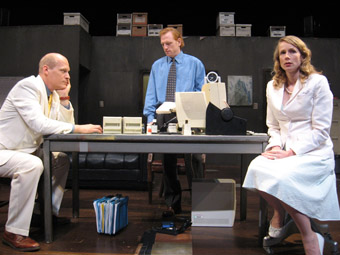
Jim Fletcher, Scott Shepherd & Lucy Taylor, Gatz, Elevator Repair Service
courtesy the artists
Jim Fletcher, Scott Shepherd & Lucy Taylor, Gatz, Elevator Repair Service
GATZ, BY NEW YORK’S ELEVATOR REPAIR SERVICE, IS ONE OF THE STRANGER THEATRE EXPERIENCES OF RECENT TIMES, HOVERING TANTALISINGLY BETWEEN STRAIGHT PLAY-MAKING AND CONTEMPORARY PERFORMANCE. THE WORK RARELY SLIPS INTO BEING A LITERAL DRAMATISATION OF THE NOVEL, EXCEPT TOWARDS THE END, AND THEN TO CALCULATED EFFECT. IT’S AS IF WE ARE WITNESS TO AN INTERPLAY BETWEEN PARALLEL UNIVERSES: A 1990S CITY OFFICE AND THE 1920S OF F SCOTT FITZGERALD’S NOVEL, THE GREAT GATSBY.
But while the office workers read and enact the book, they do it quite unconsciously. It has little reciprocal impact on their lives save for the central reader’s absorption in it and the occasional curiosity or irritation of the others. The novel they give voice and body to does not loop back into their lives. You would think that this might yield an incomplete theatrical experience but, curiously, it doesn’t. It’s not a play about these people. It’s about something else, a novel and how we and the performers imagine and make actual the world it conjures.
In a realistic, tired looking city office, a worker in a down-time moment when his computer fails finds a copy of The Great Gatsby and begins to read it, aloud. He doesn’t stop, although office life continues around and sometimes with him and night and day seem to pass. His computer is checked, taken away and returned, but never works. He keeps reading, becoming the voice and sometimes the body of the novel’s narrator Nick Carraway. His fellow workers, without fanfare, become the other characters. There are simple links: the worker who reads golfing magazines and practises her swing becomes Jordan Baker; the computer technician becomes a garage mechanic; the boss, like Gatsby, is a somewhat distant, reticent character, an ominous presence. The humble office becomes mansion or hotel, but only, as in the act of reading, by virtue of the conjuring power of words, and here along with the deft deployment of office ware as props. Gatz is first and foremost a reading but its actor-office workers prompt us to imagine Gatsby’s world with them. And while they can never make it real (a filing cabinet will never be a chest of drawers full of exquisite shirts) they, and Gatz’s creators, offer not just reading, but a reading of the novel.
But first, there’s an odd pleasure in simply being read to in the comfort of a theatre, although much theatre we experience is, of course, so rooted in words that theatre-going, as listening, is often another form of reading. There’s also a sense of challenge and, finally, of achievement for the performers and audience of Gatz—the reading of and listening to every word of The Great Gatsby over some eight hours. For most of its audience, it’s a painlessly ‘durational’ performance. We’re not just listening, we’re ‘seeing’ a novel through the bodies of unglamorous office workers, themselves pretty much ciphers, dextrously wielding office props and unconsciously if convincingly play-acting. They are at their most real when they become Fitzgerald’s characters. (The actors are only identified on the cast list in terms of their characters in the novel, not their office personae.) But their vision, and that of Gatz’s creators, of the world of the novel is determined by their means: the words heard are immediately re-shaped for us as tableaux, as witty improvisations, comic turns, farce and song, engendering not only immediacy but amplifying the novel’s underrated satirical bite and Nick’s penchant for moralising. As with any interpretation there’s room to disagree: reducing the re-meeting of Gatz and Daisy to embarrassed farce undercuts a significant part of the novel’s power. Among minor irritations, in this case of humour lost, was the drowning out of Nick’s listing of Gatsby’s well-to-do guests with a loud recording of a 20s tune: the names might well have come from the hand of the comic genius of Fitzgerald contemporary and Marx Brothers’ collaborator, SJ Perelman.
A much bigger challenge arrives when, with significant rearrangement of furniture and radical intensification of lighting, the semblance of office disappears and the fateful hotel gathering on an overbearingly hot day is starkly realised. Although a risky departure, the scene manages to work, in good part because of its oppressive and threatening stillness, the lateral positioning of the characters, whom we know so well by now, and because we’re still being read to. It’s not long, however, before the office worker reading the final pages of the novel puts it down, faces us and continues to deliver the narrative. For a brief while, this obsessed reader becomes totally Nick. As in the best reading experiences, the self appears forgotten and office worker and the novel’s narrator become one, eye to eye with us, his readers in turn.
Despite a little too much of an inclination to comedy and over-stated irony, and a late tendency to over-theatricalisation, Gatz proved a deeply rewarding re-visiting of a classic novel, at the same time generating an intriguing meditation on the experiences of theatre and reading. The casual, taking-its-own-time performance mode was immediately engaging; you could nestle into it. Scott Shepherd’s reading of most of the book (another actor takes over briefly) was quietly brisk and unaffected. For an actor with an eye almost constantly on the book we never doubted his presence nor, eventually, that his office worker might become Nick. Ross Fletcher’s looming, formal Gatz, intoned Fitzgerald’s dialogue with almost Brechtian detachment, and the other players convinced even where limited to broad gestures.
Gatz is a work of great invention and craft, of Herculean effort and, above all, imagination—which is its very subject, playing off the experience of being read to against witnessing a simultaneous, if lateral, interpretation of the reading, until the two meet. The boldness of the work lies in its refusal to psychologise its office workers, they are supple puppets, play-acting a great novel, layering a suggestive, interpretive filter between audience and book.
Elevator Repair Service, Gatz, The Great Gatsby by F Scott Fitzgerald, director John Collins, set design Louisa Thompson, lighting Mark Barton, sound design Ben Williams, costumes Colleen Werthmann; Playhouse, Sydney Opera House, May 15-31:
RealTime issue #91 June-July 2009 pg. 43
© Keith Gallasch; for permission to reproduce apply to realtime@realtimearts.net
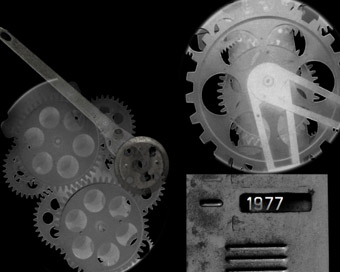
from audiovisual performance, Electronic Church, Berlin (2008); Sam James
SAM JAMES, QUIETLY SPOKEN BUT FIRM OF OPINION, IS THE SUBJECT OF THE SECOND IN OUR SERIES OF ARTICLES ON ARTISTS (JASON SWEENEY WAS THE FIRST, RT88, P46) WHOSE OWN CREATIONS SIT BESIDE THE WORKS MADE COLLABORATIVELY WITH OTHER ARTISTS. JAMES IS WIDELY ACKNOWLEDGED IN THE PERFORMANCE COMMUNITY AS A TIRELESS, INVENTIVE MEDIA ARTIST—FILMMAKER, VIDEO ARTIST AND DESIGNER. THE RESULTS ARE POWERFULLY EVIDENT IN HIS RECENT WORK FOR ERTH (NARGUN AND THE STARS), MY DARLING PATRICIA (NIGHT GARDEN) AND DE QUINCEY CO (GHOST QUARTERS).
James’ imagery is potent whether as the polished, layered animations, land and waterscapes of Erth’s Nargun and the Stars or the onstage improvisations for De Quincey Co’s Improlab, where a change of lens and a shift of focus can transform an innocent object into something fantastical. His Anamorphic Archive, an entrancing, alchemical engagement with dancers he’s documented, is evidence of the capacity for James’ work to stand strongly on its own. At the same time he’s collaborated with choreographers-turned-filmmakers, helping them (on camera or as editor or projection designer) to realise their visions and compete as finalists for awards.
Sam James describes himself as a theatre and media designer, which seems apt since as film- and video-maker he’ll create spaces by projecting onto multiple screens or walls and through materials. It’s not surprising then to find that his education included architecture and sculpture, and that he describes his creations for other artists as “media installations.” His output has been prodigious, designing media installations for over 200 productions since 1995, when he began designing for PACT Youth Theatre and adding dance film to his practice in 2000, with Potsdamer, featuring Martin del Amo. Many of his collaborations have been with artists associated with Performance Space, although his work has taken him to the Sydney Opera House, Sydney Dance Company and the Australian Ballet. His dance film Nun’s Night Out (2006), made as a super-8 docu-drama for director Julie-Anne Long’s The Nun’s Picnic, won Best Australian Dance Film at the Australian Dance Awards in 2007.
How and where did you start out as an artist?
I studied Architecture for three and a half years at Adelaide University, then fled to the College of Fine Arts in Sydney and began sculpture and installation in first year and then moved into film with Stephen Cummings. I made three films in two years, all unbearably expensive, but essentially process films. I’d start with one or two ideas of filming people I knew in abstracted impressions of their normal life and it would progress in experiments using one or two rolls of film every month or so. I would edit the material on video. I realized through editing you can make up a reality, which is still now my main interest.
How did you find your way into collaboration?
I made a work at Performance Space in 1999 that really took it out of me in terms of the complexity of imposing my ideas on other artists. I consider all artists to be equal. Some have louder voices and some make their work hit in the right time and place. Other artists are less able to be collaborative; it’s not in the nature of their process. I realised that to survive I had to collaborate. To me it seems either you are in collaboration or in your own void. It has a lot to do with artists’ personalities and their sociability.
What do you regard to be your key works?
When I was 21 I wrote a book, titled Diffusion, about the essentials of movement and change for existence. This was never published, but since then all of my film and performance work has been an essential philosophical decision about survival. I made my second dance film, Post Romantic, in 2000, which was about pulling an individual from the ruins of romantic imagination into the turn of the new century. It felt important although maybe it was just cathartic. It was about trying to find some kind of resolution to living in a city, Sydney, with superficial values. I followed up that train of thought much later in 2006 with Simulated Rapture where there was some breakthrough with the same idea—to place isolated dancers within foreign environments which I had linked and re-animated to represent the dancers’ locked-in condition. It was more successful because it became something beyond my initial investigation. These weren’t artists working in isolation, they were all prismatically intermingled in their complex relationships and part of each other’s environment.
After that I made Anamorphic Archive, which was a collation of fragments from the many dance performances I had documented, to try to exhume neglected electronic archives and give them a new life. This was all about authorship in media, at what point does this become my work, who owns the end product, what is the original and how much distortion makes the original work no longer visible? It linked back to my initial fascination with the power of editing. In post-production almost anything can be manipulated, often to an event or artwork’s advantage. Is it a tool of disguise or illumination?
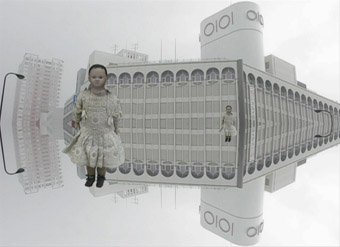
study for The Nest (2009), Sam James
When you work with other artists on their projects, how do you see your role?
With every artist I collaborate with it’s about our artistic relationship. Often status has something to do with it, but it’s usually much more than that. I am never a servant to another artist unless I specifically agree that my role is not to be creative. I always feel that if an artist is capable of making their own video, they should do it but, if they don’t know how to, then I do it. There are always relationships between the languages of performance and film and each performer’s approach to performance indicates which approach to the film I should take. Every show is a different process as well, so applying a constant aesthetic and mode to a performance I think is wrong. If there is artistic frustration in the collaboration, the answer is to get past it, to find what the work is about and see what the investigation gives us.
What are some of the key shows you have worked on with other artists?
Improlab with Tess de Quincey, Jim Denley, Amanda Stewart and Chris Abrahams (and others, 2006-8) was a series of totally improvised works which ended up being the most satisfying and challenging of events, the ultimate in collaborations. To work with such experienced and dedicated improvisors as Denley, Stewart and Abrahams with their fluid and beautiful sense of trust can’t be surpassed. Each says, you do what you want and I’ll do what I want and when we do it simultaneously it will either be beautiful or it will tell us where we are going wrong. There is no beginning and end to improvisation and it is impossible to encapsulate, it can only be a live experience. Improvisation is not always the best form of entertainment for an audience and there were varying degrees of success with the De Quincey Co Improlab tour. For example, sensitivity to the performing space for me was the key thing, using three live cameras, different lenses and analogue mixing, but The Studio at the Opera House, a place for presentation and entertainment, just wasn’t resonant.
Working with Hans Van den Broeck on Nomads in 2008 (RT90, p21) was a sudden and profound experience. Again, to work with someone with so much experience (a founding member of Les Ballets C de la B), an interest in psychology and huge energy and imagination, fuels your own energy to work. This was not an indulgent investigation but a boxing ring of ideas and tactics, drawing on each artist’s responses to tasks. One thing would lead to others. It was a risky piece and Hans had enough on his plate dealing with the dancers but he still had a mountain of video ideas he wanted to work out. In the two-day development period in Bundeena we shot about six hours of video performance ideas—most of which never made it into the show. But through that process I could see how he understood performance and video. That’s a crucial thing to find out fast if it’s the first time you are working with someone. Nomads took only two weeks to create but the speed of working, in combination with improvised video, seemed important, because these days, with limited funding, you have to work fast and very well to keep the work alive and to compete with the large scale works seen in festivals.
What is the relationship between your own work and the work you do with others?
Each work is an inspiration. I don’t know where this work has come from but someone has invited me to make work in it. It becomes, in the absolute sense, the world I am living in. I spend far more time in projects than I do anywhere else. Every time I go to a new project it’s a new tango, a completely new story. Sometimes the transition is hard if I start a new project the day after another finishes, but I think this adapting to new territory is nothing compared to, say, being a soldier in a war. I see the work as a filmmaker. The performer is the subject of the projected film, it is sculpted around them, where they travel. I learn from them as a filmmaker learns from their subject. I am part of their journey, and I try to illuminate their passage. Of course sometimes I don’t want to show too much, and performance delivers everything we need. But in terms of working with independent performers, the work is in progress and I help find the answers to their questions. To work alone is not so satisfying, I need other encounters to shape my path.
What is driving your own current project?
My next project is The Nest which has been commissioned by Reeldance to be part of Cinedans’ installation program in Amsterdam in 2010. I am using a process I’ve used before, which is to travel, filming new spaces in macro and microscopic scale with small digital cameras. All of these abstracted environments will become a space which I will link to certain dancers I’ve worked with. The main notion is that space is a series of interconnected links, like a nest. With conceptual forms similar to ant nest architecture, I am interested in making connections between these found spaces and people. The compositing and animation process is digging the tunnels, to try to make connections between subject and space, and also to make connections between them as newly invented, discrete entities. I’m using imagery mainly from Tokyo and Berlin and a prototype cut will be finished on a residency at GlogauAIR in Berlin in July this year. The performers are some of Sydney’s most independent and individually charismatic—Martin del Amo, Lizzie Thompson and Georgie Read—the film focusses a lot on their personas.
What is your relationship with technology?
Like many, I despise technology, but I embrace it because it is the dominant vice of society. In relation to media, everything must relate to it, or it doesn’t exist. It’s a flaw in humanity and the power behind our simultaneous success and annihilation. Film has magical power, sets of parameters and tools with which to attempt to express our dreams, but its power is hard to wield. My relationship to it is experimental: the results come from an outside force. It’s important to give in to the machine and the independent will of technology if you are a video maker, as important as it is to give in to another person’s life. The benefits are like travel: film can reconfigure and make impressions on the mind. Of course, film can also be escapist, but for someone who is not good socially, what a great escape! It makes the world seem bigger, more complex, yet reconfigurable. Its language helps me to make sense of experience by piecing it all together in the editing.I use compact mpeg video cameras for most of my capturing because it is immediate and real, and this format also has greater potential for animation, for me a great cross-over between worlds real and fantastic.
My collaborations are the most transient part of my work, lost in almost all aspects after the live act. Without the performance, performance video doesn’t really speak on its own. But it’s pushed my practice hugely towards the artifact and historical relic, the feeble and somewhat fractured and mythologised residue of something that was once great. Preservation of an event is another thing, it is possible to make it greater than the actual event, through nostalgia and distance things seem beautiful in their disappearance. I think this is also the real relationship to all this technology.
Sam James, https://shimmerpixel.blogspot.com/
RealTime issue #91 June-July 2009 pg. 44
© Keith Gallasch; for permission to reproduce apply to realtime@realtimearts.net
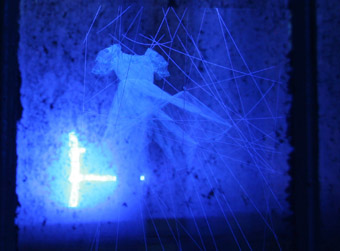
Night Songs
photo Cat Brennan
Night Songs
IN MICHAEL PATEN’S 2009 PROGRAM FOR THE CASTLEMAINE STATE FESTIVAL TWO SHOWS STOOD OUT AS NEW LOCALLY DEVELOPED HYBRID PERFORMANCE WORKS REACHING BEYOND THE ORTHODOXY OF THEIR FORM. BOTH NIGHT SONGS AND DINNER IN A DRY DAM WERE NURTURED IN SEEDPODS, PART OF A NATIONAL EMERGING ARTS INCUBATION PROGRAM DEVELOPED AND CURATED BY PUNCTUM INC, A CASTLEMAINE-BASED LIVE ARTS ORGANISATION.
Both shows work within a poetic medium to explore the tensions between, and destinies of, a husband and wife. However where Night Songs plunges into a vein of unknowing, Dinner in a Dry Dam discloses all its secrets before it begins. Where the former unfurls juxtapositions of loss and longing with a soulful impressionism, explicitly decentralising the narrativity of its text, the latter spells out its journey, baring all at the outset in a ‘dinner menu’ style program of convoluted Victorian era scene subtitles, then fixating on its central dilemma in an explicitly expositional text. It is perhaps a strategy to facilitate access for rural audiences less inclined towards the poetics of ambiguity.
Night Songs—a meditation on the triangulation of longing and love between a sailor, his sea widow and the open sea—reworks James Benedict’s original play, Aqua Lupus, in collaboration with visual artist Gabrielle Brauer, to re-emerge as a site specific multimedia installation beneath the Old Castlemaine Gaol.
An MP3 player provides each viewer with their own audio track so we may freely rove this fitting netherworld, as if in an ancient wreck awakening intimate memories of other people’s lives. At the bottom of a steep descent, tiny rooms are littered with fern-like forms or crisscrossed with a cat’s-cradle of string, some inhabited by almost tangible, lifelike human presences. I hear sounds of the sea and a dialogue about absence and presence. Each cell offers up a morsel of memory—projected phantasms exuding warmth, the woman who writes, the woman who waits in a womblike pod of shadow—each mockingly occluded behind sculptural white forms that shine luminously cold under UV light. Taut, angular lines of string hold captive a ghostly child’s gown, her memory caught up in the latitudes and longitudes of distance/connection or in the rigging of some vessel. Elsewhere her image points and laughs in endless repetition.
Drumming builds and a male voice describes a more external journey, his love for the sea, his longing for return, the letter he begins when the winds become still in some remote ocean. Besieged by a perilous calm, adrift on his own dreams, the unfulfilled adventurer is denied a triumphant return, his loved ones refused the satisfaction of a heroic battle narrative, the heartstrings connecting her life to his just slacken and ebb in a sinking oblivion.
Benedict’s text lilts eloquently toward its story, yet leaves it always partly submerged. The scenario resonates with the plight of war widows; of veterans lost to despair rather than to enemy fire; and with their would-be heroes, soldiers becalmed in a purposeless enterprise, the winds of a morally righteous crusade knocked out of their sails by a more cynical truth.
Punctum’s Dinner in a Dry Dam describes another case of an enterprise becalmed by weather patterns. In a drought-stricken rural community a sheep farmer and his ex-opera singer wife host a farewell banquet on the dam’s dry bed. The event occasions a domestic drama that pits pioneering tenacity against the creative courage to embrace change. At the core of this is the will to inflict death, a blood sacrifice of the last stud ram, for the sake of resurrection into new possibilities. For the farmer, as captain of this ‘vessel’, honour lies with his sinking farm, while his ‘first mate’ wife agitates for a break with the tradition of ‘going down with the ship.’
The starting point for this contemporary opera, described by director Jude Anderson as an elegy to the last great 200-year cycle between droughts, was to relate the tension between certain musical intervals to the dramatic tension between the couple. The libretto is the culmination of community interviews giving dramatic voice to the rural tragedies we often gloss over. Despite avant-garde sonic experimenting, humanity and drama snap sharply through the sparse team of mezzo-soprano, tenor and double bass. The fictional device of the opera singer helped to elevate the material, validating the use of high cultural form without alienating its primary constituency.
The church hall formally set for a banquet excited expectations by implicating us as guests but the material made us uneasy voyeurs to this bitter private struggle in which every development has been pre-empted by the ‘menu’ program. Nothing is left to experience afresh. We read, “I will then pick up a gun and leave. From beyond the dam banks you will hear a gunshot. That shot will mark the end of a bloodline. I will have killed our last remaining ram before walking off our property and closing the gate.” Indeed this outback Lady Macbeth prevails against her lord’s inertia, but with no great sense of transformation. And at the ringing out of her gunshot offstage we watch him—a blank, unflinching figure—in vain, for evidence this blood sacrifice will indeed prove a gift of life and not a living death.
While Night Songs immersed me in its amniotic fluidity, a balance of feminine longing and masculine yearnings both reaching for connections in a sea of uncertainty, Punctum’s Dinner progressed drily from a specifically located dischord toward an endpoint of decisive certainty and I am left wondering if the change has been suffered or truly embraced.
Night Songs, text James Benedict, installations Gabrielle Brauer, composer Tim James; Old Castlemaine Gaol, April 1-4; Dinner in a Dry Dam, director Jude Anderson, composer Carl Panuzzo, performers Carl Panuzzo, Penny Larkins, librettists Berni Janssen, Penny Sell, Emilie Collyer, Jude Anderson, design Ali McNicoll, lighting Grant Davis, video & sound artist Jacques Soddell; St Mary’s Church Hall, April 1-2, www.punctum.com.au; Castlemaine State Festival, March 27-April 5, www.castlemainefestival.com.au
RealTime issue #91 June-July 2009 pg. 45
© Indija Mahjoeddin; for permission to reproduce apply to realtime@realtimearts.net

Marc Gunderson, The Evolution Control Committee
photo Brooke Buchanon
Marc Gunderson, The Evolution Control Committee
IN 1999 A GROUP OF RMIT STUDENTS PRESENTED A COLLECTION OF EXPERIMENTAL SOUND AND MUSIC EVENTS. TEN YEARS ON, THIS COLLECTION OF EVENTS, LIQUID ARCHITECTURE, HAS GROWN INTO ONE OF AUSTRALIA’S MOST SIGNIFICANT FESTIVALS WITH A NATIONAL TOURING PROGRAM OF CONCERTS, INSTALLATIONS AND FORUMS.
While there have been many contributing directors and collaborators, Nat Bates has been the mainstay for the entire decade. This heroic effort has allowed for consistency in both the quality and curatorial approach, however Bates is keen to point out that each Liquid Architecture is never purely his vision. “One of the key things for me is the team of curators. When we were a Melbourne only event there were a number of people I worked with [Bruce Mowson was co-director 2001-4, Camilla Hannan 2001-2] and now that it’s a national event I rely heavily upon the people in the other cities for input. That keeps it fresh and interesting, keeps me motivated, keeps me in touch with things that I’m missing. I’d feel very uncomfortable if it was purely my thing.”
Liquid Architecture started up a few years after What is Music? began challenging our senses. Over the last decade several other important festivals have also entered the landscape, including The NOW now. However Liquid Architecture has managed to maintain its own distinctive emphasis on national and international guests who offer historical perspectives on contemporary practices. Bates recollects that “in 1999, 2000, there was a lot of talk about new media but as a student I was learning that it wasn’t new, that there’s a history. So I was very keen to highlight established artists, who’d been working for a long time, alongside emerging artists. I think the festival has tried to do that continuously, whether it’s an international guest who has never been to Australia before and who has a decades-long career, or some particular practice or way of working that we want to highlight…This is tied in with the fact that the practices we’ve highlighted are still ongoing in some way. I’m not interested in doing retrospectives as such. So when Tony Conrad came out, he was still developing what he was doing in the 60s—it’s a living practice. It’s up to him whether he wants to play old works or present contemporary ones.”
Within this framework, the festival has always been diverse, covering a wide range of approaches to sound and music making. I asked Bates how this has worked for the event. “It’s been a struggle over the 10 years trying to establish a profile for the festival and to explain what it is. People wanted to pin ‘electronic music festival’ on us in the beginning and I was very reluctant to do that. We adopted the ‘sound arts’ label early on, which was contentious and difficult as well because there’s a lot of different understandings of what that is. Then we struck upon the idea of calling it a ‘sense-specific’ festival…The diversity in the programming is definitely a reflection of all the things that are going on, and not wanting to be narrowed down to a genre or particular area of practice. But it’s also a recognition that Australia has a small population—artistic communities are relatively small in number but we wanted to be broader than that and bring in as many communities as possible.”
What is unique about Liquid Architecture is the way the touring model has grown. The interstate elements of the festival are run by local directors who program their own concert series and events drawing on the international guests and adding locals into the mix. This year as well as Melbourne, Sydney, Brisbane and Perth, the festival will go to Castlemaine and Bendigo in regional Victoria, and Cairns in far north Queensland.” The truth is,” says Bates, “there’s got to be people interested [in this music] in all these places. Just because they live somewhere rural doesn’t mean that they’re not interested in things that happen mostly in the big cities. Part of the motivation for the festival is to provide opportunities for artists they wouldn’t get otherwise—to tour this kind of music and to play to audiences outside of the capital cities.”
I asked Bates to pick out a few highlights from the last 10 years of Liquid Architecture. Even though, like a proud father, he was reluctant to play favourites, he did cite a particular moment. “My number one highlight was Bernard Parmegiani playing in Melbourne, doing a speaker orchestra event, which is an area of personal interest to me. I never thought I’d get to see something that happens exclusively in Europe. It was amazing to meet him.”
It’s this meaningful connection with key artists that has kept Bates—an artist himself, like most promoters and organisers in this sector—forging ahead, despite the time it takes away from his own practice. “If I’m organising a show I get a real connection with [the artists]. First of all we have to talk about technical things: what gear do you need; how does this work; how do we orientate the space; how do we get an audience; how do we promote it. Just starting those conversations, it becomes a deeper artistic collaboration in a way.”
Liquid Architecture has previously operated under the auspices of RMIT, however it is now in the process of establishing itself as a separate legal entity. I asked Bates about the effect this is having on the future of the festival. “[In] some ways [the change] is motivated by asking how can we sustain what we’re doing, but it’s also raised the question of whether we should continue doing what we’re doing—should we be doing it differently? This is a very healthy thing but it does mean that there’s some uncertainty about whether or not the festival will continue in its current shape and form. But it’s got a very healthy base to build on and there are some things you just don’t throw out…Personally I wanted to start to formalise the informal ways that I’ve been working for 10 years in terms of the mentoring and advice that I get from various people…I’ve always relied on other people’s opinions. The Melbourne program is very much a collaborative effort. Local organisers and curators come to me saying ‘I want to do a series of shows, Can one of these be part of the festival and how can we fit them together?’ So I’m interested in formalising these making it clearer how we all work together.”
So what does the 10th Liquid Architecture have in store for us? Thanks to a partnership with the Goethe Institut, there is a strong German contingent. Asmus Tietchens offers the program’s historical context—his career started in 1965. With around 20 releases to his name, Tietchens remains an understated figure in the experimental landscape because his work does not adhere to any particular style or movement but instead is “simply the musical exploration of the studio, idea, or collaborative situation at that given time.” Particularly intriguing is the duo Kontakt der Jünglinge, which is Tietchens and another German guest, Thomas Köner, a renowned audiovisual artist with Golden Nica and Transmediale awards under his belt, who will also be playing solo sets. Also from Germany is Perlonex featuring Ignaz Schick (live-electronics), Jörg Maria Zeger (guitars) and Burkhard Beins (percussion) exploring the electroacoustic spectrum.
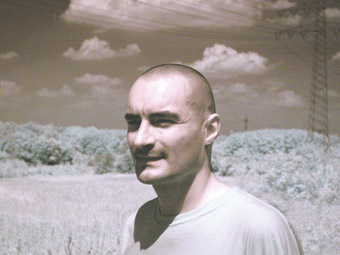
Thomas Köner
courtesy the artist
Thomas Köner
From the US comes The Evolution Control Committee led by Marc Gunderson (aka TradeMark G), plundering other people’s music to create whole new works and sticking it to the upholders of pesky things like copyright. Gunderson is credited with inventing the MashUp, in which two songs are slammed into each with surprising ramifactions. He is also credited with inventing the term ‘plagiarhythm’, which has made it into the dictionary and, through his software tinkerings, has created a musical interface, the Thimbletron.
Liquid Architecture has always featured exhibition elements and this year each of the major venues has something on offer. At the Brisbane Powerhouse there’s an exhibition by Eugene Carchesio and San Francisco-based media artist Scott Arford. Arford will also present work alongside Ruark Lewis, Vicky Browne, Lauren Brincat and the UTS instigated Memory Flows group at Performance Space, Sydney. Bendigo will present audiovisual installations by the Undue Noise Collective and Jacques Soddell. In Melbourne, WestSpace offers experimental instruments and installations by Alan Lamb, Dale Gorfinkel, Rosalind Hall and Peter Blamey along with Location Sound Films by Estonian artist John Grzinich. At Arts House, North Melbourne Town Hall, US/Swiss artist Jason Kahn will present Brown White Blue Pink, an installation using 4-channel audio disseminated over 40 two-inch speakers to explore the four colours of noise.
To have achieved a decade of consistent operation in the experimental music landscape is truly a remarkable achievement. With events across seven cities in 19 days for Liquid Architecture 10, it appears that enthusiasm from organisers, artists and audiences is strong and still growing and should do for another decade.
Liquid Architecture 10, national artistic and Melbourne director Nat Bates; Sydney, co-directors Shannon O’Neill, Jennifer Teo, June 24-27; Brisbane, director Lawrence English, July 3-4; Castlemaine, presented by ICU/Punctum, July 5; Perth, presented by Tura New Music, July 7; Bendigo, director Jacques Soddell, July 8-9, 23; Melbourne July 9-12; Cairns, presented by On Edge 09, July 12; www.liquidarchitecture.org.au
RealTime issue #91 June-July 2009 pg. 46
© Gail Priest; for permission to reproduce apply to realtime@realtimearts.net
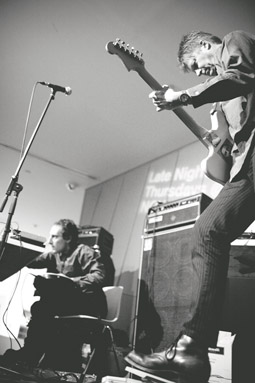
Oren Ambarchi, Nels Kline, Melbourne International Jazz Festival
photo Laki Sideris, www.melbournejazzphotos.com
Oren Ambarchi, Nels Kline, Melbourne International Jazz Festival
THE MELBOURNE INTERNATIONAL JAZZ FESTIVAL LOST ONE OF ITS STAR TURNS WEEKS BEFORE IT STARTED, WITH CECIL TAYLOR CANCELLING DUE TO ILLNESS. WHILE THAT’S AN UNDENIABLE BLOW, A STRONG FESTIVAL RECOVERS QUICKLY DUE TO THE OVERALL PROGRAMMING QUALITY; THIS EVENT, HOWEVER, FELT LIKE THE WALKING WOUNDED AFTER TAYLOR’S CANCELLATION. (WHY THEY DIDN’T ASK TAYLOR’S ACCOMPANIST TONY OXLEY TO COME REGARDLESS AND PLAY SOLO PERCUSSION IS BEYOND ME.) MY EXPERIENCE OF THE FESTIVAL WAS CHERRY-PICKED, I’M NOT ASHAMED TO ADMIT, BUT I’D LOVE FOR ONCE TO TURN UP TO ONE OF THESE FESTIVALS AND BE OVERWHELMED WITH CHOICE.
The festival for me started with a lock-out, unable to gain access to the Charlie Haden Liberation Music Orchestra, which had been moved from outdoors to BMW Edge due to inclement weather. My first encounter with artist-in-residence Haden, then, was the screening of Rambling Boy. It scored high for featuring some incredible footage of the Ornette Coleman Quartet in their element, but I couldn’t help but wish some of the choices of talking heads had been more inspired, and at points the film really lacked any kind of aesthetic backbone, relying too much on chronology and not enough on meta-musical content. More discussion of Haden’s place in the free jazz ferment of the 1960s and 70s would have been appreciated, for example. The question and answer session after the film could have pushed the discussion of the overlap of art and politics much further, particularly given it’s something Haden’s spent plenty of time addressing with the Liberation Music Orchestra.
Charlie Haden’s Quartet West played the following night at the Melbourne Recital Centre, a space that feels custom-designed for classical music. As such the sound left something to be desired, particularly Haden’s bass: it’s never a good sign when the star of the quartet you’re watching is mixed out of existence. Some of Quartet West’s music cloys, and the overarching theme of ‘music for film noir’ means things never really break into the feverish sweat I’m often after with jazz. But there were moments of revelation—a gorgeous rendition of Ornette Coleman’s “Lonely Woman” that slowly, almost deliberately, expounded on the melancholy at the heart of Coleman’s most enduring melody to great effect; and some of Ernie Watt’s turns on the tenor sax, particularly his solo in the first piece, which had my neighbour turn to me and proclaim, ‘it’s just like Slayer’—precisely the kind of cross-generic thought that should be brought to bear on a lot more of these shows.
Then to the National Gallery of Victoria on Thursday night, for their early evening ‘Art Chat’, this time with Oren Ambarchi and Nels Cline as willing victims. Question time with Ambarchi and Cline was like pulling teeth. While it’s hard to strike a balance between interrogation and openness, the questions felt remedial and stilted, and the answers were uninspired (if genial). The duo performance fared little better, partly due to Ambarchi’s immovability—one of the negative side-effects of so clearly defining your own aesthetic parameters is that it can be hard to break free of your own concepts and engage with your playing partner. And while there’s something to be said for the post-AMM, post-Keith Rowe ‘laminal’ approach to improvisation, where playing ‘parallel’ to those you share the stage with can provide some more intriguing outcomes than the traditional combative or ‘call-and-response’ modes of improvising, it didn’t work here, and Cline’s entreaties to coax Ambarchi out of his shell were met with paralysis.
Nels Cline’s solo set supporting the Laughing Clowns fared better, if only because it allowed him the chance to move through ideas at his own pace. But there’s something slightly unappealing about the phantasmagorical element of Cline’s playing; his preparations and FX get in the way of the internal logic and credibility of his performances, such that you walk away feeling his aesthetic has been defined by his tools, and not vice versa. This is surprising, given the richness and individuality of Cline’s music with the his trio or Carla Bozulich and Wilco. While he’s not overawed by his kit, he’s sometimes over-determined by it—that the moments where he plays it straight lapsed into clichéd jazz noodling or limp post-rockisms are, however, all the more puzzling. You risk being called a traditionalist within certain circles these days for asking a guitarist to play their instrument ‘properly’, but that’s where Cline really excels, and it’s a shame to have caught him in less than inspiring form.
If a lot of the Melbourne International Jazz Festival felt tentative, or ill-conceived, it seemed appropriate that Australia’s Laughing Clowns should sweep in from outside of jazz and completely own The Forum’s stage—indeed, this was final, irrefutable proof that we’re dealing with rock at its best, not ‘jazz-rock’ or ‘jazz-punk.’ If anything, what the band achieves is the kind of group solidarity at a meta-level that great jazz groups aspire to and occasionally reach—that’s their lasting relationship with jazz; it’s nothing as base as generic similarity. There’s a barely constrained fury at the heart of songs like “Everything That Flies” (the set’s stand-out) which I’d only caught glimpses of at Sydney’s All Tomorrow’s Parties. More surprisingly, the way their group-mind unfolds has me thinking more of noise artists like Borbetomagus or Wolf Eyes—a surprising outcome, but the way they translate their energy into almost uncontrollable streams of white light recalls the most rock-reverent noise groups I’ve seen or heard much more than any of Kuepper’s supposed ‘peers.’
I guess that, structurally, finishing with the Laughing Clowns made sense—save the best ‘til last, go out with a bang etc. But I left the Melbourne International Jazz Festival with a fairly sour taste in my mouth, largely because the opportunity of programming some genuinely provocative, risky shows was squandered. This is not a simple-minded call for more avant garde music. Truth be known, the problem wasn’t even that both ‘streams’ (mainstream and underground) were under-catered—it was that you could coherently read these streams in the program in the first place. What happens when you throw away these archaic notions, when the rule book goes missing? We’re probably going to have to wait a lot longer to find out.
2009 Melbourne International Jazz Festival, various venues, Melbourne, April 26-May 2
RealTime issue #91 June-July 2009 pg. 48
© Jon Dale; for permission to reproduce apply to realtime@realtimearts.net
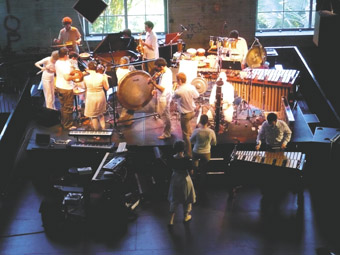
Queensland Conservatorium New Music Ensemble performing Ylem
photo Sharka Bosakova
Queensland Conservatorium New Music Ensemble performing Ylem
KARLHEINZ STOCKHAUSEN IS THE UBER MYTHIC CULTURE HERO. CHILDHOOD IN POVERTY, TEENS IN A NAZI YOUTH CAMP WHERE “EVERYTHING WAS ORGANISED…EVERY TOOTH, EVERY FINGERNAIL…”, HE MADE IT THROUGH WWII TO BECOME THE WUNDERKIND OF POST WAR COMPOSITION, RESHAPING MUSIC AGAIN AND AGAIN WITH RUTHLESSLY FOCUSED CONCENTRATION AND A MONASTIC WORK ETHIC. (TYPICAL STOCKHAUSEN WORKDAY: UP AT 5AM, GO TO MASS, WORK IN THE STUDIO UNTIL 7PM, GO HOME AND SKETCH OUT SOME IDEAS UNTIL 11, SLEEP, UP AT 5, GO TO MASS ETC ETC YEAR IN, YEAR OUT).
Then the story changes, he went a bit crazy-like, thought he came from outer space, descended into a megalomanic black hole and spent the next 30 years writing a grandiose opera, Licht, before delivering a final masterwork the day before he died. Make a great movie, the genius writ large then low. Some of it might even be true.
Jump to Clocked Out presenting an afternoon of Stockhausen in a free concert at the Powerhouse in Brisbane. The works go from Kontakte (1959) up to Octophonie (1990/91). Good crowd. Excellent performances. Great explanatory introductions to all the pieces from the engaging Stockhausen scholar Richard Toop.
Kontakte, for piano, percussion and electronics is a highlight. Originally designed to have performers improvising to four channel electronics, Stockhausen was unhappy with rehearsals and replaced the improvisation with specific instrumental parts to tighten up the sound play between performers and electronics. The performance by Ensemble Offspring and Jeffrey Hannam is precise and energetic. Gestures bounce sharp and fast between percussion, piano and tape. Form and theory, surface and structure, everything at every scale is smoothly coupled in a single movement of 35 minutes. (Stockhausen favoured single movements saying if he wanted to present two ideas he’d compose two pieces.)
Then Ensemble Offspring improvise with Pimmon to show Kontakte musically “in the context of the here and now.” But the problems with improvisation that Stockhausen found all those years ago reappear in the limited interplay between acoustic performers and laptop manipulations. Sharing novel and complex gestures is difficult unless the performers have many hours playing together or the genre is tightly constrained. Improvisation becomes restricted to the simpler task of exchanging and layering textures rather than developing musical gestures. This restriction drives the overall dynamics into a relatively static/ambient regime, unlike Kontakte which has enormous variety in dynamics.
A structured improvisation like Barrett’s Codex IX for the Elision ensemble sounds much more akin to Kontakte—Barrett could build in performer/performer interaction because of his many years of association with the musicians. This close connection between composer and ensemble is how Stockhausen worked throughout his career—he was always involved as performer or conductor and repeatedly rewrote works based on the experience of performance and rehearsal.
Move forward to 1972 and Ylem (played by the Queensland Conservatorium New Music Ensemble) presents Stockhausen as formalist system builder and believer in the paranormal. Ylem “best succeeds when the players establish telepathic communication with one another” (Stockhausen). The work is structured as an oscillation—out, in, then out again. Performers begin in a tight group then walk outward through the audience, return, move out again. Notes begin clustered then spread wider in pitch. Tempo starts fast, gradually slows. The effect is of time slowing down rather than notes being played differently. The process reverses, begins again. The final section has the performers moving beyond the audience and out into the space. It is as though we are observing a ritual, as though the performance is for performers rather than audience. It works beautifully and when the performers leave it is like being left alone rather than coming to the end of a piece—the music has moved over us and away.
Ylem is part of a substantial number of text and graphic scores where Stockhausen abandoned the extreme micro-control of sound structure found in Kontakte and focussed on the performer’s relationship to creating. Composing for behaviour rather than sound—or in conjunction with sound—has developed considerably over the last few years as composers write bio-behavioural models in software which then interact with live performers. Works such as those by Luke Harrald and others working with “live algorithms for music” (http://homepage.mac.com/oobop/lam/index.htm) can be genuinely musical. Fifty years ago Stockhausen had to abandon his original idea for Kontakte—performers spontaneously interacting with sounds-on-tape. Now, the computer (as person) interacts back.
Clocked Out, Stockhausen: a message from Sirius, Queensland Conservatorium New Music Ensemble; Ensemble Offspring; Pimmon; Michael Fowler; Jeffrey Hannam, Ben Marks, Tristram Williams; Brisbane Powerhouse, April 25
RealTime issue #91 June-July 2009 pg. 50
© Greg Hooper; for permission to reproduce apply to realtime@realtimearts.net
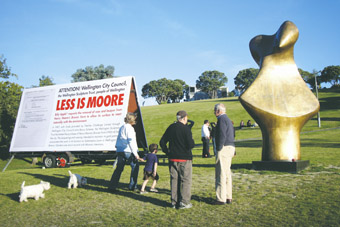
Billy Apple, Less is Moore, Wellington, 28 March 2009. Commissioned by Adam Art Gallery for One Day Sculpture
photo John Morrison
Billy Apple, Less is Moore, Wellington, 28 March 2009. Commissioned by Adam Art Gallery for One Day Sculpture
REALTIME MIGHT SEEM AN UNLIKELY CONTEXT FOR EXPLORING APPROACHES TO SCULPTURE, PHENOMENOLOGICAL PERSPECTIVES ON THE VIEWING EXPERIENCE NOTWITHSTANDING. HOWEVER, THE YEAR-LONG PROJECT ONE DAY SCULPTURE THAT HAS BEEN UNFOLDING ACROSS NEW ZEALAND SINCE JUNE 2008 OFFERS AN EXPANSIVE INTERPRETATION OF THIS GENRE FOCUSED ON PERFORMATIVITY, TRANSIENCE, DISPERSAL AND INSTABILITY.
Conceived by UK-based curator and theorist Claire Doherty, One Day Sculpture is a collaborative production with the Litmus Research Initiative at Massey University in Wellington, directed by Australian David Cross. According to Doherty, it is explicitly “not an exhibition”, but operates instead as a platform for a series of discrete works to be commissioned and considered in relation to an overarching set of ideas concerned primarily with duration and place (Curatorial Statement, http://www.onedaysculpture.org.nz). In turn, One Day Sculpture has initiated a network of partnerships with local institutions and independent curators across the country, devolving responsibility for commissioning and delivering much of the series. By the time the program winds up mid-year, 21 enormously diverse projects by international and local artists will have been staged, each within their own 24-hour time period, at venues spanning Wellington, Auckland, Christchurch, Taranaki and Dunedin.
In association with the commissioning series, a two-day symposium was held in March that sought to tease out the relationship of the project to current discourses and, in particular, the intersection between performativity, place, temporality and collaboration where One Day Sculpture largely resides. The symposium program was arranged as a series of four sessions within which a number of concurrent activities took place, such that the experience mirrored the partial and contingent encounter of a temporary, place-responsive artwork. Likewise, within the commissioning series, the dispersal of the program across a 12-month period and between different social and geographic locations has ensured an in-built itinerancy, which reflects the broader circulation of artists, curators and audiences between sites that is a significant effect of place-based commissioning practices. Both of these strategies point to the research interests of the project: its focus on sculpture as an activating agent within the public sphere, and attention to the related challenges of finding responsive ways to present work of this kind and articulate its impacts.
In his position paper on the symposium’s first day, Dr Mick Wilson broached these themes by reflecting on the experience economy in which temporary art events circulate. Wilson addressed the ways ‘the public’ has been conceptualised within site-responsive art practices over the past two decades and considered the impact of market forces on how such works function in the public sphere. Within a context where art is now frequently instrumentalised for the purposes of city branding, urban renewal and cultural tourism, Wilson proposed a rethinking of how we consider the ‘public’ within this schema. Drawing on the philosophy of Giorgio Agamben, Wilson suggested an understanding of the public not as an already existing body of subjects ‘in-common’, but as temporally produced by the artwork and constituted only by those to whom it matters; for whom it disrupts the continuity of experience and in doing so creates a shift in consciousness. This logic effectively works against an understanding of the public of place-based artworks as being represented, and proposes instead that it is through contact with the work that a public is created.
Documentation, in print and online, during and after the experience of these works, might play a significant role in evolving a public. Billy Apple’s billboard project Less is Moore, staged March 28 in the Wellington Botanic Gardens, subtly engaged with this idea by problematising the notion of a direct encounter. Simultaneously playful and incisive, Apple’s work was erected on the Salamanca Lawn next to a permanently installed bronze sculpture by Henry Moore, with which it formed a dialogue. Moore’s sculpture, titled Inner Form, was donated to the City of Wellington in 1988 and, at the time, the wishes of the artist were made clear in a fax that addressed the treatment of the sculpture’s surface. More than 20 years later, Apple used his own sculpture as a mechanism for directing attention to Moore’s, reproducing the fax in full alongside a cheeky declaration that the City had undermined Moore’s artistic intentions by applying a protective lacquer and wax to its surface as a means of maintaining the sculpture’s gold patina. Alongside Apple’s request to remove the protective layer on Inner Form and “allow its surface to react naturally with the environment”, the reproduced (and massively enlarged) fax attested to the City’s deliberate resistance on this account.
While the overt theme of Apple’s work might be considered ethical – exploring the impact of institutionalised frameworks on artistic intention and audience reception – Less is Moore also worked to unsettle a clear delineation between immediate and mediated encounter. Standing before Moore’s sculpture in 2009 with Apple’s billboard alongside, it became apparent that the Inner Form being experienced was stuck in a time warp, frozen in its virtually pristine original form. Since its deteriorated surface could only be imagined via the notations in the reproduced fax, the decades since its installation were collapsed. At the same time, the impervious, shiny protective layer that separated the audience literally and metaphorically from Moore’s sculpture undermined the idea that this present-day encounter was couched in the integrity of situated contact.
Apple’s concern with a dynamics of artwork-audience exchange was echoed at the symposium in Berlin-based theorist Jan Verwoert’s paper regarding the ways temporary art projects invoke a cycle of expectation and delivery. On the second day, Verwoert spoke to how temporary site-responsive projects interface with an increasingly pervasive event culture. Developing out of the question “What is it we expect from such work?”, he teased out the dynamic of anticipation and actuality in which the capacity to deliver an event, to be ‘eventful’, becomes a measure of an artwork’s accomplishment and shapes an audience’s willingness to engage. Proposing that artists can undermine this logic by resisting the pressure to produce something spectacular, Verwoert turned our attention to the values inherent in work that is overtly uneventful and un-monumental.
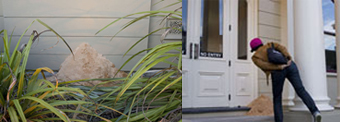
Roman Ondák, Camouflaged Building, Wellington, 27 March 2009. Commissioned by Litmus Research Initiative, Massey University for One Day Sculpture
photos Stephen Rowe
Roman Ondák, Camouflaged Building, Wellington, 27 March 2009. Commissioned by Litmus Research Initiative, Massey University for One Day Sculpture
Roman Ondák’s project, Camouflaged Building, which took place on March 27 at the site of the Old Government Building on Lambton Quay, reconciled effortlessly with Verwoert’s proposition for public intervention as non-event. Designed in an Italian Renaissance-style and erected on land reclaimed from the sea, the Old Government Building is made entirely from native New Zealand kauri and is the largest wooden building in the southern hemisphere. The structure is emblematic of colonial conquest and exemplifies pretence; the painstakingly carved timber appears as stone and has been subsumed into an overbearing narrative of Eurocentrism.
Ondák’s sculptural intervention comprised a handful of unassuming sawdust piles that were installed around the exterior of the building, pressing up against its facade. The piles hovered ambiguously between the suggestion of construction excess—thus drawing attention to the material of the building—and the opposing notion of deterioration, as though termites were surreptitiously corrupting the architecture’s domineering sturdiness. Ondák’s work operated as a subtle interruption to the daily order within this space, in which the certainty of permanence was revealed as a fiction, just as the building presents itself as something it is not. It demanded of its audience an element of attentiveness and exploration, though it delivered very little by way of something to physically examine when it was found. For many people who moved through the site on the day, Camouflaged Building was so restrained it might have passed unnoticed.
Of course, for a major audience contingent, the site was treated as a destination and the prospect of not noticing Ondák’s work was undone on account of knowing it was there and going specifically to bear witness. On the day, the sight of clusters of knowing art spectators peering intently at the sawdust piles seemed to highlight the difficulty of reconciling some of the more compelling perspectives expressed at the symposium with the pragmatics of the One Day Sculpture undertaking. The value of uneventfulness as a strategy to resist embedded audience expectations, and the ideal of maintaining a critical distance from the experience economy, for instance, played off against a highly visible and savvy marketing campaign around Wellington urging people not to miss the current projects with the strap line: “Here today, gone tomorrow.”
Likewise, the symposium’s inherent reliance on secondary documentation as an avenue for providing access to a range of works from the series was under-investigated—at least in this reviewer’s experience—in relation to how the publics of a project positioned as practice-based research might themselves be accessed and articulated in empirical terms. Wilson’s notion of the public as formed through contact with a work, rather than being represented by it, is certainly persuasive. But it raises the significant question of how the impacts of an artwork on a radically abstracted public might be accounted for and not just assumed or imagined, both in the immediate aftermath of a project’s presentation and over time. This topic was left virtually unexplored during the symposium, though perhaps it will surface in the research publication to be released after the commissioning series draws to a close. Whether this is addressed in the project’s public archive will be a telling measure of the extent to which One Day Sculpture has really explored the potential for temporary, place-responsive artworks to engage new publics in new ways outside of conventional art frameworks.
One Day Sculpture: An International Symposium on Art, Place and Time, concept Claire Doherty, convened by Litmus Research Initiative, School of Fine Arts, Massey University, Wellington, New Zealand in conjunction with the Museum of New Zealand Te Papa Tongarewa, March 26-28; www.onedaysculpture.org.nz
RealTime issue #91 June-July 2009 pg.
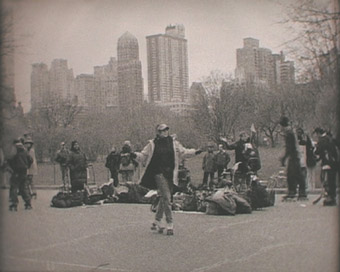
Laresa Kosloff, Sensible World, Artspace, Sydney, 2009
WHILE NOT PART OF A THEMATICALLY LINKED EXHIBITION, THESE THREE DISTINCT INSTALLATIONS ALL EVOKE A SENSE OF NOSTALGIA FOR A TIME OF SIMPLER TECHNOLOGY, PURER ARTISTIC PROJECTS AND MORE HUMAN-SCALE MODES OF REPRESENTATION. TOGETHER, THE MATERIALS AND FORMAL LANGUAGE THE ARTISTS USE, FROM EARLY MODERNIST ABSTRACTION TO SILENT CINEMA TO OBSOLETE VISUAL APPARATUS SUCH AS SLIDE PROJECTORS AND SUPER 8 FILM, SUGGEST A RESISTANCE TO THE GLOSS AND GLITZ OF 21ST CENTURY MODERNITY AND ITS THOROUGHLY MEDIATED SPACES; RATHER, THEY BETRAY A DESIRE TO TEND ONCE AGAIN TO THE VULNERABILITY AND LIMITATIONS OF THE HUMAN BODY AND HUMAN AGENCY. THAT FOCUS ON THE BODY IS UNDERLINED BY THE STRONG INVOCATION OF PERFORMANCE THAT THESE WORKS ALSO SHARE.
Laresa Kosloff’s Sensible World comprises four silent videos projected on small flat screens suspended from the ceiling. Kosloff has been documenting snippets of social interaction in public spaces for some years. Here she has juxtaposed glimpses of Central Park roller-bladers, jog-a-thon competitors, urban trapeze artists and a laughing club meeting around a fountain. Each video has been shot on Super 8, the technology that made the first home-movie possible, then transposed to DVD, three in black and white; each retains the graininess of the original medium, together with its nostalgic glow and analogue warmth. The uniform format, absence of soundtrack and faded documentary/home-movie aesthetics effectively de-contextualise the images from their specific time and place, rendering them equivalent. We are encouraged as viewers to look for the similarities in the scenarios: the way choreographed movement intersects with the cultivation of group identity and belonging, the way shared performance can positively claim pubic space, the way the idiosyncrasies of self-expression rely on drilling a common physical language. The images activate a tension between conformity and individuality, social control and its evasion, and the role of the performing body in negotiating this fine line. Yet the work ultimately affirms the ability of the individual and the casual group (as much as the artist) that each ‘performs’ in unexpected ways to resist the colonisation of public space by vested commercial and political interests. Moreover, the apparent ‘timelessness’ of the footage checks our instinct to treat this ability as quirky nostalgia.
Kosloff has in the past collaborated with Alicia Frankovich, and it is easy to see why, given their work shares certain sensibilities and concerns, both engaging with low-tech media and the poetics of the human body. Performance is integral to Frankovich’s practice, whether explicitly enacted or implicitly referenced. In part this comes from her background as a competitive gymnast. As a strict regime that openly aims to discipline the body and construct it in as technically perfect a form as possible, gymnastics is a powerful metaphor for the subtler injunctions to perform and conform that our bodies suffer everyday in contemporary culture. Frankovich’s performances, recorded on video and projected small-scale at floor level onto obsolete technological hardware, are reminiscent of seminal video-as-mirror works such as those by Bruce Nauman and Vito Acconci, where the artists recorded the banal minutiae of their studio routine, or observed their endurance of absurd physical rituals.
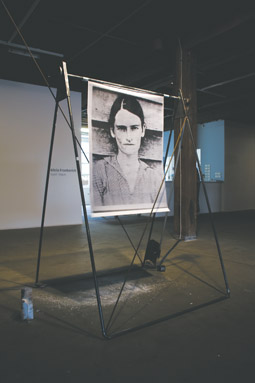
installation view, Alicia Frankovich
photo Silversalt
installation view, Alicia Frankovich
In the most compelling component of this installation, Frankovich has constructed a simple metal armature that brings to mind the uneven bars, complete with gymnast’s chalk. Here she has suspended a poster-sized photocopy of Walker Evans’ portrait Alabama Tenant Farmer Wife [Allie Mae Burroughs] (1936), an icon of both the Great Depression and activist documentary photography, made doubly famous by Sherrie Levine’s appropriation of it in After Walker Evans (1981). In Frankovich’s version, the image vibrates as the metal apparatus squeaks in a semblance of old-fashioned hand-cranked copying; the image is condemned to be endlessly copied to retain its acuity, just as a gymnast is condemned to endlessly drill her routine. Yet, as in Kosloff’s work, the low-tech aesthetics serve to remind us of the possibility of (manually, literally) intervening in the transmission of mainstream meanings.
Shane Haseman’s installation also makes reference to the potential of art to offer a counter-discourse; he borrows both the language of utopian modernist abstraction (especially Malevich and Rodchenko), and the title of The Rolling Stones’ 1968 hit “Sympathy for the Devil” that enveloped the band in allegations of devil worship given the song’s portrayal of Satan as “a man of wealth and taste” who playfully toys with mortals’ puzzlement at “the nature of [his] game.” Haseman’s work might be described as a tasteful puzzle. Despite being painted on cardboard, that quintessentially throwaway material, there’s nothing cack-handed about Haseman’s radically reduced abstracts. They are meticulously rendered and arranged along the gallery walls with geometric precision, propped up by poles that recall home-made protest signs. The gridlock in which the images are held belies their potential to liberate imaginings of alternative societies with their ground zero aesthetics. To crack the puzzle may require upturning this order, animating these symbols with the messiness of bodies that might ‘perform’ them in public. Yet the visual language remains exhausted and largely mute, such that the work adds little to the re-deployment of modernist abstraction by artists such as John Nixon and his acolytes.
A sense of small-scale, very human resistance to the lightning-speed, high-tech vision of contemporary culture permeates these works. They insist on the presence of the human body and the importance of the hand-rendered; they accentuate the continuing potential for transformation in the minutiae of everyday life. In particular, watching Kosloff’s grainy glimpses of social interaction in public spaces, we are moved by the integrity of human beings—incarnated both in the anonymous figures who roller-skate or laugh in public, and in the artist herself—who in their modest gestures pursue their Sisyphusian quest to render the world meaningful.
Laresa Kosloff, Alicia Frankovich, Shane Haseman, Artspace, Sydney, April 24-May 23
RealTime issue #91 June-July 2009 pg. 50
© Jacqueline Millner; for permission to reproduce apply to realtime@realtimearts.net
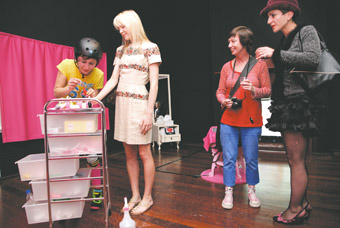
Tanya Visosevic with visitors to Cuticle
photo Justin Spiers
Tanya Visosevic with visitors to Cuticle
THE INTIMATE WORLD OF THE SUBURBAN NAIL SALON IS THE SUBJECT OF WEST AUSTRALIAN PERFORMANCE AND VIDEO ARTIST TANYA VISOSEVIC’S SHOW AT THE FREMANTLE ARTS CENTRE. WHILE THE TITLE, CUTICLE, DESCRIBES THE FINGERNAILS AND TOENAILS THAT DRIFT ACROSS THE SCREENS OF VISOSEVIC’S VIDEO WORKS, THE SHOW ALSO SUGGESTS THE SECOND MEANING OF THE TERM, THIS BEING THE SHELLS OF INSECTS. DIGITS ARE INDEED DETACHED FROM THE BODY, PERFORMING LOOPED ROUTINES WHILST CUSHIONED ON PINK SPONGES AND WHITE COTTON. THEY HAVE A LIFE OF THEIR OWN HERE, AS STARS OF VISOSEVIC’S SCREENS, TO PRODUCE UNCANNY EFFECTS.
Visosevic’s choice of soundtracks is symptomatic of this interest in the strange: Roy Orbinson’s In Dreams (1963), The Carpenters’ Close to You (1970) and Blondie’s In the Flesh (1976) have long been appropriated by cult filmmakers and musicians to evoke the strangeness of American suburbia. Here these dreamy songs ease our way into experiencing the other-worldliness of the show, as does an overpowering smell of cosmetic chemicals, and pink curtains that filter the sun into dim, pastel light.
Looming over the space is Fantasy Nailed, the projection of a diamond studded nail that dissolves into blurs of starry light. Through a series of video-era wipes, the effect is repeated to dazzle its viewer with the spectacle of diamonds and silver light. Yet this is an exception to Visosevic’s series of very small video screens that require us to lean close in order to peer into them. One is placed inside a handbag, another rests upon a child’s pink stool and a third lies in the drawer of a dresser. Their scale invites a certain intimacy, yet their scenes are disturbing, as performing fingers and toes encounter scissors and nail brushes, fluorescent varnishes and, in Pulsating Pink, a hammer-like movement of the camera that appears to break a nail. The seductiveness of the nail salon, its pink and white light, its promise of softness, is ruined as fingers are mutilated and distorted by Visosevic’s expert video manipulations. All this while the voice of Karen Carpenter echoes through the salon-gallery: “Just like me, they long to be, close to you.” The Carpenters’ classic appears obscene rather than innocent, a prelude to something sinister.
In an untitled work that first greets the visitor, a gloved hand reaches across the screen but stops, its fingers slowly curling into the palm. Cut to a sign on-screen that reads “Ring for Service”, but the hand cannot accept its invitation. Hand and sign are looped into an endless hesitation, an infinite regress of uncertainty. Is this because, like Rene Magritte’s pipe in The Treachery of Images (1929), there is no bell off-screen, but only this sign of a bell? This story will never resolve itself. Like a broken DVD we are destined to experience only this moment, this fragment, the rest of the tale forever hidden from us.
Visosevic’s performance of subtle uncertainty becomes the viewer’s own uncertainty in Candy Forever and Emergency. Candy Forever is a mobile phone video, available for visitors to download. A mouth sucks on a middle finger before it appears from between the lips with a green nail, sticking up as if to suggest the owner has given us the birdie, or to tempt us with its strange eroticism. The choice of the middle finger in Emergency Red also turns from seduction to aggression. Situated inside a dresser drawer, cushioned by cotton wool, the video shows a middle finger intercut with titles that recollect a daytime soap opera, a pink lollipop and Visosevic herself in a garishly decorated sadomasochist mask and pink dress. One of her fingers beckons while another urges us to be quiet, appearing to whisper to us some secret that lies within the nail salon, but which we cannot hear.
The montage is on the one hand erotic and on the other perverse and sadistic. It recalls David Cronenberg’s Videodrome (1983), in which footage of Deborah Harry’s lips merge with a television, inviting James Woods to merge with the ‘new flesh’ of the Videodrome universe. So too Visosevic’s invitation to join us on the other side of the screen, inside the fantasy of the nail salon, is at once a temptation and a perversion. The nail salon, ostensibly the subject of the show, is but a window into concerns about the perverse qualities of the screen and the life of digits themselves.
Tanya Visosevic, Cuticle, Fremantle Arts Centre, April 7-May 24
RealTime issue #91 June-July 2009 pg. 53
© Darren Jorgensen; for permission to reproduce apply to realtime@realtimearts.net
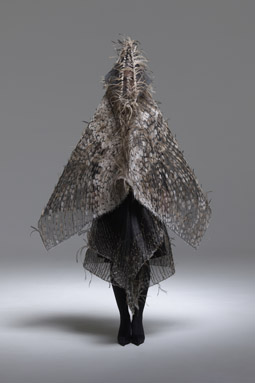
Ruana 2008, Lambda print on photographic paper, Emu Wear, Maria Fernanda Cardoso, GrantPirrie, Sydney
image courtesy GrantPirrie
Ruana 2008, Lambda print on photographic paper, Emu Wear, Maria Fernanda Cardoso, GrantPirrie, Sydney
THERE’S NOTHING QUITE LIKE A GALLERY CRAWL TO TAKE YOU OUT OF YOURSELF. ASSUMING MULTIPLE PERSPECTIVES OVER A SHORT SPACE OF TIME OPENS THE MIND TO ALL SORTS OF POSSIBILITIES.
Case in point. Who would have thought to take the components of an emu and reassemble them in a hybrid exhibition of sculpture, photography and exotic garments? Well, this idea has kept the ever-inventive Maria Fernanda Cardoso busy for a couple of years (2006-2008) and culminated in the surprising exhibition, Emu Wear at GrantPirrie Gallery in Redfern [p3].
Entering the gallery is like stumbling upon a sombre place of ritual or homage. At first you gaze in wonder at the garments on display, marvel at the immense variety of tone that exists within a palette of browns and greys. Then you’re struck by the sheer ingenuity of the artist’s intervention, the intricate weaving and shaping of variously sized and shaped feathers into capes, hoods, undergarments (!). Glamour glowers at the bird’s own mundane appearance. Unsettling sensations creep in. An eviscerated emu appears on a plinth, elsewhere a pair of preserved feet and legs hang from the ceiling, others are fashioned into the shape of boomerangs. Thoughts of the birds’ demise niggle. The large, stately photographs on the wall are telling. As if standing in for the artist, serious young models invoke a blend of faux indigeneity, ironic fashion statement and something else besides. Enveloped in the plumage of this ancient creature, they gaze inward or peer out at us from the other side.
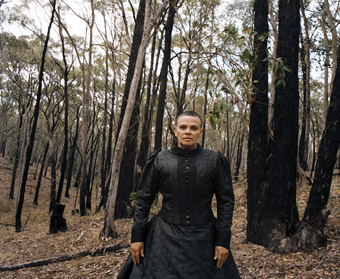
from triptych PolesApart3, 2009; c-type photograph, r e a, BreenSpace, Sydney.
images courtesy of the artist
from triptych PolesApart3, 2009; c-type photograph, r e a, BreenSpace, Sydney.
For different reasons, the same unsettling sensation is sustained at BreenSpace in media artist r e a’s PolesApart. Again, we enter a room of large photographs. Though it’s small, we might be in a gallery of McCubbin’s and Streeton’s. In this series of commanding triptychs, a narrative unfolds. Amidst a burned bush landscape, the artist appears wearing a black crinoline that might suggest mourning or service, perhaps both. Her hair close cropped, feet hidden beneath the dress, she flees from an unseen pursuer, glancing around her as if threatened from all directions. In one image she sinks to the ground, her dress ballooning around her. In another she hovers uncertain behind a tree. A small but imposing figure, she is dwarfed by and sometimes disappears altogether amidst the bleak grandeur of blackened tree trunks. In the adjacent darkened room, a video projected onto one wall completes the narrative suggested in the still frames. As the artist runs through the trees, moving furtively into frame, she is violently doused in red, white and blue paint by her unseen antagonists.
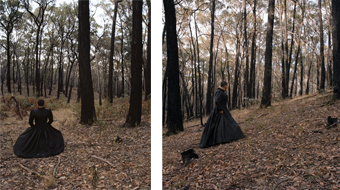
panels 1 and 3 from triptych PolesApart 2, 2009; c-type photographs, r e a, BreenSpace, Sydney
images courtesy the artist
panels 1 and 3 from triptych PolesApart 2, 2009; c-type photographs, r e a, BreenSpace, Sydney
The detailed exhibition notes by Dr Christine Nicholls discuss the work’s many references, in particular the experience of the artist’s grandmother and great aunt who were both stolen from their families in 1916 to be trained as maidservants. One escaped from servitude and returned home, the other worked for a time as the personal servant to Dame Nellie Melba and never again found her family. The choice of Daylesford in Victoria as the location for the images connects with the artist’s underlying research into the Heidelberg artists who worked nearby but “simply did not see the Indigenous presence in that country—Indigenous people were invisible to them.”
The artist takes colonial and art history, personal memory, painful lived experience and distils them into a powerful exhibition, which expresses the frustration and anxiety of living in a country that refuses to truly acknowledge its indigenous history and heritage.
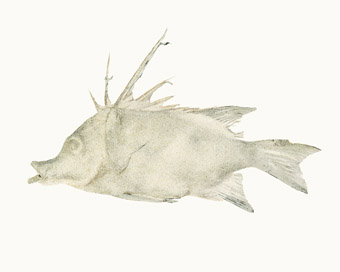
from The Summer of Us, Narelle Autio
courtesy the artist and Stills Gallery
from The Summer of Us, Narelle Autio
Finally when my visual appetite is almost sated, Narelle Autio’s The Summer of Us at Stills Gallery revives the senses. Once again, this photographer whose element is the sea, displays her serious regard for its power and poetry. The gallery is ablaze, white walls displaying a multitude of coloured objects photographed against more shiny white. Gathered by the photographer over one summer from beaches near her home in Adelaide, an accumulation of objects appears at first a taxonomy of refuse. Autio has transferred flotsam and jetsam to her studio and photographed each item in loving detail, using large format film and a light table. Retaining the patina of its age, the depth of detail in its edges and crevices, she turns each piece of trash into a glowing treasure.
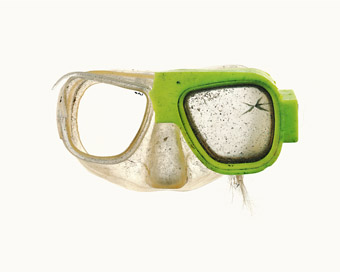
from The Summer of Us, Narelle Autio
courtesy the artist and Stills Gallery
from The Summer of Us, Narelle Autio
Beyond the glare, the pleasures of profusion, the delicate detail enhanced by the photographic process, vision floats. The room becomes a mind or a memory in which you venture connections. Clothing, bottles, toys, tyres, technology’s tacky remains are all in a process of conversion and disappearance. You observe the subtle shifts of nature (fish to sand sculpture, glove to flowering seaweed) whether converting its own familiar materials or appropriating humanity’s remnants. Noble in death, the corpses of birds and fish are preserved in salt and sand. Art approaches science. Autio, curator of everyday spectacle, lays out her evidence in multiples—comparing shark eggs, crab claws, anemone shells, fishing lures. There’s so much to see here that, my head swimming, I have to be dragged away.
At the end of the day, as they say, after this series of shape-shifting experiences, there’s an uncanny sense of resonance and a strange kind of coherence. Historical, zoological, political, personal and anthropological merge in what has been an unexpectedly magical mystery tour.
Maria Fernanda Cardoso, Emu Wear GrantPirrie, Redfern, April 30- May 23; r e a PolesApart, BreenSpace, Waterloo, April 3-May 2: creative team: co-ordinator/director Gail Kelly; designer Amanda Fairbanks; photographic/technical Cathy Laudenbach; camera/editor Peter Oldham; video shoot Assistant Sumai McLean; Narelle Autio, The Summer of Us, Stills Gallery, Sydney, March 25-May 9
RealTime issue #91 June-July 2009 pg. 54
© Virginia Baxter; for permission to reproduce apply to realtime@realtimearts.net
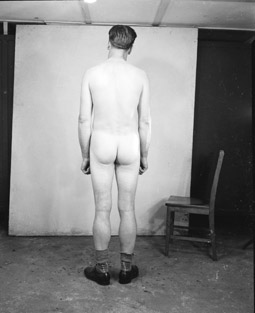
indecent assault on boys, Chatswood, Aug 28, 1952
courtesy Justice and Police Museum Collection
indecent assault on boys, Chatswood, Aug 28, 1952
WE’RE IN SYDNEY. IT’S JANUARY, 1946. THE WAR HAS JUST ENDED. THE TROOPS ARE RETURNING HOME. SHELLSHOCKED. STEPPING OFF A BOAT TO A CITY THAT HAS CHANGED IN THEIR ABSENCE. THE INFLUENCE OF AMERICAN SOLDIERS. THE BEATS OF JAZZ. THE WOMEN MORE STREETWISE. AN UNDERGROUND SOCIETY LIVES UNDER OUR FEET. CHILDREN WHO HAVE BEEN ABANDONED, SLEEPING IN SEWERS AND DRAINS.
And on the fringes, where the city meets the bush, there are places forbidden. Where women are exploited. Making films for soldiers to leer at. We’re drawn to Chinatown. The rooms above the shops. There’s the smell of blood. Closet abortions. The allure of smoke. Men with potions. A place to drift. We join a civilian chaplain who’s on the beat with detectives. Down at Central Street Police Station. He records the daily grind. The small confessions. The advice of cops. The places where crime happens. Murders, beatings, opium, prostitution, porn.
These are the dark spaces inhabited by Ross Gibson’s latest work of fiction, The Summer Exercises—part of UWA Press’s New Writing Series, which encourages innovative texts by emerging and established Australian writers (including Josephine Wilson, Emily Ballou, Fiona MacGregor [RT88, p40] and Sue Woolfe). Gibson comes from a background as a curator and producer of film and interactive media, and along with being former creative director of ACMI, he has also created installations (in collaboration with Kate Richards) for a series of exhibitions based on the collection at the Justice and Police Museum in Sydney: the major immersive audiovisual installation Bystander in 2008-09; and the installations Darkness Loiters in 2001 and Crime Scene in 1999-2000.
The Summer Exercises surfaced from Gibson’s research at the museum and its style is alive and manic in a meld of Peter Corris-pace and place, and the hardboiled terseness of Raymond Chandler—so hot the pages feel they are burning in your hands. Here there’s no nostalgic reminiscence about a bygone era; this is a dark and dirty Sydney, somewhere to try to escape from, not to return to. A stinking city of stifling heat, the kind of place where:
a competition has brewed up among the beat constables: tally every type of rain that can fall on this town.
Rain that is:
cutting
sandy
the size of a coin
smelling of sleep.
And along with a city gone to ruin, there’s an assault on the landscape of the body: the shot memories of a detective cowed and beaten, rediscovering his senses (“Imagine there’s some bladder in the brain and it’s squirting his past life back to him”) and putting himself under interrogation (“What does your flesh have stored up for you?”); the lament of a detective close to retiring (“Pain is rusted on to his lower back. Corrosion has both his knees now”); the intimate meanderings of our chaplain as he watches women dance, on film in tents, tries to resist, subjugated to their peachy flesh:
On the rump of a woman in the burlesque club tonight:
The faint outline of a man’s thumb
+
an intimate welt given by a flicked strap
+
high up where the thigh hinges—some pale skin that promises the taste of pear or vanilla
The only hiccup to the intensity and sophistication of the writing is the fictionalised Publisher’s Notes that interrupt the chaplain’s observations. These notes reflect meanings back to us before we’ve had a chance to discover, like a full stop to our imagination; it’s as if the writer is scared the reader will get lost in the seeking. But the searching is what keeps us enthralled.
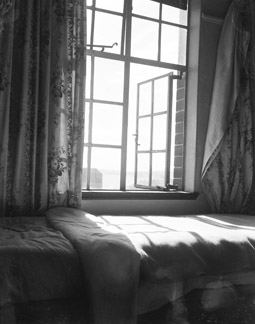
death by accident, Carncleuth St, Kings Cross, Feb 9, 1954
courtesy Justice and Police Museum Collection
death by accident, Carncleuth St, Kings Cross, Feb 9, 1954
After spending five years poring over thousands of negatives in the loft of the Justice and Police Museum, Gibson has selected 230 black-and-white photos of true-crime scenes to accompany his text, and it’s the nature of the real-life images and their delicate placement within the fictional text that packs a punch. We devour each image looking for clues. We map out the Sydney we know and try to find it located in these scenes. Is that Broadway? That building near Railway Square? We wonder at that mugshot: Is that our character who makes the pornos? We try to piece the images together with the text as we read. We wonder at the emptiness within the frames. Why the open window? The eagle-eye view down onto the street? Why is that picture on this page? Where is that lonely stretch of water? We bring the images up as close as they can go to examine the minutiae. Is that a body we can see smeared under the wheels of that truck? Are they doctors’ instruments? The images start to repeat—do they have added significance now?—so we return to earlier parts of the text. The images tease and encourage us. They make us conscious of our need for narrative coherence, to sort, to tie up those loose ends. We glance off them. We try for a deeper reading. These are images to pore over for hours. They demand our attention. We begin to create stories of our own, to see where they lead.
And by the end of the book, the nature of the images is revealed in the List of Illustrations (don’t search them out at the beginning). These are photographs of crime scenes (or places of suspicious activity) where the violence is generally absent: “Man killed by fall, Room 202, Hotel Metropole, Sydney City, 19 March 1954”; “Drowning of family, Sugar Loaf Bay, Middle Harbour, 28 May 1959.” But the sadness, the melancholy, the fear—these emotions linger in the images themselves, traces of disturbia that inform the book’s mood and create a resonance that stays with us, like “an impossible pebble afloat in bubbling water. Disobedient to gravity. Opiate pebble. Blue smoke going in, grey smoke going out.”
Ross Gibson, The Summer Exercises, UWA Press and Historic Houses Trust of NSW, 2008, UWA Press New Writing Series, www.uwapress.uwa.edu.au/fiction
RealTime issue #91 June-July 2009 pg. 55
© Kirsten Krauth; for permission to reproduce apply to realtime@realtimearts.net
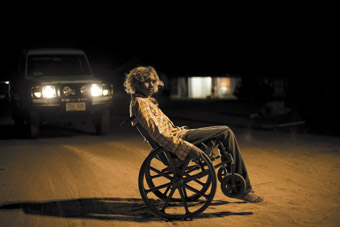
Rowan McNamara, Samson & Delilah
The international prize-winning short filmmaker Warwick Thornton’s first feature film, Samson & Delilah, is something to really celebrate: a grimly powerful account of Indigenous lives undone by petrol sniffing, deep rooted institutional prejudice and challenges internal to Aboriginal cultures. Australian feature films of recent years have been criticised for their bleak vision of our culture, and yet here is a film that pulls no punches, is rarely didactic, and shows how bad it can get for young Aboriginals, and I mean bad. This is a film that has made hardened film reviewers weep, but as Thornton said in our interview, he could not destroy his characters, not in the place where he grew up. He felt an enormous responsibility to show a way out. It’s not a conventional one. It’s not the Intervention. Thornton offers no social program. The answer, and you’ll have to see it for yourself, is as idiosyncratic as his short classics Green Bush and Nana, because the boy and girl at the centre of Samson & Delilah are outsiders, ostracised by white and black Australian cultures. It’s a symbolic solution Thornton offers, but worth no less for that, in a film rich in acutely meaningful symbolism, a world of images, sound and very few words. Thornton joins the Indigenous feature film-making ranks of Rachel Perkins (Radiance), Lawrence Johnston (Life) and Ivan Sen (Beneath Clouds) and will doubtless soon be joined by others from a generation whose talents have been nurtured by the Indigenous Branch of the Australian Film Commission (now integrated into Screen Australia) and other agencies, not least CAAMA in Alice Springs where Perkins and Thornton learned much and honed their skills. RealTime has a proud history of documenting and reviewing Indigenous Australian film. We edited and produced Dreaming in Motion: A Celebration of Indigenous Filmmakers (AFC, 2007), the first book on the subject. One of the 26 filmmakers profiled in it was Warwick Thornton, one amidst a wealth of talent, many of their films still not seen by most Australians. Film festival audiences are notoriously particular, their audience vote for best film often going to quite different films from the choices of judges. The audience for the 2009 Adelaide Film Festival gave their award to Samson & Delilah, contradicting the expectation that such an emotionally demanding film would be rejected, and challenging the mantra that ‘serious’ is bad and even somehow ‘un-Australian.’ RT
–
RealTime issue #90 April-May 2009 pg. 1
© Keith Gallasch; for permission to reproduce apply to realtime@realtimearts.net
from Casula Powerhouse’s Nam Bang!
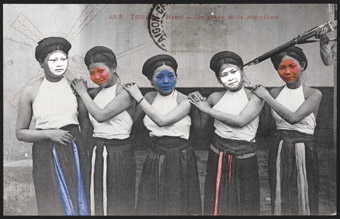
Liza Nguyen, The whores of the Republic, 2008, photograph printed on canvas
courtesy of the artist and Casula Powerhouse
Liza Nguyen, The whores of the Republic, 2008, photograph printed on canvas
“Thirty-four years after the official end of the conflict, Nam Bang! examines the consequences of the Viet Nam War from a generational and international perspective. This is the third in a three stage project by Casula Powerhouse, representing multiple perspectives, from service and non-service personnel who served in, or came from Viet Nam, to protestors and pacifists who opposed the war. This latest exhibition incorporates international perspectives, particularly from the second generation [such as French born Liza Nguyen, Ed.]—the partners, children and families of those of affected by the conflict.” Adapted from Nam Bang! press release.
Casula Powerhouse, April 28-June 21. Echoes of War conference April 17-18, keynote address, US art critic, author & activist, Lucy R Lippard. www.casulapowerhouse.com
from r e a, PolesApart
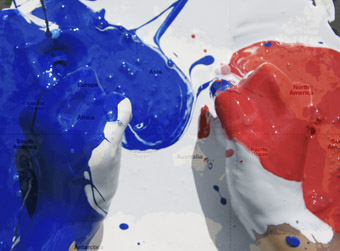
r e a, PolesApart, an installation of 4 triptychs of c-type photographs and a video work
April 4-May 2, BREENSPACE. Image courtesy of the artist and BREENSPACE, Sydney. The work can also be seen subsequently at Manly Art Gallery & Museum, May 1-June 7, as part of the 2009 Guringai Indigenous Festival.
In her essay accompanying the exhibition, Dr Christine Nicholls (Australian Studies, Flinders University) writes: “In Poles/Apart, r e a’ s most recent multimedia work, the artist extends earlier ideas and enters new territory. In the silent video that she has created expressly for this exhibition, r e a embodies, enacts and performs the part of a fleeing figure of an ageless Aboriginal woman. The protagonist is running through a seemingly bushfire-devastated forest of tall, stark, fire-blackened trees. There is little ground cover. She is wearing a long black dress that places her in an era earlier than the present. The woman who has taken flight successively runs, crouches in fear, stumbles, rests, picks herself up again, then resumes her fugue. Why? From what or from whom is she trying to escape? Are her pursuers real or imagined?”
from May’s Lane Street Art Project
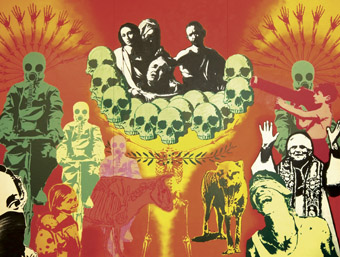
Towards a Better World, Die Laughing Collective, 2006, medium: stencil, aerosol, image © 2009 MAY’S, CarriageWorks, March 25-April 6
As part of CarriageWork’s hugely successful Platform 2 Hip Hop Festival, the building’s vast foyer is filled by Tugi Balog and his team with finely crafted large-scale graffiti and street art from the 2005-08 archive of May’s Lane in St Peter’s, Sydney. Towards a Better World is one of the show’s most striking images—the unusual colour palette, the seamless, layered mix of iconic images drawn from war, protest and Renaissance art reveals a satirical impulse that doesn’t kill the drama. But if John Howard is John the Baptist, who is the Liberal Party Jesus coming in his wake? God help us.
–
RealTime issue #90 April-May 2009 pg. 2-3
© RealTime ; for permission to reproduce apply to realtime@realtimearts.net
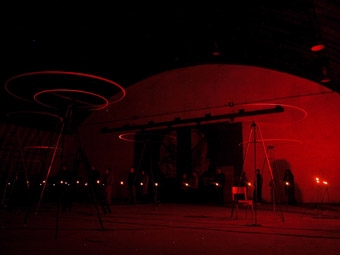
Ray Lee, Siren
courtesy the artist
Ray Lee, Siren
A THROUGH-LINE ABOUT TECHNOLOGY-IMMERSED BODIES EMERGED AT THIS YEAR’S PUSH INTERNATIONAL PERFORMING ARTS FESTIVAL. TO EXPERIENCE SIREN, THE FESTIVAL’S OPENING SHOW, AUDIENCES WALKED AROUND A WAREHOUSE-SIZED ROOM FILLED WITH A CHOIR OF GIANT TRIPODS, LISTENING TO THE STEADY, SEDUCTIVE SOUNDS PRODUCED BY THE TRIPODS’ TWIRLING ARMS. BY CONTRAST, HIROAKI UMEDA’S DANCING BODY WAS ATTACKED BY VIDEO AND LIGHT PROJECTIONS, WHILE THE CHARACTERS IN TOSHIKI OKADA’S PLAY, FIVE DAYS IN MARCH, SEEMED NUMBED FROM LIVING IN THE HIGH-TECH DENSITY OF TOKYO. AND THE FESTIVAL’S CLOSING SHOW, LIVE FROM A BUSH OF GHOSTS, FEATURED A DANCER, TWO DJS AND LIVE-PROCESSED VIDEO PROJECTIONS TO SHAPE CHARACTERS WHO YIELD TOO MUCH POWER TO TECHNOLOGY.
The five-year-old PuSh Festival isn’t themed; it presents “groundbreaking work in the live performing arts.” But after I saw Bush of Ghosts, impressions from these four shows gelled. I thought: if performing arts reveal our obsessions, clearly we’re trying to understand our e-bodies.
ray lee, siren
In UK creator/performer Ray Lee’s hands, technology offers pleasurable extensions of the body. Siren is a large music installation. Thirty metal tripods, from about three to 13 feet high, balance thin horizontal metal arms bearing speakers and tiny red LED lights at each end. Lee and fellow performer Harry Dawes solemnly walk among the ‘creatures’ and turn them on, one at a time. The metal arms twirl steadily, each at a unique speed. Each produces a uniquely toned hum, forming a major fourth and building into a harmonious wall of sound. Spinning, singing, the tripods begin to feel intelligent; they certainly seduce.
When the floodlights snap off without warning, the red lights appear to float. We’re dreaming, awake on our feet. We were so gradually brought to a place of aural attunement that this blindness feels exquisite, not frightening. After a few too-short minutes, the floodlights return and the performers turn the tripods off in reverse order. The silence that follows is both full and hungry: my ears ears feel superbly sensitized, yet want more. A rush of wind sounds like rain against the brick building’s exterior, almost as beautiful as the Sirens had been. Almost.
hiroaki umeda
Choreographer-dancer Hiroaki Umeda (Tokyo) also luxuriates in the play between body and electronic environment, but his two dance works at PuSh explored the malicious side of machinery. While Going to a Condition and its companion work, Accumulated Layout, both present flesh at the mercy of electronically driven apparatus. As the first piece opens, clipped bursts of sound and light lash Umeda, but he stands completely still. By looking downward under a stark spotlight his face is blacked out. The bursts repeat, interspersed with clattering sounds that imply giant robotic cockroaches scrambling inside an electronic system.
Then skinny white lines project around Umeda’s compact stillness. They form sinister x-y axes that lock onto him as if a target of some unknown malevolent force. For the first half of While Going to a Condition, Umeda moves only his knees and his feet sway and twist, hip-hop moves under compression. When industrial engine sounds add aural pressure, Umeda responds with full-body gestures. The sounds climax in a three-minute barrage of strobe lights, until: light blares solid, the sound dissolves into electronic wisps, and the artist finally, finally, looks up—into the pale blue light. It’s impossible to know whether this is death or unification with the machine.
Umeda holds ground against another stark-white-light machine that wants to devour him in the next piece, Accumulated Layout. Seen together, the two works evoke dance-clubs where the entertainment systems have become vampiric. But Umeda’s universe is not campy, he’s engaged in a struggle for autonomous movement.
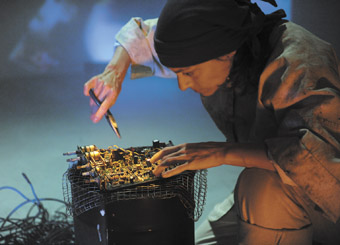
Tara Cheyenne Friedenberg, Live from a Bush of Ghosts, Theatre Conspiracy
photo Chris Randle
Tara Cheyenne Friedenberg, Live from a Bush of Ghosts, Theatre Conspiracy
live from a bush of ghosts
Theatre Conspiracy (Vancouver) similarly strokes audiences with bursts of video and sound, but encapsulate flesh-versus-electronics tensions within short narrative dances. Live from a Bush of Ghosts was co-created by writer Tim Carlson, director Richard Wolfe, the two DJs in No Luck Club, video artist Candelario Andrade and dancer Tara Cheyenne Friedenberg.
Bush of Ghosts is an “open source” performance: the circular stage is backed by a half-circle of tables holding the gear used by No Luck Club and Andrade, who are themselves visible throughout the show. Friedenberg, known for her character-based semi-theatrical choreographies, remains in full view beside the stage as she switches costume between her seven roles. The video projections provide context in some scenes—stock exchange numbers flicker viciously over a desperate day-trader on his cell phone, for example—and in other scenes they are equal partners to the dance.
One of Carlson’s initial inspirations for Bush of Ghosts was Manufactured Landscapes, a film about photographer Edward Burtynsky (Jennifer Baichwal, 2006). The film showed devastating footage of poor workers in remote Chinese villages melting computer parts over fires to wrench off recyclable metals, poisoning their lungs and their water supplies in the process.
The first character in Bush of Ghosts is a Chinese peasant coughing herself to death over melting motherboards. Each of the seven characters is killed by some effect of technology, and yet the No Luck Club’s pulsing soundtrack is pleasurable. An electronically manipulated body is vulnerable, despite the promises of expansion and immortality. And it is also capable of delight, as two other characters—a rambunctious Jezebel and a once-famous gambler—fleetingly remind us.
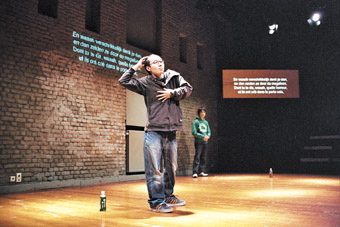
chelfitsch Theatre Company, Five Days in March
photo Thomas Bremond
chelfitsch Theatre Company, Five Days in March
five days in march
Moving from dance to theatre, Tokyo-based Toshiki Okada’s experimental Five Days in March is a (somewhat) narrative-driven play that takes place on a bare stage. It doesn’t overtly comment on tech-bodies, but I include it here because it made more sense to me after I connected it with the Umeda works and Live from a Bush of Ghosts.
The story sounds promisingly sensuous. Gen-Y hipsters Yukki and Minobe meet at a post-rock show in March 2003, just as the war in Iraq begins. They have sex in a love hotel for five days, never exchanging names or phone numbers. Meanwhile, an anti-war protest blocks the streets near the hotel. We don’t get to know much more than that. In fact, we receive an encapsulation of the plot within the first five minutes. From there, the seven actors tell the infatuation story in non-linear order through fragmented and repetitive conversations, sometimes swapping their roles.
The chelfitsch Theatre Company’s actors give total commitment to Okada’s direction. They inhabit a deliberately bizarre, and physically demanding, acting style without indicating that anything unusual is happening. Speaking or not, they move continuously. But their motions have no connection to their words or to each other’s presence. The restless gestures are usually slow and always repetitive. They range from dancelike hand movements to twitches that mimic the ways toddlers squirm when they are told to be still. The disjointed sensuality is both impressive and irritating to observe.
For a non-Japanese speaker reading surtitles, I can’t determine if the language is stilted. Yet it is clear enough that conversations emerge, and motivations do not. For example, the lovers wonder if the war will be over when they leave the hotel, but they’re too superficial for the question to be callous. I think Okada is after something beyond text and naturalistic acting. He strips away plot nuance, character exploration, complicated set and lighting. So what is left? Only these indecipherable, relentlessly casual movements.
Five Days in March interested me at the time, but it felt opaque and only became accessible in the context of the other works I’d experienced. Okada’s characters are in their bodies but their bodies are blank. I start to question if the sex happened or whether the play’s circular conversations are nothing more than text messages or blog postings (one character does blog about wishing to live on Mars). Without physical and emotional knowledge, what happens to bodies? I wonder if Okada is exploring the dissociative state that technological immersion can bring—obliquely, through childlike bodies too uninformed to know their own curiosity.
The PuSh Festival of course included performances about many other impulses and emotions. But when I return my Blackberry to my pocket after emailing this review, I will think further about the fairly thin line between a technology-inflected and a technology-infected body. Thankfully, the artists at the PuSh Festival didn’t offer answers; they offered ways to think about what kinds of technological infestation we might embrace, and why.
Siren, creator, deviser, performer Ray Lee, performer Harry Dawes, producer Simon Chatterton, Roundhouse Community Arts & Recreation Centre, Jan 20-24, www.invisible-forces.com; chelfitsch Theatre Company, Five Days in March, writer, director Toshiki Okada, Performance Works, Jan 21-24; Hiroaki Umeda, while going to a condition; Accumulated Layout, choreographer, dancer Hiroaki Umeda, sound, visual creation, production S20, Scotiabank Dance Centre, Jan 22-24; Theatre Conspiracy, Live from a Bush of Ghosts, director Richard Wolfe, co-creators Tim Carlson, Richard Wolfe, Tara Cheyenne Friedenberg, No Luck Club, Candelario Andrade, design Andreas Kahre, lighting Jeff Harrison, Studio 16, Feb 4–15, www.conspiracy.ca
For more on PuSh see page 39 for Nanay: A Testimonial Play and Assembly and page 5 for Ronnie Burkett’s Billie Twinkle.
RealTime issue #90 April-May 2009 pg. 4
© Meg Walker; for permission to reproduce apply to realtime@realtimearts.net
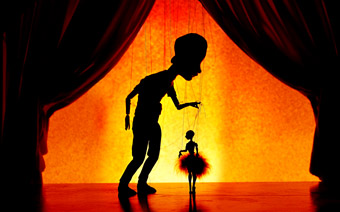
Billy Twinkle, Requiem for a Golden Boy
photo Trudie Lee
Billy Twinkle, Requiem for a Golden Boy
COMPARED WITH RONNIE BURKETT’S LAST TWO WORKS—THE TENDER AND RESTRAINED TEN DAYS ON EARTH (ON TOUR, INCLUDING AUSTRALIA 2005-06) AND THE BRUTAL, BROODING PROVENANCE (ON TOUR 2003-05)—THE PUPPETEER AND WRITER’S LATEST WORK IS FULL OF BUSTLE AND GLITZ. THE PLOT FOR BILLY TWINKLE, REQUIEM FOR A GOLDEN BOY, DEMANDS IT: BILLY IS A CRUISE SHIP ENTERTAINER WHO HAS JUST BEEN FIRED FOR INSULTING PASSENGERS DURING HIS CABARET ACT PUPPET SHOWS. VAIN, MIDDLE-AGED AND FULL OF SELF-LOATHING, THE MAN IN THE DINNER JACKET NEEDS A REASON TO CARRY ON.
Self-loathing often comes from self-absorption. Much has been said about the ‘infantilisation’ of attention spans due to our increasing use of social media and mobile devices (think Twitter, cell phones and other hand-held devices). This January, in a post-performance interview at the PuSh International Festival of Performing Arts in Vancouver, Ronnie Burkett said that exploring self-absorption helped him make sense of Billy. “I didn’t want Billy to be a hack; but it was difficult marrying that miserable adult with his sweetness as a child. I mean, he doesn’t even like his dog!”, Burkett says. “But then I figured out that he’s self-absorbed. The whole world is self-absorbed at this time —does everyone have to be on the phone all the time? Once I found Billy’s self-absorption I was okay—I understood what he represented.”
Burkett creates powerful adult-themed puppet shows that blend his masterful puppetry skills with acting (in this case he is the middle-aged Billy). As Billy heads to the prow of the cruise ship (an environment that certainly promotes self-absorption) he is distracted from contemplating suicide by a rabbit-eared old-man hand puppet who mocks Billy with Hamlet’s “to be or not to be” soliloquy. It’s Sid Diamond, Billy’s sarcastic, brilliant mentor who died before Billy could apologise for their decade-long fight.
From here, Sid prods Billy to re-enact the most important moments in his trajectory from precociously talented teen puppeteer to cynical cruise ship performer. As Sid and Billy argue their way through the decades, it seems almost impossible that Sid, tugging Burkett’s hair or slapping his face, is simply a glove puppet fitted over Burkett’s own hand—Sid hauls Burkett-as-Billy up and down both staircases on the heart-shaped stage. Burkett’s puppetry and writing are so good, his focus so precise, the manipulations convince.
The show’s structure allows for a wide range of vignettes, some bawdy, some intellectual. The drunken socialite Biddy Bantam leans back against Burkett’s leg and bats her eyelashes to sing her “most impressive” aria, a series of lewd double entendres. Benjy, a snotty-nosed peer at the early puppet festivals with Billy, becomes a punked-out installation artist who argues art theory. A Jesus freak sings heartily, off-key, an extremely rough rap song about salvation. Rusty Knockers performs a burlesque striptease, Burkett here reviving an almost-forgotten trick that nightclub puppeteers used to perform on the road in the 1920s in the United States.
Most magical are the scenes where marionettes perform with even tinier marionettes. One of Billy’s teenage training grounds was performing “Stars in Miniature”, a series of nightclub numbers, at a truck-stop bar in a remote Canadian Prairie town. Marionette-Billy easily handles a minute jazz singer in her sparkles and feathers, further evidence of Burkett’s worshipful obsession with making and manipulating marionettes since he was seven years old. Her ‘fallen woman’ songs provide a sweetness soon to be lanced by bitter reality. When the jazz singer rests on the piano, an older man comes over to explain that he finds Billy very, very pretty. (Interestingly, Burkett does not include the erotic scene onstage, leaving its emotional tone ambiguous—“I was curious!”, Billy insists to Sid—a contrast to the much-discussed, lengthy rape scene in Provenance that left people stunned.)
Self-absorption might lead to fragmented conversations, but it’s also spawning a multiplicity of blogs, videos and performances devoted to creative expressions that do connect us, as can puppetry. As Burkett observes: “I honestly think all this online stuff, this digital and wired age which is powerful, is going to make theatre stronger. People who are are always on cell phones and instant-messaging on their Blackberry, they’re coming back to theatre because they just want someone to tell a story in a real voice.” In Billy Twinkle, Burkett delivers tender friendships, blunt questions and raw emotion—real voices that reconnect cynical characters with their earliest passions.
PuSh International Festival of Performing Arts: Billy Twinkle, Requiem for a Golden Boy, written, created & performed by Ronnie Burkett, music John Alcorn, lighting design Kevin Humphrey; Waterfront Theatre, Vancouver, Jan 20-Feb 8
Billy Twinkle, Requiem for a Golden Boy will tour Australia August-October this year.
RealTime issue #90 April-May 2009 pg. 5
© Meg Walker; for permission to reproduce apply to realtime@realtimearts.net
AS PART OF THE 37TH HONG KONG FESTIVAL, THE WOOSTER GROUP HAS DUSTED OFF ITS RENDERING OF EUGENE O’NEILL’S THE EMPEROR JONES FOR ANOTHER OUTING. ORIGINALLY CONCEIVED IN 1993, THIS PRODUCTION IS THE CULMINATION OF THE WOOSTER GROUP’S DECONSTRUCTION OF BLACKFACE. OF COURSE, THERE HAVE BEEN (AND STILL ARE) SOME OBSERVERS WHO CONSIDER IT MERELY A RECONSTRUCTION OF BLACKFACE.
But, back in 1981, before The Emperor Jones was even conceived, the company produced Route 1 & 9, the first part of The Road to Immortality trilogy. Route 1 & 9 was greeted with a gale of controversy, partly because of its blistering desecration of Thornton Wilder’s Our Town but largely because of the use of blackface. The calls of racism and insensitivity reached the bureaucratic halls of the New York State Council on the Arts, which severely cut the Wooster Group’s funding as a result, citing “harsh and caricatured portrayals of a racial minority.”
The director of these productions, indeed the director of all Wooster Group productions, is Elizabeth LeCompte. Grey-haired, with lucid, dark-green eyes, LeCompte has a compelling demeanour that fuses a cutting intelligence with unassuming blitheness. When asked a question in a Q&A that redundantly presupposes her answer, she sees it for what it is and is curt. When asked about her upcoming work, she turns to her producer, Cynthia Hedstrom, for support or deliberately undermines herself with humour. Yet she also shows an unerring confidence in the scope of her imagination and her ability as a theatre maker when she says, of her upcoming adaptation of Vieux Carré by Tennessee Williams, that she is inventing a “completely new form of naturalism.”
LeCompte sees every performance of every Wooster Group show in order to take notes and gauge the audience response, but she claims to be uninterested in comparing her work with that of other theatre makers, preferring to watch films, musicals and “lots of television.” This ability to focus her attention on her own work combined with her steadfast sense of artistic vision and purpose might explain why, notwithstanding the volume of criticism, the Wooster Group continued its use of blackface in not just one but three separate productions.
Amidst all this offstage politics, the visual aesthetic that most clearly infuses The Emperor Jones is that of Japanese Noh theatre. One sees it in the costuming, in the gestural language of the performers and in the makeup. The character of Henry Smithers, a British trader, appears in Noh-inspired whiteface alongside Brutus Jones’ blackface. It is a deliberate counterpoint that manages to underline the use of blackface while simultaneously shifting the cultural reference points with which we view it. In other words, what the Wooster Group have done with blackface is to make it a performative, rather than a pejorative, mask.
Yet, beyond any theatrical coup de grâce that one might ascribe to this deconstructive effort, the reason for LeCompte’s initial interest in staging The Emperor Jones is less grand, though no less valid. Kate Valk, the actress who plays Jones, had appeared in blackface in previous Wooster Group productions and, in LeCompte’s words, was “developing a voice” that LeCompte thought was worth exploring—O’Neill’s text provided the perfect vehicle for a more detailed outing. For Valk, the opportunity to play behind the mask of blackface is an opportunity to be liberated as an actor, to be freed from the psychological barriers of the self and, as a result, to be fully present in the immediacy of the stage environment. Valk explains this by referring to the “two-step process of denial” that wearing the mask entails. First of all, the mask allows the performer to deny their own subjective psychological presence. Second, in then denying that the mask itself exists, the performer is able to fully disassociate the self from the situation and inhabit the stage as an other.
As with the visual aesthetic of the show, Valk’s investigation of masks is indebted to the Noh tradition. Indeed, there are videotapes of Noh theatre that play on a loop on screens that face the actors—Valk is given to watching them as a point of focus in what is, at times, a solitary stage existence. She relishes being able to randomly incorporate gestures from the videos in her performance as a way of keeping things fresh, all without the audience’s knowledge. However, to suggest that the entire show is an ode to Noh would be an unfortunate feat of elision. The Wooster Group work so meticulously on their productions and from so many angles that their work defies any such reductive suggestion of provenance. The choreography for various interludes is snatched from Hawaiian folk dances; the sound design draws on cartoon effects; the video screens present distorted low resolution images that create a deliberately damaged but exacting accompaniment to the live action.
Somehow, in all this feeding on references, LeCompte’s team of collaborators finds a distinct and unique theatrical language that, like the director, has two complementary aspects: one rapier sharp, the other playfully obtuse. The red fly-swatter that almost becomes an oriental fan, the incongruous soccer shin pads and the stage assistant who almost becomes a character all create a slightly tattered sensibility and remind us of the theatre-making. On the other hand, the technological integration, the dynamics of the show and the performances by Valk and, on alternate nights, Scott Shepherd and Ari Fliakos, are far from tattered.
Near the beginning of the show, Valk, in a ragged riff on a kimono, sits in an old office chair in the centre of the space holding a microphone on a black stick, wielding it as naturally as one of her own limbs, or as jauntily as a cane. The whites of her eyes, luminous within the thick mask of blackface, dart and roll, her lips and teeth stretch their moorings as she plunges her voice into a growling baritone. Valk’s virtuosity is astonishing and powerful. She is a picture of both precise stylisation and humanity limited by stylisation. The blackface that, on the one hand, causes furore and, on the other, liberates the actor is more than the sum of its parts. By casting a white woman in blackface who, so accurately, yet so artificially, recreates the stereotypical idiom and mannerisms of a black man, we see the performative nature of the character himself—a man unable to escape the hateful script dealt to him by a history of slavery, subjugation and segregation.
Across the Hong Kong harbour, two weeks later, Akram Khan and Juliette Binoche shared the stage in their self-devised dance duet In-I. To say that Binoche is not renowned for her dancing prowess might imply a dry reproach for a foolish endeavour. Yet, the truth of the matter is that it is exactly because she is not an accomplished dancer that this show even exists.
In-I sits in that realm of contemporary dance theatre occupied by artists such as Jérôme Bel (Pichet Klunchun and Myself) and, newly, Lucy Guerin (Untrained). It is not the tanztheater of Pina Bausch or Meryl Tankard, but rather a dialogic medium that investigates the gap between the physically articulate and the physically inarticulate by juxtaposing them on stage. Bel achieves this through a simple conversation, Guerin through follow-the-leader games, but In-I tries a more unwieldy and less formally clarified combination of choreography and text that butt up against each other but rarely intersect.
Binoche initiated the project after seeing one of Khan’s dance pieces. It is a credit to this artist that she so forthrightly ventures into unknown territory, but there is a sense that Khan has not fully met her enthusiasm with his own. Though Binoche does not quite achieve the extension and line that one takes for granted in a trained dancer, she executes the choreography with unceasing energy and alacrity, even as the sweat pours down her face and her hair becomes a tousled mop, defying her film star credentials. On the other hand, Khan is a performer of stoic restraint and economy, whose face is a stern glaze from start to finish. When Binoche’s arms open outwards, they do so to welcome something in with generosity. When Khan extends his, they seem to deflect and defend. Certainly, there is something of the feminine/masculine binary at work here, but Binoche’s presence is more engaged, more fluent, while Khan’s is determinedly one-note.
In the end, In-I is, as its eponymous pronoun suggests, less successful as a duet than as an insight into two very different artistic talents—the one liberated by exploration, the other troubled by the unknown.
Hong Kong Festival: The Wooster Group, The Emperor Jones, writer Eugene O’Neill, director Elizabeth LeCompte, performers Kate Valk, Ari Fliakos, Scott Shepherd, composer David Linton, video Christopher Kondek, design Jim Clayburgh, lighting Jennifer Tipton; Studio Theatre, HK Cultural Centre, Feb 18-22; In-I, co-directors, performers Juliette Binoche, Akram Khan, design Anish Kapoor, composer Philip Sheppard, lighting Michael Hulls, costumes Kei Ito, dramaturg Guy Cools; Lyric Theatre, Hong Kong Academy of the Performing Arts, March 4-6; www.hk.artsfestival.org
RealTime issue #90 April-May 2009 pg. 6
© Carl Nilsson-Polias; for permission to reproduce apply to realtime@realtimearts.net
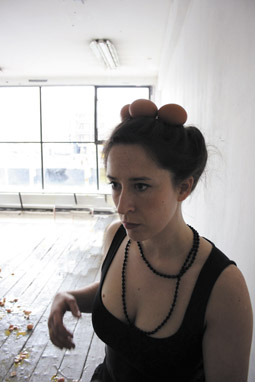
The Bearer, Michelle Browne
courtesy the artist
The Bearer, Michelle Browne
DOWN IN THE SHADOWY, LABYRINTHINE CAVERNS OF THE ARCHES, UNDERNEATH GLASGOW’S CENTRAL TRAIN STATION, FOR FIVE DAYS THE NATIONAL REVIEW OF LIVE ART DRAWS TOGETHER ARTISTS, FACILITATORS, FRIENDS AND PUNTERS FROM ACROSS THE WORLD. THE COMMUNITY QUEUES TO CONTINUE ITS EXHILARATING JOYRIDE THROUGH BACK-TO-BACK MARGINAL, MAGICAL, RADICAL ACTS…AND OCCASIONALLY A TRAIN THUNDERS OVERHEAD. JOURNEYS BEGIN AND END IN PARALLEL WORLDS.
Over three alternate days, NRLA artists in residence Hancock and Kelly Live (UK) present Lone Duets, a series of six solo works, each responding to the previous piece in a game of “performance chess.” The corpse of a hog and a bare human body joined skin to skin in a private embrace become meat to be marinated by the audience; a naked, bandaged man in a pig mask dances an exhausted fantasy, and wine is passed between mouths in another mix of public carnality; a man on all fours inserts microphones into the caves of his orifices and their sound envelops us; Snow White lies naked on a rainbow of wriggling multicoloured maggots as the arteries of her tattoo-heart seep blood. These disturbing, subversive checkmates are wholly at home in the dark, subterranean Arches; each brutally intimate deviance arousing visceral responses, not always subtle, but often engrossing.
Day three and Franko B’s I’m Thinking Of You offers an ideal (and idealistic) refreshment to cleanse the creative palate, reinstilling energy and enthusiasm to overflowing minds. Audiences of 20 are allowed in for 10 minutes at a time. Franko B is naked, sweeping to and fro on a sturdy golden swing. Multicoloured tattoos of gaping totemic faces, red crosses and flames stretch over his hairless head, dance across his portly torso and snake down his limbs. Scars from previous bloodlettings are framed by this beautiful lived-in mural. Gentle musical box notes tinkle from a pianola in the corner. As we stare, he looks each of us in the eye and smiles, and the place glows with warmth.
From behind his tough exterior, in spite of his childhood ghosts, Franko B gives himself to us, he opens up to us all, welcomes us in. He looks at us as equals, as companions, as humans. He wants to remind us of that innocently unconditional acceptance we had as children, before we learned cynicism, distrust, exclusion. We are bound into an intimate connection, the emotion remaining potent long after we are ushered out of the space.
The Elevator Program for early career artists brings us Dublin-based Michelle Browne’s The Bearer: a pithy and succinct snapshot of contemporary western feminist paradoxes. “Glamorously” dressed in a black low-cut corseted top, tulip skirt and painfully high stilettos, Browne takes hen-eggs from a bowl and perches them on top of her nest-like coiffure. In a finishing school routine taken to extremes, she checks this crown in an oval fairytale mirror, turns and struts as if parading down a catwalk. Her precise, clipped, supermodel sashay aggressively suggests she is off to war. As she flounces along, the eggs fall, smashing heavily in her wake.
Posing defiantly at the end of the runway, she turns and treads eggshells as she strides back to the bowl. Oblivious to the crunching, viscous carpet, she repeats this fragile balancing act non-stop for three hours, carrying—and losing—a total of 217 eggs. This is the number, the program tells us, that her ovaries have produced thus far in her lifetime.
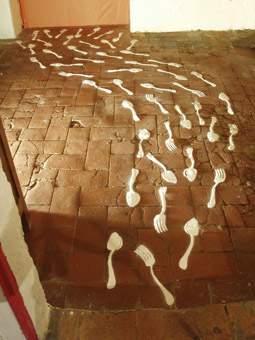
Lesley Yendell, Buscandose el Pan
Spain-based Lesley Yendell’s Buscandose el Pan (literally “searching for bread”) is another tight-knit collection of concepts. A jagged, map-like coastline of flour divides the floor into sea —where we stand—and land, where Yendell labours. Using a wooden scoop to ladle flour from a glass bowl into a face-shaped sieve, she makes it cry, regurgitate, sweat the white dust onto a rectangular stencil frame at her feet. Each time she carefully lifts the frame the audience seems to hold its breath—the slightest slip could distort or blow the image away.
Over two days, she repeats this ritual meticulously, stencilling forks, spoons, sandals and passports in flour across her expansive territory. As these repeated images gradually cover more ground, they travel from our coast, making their way to three heaps of flour shaped into life-size human faces, placed far beyond the strand between us and her—like sperm swimming to fertilise eggs. At the end of the second day, Yendell takes a broom and sweeps all these ‘footprints’ away; the laborious tasks, lives struggled for, and journeys made, wiped from our collective conscience. Buscandose el Pan: searching for bread, economic migration; invisible in an instant.
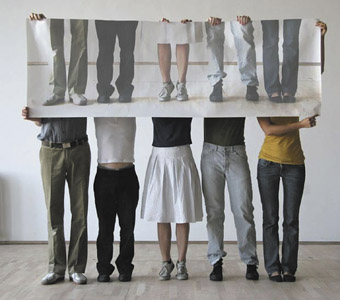
We Were Holding It Together, Ivana Müller
courtesy the artist
We Were Holding It Together, Ivana Müller
Day four sees a move across Glasgow to the Tramway, a venue airy enough to contain the soaring ideas of Croatian Ivana Müller’s While We Were Holding It Together. Five casually dressed performers are frozen on the bare stage, sitting or standing, arms and legs extended in angular positions. There is no obvious interpretation of this configuration. Entirely still apart from darting eyes and minimal expressions, they slowly vocalise possible scenarios: “I imagine we are standing in the middle of a forest. We are on a family weekend and we haven’t seen each other in a while.”
The suggested scene varies: a rock band on tour, a tableau vivant in 19th-century Paris, a minefield in a war-torn country, a seedy hotel room in Bangkok. Stories are built that twist and transform with each “I imagine.” Now and again the rhythm is broken by precisely-timed blackouts and sound effects: summer evening crickets, gunshots and fireworks, a motor driving into the distance. The spoken text challenges us to quickly step in sync with its imaginative flittering, creating our own projected picturebooks. The performers’ strained bodies become increasingly shaky, as their words raise subtle inferences to do with thoughts and physicality, self and other, perception and identity.
This witty existential (end)-game recollects the freedom of childhood play, when anyone can be anything. The figures aren’t always human, and their bodies aren’t always their own: in a masterfully illusive passage the voices are transplanted from one performer to another as live words seamlessly switch to a pre-recording that they mouth along to. When the lights go up for a final time the stage is empty, but the voices continue to speak through the sound system: “Are we now only thoughts?” Not for us. In our minds we can still see the five of them standing there, and know for sure—or at least imagine for a long moment—that, as the final line says, “we are in this all together.”
Day five offers two Vocal Sonics programs: a selection of voice artists and performance poets, perfectly pitched for this Sunday Review denouement. Inuk throat singer Tagaq (Canada) tilts back her head and opens her delicate throat to emit extraordinary, stunningly beautiful guttural growls, primal shrieks, tender squeals and percussive panting. Seemingly channelling ancestral forces, she glides from the calm coo of a bird through the anguish of a mother mourning to the rage of a war-cry animalism. Her ancient-contemporary resonances rouse intrinsic mechanisms in us, perhaps rekindling a sense of long-gone unity: with history, with nature, with the artist, and with ourselves. Maybe soothed by this spiritual massage of our deepest instincts, we are better prepared to make our way back out into the grey quotidian streets of Glasgow.
The brimming trip of each day brought thrills and bliss, even if sometimes the excess—and the long queuing—were overwhelming. There were moments when teetering on the brink of saturation and disappointment (in my case missing Rosie Dennis’ No Entry; by all accounts an incredible show) seemed inevitable. A frustrated audience is a dangerous gamble for such risky work, but the promise of a freshly brilliant buzz each time we entered a new space, seemed to carry us all through, shivering, weeping and laughing to the last full stop.
National Review of Live Art 2009: Hancock and Kelly Live, Lone Duets—Dermographia (2005), Postures A-to-M (2006), Open Wound (2007), Richard Hancock, In Season (2006), The Mirror Pool (2007), Rupture (2008), Traci Kelly; I’m Thinking of You (part 1), Franko B, music Helen Ottaway, lighting consultant Kamal Ackarie; The Bearer, Michelle Browne; Buscandose el Pan, Lesley Yendell, sound Lucho Hermosilla; While We Were Holding It Together, concept & direction Ivana Müller, performance Sarah van Lamsweerde, Peré Faura, Hester van Hasselt, Jobst Schnibbe, Jefta van Dinther, text Ivana Müller, Bill Aitchison, Katja Dreyer, Peré Faura, Karen Røise Kielland, Stefan Rokebrand, Jefta van Dinther, sound Steve Heather, lighting Martin Kaffarnik; Tagaq; The Arches and Tramway, Glasgow, February 11-15
RealTime issue #90 April-May 2009 pg. 8
© Eleanor Hadley Kershaw; for permission to reproduce apply to realtime@realtimearts.net
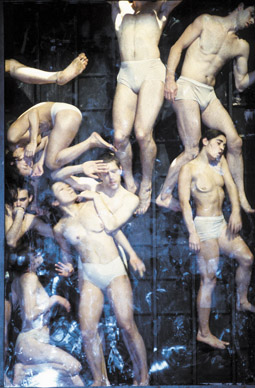
Sasha Waltz and Guests, Körper
photo Bernd Uhlig
Sasha Waltz and Guests, Körper
SET EACH SUMMER IN THE SWELTERING HEAT OF SANTIAGO CITY IS SANTIAGO A MIL, CHILE’S ANNUAL INTERNATIONAL THEATRE, DANCE AND PERFORMING ARTS FESTIVAL. TRADITIONALLY ‘A MIL’ REFERRED TO THEATRE FOR THE EVERYMAN AT 1000 PESOS—ROUGHLY SPEAKING, FIVE BUCKS. THIS WAS IN THE LATE 1980S DURING THE COUNTRY’S TRANSITION TO DEMOCRACY, WHEN THE FESTIVAL WAS CONCEIVED AS A CULTURAL INITIATIVE TRYING TO BURY THE REMNANTS OF THE PINOCHET DICTATORSHIP. TWENTY YEARS ON, ‘A MIL’ NOW CONNOTES THE INTENSITY OF THE EVENT (IT’S COLLOQUIAL FOR ‘FULL ON’) WHICH SPANS A RICH REPERTOIRE OF CONTEMPORARY WORKS PROGRAMMED FOR THEIR REGIONAL, NATIONAL AND INTERNATIONAL SIGNIFICANCE.
The 2009 festival boasted such European artists as Needcompany (Belgium), Sasha Waltz Company (Germany) and Scott Gibbons and Chiara Guidi of Socìetas Raffaello Sanzio (Italy). While most international events are off limits to the city’s underprivileged majority, Orbis Vitae by La Fura dels Baus (Spain) and Paraíso by Mauricio Celedon (Chile/France) were staged outdoors, for which spectators gathered in their multitudes: fans, ice and milk crates in hand.
Augustinian Melody, conceived and performed by Scott Gibbons and Chiara Guidi of Socìetas Raffaello Sanzio, is a sonic performance-installation that draws on the company’s signature themes of attic tragedy and occult imagery, whilst trying to instantiate a new, improvisational stage in their aesthetic. The piece is disconcertingly ambiguous in form, striking a through-line between Happening, trance-like DJ set and archaic incantatory ritual. As its title suggests, Augustinian Melody is primarily an auditory experience, in which a dramaturgy of voice and sound is explored against durational live image and action. An extension of the Cryonic Chants series, the work re-fragments the rhythmic sound score developed by Gibbons for the Tragedia Endogonidia cycle [RT66, p37], in which his defining manipulations of the human voice came to signal the threateningly ghoulish low frequency reverberations of a post-industrial world turned inside out. These vocal threads, already manipulated once, are salvaged in Augustinian Melody and given a more melodic take to position Gibbons’ sound as the central architecture driving the space.
Guidi explains that Augustinian Melody aims to capture a pre-tragic state (the state before the Law, before representation, before the Word) by shifting from image to music and, for the spectator, from eye to ear. The result, darkness, both literally and thematically: the audience enters an intimate concrete studio, and the lights are promptly switched off. At one end, Gibbons unassumingly sounds the space; at the other, Guidi and three other choristers dressed in medieval witch-like gowns enter to summons (or dispel) some kind of ghoul from, it seems, our collective unconscious. The women incant (in Italian and Spanish) while ripping black fabric to reveal a pile of rocks (a grave?) that they then pull apart with increasing fervour. Their actions are chaotic, their words, mesmeric. One phrase I understand: Mi Dispiace (I’m sorry). I’m sorry, I’m sorry, I’m sorry. For whose crime, and on whose behalf, do they apologise? The rocks seem to be hiding the absent dead body for which we all, as global citizens (especially tourists like me), are unwittingly responsible. Against their whispered repetitions, Gibbons’ electroacoustic rumbles, buzzes and booms palpitate to suggest that we are both present and past, technocratic and ancient. As the artists tread a fine line between performative acts of magic and the magic of performance, I wonder when this ghoul will be exorcised.
Körper by German Sasha Waltz Company is a comparably large-scale dance theatre work devised around a thematic exploration of the body. Structured in a series of non-linear vignettes, the pre-show performance comically situates acts of bodily disappearance and reappearance as central to the work’s logic. Intermittent white noise animates hands, arms and legs that peer disconnectedly through an invisible upstage partition—a bodily puppet show, in which the body is puppet and puppeteer combined. The stage partition, in slow light, is revealed to be a stark 10 metre high wall that cuts across the space in a geometry of sparseness and precision. In later images, this wall will become an ominous imposition in scenes suggestive of chase, death and trauma and will gloriously frame semi-naked bodies as they float into its lens from up high, curling and piling flesh on flesh, as if suspended from gravity only to fill out the ultimate renaissance image. Finally and unexpectedly the wall will fall, thunderous and triumphant, in a reference not unobvious to a German audience, opening the stage depth into a black, Zen-like cavern.
Körper is concerned with the multiple historical, scientific and artistic lenses through which the body is understood. Its dancers assemble rigorous group choreographies that poetically render themes of mechanisation (against sonic punctuations of a printing press-cum-steam-train), or references to archaic, Persian ritual (with circular patterns moving across the now sloping but horizontal wall). In these moments, the work is sculptural, creating scenographies that reference key moments in the image repertoire of the 20th century. Waltz conducted rehearsals in the Jewish Museum Berlin, itself a tangled mnemonic structure architecturally bending with weight. The shapes of this original space, as well as the sometimes stringent physicalities of the performers, have absorbed the museum’s imprints, catching us as watchers within a choreographic memory of a memory of The Event. At other times, the dancers are confrontingly informal. They pinch each other; jesting, they narrate stories of plastic surgery, organ transplant, and cancer; they draw around and on their bodies; and they make animalesque assemblages, pairs swaggering as gender-bent creatures. While Körper is not sombre, its ghouls are everpresent—well placed in Santiago city, 20 years on from its horrendous past.
Santiago a Mil: Socìetas Raffaello Sanzio, Augustinian Melody, original music, direction, performance Scott Gibbons, Chiara Guidi, Lastarria, Jan 6-8; Sasha Waltz and Guests, Körper, direction Sasha Waltz, design Thomas Schenk, Heike Schuppelius, Sasha Waltz, costumes Bernd Skodzig, music Hans Peter Kuhn, lighting Valentin Gallé, Martin Hauk, performance Sasha Waltz dancers, Theatre Municipal, Santiago, Jan 5-6
RealTime issue #90 April-May 2009 pg. 10
© Bryoni Trezise; for permission to reproduce apply to realtime@realtimearts.net
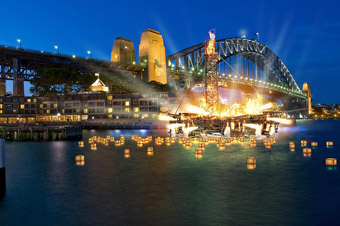
Fire Water, artist’s sketch
HERE’S A FESTIVAL WITH A DIFFERENCE. VIVID, SYDNEY’S NEW EARLY WINTER FESTIVAL OF “MUSIC, LIGHT AND IDEAS” HAS A LOT OF ART IN IT BUT WITH A REFRESHING ORIENTATION TO DESIGN, TARGETED AT LIGHTING AND SUSTAINABILITY. INSTALLATIONS, SPECTACLE, PERFORMANCE AND MUSIC WILL FLARE, GLOW AND PULSE ACROSS THE CITY AND BEYOND FOR THREE WEEKS. LIKE THE ARTS, DESIGN IS GOING THROUGH A PERIOD OF SERIOUS INNOVATION AND HYBRIDISATION. WITH IMPLICATIONS FOR URBAN PLANNING, ARCHITECTURE, THE EVERYDAY AND ART, VIVID WILL PUT DESIGN, WHICH RARELY MAKES IT INTO ARTS FESTIVALS, CENTRESTAGE.
Produced by Events Sydney, VIVID comprises several large programs, the largest of which are the Smartlight Festival, with installations at University of Technology Sydney (UTS) and a Light Walk from The Rocks to the Sydney Opera House, and the Luminous music and light program curated for the Sydney Opera House by music and interactive media luminary and artist-in-residence Brian Eno. Meanwhile the Sydney Harbour Foreshore Authority will stage Fire Water in Campbell Cove, recreating the burning and sinking of a convict transport ship in 1814.
The Smart Light Festival is the creation of its director Mary-Anne Kyriakou. She heads the architectural lighting division of Meinhardt, the energy consultancy, in Sydney and is the Peggy Glanville Hicks Composer-in-Residence, 2008-09. At VIVID’s launch Sydney Opera House CEO Richard Evans credited her with putting the Sydney Opera House in touch with Brian Eno.
I asked Kyriakou about her inspiration for the festival. A lighting trade fair in Germany in 2006 led her to a light festival, which proved a life changing experience. Light festivals are widespread in European cities in the winter months, with their roots in the celebration of the winter solstice. Now they are used, as well, to revitalise public space. One of her influences, she says, is Bettina Pelz, the European Coordinator of Light Festivals. Later, the 2007 Milan Design Fair, “at the height of crazy consumerism, where everything was chrome-plated!”, signalled for Kyriakou what was unsustainable about design and the use of light at this time. The 2008 downturn has provided an opportunity to change all that. The way forward, Kyriakou thought, was collaboration, and she’d seen this in the emergence of the multidisciplinary Licht Kunst (Light Art) movement. She numbers key figures working in this area as some 300 to 1000, including installation artist Olafur Eliasson (who will be featured at the MCA late in 2009).
Kyriakou is hoping that one of the benefits of the festival will be an appreciation of the importance of city night light, to the atmosphere that lighting can create, “a vibrancy, a positive experience, which is often peripheral.”
Kyriakou emphasises that light art practices are largely built around teams comprising different disciplines, with creations emerging in ways “analogous to how an architectural project develops.” Although there’s no lighting trade fair accompanying VIVID, Kyriakou sees the industry as essential to it with leading lighting designers, architects and artists drawing on and being able to play with the very latest in lighting technology.
Kyriakou hopes that VIVID “will take design to the next level” and describes the festival as “a low energy light festival.” She is emphatic that “it’s not about design for design’s sake.” She hopes that, as well as engaging the public, “it will educate the next wave of designers about innovation, responsiveness to the environment and energy consciousness.”
luminous
The suggestion to invite Brian Eno to curate Luminous, says Kyriakou, initially came from Anthony Bastic of George P Johnson Event Management. She thought about it and quickly realised there were a number of dimensions to Eno that made him the perfect artist for VIVID: “He’s a collaborator, he’s multidisciplinary, interested in design and the environment (he has a forest in his backyard) and has created a work involving light—the 77 Million Paintings installation”, which will feature in Luminous. Eno will also create a new work, Lighting the Sails, which wlll transform the exterior surfaces of the Opera House into giant screens.
As well, Eno is curating a program of idiosyncratic musicians from around the world including the Arabic electronica-rock of Rachid Tara, bands from New York (Battle) and Liverpool (Ladyron, with “antique synthesizers played in real time”), the upgraded Irish folk of Damien Dempsey; electronic music from the UK’s Jon Hopkins; New York-based multi-instrmentalist and vocalist Laraaji; Reggie Watts (“One Man. One Loop Machine. Ten Octaves. 300 Characters”); and, not least, trumpet innovator Jon Hassel. As well, The Necks will be performing in Back to Back Theatre’s latest success, Food Court (RT 88, p3). The program will climax with a collaborative concert, Pure Scenious (Eno’s replacement, we are told, for ‘genius’). The Luminous music program, Eno’s installations aside, is the only ticketed aspect of VIVID, and not light on cost.
stockhausen’s licht
While Eno’s music program is not apparently light-oriented, perhaps there’ll be synaesthetic pleasures for the guesstimated 7% of us who experience sound as colour. On the other hand we might get a taste of Stockhausen’s distinctive view of light (with Lucifer on trombone) when Smart Light Sydney, the Sydney Conservatorium of Music, New Music Network, ABC Classic FM, Goethe Institut and Stockhausen Stiftung combine to present a day of extracts from the composer’s seven-day music theatre cycle, Licht. Curated by Roland Peelman and introduced by Stockhausen scholar Richard Toop, it’s free but you need to book.
light walk
The Smart Light Festival’s Light Walk will take viewers, map (available online) in hand, from Observatory Hill through The Rocks to Circular Quay and on to Eno’s Light Sails at the Opera House. On the way they’ll encounter a range of light works, some interactive, some featuring walkers themselves—their movements, their faces, the colours they wear.
UTS-based Tom Barker and M Hank Haeusler’s installation Janus is described in VIVID’s press pack as “a pixel facade of a giant human face hanging above a laneway in The Rocks.” Via Facebook you can submit an image of yourself. The face, “generated by 191 grayscale-controlled light spheres, will modify its expression to reflect the public’s mood…Barker and Haeusler’s installation is part of their ongoing research into complex and non-standard media facades.” This could be scary—the narcissism of the newest media writ large.
One of Australia’s leading light installation artists on the international scene, Sydney-born Warren Langley, will show his towering Vessel of (Horti) Cultural Plenty. Sited near the MCA, it will emit light in response to changing light levels from its immediate environment using a mere two, low-energy 150W metal halide globes. Langley is working on a major light project for the City of Sydney and a light installation for the 2010 Winter Olympics Village in Vancouver.
In their Light Walk installation, Cloud of Bats, Ruth McDermott, Trent Middleton and Ben Baxter will expand on our daily Sydney experience of the twilight flight of thousands of fruit bats while commenting on challenges to the species. From bats we move on to synthetic birds. Sydney-based lighting designers Emrah Baki Ulas and Mirjam Roos’ installation, Birds, relies “on natural light by day and existing in-ground uplighters by night, and not only consumes zero new energy, it actually uses wasted energy.” I hope there’ll be explanatory notes on hand. The birds are made of coloured glass and polycarbonate and will “perch on wires extending between palm trees near Sydney Observatory.” Ulas won CIBSE’s Young Lighter of the Year Award in 2008.
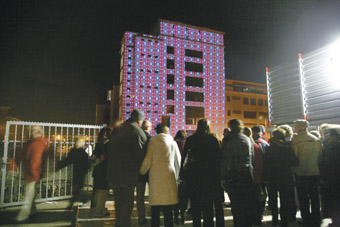
Carole Purnelle & Nuno Maya, The Glow Festival, Eindhoven, The Netherlands 2008
Portuguese artists Nuno Maya and Carole Purnelle “plan to cover an entire building facade in The Rocks with virtual tiles…Using video projectors, people will be able to ‘paint’ the virtual wall of tiles with their clothing colours and movements in real time.” Nuno and Purnelle “manage Ocubo, a multimedia atelier in Portugal that specialises in innovative cultural projects that bridge the real and the virtual worlds.”
You’ve more than likely seen Sydney-sider Andy Uprock’s (or his imitators’) geometric, plastic cup art, Cuprocking, gridded into wire fences around the city and inner suburbs, making art out of what we usually associate with rubbish distributed by wind or human laziness. There’s no light power involved, but the patterned cups catch the light in surprising ways. Architect and designer Michael Day goes a step further with Waste, “wanting his installation for the Light Walk to be scattered along the roadside like garbage.” Household bin bags along Argyle Street in The Rocks will be filled with LED fairy lamps which “will magically light up when approached.” If my garbage lit up, I’d be very worried.
art light exhibition
Artists showing at UTS include Warren Langley, Ruth McDermott (Sea Fan), Bert Bongers (KaleidoFlow), Richard Dunn (The Labyrinth of Light) and Melbourne’s Chris Henschke and Donna Kendrigan presenting Samsara City Lights, “a collage of traditional Lanna decorative motifs and disassembled Bangkok billboard squares, printed as an animated sequence onto bio-luminescent plastic.”
Also on show will be Smart Light director Mary-Anne Kyriakou’s own Prismatic Wave of Light. In Tom Loveday’s A Dark Matter, “individually controlled LED lights…respond to approaching viewers.” Berto Pandolfo’s SQU Lighting Project has been “created largely from sheet-metal [with] a focus on locally sourced materials for a reduction in carbon footprint and uses expertise common to urban communities.” Sydney-born sculptor, painter and poet, Michael Snape’s Colour TV comprises “three paper stencils attached to a regular television…Colour TV comes to life when the screen is switched on, as colour from the programs leeks through the three opaque layers and randomly animates fireworks.”
fire water
The Sydney Harbour Foreshore Authority promises “three nights of flame, food and spectacle in The Rocks.” The authority’s events manager Michael Cohen (of Theatre Kantanka and former Program Director, Live Sites, Newcastle City Council) with theatre-machine maker extraordinaire Joey Ruigrok van der Werven is recreating the burning and sinking of a convict ship, The Three Bees, in Campbell Cove in 1814, twice a night for three nights. There’ll be flames and the ship will really sink, says Cohen; the flames will be real, but the burning will be illusory and the ship will rise again.
While in Newcastle, Cohen says he became fascinated with the the power of fire-based installations, “the beautiful effect on people” and the “associations to do with place and a sense of the everyday that are hard to pull off in arts festivals.” Working with local artists, he generated “some 15 of these installations in the public domain.” He’d been impressed by the fire work of the French company Carabosse at Womadelaide, and is attracted to site-based work and its relationship to interpreting history. Joey Ruigrok van der Werven had suggested the sinking of a ship and, to his surprise and pleasure, Cohen found that the Harbour Authority had an archaeologist on staff who told him about the fate of the Three Bees.
Cohen had also been disturbed that the opening ceremony of the 2000 Sydney Olympics featured many Australian icons but, oddly, not convicts. So here was an opportunity to create a performative installation in which they figured, at least symbolically. But Cohen is not out to create a theatrical narrative or the equivalent of a large fireworks display. He wants people to wander into the cove and embrace the ambience of a cool night, standing around braziers and enjoying food. There’s also a resonance with the traditional bonfire night, says Cohen, when “fire lights up the sky like a cathedral. There’s a grandeur.”
In 1814, The Three Bees, carrying 30 kegs of gunpowder, had unloaded 210 convicts two days before it caught fire. The ship had to be abandoned by captain and crew and allowed to drift while the city had to be evacuated. It burnt out near where the Opera House now stands, almost a calamity, but forgotten, and now a kind of ghost ship in Fire Water.
Cohen’s desire to play with fire, van der Werven’s to sink and raise a ship and an archaeologist’s knowledge combined to have “forgotten history coming up like a ghost ship.” A researcher who provided material for the show actually had a forbear on the Three Bees.
Cohen hopes his audience will enjoy, above all, an interesting night out with music, installations, flame-grilled food, a soundscape and a “a pinnacle moment.” The Fire Water press release adds that “Visitors can create their own floating lanterns at workshops and place them in the bay, each symbolising the many descendants of the 210 convicts who arrived on the ship.”
Events Sydney, VIVID, Festival of Light, Music & Ideas, May 26-June 14; http://vividsydney.com; Smart Light Festival: Light Walk, Art Light Exhibition, Symposia, May 27, June 1, 2, 9, 6-8pm, Stockhausen’s Licht, June 6, Conservatorium of Music, www.smartlightsydney.com; Luminous, Sydney Opera House, http://vividsydney.com/luminous; Firewater, Campbell Cove, The Rocks, June 12-14, www.therocks.com
RealTime issue #90 April-May 2009 pg. 12-13
© Keith Gallasch; for permission to reproduce apply to realtime@realtimearts.net
THE FIRST DANCE MASSIVE IN MARCH (TWO MORE ARE PROJECTED AS BIENNIAL EVENTS) CELEBRATED ESTABLISHED WORKS (ENLARGING THEIR REACH), INTRODUCED A FEW NEW ONES, PUT LARGE SCALE WORKS IN THE MIX WITH SERIOUSLY INTIMATE ONES (YOUR BODY’S PERCEPTUAL PROCESSES AS CO-CREATOR) AND GENERATED ENTHUSIASTIC FULL HOUSES.
Fourteen productions over almost two weeks was ideal for fostering a sense of communality around Australian dance. The manageable scale of the event allowed audiences and a group of visiting overseas presenters and producers to build a substantial picture of the inventiveness and diversity of the field.
Dance Massive’s producers—Arts House, Malthouse and Dancehouse—commissioned RealTime to form a team to write about the works on show and the Ausdance forum introducing the event’s overseas guests. We set ourselves the task of writing not so much reviews as reflections on the kinds of experience offered by contemporary dance. Responses to the work and to Dance Massive as it unfolded appeared online each day and in print at the host venues.
In our features section you’ll find 20 responses to Dance Massive from the team (Melbourne writers Jana Perkovic and Carl Nilsson-Polias; RealTime Managing Editors Virginia Baxter and Keith Gallasch) including new assessments of Chunky Move’s Mortal Engine and Shelley Lasica’s Vianne, the Melbourne premieres of Lucy Guerin Inc’s Untrained, Splintergroup’s Lawn and Roadkill and The Fondue Set’s No Success Like Failure, a fresh look at Helen Herbertson and Ben Cobham’s Morphia Series, and works by Rogue, Michaela Pegum, Jo Lloyd, Shannon Bott & Simon Ellis, Luke George and Russell Dumas, as well as Dance Massive’s party night, 360 degrees. We reproduce five of our responses on these pages.
Australia has long needed a focused national event (a multiple purpose one rather than a festival) where artists, audiences and international entrepreneurs can gauge Australian dance’s diversity, its calibre and impact. The first Dance Massive suggests it may well meet that need. RT
Acknowledgments
Dance Massive is an initiative of Arts House, Malthouse Theatre and Dancehouse in conjunction with Ausdance Victoria and with the support of the Australia Council for the Arts and Arts Victoria. Arts House is a City of Melbourne contemporary arts initiative. With special thanks to Sofitel Melbourne.
RealTime issue #90 April-May 2009 pg. 14-16
© RealTime; for permission to reproduce apply to realtime@realtimearts.net
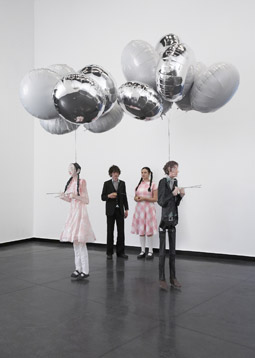
Simon Yates, Rhabdomancy 2009, NEW09
courtesy the artist
Simon Yates, Rhabdomancy 2009, NEW09
realtime: archive update
The complete RealTime editions of 2002 have now been added to our easily accessed online archive. We’re gradually working our way back to 1994, covering a period of astonishing inventiveness and hybridity.The archive is great for an informal browse and likely to revive faded memories and jolt recollection of many more. It’s also invaluable for research. A chance browse took me immediately to Jacqueline Millner’s December 2002 article about leading Australian performance artist Barbara Campbell who, coincidentally has written in our current edition about her recent trip to New York to see the exhibitions celebrating the work of a performance artist who inspired her, Tehching Hsieh. www.realtimearts.net/archive
acca: new09
In a RealTime issue brimming with news and information by, about or for young artists, here’s some more. Since 2002 ACCA has extended a supportive hand to the young and emerging in the form of their annual NEW exhibition. In this, the inaugural year of their partnership with the Balnaves Foundation ($300,000 over three years) ACCA has commissioned seven new works from eight selected artists. NEW09 is curated by Charlotte Day with artists displaying a range of artform crossovers. Justine Khamara works with photography and portraiture, cutting up photographic prints and re-composing sculpturally. Given her environmental concerns, Brodie Ellis filmed the ‘morning glory’ cloud formations of Burketown for her contribution to NEW. Marco Fusinato has created a sculpture “that draws on the aesthetics and spectacular effects of the concert stage.” Simon Yates makes life-sized animated robots from balsa wood and paper. (See photo below. A couple of his constructions are currently making their way through the ACCA galleries. See also The robot that looked like me on YouTube). Matthew Griffin “treads a thin line between black-humour, slapstick comedy and pathos with his low-fi assemblages, videos and photography.” Benjamin Armstrong’s glass and wax sculptures are “an extension of his ongoing sculptural and drawing based project on the world of the eye. The works will make material the act of looking, searching or gazing.”
NEW09, ACCA, Melbourne, till May 17
synaesthesia
Meanwhile, you can get your wires well and truly crossed at ACMI’s Synaesthesia, “a program of free live performances exploring the many forms of moving image, including media art, newly interpreted live film scores and works that draw on sound and film archives.” The program will feature intimate showcases from Mink Engine, Outpost Collective, Robin Fox, Abject Leader, the Ang Fang Quartet, Jean Poole with DJ CanCut, Gossip Pop, Paul Robertson and a live collaboration between Qua and Isobel Knowles, all in Studio 1 as part of Late Night Thursday’s program from April to June. The series is free and begins the first Thursday in April and runs for most Thursday nights from 6.30pm, with Happy Hour at the ACMI Lounge from 5.30pm. Does it get any better than this?
picture yourself
Well possibly. The National Portrait Gallery is encouraging young Australians between 18 and 25 to enter the National Youth Self-Portrait Prize. Entrants are invited to create a self-portrait (produced in the year preceding the prize) in any of the following two-dimensional media: drawing, printing, painting, traditional or digital still photography and screen-based media such as film, video or animation. There’s a $10,000 prize decided by a panel of three judges who’ll choose a shortlist of works for exhibition. A selection of entries, including the prize-winning work, will be displayed at the National Portrait Gallery as well as in an online exhibition from July 23-Sept 13. Entries close April 30; go to www.portrait.gov.au for online submission form.
another splendid opportunity
If you’re under 30 or in the first five years of your practice, and if you’re laterally minded and aesthetically inclined to hybrid arts, then Lismore Regional Gallery, in partnership with Splendour in the Grass music festival, NORPA and Nothern Rivers Art, has a unique offer for you. Young and emerging artists can apply to be part of Splendid. On offer there’s a seriously intensive Arts Lab (a three-week research and development residential laboratory in July 2009 for up to 10 emerging artists), an opportunity for a commision for a new artwork and the chance to market the finished version internationally. The focus is on artists with an inclination for mixing it up, whatever field you’re part of: dance, sound, design, text, visual arts, theatre, installation, architecture, digital media, community arts or something not yet labelled. The mentoring will be by leading established innovators from Australia and overseas. The participants will receive a fee, free accommodation and travel. Applications due: 4pm May 4; www.splendid.org.au
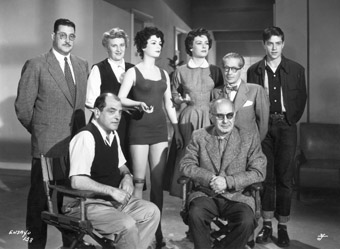
On location for The Criminal Life of Archibaldo de la Cruz. Standing: Jacinto Lasa, Jeanne Rucar, Miroslava Stern,
Jose Ignacio Mantecon and Rafael Buñuel. Seated: Luis Buñuel and Ernesto Ugarte.
México 1955
Courtesy of Centro Buñuel de Calanda
On location for The Criminal Life of Archibaldo de la Cruz. Standing: Jacinto Lasa, Jeanne Rucar, Miroslava Stern,
Jose Ignacio Mantecon and Rafael Buñuel. Seated: Luis Buñuel and Ernesto Ugarte.
México 1955
honouring buñuel
The two great Spanish Surrealists were painter Salvador Dali and filmmaker Luis Buñuel. Dali drew on the grand tradition of oil painting, distorting clocks, human bodies and nature without ever losing the sense of their literal actuality, one reason for his great popularity. Buñuel too could take the real and without visual distortion warp his narratives as if they were the stuff of dreams, sometimes with great subtlety as in Belle de Jour, or as calculated assault as in The Discreet Charm of the Bourgeoisie. Although they collaborated on two classics of Surrealist cinema, Un Chien Andalou and L’Age d’Or, the artists went their own ways, Dali into happy complicity with the Franco dictatorship. Buñuel too returned to fascist Spain where the authorities astonishingly allowed him to make a film, Viridiana, which duly scandalised government and church with its sacrilege and blasphemy and shared the Palm d’Or for Best Film at Cannes in 1961. Buñuel left Spain once again. The full version of this story can be read in the opening chapter of John Baxter’s Buñuel (Fourth Estate, London,1994). It reveals a personality operating on its own terms (friends initially thought his return to Spain a betrayal), politically driven and obsessively atheistical. Baxter quotes Orson Welles’ opinion that Buñuel was “a deeply Christian man who hates god as only a Christian can.”
The 12th Spanish Film Festival is staging a significant retrospective of the work of Buñuel who directed, wrote and edited over 30 films (including not a few very ordinary ones that kept him alive in Mexico) over his long career, including features, shorts and documentaries in Spain, France, USA and Mexico. He won awards at major international film festivals and an Academy Award and a BAFTA for The Discreet Charm of the Bourgeoisie (1972). His un-surreal Los Olvidados (The Young and the Damned, 1950) was one of the first films recognised by UNESCO in 2003 in its Memory of the World Register.
The Buñuel Retrospective includes an exhibition and panel discussions alongside 10 feature films and a documentary about the filmmaker: The Last Script—In the Memory of Buñuel (Germany, Spain, 2008), directed by Gaizka Veresti and Javier Espada, and featuring the artist’s son, Juan Luis Buñuel, a notable authority on his father’s work).
Buñuel—Amigos Y Peliculas (Friends and Films) is an exhibition of 30 portraits of friends (Salvador Dali, Federico Garcia Lorca, Max Ernst and Igor Stravinsky), family and location shots selected from the collection held at the Centro Buñuel de Calanda, Spain, Buñuel’s birthplace. The exhibition includes film posters, letters and footage of Buñuel’s anecdotes about his films. The Director and Curator of the Centro Buñuel and the co-director of the documentary about Buñuel, Javier Espada will visit Australia for the opening of the exhibition
12th Spanish Film Festival: The Bunuel Retrospective: Chauvel Cinema, Paddington, Sydney, May 6-17; National Film & Sound Archive, Canberra, May 7-13; Palace Cinema, Como, Melbourne, May 13-25; Adelaide, May 14-17; Perth, May 20-27; Brisbane, May 21-31st; Buñuel—Amigos Y Peliculas (Friends and Films), Customs House Gallery, Sydney, April 28–May 30; National Film & Sound Archive, Canberra), April 29–late Aug; City of Melbourne Library, May 2-29; www.spanishfilmfestival.com
RealTime issue #90 April-May 2009 pg. 17
© RealTime ; for permission to reproduce apply to realtime@realtimearts.net
THIS IS ONE OF FIVE ARTICLES (THE OTHERS FOCUS ON PACT, SPARK, PLAYWRITING FOR COMMUNITIES AND A TRANSGLOBAL PERFORMANCE PROJECT) ABOUT THE INFRASTRUCTURES, SELF-GENERATED AND STATE CONTROLLED, THAT THAT SUSTAIN THE ARTS, OR SOMETIMES FAIL THEM (IF INSUFFICIENTLY FUNDED OR PLANNED); THE INFRASTRUCTURES THAT ARE NEEDED BUT DON’T EXIST; OR NEW ONES THAT FULFIL GOVERNMENT POLICIES BUT ARE PERHAPS NOT REALLY ABOUT ART. INCLUDED ARE ARTICLES ABOUT A PLAYWRIGHT, ADELAIDE’S STEPHEN HOUSE, EFFECTIVELY WORKING WITHIN AND BEYOND THE USUAL SYSTEMS OF SUPPORT; A HIGHLY MOTIVATED AND NETWORKED GENERATION OF YOUNG PERFORMERS AND CURATORS ASSOCIATED WITH SYDNEY’S PACT THEATRE; YOUTH ARTS QUEENSLAND’S MENTORSHIP PROGRAM, SPARK; AND A CONTEMPORARY PERFORMANCE PROJECT MAKING INTERNATIONAL CONNECTIONS AROUND ISSUES OF SOCIAL SUSTAINABILITY.
At a time when all the organs of society, private and public, are feeling vulnerable to the ill effects of the global economic downturn, Australian artists might be justified in already feeling off colour. In the wake of the Henson affair, the National Association of Visual Arts (NAVA) met with 10 artists in Melbourne threatened with censorship enacted not by governments but largely by anxious, self-censoring galleries, councils and other institutions. The under-nourished independent dance sector in NSW has appeared to be on the verge of tentative recovery in recent years, but the results of Arts NSW funding decisions for 2009 have been devastating. Prime Minister Kevin Rudd has bluntly rejected the NSW Government proposal to jointly fund the job-generating renovation of the ageing and workplace unsafe Sydney Opera House. He also failed to include the arts in the federal government’s economy-improving infrastructure package. In a country without a cultural policy, let alone a Charter of Human Rights, with ambivalent federal government leadership in the arts and rapidly mutating federal and state government arts policies, artists might be feeling not just queasy but justifiably paranoid.
In this climate, the overall health of a complex arts ecology is difficult to assess. Parts of it are currently thriving as networks grow, of their own accord or with government stimulus, allowing artists to find new niches, resources, partners and the audiences that fuel them. Arts laboratories of all kinds are multiplying and artist run initiatives (ARIs) appear to be on the rise again, assisted in part by targeted funding. In 2008 Peter Garrett announced $6.6m to be spent over four years on young and emerging artists in a wide range of commercial and arts areas. However, in terms of salaries and long-term career prospects, the well-ness of individual artists (working on their own or in groups or companies) looks little improved, if at all, with non-arts multi-skilling filling the gaps in the arts ecology. And many young emerging artists might be wondering what will happen to them once they pass 30; will all the accumulated experiences, advice and business plan skills suffice in the strictly limited terrain of established art where funding has grown so little over so long?
creative industries innovation centre
In recent years, as reported in RealTime, many artists have turned to the universities to bridge such gaps and to further their knowledge and expertise with creative doctorates. Creative Industries schools have been pragmatic about jobs and expanding our notion of what comprises art. Another dimension is the $17 million Creative Industries Innovation Centre, to be hosted by University of Technology Sydney (UTS), launched on February 17 by Federal Government Innovation Minister, Senator Kim Carr and Arts Minister, Peter Garrett. The centre is one of six Innovation Centres funded under the Government’s $271 million Enterprise Connect initiative. Other centres focus on sectors such as clean-energy, mining and remote enterprises. Carr said the UTS Creative Industries Innovation Centre “will give eligible firms access to a free business review, followed up with matching funding of up to $20,000 to implement changes identified.” Garrett said, “This initiative delivers on the Government’s election commitments in Fresh Ideas for the Arts and New Directions for the Arts to establish a centre and to facilitate the development of creative industries in Australia.” The centre’s press release claims that “Each year the centre will provide up to 300 business reviews, 50 incubation services, and assist 2,000 businesses through workshops, seminars and networking opportunities” (www.enterpriseconnect.gov.au). How much artists will benefit from this will depend on the definition of art within the creative industries model and the extent to which the centre sees the arts as just so many businesses.
infrastructure vs superstructure
The prevailing funding model has arts companies functioning in terms of their business plans, building elaborate managerial superstructures on very small creative bases. Over the last decade self-improvement has been the vaunted model for subsidised arts organisations including those in the small to medium sector. Healthy regimes entail improved diet (foraging for more diverse resources), vigorous exercise (training courses, business plans, benchmarks) and team sports (partnerships, mentorings, networking and competition). Companies build elaborate, classic management structures—sometimes unnecessary (and, across the sector, duplicative) superstructures. Alert to this, the Theatre Board of the Australia Council has lifted some of the creativity-inhibiting burden of self-improvement from the shoulders of smaller groups and companies through its Managing and Producing Services (MAPS) scheme (“The middle way: light infrastructure”, RT87, p21). In this model, producers carry much of the weight of management and promotion for the funded companies they take on. MAPS is a collaborative effort between the Australia Council and State Governments, with NSW being a late but welcome addition.
Elsewhere in the ecology, at federal and state levels, there’s been a culling of companies in the performing arts. For example, eleven presumably unhealthy theatre companies were removed from Theatre Board triennial funding and replaced by an eager new eleven for whom there had been, to date, no growth in government funding to the Australia Council sufficient to take them in. So, the Theatre Board giveth and taketh away while enriching the ecology with MAPS and its likes.
riding policy shifts
The impact of the rapidly changing policy landscape was sharply felt with Arts NSW’s short-notice adoption of new policies in 2008 and the ridiculously short time for funding applicants to assimilate them. Early in 2009 the Director of Funding Reform sent letters to applicants who, if rejected and curious to know why, later found that they had failed to gain points for audience access and participation, or regional reach or financial sustainability. The new instruments of assessment were presumably bluntly applied by small panels over several days without, it seems, Arts NSW staff involvement save for prepared State of the Arts artform reports. There had been talk in 2008 of the new panels being cross-artform; some in this odd bunch turned out to be so, but with no apparent rationale—they were Performance; Capital Expenditure; Western Sydney; History, Literature, Music and Community Partnerships; Visual Arts and Museums. In performance, there was only one dance peer. That can’t be peer assessment in any serious sense—where’s the sharing of information and opinions, the debate, the testing of knowledge? As for cross-artform, where was the artform paper on hybrid arts and multidisciplinary practices currently so widespread and embodied in Performance Space, CarriageWorks and RealTime and the artists they represent?
For the first time in its 15 years, RealTime was not funded by Arts NSW, despite the magazine’s huge print run, considerable reach, its positioning of the arts in NSW in a national and international context, and despite its steady financial growth and lean operation with a staff of three. RealTime makes widely accessible the considerable innovations occurring in the arts and promotes established and emerging innovators. Most of what you read in RealTime you will not find in newspapers or on television or radio, and yet we cover significant artists, some playing or exhibiting to small audiences but changing the very nature of artforms, others reaching big audiences, crossing borders and oceans, if often unsung in the press. If you live in Western Sydney or in regional NSW, RealTime in print or online gives you access to the greater world of art you are part of as artist or audience. We see our role as infrastructural, sustaining a sense of community through providing information, overviews, criticism and debate.
dance drama
When we heard that independent dance artists applying through Performance Space all had their applications rejected (rules require individual artists to apply for funding for their projects through program grant organisations), we suspected that the reformed Arts NSW had failed to address dance in terms of viability and infrastructure. What about the dance artists who could not, in the first place, secure the interest of an organisation like Performance Space to auspice them? What information was provided in the State of the Arts material for the Performance panel? What are Performance Space, CarriageWorks, Ausdance NSW and Critical Path without a functioning body of dancers and works? In one funding round the fragile independent dance ecology had been dealt a harsh blow, potentially reducing the already limited volume of dance in NSW and its need for continuity and development. It was disturbing to see established artists of the calibre of Tess de Quincey, Martin del Amo and Shaun Parker not funded by Arts NSW for 2009. Fortunately some of the rejected dance artists have since been funded by the Australia Council’s Dance Board. Arts NSW has been let off the hook. However, usually relying on funding from both state and federal governments, the dance artists will go into production on meagre budgets—hardly a satisfactory outcome.
reforming the reforms
A discussion paper was released by Arts NSW a few weeks ago (Arts NSW—Arts Funding Program: Issues for 2010 Funding Round, March 2009) inviting comment. It reveals awareness of the shortcomings the first round of ‘funding reform’, including the challenge for dance artists to secure auspicing. Three of the papers “identified issues” are: “auspicing and individual artists”, “improvements that could be made to the Arts Funding Program structure, guidelines and application forms”, and “(c)hanges to administration and assessment processes, including the involvement of Arts NSW staff in these processes.”
With regard to assessment, it is clear to me that the odd artform makeup of the panels needs to be seriously addressed, as does the notion of a peer if, as was the case for the 2009 round, it’s reduced to a solo or narrow range of judgement. Why staff were not involved in providing active rather than written artform overviews is a mystery: presumably part of the reform process, to distance them from decision-making. Of course they should not vote and should not offer opinions on the quality of the work being discussed but their role in advising on ecology and infrastructure is vital so that panels don’t operate in a cultural vacuum, a foundationless infrastructure.
For Daniel Brine, the Arts NSW funding results for dance were presumably not a great welcome to his new position as director of Performance Space. He’s particularly curious about how the artform sector papers were written: “It was made clear to us that they were information only papers and not in any way about assessing, but there’s a really interesting question about whether the papers are trying to set policy and direction or are for information only—which is a difficult matter in itself. And there wasn’t an information paper about hybrid work, and that in itself is very telling.” Brine thinks that, given Arts NSW’s interest in being as transparent as possible, the papers in the future would ideally become publicly available.
seeking clarity
Brine also thinks that “Arts NSW needs to say more about why they see their intended policy benefits as important. They talk about supporting ‘industry professional development’, fine, but they need to say what it is. Is it investing in leaders in the future or artists so they can manage themselves?” He points out that the discussion paper reveals that there is some admission of not adequately getting the access and participation criteria right. The paper acknowledges that “A range of locational, organisational or programming related factors may impact on audience participation, such as: Whether an organisation is producing or presenting new or challenging work or…popular or more traditional works.” You’d have thought that this would have been automatically taken into account for the 2009 assessments, but a technocratic application of criteria meant that it wasn’t, not least for small innovative dance ventures playing to small audiences and with minimal income and reserves.
Daniel Brine has no problem with a funding body setting policy directions, “but these are used for assessment, so they’ve got to be clear, otherwise there’s confusion.” In particular, he thinks that there needs to be clarification around auspicing. For instance, for the audience development criterion: “whose frame of reference will be used, the artist or the auspicing organisation?
The application for 2009 was in terms of ‘us’, Performance Space. We might have missed the opportunity to present a broader understanding of audience development, in particular from the point of view of the artist.
It’s clearly one of the teething problems that come with completing new application forms, answering questions not seen before. I think the situation will become clearer and there will be less room for different interpretations as Arts NSW redraft their guidelines.”.”
Given that the funded auspiced artists become part of Performance Space’s program, I ask Brine if it puts the organisation in a double bind when some works are funded others not. He says. “It means in essence the funders are choosing our program, both funders, Arts NSW and the Australia Council. When the decisions come in we look at our program and say this will fall, this is in. We can’t prioritise. But that’s a decision Performance Space has made. We could have half the staff, we could pump some of that money into our program, announce we’re not going to auspice, that we’re going to buy into programming in a very different way. This would have big repercussions throughout the sector, and there’d be less program. We’ll continue with the old model, but it’s a real challenge.”
expanding the asian connection
A producer complained to me recently that Australia’s international arts festivals have failed to consistently engage with Asian culture, despite there being no shortage of creative encounters between Australian and Asian artists springing from Asialink residencies and the likes of the Asialink-Australia Council Neon Rising Japan Dance Exchange, a significant two-year collaborative, cross-cultural choreographic program (2006-07).
The one Australian festival committed to Asian performance is the Adelaide Festival Centre’s OzAsia, now in its third year. In a new development Rosemary Hinde, director of Hirano, an agent and a producer of dance across Australia and Asia, is now working for Asialink and has been appointed Artistic Counsel for the Kenneth Myer Asian Theatre Series at Melbourne’s Arts Centre. Perhaps a series will provide a less pressured and more enduring approach to integrating Asian art into Australian life and the opportunity to see more challenging work.
structuring asian-australia collaborations
Time_Place_Space has been resurrected to address the Asian-Australian connection. For over five years this Australia Council initiative brought artists from around the country to work with each other and local and international facilitators to explore the potentials of cross-artform engagement. New projects, collaborations and hybrid arts creations sprang with consistency from this two-week annual laboratory. Now, after several years, it’s back, the model mutating towards ever new hybrids—collaborations between Australian and Asian artists. Daniel Brine says, “the Australia Council is keen for TPS to have a life in Asia.” And if the proposed model gets under way, the host organisation for the first expanded version will be Performance Space.
The most recent incarnation, held in Brisbane earlier this year, juxtaposed a meeting between potential Time_Place_Space partners from governments, universities and other agencies across Asia and a TPS laboratory they could witness at work. Australian artists worked with facilitators Arahmaiani Feisal (Indonesia), Tang Fu Kuen (Singapore), Shigeaki Iwai (Japan), and Margie Medlin and Constantine Koukias (both Australia).
Brine says that although the new TPS will service fewer Australian artists each year than the original and that partner expectations will doubtless play a determining role in the evolution of the new laboratory, he’s optimistic about the potential for hybrid practices and Asian partners to join the curatorium. TPS in its new incarnation will build creative and infrastructural bridges between Asia and Australia in very distinctive and innovative ways.
infrastructure hard & soft
In the next edition of RealTime there’ll be more about arts infrastructure issues, with a look at former Performance Space director Fiona Winning’s Rex Cramphorn Lecture, a frank, thoughtful and fair account of the challenges faced by herself, her Board of Directors, staff and artists in the transition from the old Performance Space to the new one at CarriageWorks. She addresses “the often problematic relationships between hard and soft infrastructures—hard being the buildings and equipment and soft being the organisations—the people who work within them creating various patterns of activity” (March 2, Seymour Centre, University of Sydney). And you’ll be able to read about the background, passions and plans of Performance Space’s new director, Daniel Brine, an Australian who worked in England for over a decade principally with the Live Art Development Agency in London.
RealTime issue #90 April-May 2009 pg. 18
© Keith Gallasch; for permission to reproduce apply to realtime@realtimearts.net
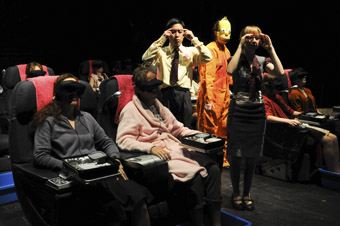
Teik-Kim Pok, Lara Thoms and Naomi Derrick, Holiday, spat+loogie, at Tiny Stadium’s Festival
photo Heidrun Löhr
Teik-Kim Pok, Lara Thoms and Naomi Derrick, Holiday, spat+loogie, at Tiny Stadium’s Festival
IN REALTIME 88, FORMER PERFORMANCE SPACE DIRECTOR FIONA WINNING PAID TRIBUTE TO PACT YOUTH THEATRE FOR ITS NURTURING OF GENERATIONS OF CONTEMPORARY PERFORMANCE ARTISTS. FOR ARTISTIC DIRECTOR REGINA HEILMANN AND ASSOCIATE DIRECTOR CHRIS MURPHY THE TERM ‘YOUTH’ HAS BECOME PROBLEMATIC. HEILMANN REPORTS, “WE JUST RECEIVED OUR TRIENNIAL FUNDING FROM THE THEATRE BOARD OF THE AUSTRALIA COUNCIL AS AN ORGANIZATION THAT SUPPORTS EMERGING ARTISTS. A LOT OF OUR YOUNG PEOPLE ARE BETWEEN THE AGES OF 20 AND 30 AND THEY DON’T IDENTIFY THEMSELVES AS YOUTH. AND WE’VE INTRODUCED PROGRAMS THAT HAVE MEANT THAT THEY KEEP RETURNING TO PACT BECAUSE THERE ARE CONSTANTLY CHALLENGES AND CONTEXTS FOR THEM TO WORK WITHIN. SO, AS THEY’VE GOT OLDER WITH THEIR PRACTICE OVER FIVE YEARS OR WHATEVER, AND NEEDED MORE CHALLENGES, WE’VE WORKED WITH THEM.” I MET RECENTLY WITH HEILMANN AND MURPHY, RESPECTED MEMBERS OF SYDNEY’S CONTEMPORARY PERFORMANCE COMMUNITY, TO TALK ABOUT THE EVOLUTION OF PACT AND THEIR OWN SURVIVAL IN IT.
emergence & mutualism
PACT is now working with these emerging artists by producing and presenting their work, as it did recently with solo works by Georgie Reid and Sally Lewry (RT 89, p35) and Janie Gibson’s The Whale Chorus (RT84, p36) which had come out of a PACT residency. Murphy explains that “PACT presents…” wouldn’t exist if there weren’t works to warrant it: “There has been a natural evolutionary quality about the company over the last seven years. Works rise to the surface.” PACT has also established peer-run labs; most recently Teik-Kim Pok and Ashley Dyer worked for three weeks with 13 young artists all sharing processes: “Teik-Kim had worked with Guillermo Gomez-Pena and Ashley with Roy Hart and each is developing their own eclectic process.”
As well as producing work by emerging artists and encouraging mutual peer support, PACT itself benefits from artists returning to it. The performance trio Post emerged from the ImPACT Ensemble, the organisation’s core activity. One of its number, Mish Grigor has become part of the Quarterbred curatorial team which independently produced the recent Tiny Stadiums Festival (Feb 23-March 8, http://quarterbred.blogspot.com) and the Quarterbred Symposium (Feb 28). Quarterbred has emerged from PACT and is closely associated with it, but its team refer to Heilmann and Murphy only for advice. Ashley Dyer is involved in the peer-run lab, is part of the Quarterbred committee and is also working with Heilmann, she says, “researching the capabilities of our website as to what we can offer in terms of profiling young artists. He’s also researching other presenting partners, venues and organizations locally, nationally and internationally. That’s quite a lengthy process but we should be looking to broker or find pathways to get these artists out beyond PACT.”
While some will need this kind of support, the current generation are already, says Murphy, finding their way to Melbourne’s Next Wave, Brisbane Arts Festival’s Under the Radar, Performance Space’s LiveWorks or a SPARK mentorship (p22). Heilmann adds that this generation has considerable networking and curatorial strengths as well, citing Lara Thoms, “an amazing force”, for her work for Quarterbred which this year attracted 100 applications for its program and included artists from Melbourne and Brisbane. Murphy explains that Quarterbred, now in its third year, came at a time when PACT’s short works program, Zing, was running out of exactly that and “alternative venues like Lanfranchi’s where a number of PACT artists had lived or performed were closing down.” Out of that a committee of seven was formed, including Di Smith of Brown Council, all with responsibilities, and with growing autonomy. Heilmann says that she and Murphy increasingly rely on young artists and curators like Grigor and Thoms because they travel and make contacts. Murphy makes the point that Quarterbred has become, in effect, an Artist Run Initiative with an identity in its own right.
As impressed as she is with one generation’s drive, Heilmann worries about the next PACT generation who might not, she says, have the collective strength of the Quarterbred generation: those “who may need a bit more facilitation, who are less experienced or haven’t got the same drive, or haven’t met their older peers. ‘Succession’, I think, is the word.”
performance at the centre
Heilmann also points out that the company foundation is rooted in performance whereas Quarterbred is much more into hybrid, interdisciplinary art. So there’s a melding happening. “I look after the more foundational aspects of the company where we bring in new people who are interested in what performance can be. A whole range of people come into that program, a lot of non-performers—visual artists, filmmakers, dancers, dramaturgs, writers—just to find out what performance might be about. Then you’ve got people interested in acting and who have quite a traditional understanding of what that is. So a whole conglomeration of people come into the ensemble to learn basic skills and to work together in a facilitated project. That’s the only work that I’ve produced over the last few years, artistically, developing participant’s improvisational and conceptual skills. It’s an eight-month program. We audition in April in a group workshop and try to work out who would make good ensemble players. Then, every Saturday, 20 people come together and train for a full day. Dramaturg Chris Ryan has been a key partner in that, along with Chris and I, plus some others, and then in the last three months we spend more time on what the performance will be. All of the performers have been part of the final work.”
But the time has come, Heilmann says, “to maybe up the ante a bit, because young people have so many commitments. There seems to be this need to do a lot of things now, getting on with their own thing, doing this project and that project. Life gets in the way. And you ask, where’s the continuity? Where’s the commitment? Where’s the rigour? And that’s been frustrating. So we’re really looking to how we can introduce some procedures to ensure that people do take it on as a commitment and are serious and professional about it.” Murphy adds, “Rather than feeling frustrated again, we’re thinking well, why don’t we just change what we’re doing? If only five people end up working on the piece, it’s cool!”
focused diversity
Where do PACT performers come from? They’re attracted, says Heilmann, by word of mouth, by seeing PACT shows, by encouragement from people like Clare Grant at University of NSW, “a huge advocate of the program”, Paul Dwyer at Sydney University, Yana Taylor when she was at the University of Western Sydney.” Who are the participants? Largely white middle class, says Heilmann: “we do encourage diversity but it’s quite tricky to get people through the door in that way.” But PACT has a history of focusing on cultural diversity in other ways. “Former PACT director Caitlin Newton-Broad instigated the first community project called Stand Your Ground in 2001 and it connected with Alexandria Public School and kids came into PACT and did various sessions. It was a bit like a danceathon or eisteddfod with a set and beautiful lights, people having a good time, a bit of modelling and stuff like that. It was great. Performer Karen Therese came on in 2005 as our Community Cultural Development artist and she made contact with the Block in Redfern, introduced herself to all the youth services and local communities and made the project Gathering Ground at the Block.” The resulting events were notable successes but, say Heilmann and Murphy “huge and consuming in 2006 and 2008” and “hard to align with our key mission, which is about support for emerging artists.” So, another adaptive decision was made, “a handover of the Gathering Ground project to Redfern Community Centre to run. Last year was a transitional project. It attracted a lot of little kids. It was good. Legs on the Wall are continuing to work there.”
PACT’s attention to diversity is meanwhile channelled through the Karen Therese-initiated Step-Up Project which Murphy explains “is a targeted residency mentorship for emerging indigenous artists. We also have Vacant Room, which is an open program while Step-Up is a targeted residency. The residency/mentorship program runs over four to five weeks. Last year we had three teams. Regina did pretty much all the project management for that last year with a bit of help from me.” Heilmann adds that “we can actually work on skills and showing the work of emerging artists who are already passionate and keen to work within a creative field, who are already doing it and just need a forum or a context, which is more aligned with what we’re already doing.” The participants are coming primarily at the moment from Eora TAFE as well as NAISDA and Wollongong University.
staying alive
I ask Murphy and Heilmann about how they’ve sustained their own lives as artists while running PACT. This is obviously less problematic for Heilmann who directs the imPACT ensemble productions. Murphy continues her connection with Theatre Kantanka: “I must say the period I took off last year to work on that show was like coming back to something that was pure, unadulterated pleasure. It was completely intoxicating and I realised, okay, this is me with this hat on and going back to PACT is just a completely other hat.” She’s also appeared numerous times with Toy Death, the experimental sound performance ensemble: “It fulfilled my need for excitement.” Heilmann says, “I’ve been very satisfied as a director, because it’s been my primary output. I derive great pleasure from making work and creating dynamics and pictures and working with rhythms and space. So that’s been very fulfilling. In terms of my life as a performer, well I’ll do a Tony Osborne workshop and whip up a performance once in a blue moon. And I did actually lock myself in a studio last year to start working on a solo and did a 20-minute piece for the Goethe Institut’s GerMANYVoices festival. I’m working with Gail Priest now on a little creative development and with Nigel Kellaway later in the year in a residency at Performance Space. So, little bits and pieces. But first and foremost, it’s been exciting working with all these emerging artists.”
In another adaptive move, four years ago Heilmann and Murphy dissolved their co-directorate with Heilmann becoming artistic director and Murphy associate director. Murphy says: “I do most of the project management for all the programs we run. I look after programming the space and almost all the communication with our constituents. And teach on a Saturday afternoon, run the box office and bar, organise that and do most of the publicity.’
I ask how many days the directors each work. Murphy: Ten! Heilmann: We get paid for four! Both still clearly enjoy the job: “Even though we’re not doing the same job, we’re sharing the responsibility for it.” They know about burn-out, they say, and stagnation, but “as long as we feel the place is evolving, as long as there’s change, then we feel like we’re okay, PACT’s okay.”
Clearly the productive work PACT is doing for its emerging artists, white middle class or Indigenous, training them, offering them production possibilities post-imPACT Ensemble, encouraging independence and a life beyond PACT with an alertness to the possibilities of hybrid practices, is a proven success. By adopting an adaptive approach to PACT’s programs and their own careers within the organisation, and by allowing PACT’s ‘graduates’ a strong creative role, Heilmann and Murphy have ensured continuity and development for an organisation that contributes much to audiences and emerging artists in New South Wales and beyond.
RealTime issue #90 April-May 2009 pg. 19
© Keith Gallasch; for permission to reproduce apply to realtime@realtimearts.net
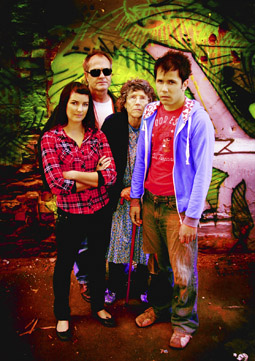
The Yum Yum Room, The Professional Collective, Stephen House second from left
photo Francesco
The Yum Yum Room, The Professional Collective, Stephen House second from left
“I CAN’T AVOID IT. MY HISTORY AND BACKGROUND DRIVES MY WRITING”, SAYS ADELAIDE-BASED PLAYWRIGHT STEPHEN HOUSE ABOUT HIS WORKING CLASS ORIGINS, LEAVING SCHOOL AT 14 TO WORK IN A FACTORY. WITH LITTLE EXPERIENCE OF THEATRE UNTIL HIS 20S, HOUSE BELIEVES THAT, 15 PLAYS DOWN THE TRACK, HIS WRITING EMERGED FROM HIS STORY-TELLING ABILITIES RATHER THAN ANY INHERENT SENSE OF DRAMATIC STRUCTURE. WHATEVER HIS BEGINNINGS, HOUSE HAS BECOME ONE OF THOSE RARITIES IN AUSTRALIAN THEATRE, A PLAYWRIGHT NEVER SHORT OF WORK.
The stuff of his writing, House thinks, is “the theatre of hanging out on the streets” and “having a keen ear for the way people are and speak.” Theatrical influences have been few, save Tennessee Williams after the young labourer and part-time waiter found himself at a production of The Glass Menagerie, “tears streaming down my face. Then I devoured every play he’d written.” House didn’t go on to emulate Williams (although there’s a poetic streak in the heightened realism of his dialogue), but he’d discovered the power of theatre.
House explains the chance way his playwriting began. “I used to chat with director Geoff Crowhurst at the Exeter Hotel about storytelling and how I was going to be a poet. He told me to see plays. I did, and did some acting, and I wrote Cracks in the Wall (1993). And he surprised me, said he was going to direct it. It packed out and got a good review!”
a life for the theatre
House had no problem finding subjects for his new passion. “I write about the underclass, the abused and the marginalised. I’m fascinated by stories of struggle and survival. I never thought of myself as a political writer until someone said, ‘You’re one of the most political writers I know because you represent in your plays an unrepresented part of the population.’ There are some middle class characters in my more recent plays but I drag them down to a place of survival.”
It’s not simply a matter of observation; House says that some of his own life has found its way into plays like Miss Blossom Callahann (2006, adapted for the stage from an earlier radio play) and Vin (2005, commissioned and premiered by Jigsaw Theatre Company, Canberra). Miss Blossom Callahann is a grim, fast-paced account of a desperate hour or so in the lives of an ageing prostitute and two men driven by the need for money that will buy alcohol and junk and fuel dreams of unlikely escape. Empathy is pretty much out of the question but you get to know the deficiencies and rationales that drive these lives. In Vin, House also pushes his young characters towards despair but, with great subtlety, allows them to work through it to the beginnings of maturity, understanding the world and themselves as more complex than imagined. It’s a lesson in empathy, for the characters and audience, without ever being didactic and, for a play written for young audiences, wonderfully adult. The dialogue is spare, but equally rich and the dramatic structure assured.
community commissions
House never planned a playwrighting career. It happened, he says, “because other people saw something in my work. The strength came from the audience.” A rush of plays ensued including many commissions. “A surprising turn in the last five to six years is being commissioned to write in response to certain issues. It’s like being handed a puzzle. The Yum Yum Room, emerged from a talk House gave in Mount Gambier about theatre for social change. A council health worker approached him to discuss the high rate of youth suicide in the region and soon the writing of a play was funded by the City of Mount Gambier Council. Out of that came a production managed, directed and performed in by House, opening in Mount Gambier, playing soon at the 2009 Come Out festival and then in Whyalla. But this is no simple touring production. House has created a distinctive model for working with communities.
“I live in your community, I research, I hang out. In Mount Gambier I spoke with a couple of hundred people. I ran workshops. I have a box there where people can leave anonymous statements. In three months I have a first draft which will be close to the finished play.” The play got a strong response in Mount Gambier (“eight sold-out shows and seven high schools”) and, for Whyalla, has been funded by Country Health SA with support from Country Arts SA in a co-production with local company D Faces of Youth Art.
Other than his own role, House cast the Mount Gambier production locally: “I don’t want to bring in an elite group of city artists. In every community there are talented artists.” When he goes to Whyalla, he’ll again use locals, working three days a week with them over a seven week period. For Come Out he’s cast Adelaide professionals.
House thinks the totality of the model he’s developed is ideal for non-arts organisations, with its direct community engagement and his own involvement, “which provides stability”—although he points out that he’ll get a director in for a production if needed. Ticket sales for Whyalla, he says, are already strong, and his program also includes the mentoring of two young performers. His goal is for the community to own their version of the Yum Yum Room.
multimedia
Although House describes his income as low, he’s happily been a full-time artist for many years. He’s written radio plays for the ABC and for local radio and he’s had three commissions for text and image exhibitions. For the City of West Torrens, House took photographs of locals and “recorded and reconstructed their words into poetic form.” For Whyalla, “my floor is currently covered with studies of 30 people for a public art show.” He’s also just finished recording readings of his poetry to accompany images from a trip to India. The photographs will appear on plasma screens in the Adelaide Festival Centre foyer as part of the 2009 OzAsia Festival. House is in love with making multimedia work, “because of what it reveals about the artist’s process”, and with public art, because it’s free.
india
I ask Stephen House why he went to India. He declares his interest in its antiquity, its spirituality, its emerging power and the irony of poverty juxtaposed with new wealth. An Asialink grant allowed him to vist India for two months, which he extended to six across 2007-08 (save for a quick trip home to direct a play he’d written for Hepatitis Australia). He largely based himself in northern India “at the holiest of sites” and came home “so thin, people would not mention it.” The OzAsia commission is the first outcome of the Asialink visit, the next will be his first novel, a third of it set in India. House will return to India later this year and live in an ashram.
the yum yum room
The Yum Yum Room focuses on the tense relationship between a dope smoking 14-year-old, Tom, who wants to drop out of school and become a DJ, and his disapproving father. House didn’t want to write a play directly about suicide. He didn’t even want to use the word ‘suicide’ in it. It would be a play, he decided, “about young people in the same way that Vin is about them, not about drugs…and it transcends sex.” He wanted to write “a finely tuned theatrical experience”, focused on “how 14-year-old Tom can or cannot talk to people, including his father.”
As a single parent, House again drew on his own experience. The Yum Yum Room, he says, is about “the young person in the here and now.” True to the immediacy of his writing, there’s no dwelling on history or back story. A particular focus is on the relationship between generations; one of the characters is an 80-year-old. “Sometimes we miss it: I try to jolt the generation thing into reality.” The bottom line of the play, however, remains suicide, and the puzzle the commission handed House is how to deal with it without being didactic, how to address what might prevent suicide. So, The Yum Yum Room “is about finding someone to talk to, anyone. It’s like providing a range of options.”
The challenge of writing for commissions with a social purpose, House feels, is “having to honour so much: drugs, sex, single parenting, crime, being ashamed of bad parents…You put all of them in a mixmaster, take the mix out and flick it lightly over the page, rather than smear it on.” And above all, there’s the dialogue: “You need to make language beautiful.” It’s a distillation of the voices House hears in communities and on the street. “It’s the language that makes you think.”
From his continuing career as a playwright, Stephen House has generated an entirely unanticipated life as a full-time artist, integrating into it multimedia work, production, direction and literary exploits. On the way are a new radio play, the OzAsia commission, the publication of The Yum Yum Room, projects with communities in the Riverland and Kangaroo Island, a possible project with young Aboriginal and African men, and a production of Vin in the USA. Hail the jobbing playwright!
Come Out 2009: The Professional Collective, The Yum Yum Room, writer, director Stephen House, performers Jamie Harding, Justine Henschke, Stephen House, Chrissie Page, original sound Neumeria, originally commissioned by City of Mount Gambier; Adelaide, May 26-29
RealTime issue #90 April-May 2009 pg. 20
© Keith Gallasch; for permission to reproduce apply to realtime@realtimearts.net
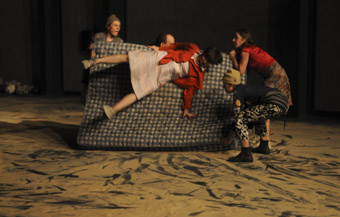
Nomads
photo Heidrun Löhr
Nomads
A WOMAN LIES ON A MATTRESS. WITHIN MOMENTS, THE TRIBE SHAKE HER OFF, AND A CAREFUL AND CONSENSUAL BATTLE BEGINS. THE MATTRESS IS PULLED AND PUSHED ACROSS THE STAGE, TREMBLING IN THE EVER-LOUDER MUSIC. PERFORMERS JUMP ON, SNEAKING A FEW MINUTES, BEFORE THEY ARE SHAKEN OFF BY OTHERS, NOT SO MUCH STEALING IT FOR THEMSELVES AS LIMITING ANYONE’S TIME. MEANWHILE, OTHER PERFORMERS TWIRL, BLANKET-RUGGED, LIKE MAD DERVISHES—MANAGING SCARCE RESOURCES AND ECSTATIC MYSTICISM. THIS IS NOMADS, A MEDITATION ON THE WANDERING LIFE.
Presented by Performance Space over three nights in November 2008, Nomads was the third stage of an intercontinental collaboration stemming from January 2006, when Hans van den Broeck, one of the founding members of Les Ballets C de la B, Belgian dance collective extraordinaire, ran a 10-day workshop as part of Critical Path. In May 2007, Broeck returned to Performance Space for another residency with members of his company SOIT (Stay Only If Necessary), this time aiming to harness the raw, chaotic energy of the intensive workshop to work towards a public performance.
Broeck’s interest in time-restrained creation developed from organising impromptu performances, interventions in public space bordering on flash mobs. “I have found it very attractive to have little time to think, to have to work intuitively”, he says. “The less time we had, the more it evoked the range of possibilities, the vastness of choice. It forced a flow of organic, direct thinking.”
For the project, SOIT intentionally brought together a diverse group of artists: from performance-makers like Nikki Heywood and Tony Osborne, dancers Rowan Marchingo, with a background in physical theatre, and Kathy Cogill. According to Heywood, while such artists would possibly never find themselves in a project together, it was the outsider figure that created permission, the freedom for this cross-disciplinary collaboration. The participants found Broeck’s methodology remarkable: visionary yet strongly collaborative, creating firm structures that facilitate creative autonomy within. It also challenges the common practice of prolonged retention of projects in development and research, often drawn out over several years.
Inspired by Australia, with its sense of displacement, its bewilderment at the exotic environment still strongly felt in European settler culture, Broeck, a psychologist by training, set out to explore human dynamics—fear and guilt—that play out in a newly established community. The result was two weeks of research, development, analysis and workshop, followed by a three-night performance season: Settlement. In a gesture of sociological mimesis, performers build the set together and inhabit it, create their own rules and start defying them from the onset. “We tried to alienate ourselves from normal communication; a rare outlet was that people occasionally screamed positive, warm thoughts to one another.” The set-up evokes a range of transitional spaces: refugee or detention camp, festival or a cult, with connotations of withdrawal, escape from society. It reveals the structures that bind us together: a group with no shared history needs to invent and enforce rituals, laws, punishment strategies, entertainment routine. The rulebook insists:
We must respect the loneliness of others.
We should try to wear pants inside out and back to front.
We can take a nap in someone else’s tent if the tent flap is open.
An outsider arrives at night, triggering the assimilation process. The collective morning ritual is a group crawl on the floor; aided with sparkly, summer-camp music, performers slide and roll, exchanging clothes until individuality is left behind. In the evening, after majestically amateur theatre, the women perform a gaudy disco for the hooting males. Eating alone at night is brutally punished: come morning, the transgressors are violently thrown and spun, their feet bound.
In the intense rehearsal environment, the dramatisation of goal negotiation, forced intimacy, isolation from the outside world feeds off the genuine group dynamics. Frances D’Ath, a dancer participating in a Settlement event in July 2008, noted: “Hans has talked about isolation and anxiousness within a group, and this is far more prevalent [than open conflict]. Despite doing many things together, there seems to be a calculated loneliness or distance between all of us: together but unreachable.” Yet keeping the dramatic aspect remains important. Projecting one’s own mental set-up onto a stage persona, taking behaviour to its extreme conclusion, is more important than provoking concrete experiences in performers. In performance, each individual artist retains a calm sense of performance identity. The line between being and performing, between the tensions in the camp and in the rehearsal, remains a nonchalant smudge.
Broeck and SOIT have since used the conceptual structure developed in Sydney to recreate Settlements around the world. At the National Gallery carpark in Harare, Zimbabwe, it became a consciously political, yet ecstatically communal gesture. In Bastia, Corsica, the tents were pitched on the beach, provoking hostility in a strongly territorial culture. The rulebook travelled; the rules changed. In Bastia, they added: “Whatever happens our community ought not to succumb to cynicism.”
The rules of Wellington, New Zealand, read like a madwoman’s resolution list:
From our ankles up we live in the sky.
From our souls down we touch the ground.
Nomads, developed and performed in Sydney in November 2008, is a continuation of this methodology and concept. After Settlement’s exploration of communitarian coercion, it wonders what happens to a group that deserts, leaving the collective trauma behind. It feels airy, light. Without the safety of demarcated territory, memory conservation itself is a struggle. Communal living has taught us to forgive, collaborate; Nomads remembers that we have inherited, from the millennia of hunting and gathering, the pursuit of ecstasy and the ability to forget. Resisting notable dramatic progression, Nomads is a trickle of enigmatic scenes, slowly building up cumulative intensity, anti-spectacular but riveting. A wandering confessor offers a fleeting release from tensions. Running into the wall, chasing a flickering projection invigorated by blaring music, the performers start commemorating their futile crashes with mementos. Like road shrines to car crash victims, like flowers for suicide bombers, so are the chairs, water bottles, the crushed flowers they leave by the wall little souvenirs to violence, martyrdom. Without commentary or narrative sign-posting, it is an immersive inquiry into human nature, ambiguous but never indecipherable.
Plans are now unfolding for the final instalment: Homeland. A group of wanderers finally reach their own home. But will they be at peace there?
Nomads, director Hans van den Broeck, performers, collaborators Kathy Cogill, Nikki Heywood, Rowan Marchingo, Tony Osborne, Lizzie Thomson, Vicki van Hout, Nalina Wait, Anuschka van Oppen, Joe Jurd, video design Sam James, sound James Brown, lighting design Sydney Bouhaniche, project convenors Nikki Heywood, Rowan Marchingo; residency showing, Performance Space, CarriageWorks, Sydney, Nov 27 – 29, 2008
RealTime issue #90 April-May 2009 pg. 21
© Jana Perkovic; for permission to reproduce apply to realtime@realtimearts.net
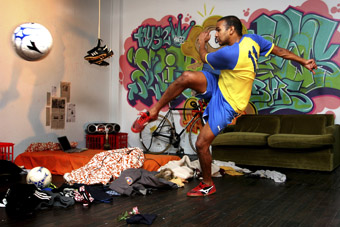
Ahilan Ratnamohan, 2008/9 mentoree, The Football Diaries
photo Wendy Kimpton
Ahilan Ratnamohan, 2008/9 mentoree, The Football Diaries
FOR AN EMERGING ARTIST, A SUCCESSFUL MENTORSHIP IS ONE THAT FORGES AN INNOVATIVE CREATIVE RELATIONSHIP. IT IS ABOUT COLLABORATION AND A GENUINELY DYNAMIC EXCHANGE THAT BUILDS CONFIDENCE AND POLLINATES CREATIVE IDEAS. FOR MANY YOUNG AND EMERGING ARTISTS IN AUSTRALIA, SIMPLY BEING NETWORKED TO OTHER ARTISTS CAN OVERCOME ISOLATION AND SPARK NEW CREATIVE DIRECTIONS.
Running 2003-08 with the last mentorships ending in 2009, Spark was the Australia Council for the Arts’ National Mentoring Program for young artists, supported by the Dance Board, Theatre Board and Community Partnerships division. A tender was put out in 2008 by the Australia Council for a new version of this program for the development of young and emerging artists (part of the $6.6m over four years, 2008-09 to 2010-11, announced last year, covering a wide range of areas). The winning tender is likely to be announced in April.
Managed by Youth Arts Queensland (YAQ), Spark aims to establish young artists within the arts industry through intensive professional development workshops, individual project development and relationship building between senior and emerging practitioners. The outcomes of Spark however are multi-faceted and for many participants the value of the program goes far beyond its aims.
As Spark is an initiative focused on personal and innovative partnerships, its participants must forge their own relationships with a potential mentor and unlike other shorter more intensive schemes such as Time_Place_Space, or Run_Way, Spark is structured over a 10-month period giving the mentoree an opportunity to expand and unpack their practice. Zane Trow, former Manager of Spark at YAQ says the program “allows artists room to stretch out their practice” and “empowers artists to take control of their own culture, whilst widening people’s choices and networks.”
In a recent evaluation of Spark, Joon-Yee Kwok, from QUT Creative Industries Faculty found that the participants placed the most value not on skills sharing, such as grant writing, but on the reassurance that the young artist’s process, both in practical and emotional terms is an important element of creative development. “When an artist feels anxiety over their practice it is often through the relationship with their mentor that they realise that this is normal.” Kwok says “the mentorship relationship can assist these artists find their process, and it is often through this personal interaction that they feel legitimised”.
Several examples can illustrate how unique a Spark experience can be depending on each participant’s approach and, ultimately, how they have utilised the program to embark on new directions through collaboration.
WA-born mentoree, Tanya Dupagne says being awarded an 08/09 Spark mentorship has validated her “sense of worth as a community arts worker.” New to the arts, Dupagne came from a community development background, working in the USA and Africa in camps for underprivileged kids. Taking on the responsibility of teaching kids jazz dance in Cape Town when her teacher became ill, she was able to develop her technique and experience life as an independent community arts worker.
Ever grateful to her past mentors, Dupagne acknowledges that they were ultimately one-way training relationships. “The difference with Spark is that it is self-directed” she comments. Her mentorship with Jenny Simpson, Director of Awesome Arts in WA has been much less directive and has essentially networked Dupagne into the community arts sector, positioning Spark as a program that assists artists who are self-motivated and entrepreneurial.
2006 Spark mentoree Keith Lim believes he would not have had the confidence to approach his mentor Kate Champion without the Spark program as a motivation. YAQ encouraged Lim to dream: “If you could work with anyone who would you want it to be?”
At the onset of the mentorship Lim and Champion established a rapport that was collaborative and equal, rather than directive. Champion would spend a full day per week workshopping ideas and engaging in critical feedback with Lim during his two-month residency period at Performance Space, where he was working on a solo physical theatre piece, Out of Body Experience. The exchange, Lim believes, gave him “strong affirmation” that he was on track.
As a hybrid artist, Lim says “meeting other Spark participants at the YAQ-run workshops, and the conversations and showcasing of work that happened on the side, were extremely valuable.” This can also be seen in the forming of new collaborations such as the one between 2006 participants Kieran Swann (QLD) and Daniel Koerner (VIC) who have since worked together on self-devised performance works.
For scriptwriter and 2003 Spark participant Julian Hobba, simply being part of the Spark community was valuable: “working solo can feel like I’m in no-man’s land most of the time and Spark felt like a real opportunity with a concrete definition”.
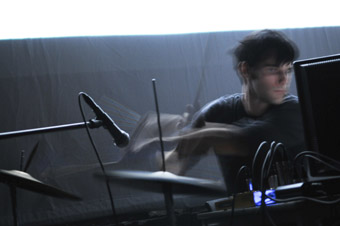
James Brown, Asisthesis, Tiny Stadiums Festival
photo Heidrun Löhr
James Brown, Asisthesis, Tiny Stadiums Festival
2007 mentoree Lara Thoms shares this opinion. She believes “the most valuable aspect of Spark was meeting other emerging artists from across Australia at the YAQ-run intensive development workshops.” This is aomething, she argues, “emerging artists rarely get a chance to do.”
Given the very nature of Thoms’ interdisciplinary practice she immediately took the opportunity to workshop ideas and concepts with artists from other disciplines and regions of Australia, and has since collaborated with artists Willoh S Weiland (VIC) and Ashley Dyer (NSW), weaving their knowledge and creative input into Quarterbred, PACT Theatre’s three-year-old artist run initiative supporting and presenting hybrid arts projects, a collective that Thoms co-directs. Weiland and Thoms also collaborated on the project Hard Party, a site-specific interdisciplinary event on a Sydney harbour cruise in January 2009, examining binge culture and extreme partying with several artist groups including Post, Brown Council, DAMP and 2005 Spark mentoree Teik Kim Pok (RT 89, p38). Dyer and Thoms also curated and produced the 2009 Tiny Stadiums Festival, a City of Sydney funded project incorporating performance art, live art and interactive installations throughout the streets of Erskinville in March.
Thoms believes she has learnt as much from the other ‘Sparkies’ as from her mentor. She sees Spark as encouraging equal creative exchange, but is quick to acknowledge the benefit of working with senior practitioners such as Caitlin Newton-Broad who, through years of experience, can offer insight into tried and tested methodologies when making new hybrid projects.
The creative possibilities of collaboration and cross-fertilisation were not lost on the other 2007 participants, and it was through their collective initiative that Spark Plug, a workshop and presentation event was conceived. Run by the mentorees themselves, the daily workshops and showcases, held at Performance Space in May 2008, were an informal and exciting way to engage with each other’s Spark projects and pollinate future collaborations. The forum nurtured complex debate and peer recognition, an unexpected but highly valuable professional and personal development outcome of the Spark Program.
Joon-Yee said participants throughout the six years of Spark were unanimous in their opinion that workshops run by mentorees for mentorees had been extremely valuable. For example a video artist would teach the group valuable editing and shooting skills giving artists an opportunity to step outside their own practice, even though interdisciplinary collaboration has not been a strategic aim of Spark.
It seems the value of exchange in Spark goes far beyond the mentor-mentoree relationship. Depending on the participant, contact with other emerging artists and mentors can mean an entirely new creative direction and the cementing of partnerships and collaborations across the country and across disciplines.
NSW-based musical composer Gareth Hudson forged a partnership with contemporary performance maker Ashley Dyer (NSW) during Spark 2007. The new work, currently in its second stage of development is part of a PACT Theatre Vacant Room project. It incorporates text, dance and image material, as well as music and sound through the use of loop stations and live sound looping software. For Hudson, this project offers an exciting opportunity to work within contemporary performance.
Spark enables these connections to take place. However, to address the gap in networking opportunities on a national level for emerging artists, perhaps workshops such as Spark Plug should form part of the future strategic directions. Perhaps this will be an outcome of the Australia Council’s tender for a new young and emerging initiative that targets organisations who are leading innovators, “that consistently stretch artform practice.” This may redefine Australian young and emerging initiatives as cross-disciplinary, national hubs that not only provide long term mentorships between emerging and senior artists but ultimately seed ideas that will inform the future of contemporary practice.
Spark 2008/09 participants are: artist Natalie Abbott VIC (mentor Ros Warby); James Brown NSW (Gail Priest); Sophie Chapman QLD (Judith McLean); Tanya Dupagne WA (Jenny Simpson), Janie Gibson NSW (Alicia Talbot); Mish Grigor NSW (Bruce Gladwin VIC); Luke Hickmott VIC (Carlee Mellow); Ben Hjorth VIC (Brian Lipson); Laura Levitus VIC (Bec Reid); Ahilan Ratnamohan NSW (Lee Wilson); Georgie Read NSW (Leisa Shelton VIC); www.yaq.org.au/
The Football Diaries will be presented by Urban Theatre Projects, April 22 – May 2, Hackett House, Bankstown
www.urbantheatre.com.au
RealTime issue #90 April-May 2009 pg. 22
© Nina Stromqvist; for permission to reproduce apply to realtime@realtimearts.net
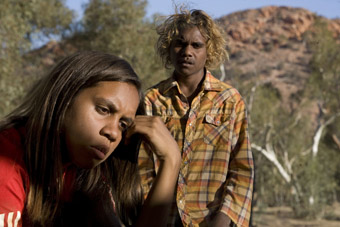
Marissa Gibson, Rowan McNamara, Samson & Delilah
photo Mark Rogers
Marissa Gibson, Rowan McNamara, Samson & Delilah
A BOY WAKES, SITS UP IN BED. THE MORNING SUNLIGHT HALOES AROUND HIM. “IT’S GONNA BE A BRIGHT, BRIGHT, SUNSHINEY DAY”, SINGS THE SOUNDTRACK. THE BOY SNIFFS PETROL. HE WANDERS OUT TO THE FRONT OF THE RUNDOWN HOUSE WHERE A TRIO PLAYS BAD REGGAE. HE SEIZES THE ELECTRIC GUITAR, THRASHES OUT RAW NOISE, AND HAS IT SNATCHED BACK. HE WANDERS OFF. A GIRL TENDS A FIRE OUTSIDE A MORE ORDERED HOUSE, WAKES HER NANA AND MAKES HER TAKE HER MEDICATION. AND SO THE DAILY RITUAL IS ESTABLISHED IN THIS SMALL CENTRAL AUSTRALIAN BUSH COMMUNITY. FURTHER DETAILS ARE QUIETLY ADDED—NANA’S DOT PAINTING, THE GIRL WHEELCHAIRING HER TO THE MOBILE HEALTH CLINIC AND ON TO THE CORRUGATED IRON CHURCH FOR PRAYER. FROM TIME TO TIME, THE LONE PUBLIC PHONE IN THE CENTRE OF THIS SMALL, DILAPIDATED COMMUNITY RINGS. NO-ONE ANSWERS IT.
This cycle of behaviour, of indolence and duty, is repeated, framed each time in similar ways, for example our point of view ‘walks’ us behind the boy or to his side, as if travelling with him. But in each iteration a new element is fed in. The boy (Rowan McNamara as Samson) listens to the radio, cutting out the local noise, tuning into the Green Bush program for those, like his father, in gaol. The girl (Marissa Gibson as Delilah) shuts herself in a car, immersing herself in the lush romantic music of the Mexican singer Anna Gabriel. Few words have been uttered. Few more will be said. This is a world of little change, its cyclical images etched into our consciousness, gradually assuming symbolic power—the same objects, the same movements, the same sounds. These gradually accrue great emotional weight—wheelchair, ringing phone, dot paintings, a song, a simple crucifix in a church—Thornton, his editor (Roland Gallois), location sound recorder (David Tranter) and sound designer (Liam Egan) subtly modulating the way we see or hear them. In a film of few words, the sound design and concomitant sound worlds associated with the characters become keys to our emotional relationship with them.
Things happen that interrupt the cycle. Samson sees Delilah outside the local store. He throws a stone at her, perhaps a first adolescent attempt at contact (later she’ll give him some food, and throw stones herself). He doesn’t speak. At night he sits in a wheelchair in the middle of the dusty road as a huge SUV drives towards him, but does he hear it? One day Samson follows Delilah and Nana (Mitjili Gibson) on their daily walk. One day Nana, giggling, encourages Delilah to pair off with Samson, “Go off…he’s the right skin for you.” One night Delilah, listening to Anna Gabriel in the car, watches Samson dance sinuously outside his house. She smiles a rare smile. Her music, his body. Thornton builds an incipient relationship out of watching and listening.
Samson moves into Delilah’s yard with his mattress. She throws it over the fence. He wanders off to a sandy gully, digs a hole which fills with water, sinks dreamily into it, finds himself suddenly face to face with a kangaroo, kills it and takes it back to Delilah. Very similar images—burying, a dead kangaroo—will powerfully recur in the film, as will haircutting in a poignant variation of the Bible story of Samson and Delilah, delivered in some of Thornton’s most intense close-up shooting and Tranter’s sound recording. In the meantime, one morning Samson viciously assaults the guitarist. One morning Gran dies. Delilah is falsely accused by relatives and neighbours of not looking after her. She shears away her hair. The daily ritual is over. Samson and Delilah are soon outcasts.
The sense of daily ritual in the first part of the film, of a depleted but oddly stable everyday life, portrayed in recurrent visual and aural images and small variations, is immersive, and an inventive lateral approach to narrative. Thornton builds a world rather than simply telling a story. Then he shatters that world with sad and brutal disruptions.
I won’t detail more of the story, save that from here, in the film’s second movement, Thornton takes Samson and Delilah to Alice Springs, to its art shops, cafes and supermarkets, its middle class school kids with mobile phones, a meaningless church and a riverbed refuge beneath a bridge shared with a relatively loquacious eccentric, Gonzo (Scott Thornton) who goads Samson into his few stuttered words in the film. The extreme fall of the young pair into a numb hell is deeply painful to witness, Delilah unanchored without her Gran, Samson sinking further into his addiction. What follows is a shocking series of events, Thornton making it all the more so by enveloping us within Samson’s aural oblivion. But what follows that is truly unexpected.
There is a moment when the film appears to complete itself, when it looks like survival is an option for the pair, but Thornton pushes beyond mere gesture to a third movement, a new reality for Samson and Delilah, one replete with images from the first—cross, kangaroo, wheelchair, music, dot painting, hair. This suggests a conclusion that is above all symbolic. It says there are ways out of an appalling condition, that recovery and love are possible, but the filmmaker doesn’t offer a social or political solution. However, and this is to Thornton’s great credit, we feel that this essentially symbolic ending to the film is nonetheless very real. This is because we know these reticent characters so well and are tied to them by the sounds and images that have constellated, web-like, around them, because he has wrought the performances we don’t question from untrained actors, because he has conjured a coherent imaginary world rooted in brutal realities.
Thornton himself is emphatic that Samson and Delilah is, above all, a love story. It’s potentially tragic but, as he has asked, how can that kind of telling be responsible. Rather than despair he intimates hope through individual action and mutual caring. Save for when the pair are at their lowest ebb, we believe in the love between Samson and Delilah simply from the ways they look at each other, their wordless togetherness, from first encounter to tentative courtship and shared escape. But it’s not love alone that creates a new reality for the pair: the terms are Delilah’s, born of her caring for her Nana, a knowledge of the world beyond petrol-sniffing and with the eye and hand of an artist.
Samson and Delilah won the Adelaide Film Festival Audience Award (see editorial), no mean feat in an era of alleged audience wariness of grim Australian feature films. Perhaps it’s the way the film’s narrative resolves, but there is enormous pain on the way. Perhaps it’s because of the scale of Thornton’s vision. It’s interesting to compare Samson and Delilah with another fine film about young people, Ivan Sen’s award-winning Beneath Clouds (2002), a story of incipient love and understanding amidst cultural complexities. But Thornton pushes even further than Sen into the psyches of his characters and evokes, from two small lives, a much larger cultural picture. He achieves this through the carefully structured deployment of symbolism rooted in the everyday of the film’s world. But there’s also beauty, and it’s one of the most painful things about the film, that a great cinematographer turned director can rightly torment us with the tension between what appears beautiful—the morning sun haloing a handsome young boy—and the abject reality of a meaningless life.
It’s a reminder too of the existential core of Samson and Delilah—the boy has no family to turn to, the girl none who want her. The sense of community is thin, tradition limited to Gran’s exploited paintings. No one answers the insistent phone that calls for help and connection. Not until Delilah picks it up. Warwick Thornton’s Samson and Delilah is rooted in the culture in which the filmmaker grew up; the film’s power resides in its specificity of place and its realistic depiction of the condition of Aboriginal people. Thornton’s protagonists are a new generation of lost ones, lost by their own people as well as white culture, making their struggle and the final image of their possible survival doubly poignant. With its harshly beautiful images of hope, Warwick Thornton’s Samson & Delilah is destined to become an Australian film classic.
–
Samson and Delilah, writer, director, director of photography Warwick Thornton, cast Rowan McNamara, Marissa Gibson, Scott Thornton, Mitjili Gibson, producer Kath Shelper, assistant producer, casting Peter Bartlett, editor Roland Gallois, production design Daran Fulham, costume Heather Wallace, make-up Carol Cameron, sound recordist David Tranter, sound design Liam Egan; Scarlett Pictures & CAAMA Productions, distributor Footprint Films with with Transmission Films and Paramount
RealTime issue #90 April-May 2009 pg. 23
© Keith Gallasch; for permission to reproduce apply to realtime@realtimearts.net
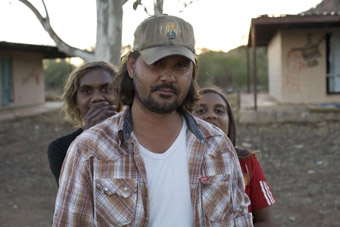
l-r Rowan McNamara, Warwick Thornton, Marissa Gibson
photo Mark Rogers
l-r Rowan McNamara, Warwick Thornton, Marissa Gibson
STARTING OUT AS A CAMERMAN FOR CAAMA (CENTRAL AUSTRALIAN ABORIGINAL MEDIA ASSOCIATION) IN 1990, WARWICK THORNTON WENT ON TO GRADUATE IN CINEMATOGRAPHY FROM AFTRS IN 1997 AND THAT YEAR SHOT HIS FIRST FEATURE FILM, RACHEL PERKINS’ RADIANCE. MORE FILMS FOLLOWED FOR FELLOW INDIGENOUS DIRECTORS AND HE DIRECTED A NUMBER OF DOCUMENTARIES INCLUDING ROSALIE’S JOURNEY, ABOUT ROSALIE GNARLA KUNOTH, WHO PLAYED THE TITLE ROLE IN CHARLES CHAUVEL’S 1955 FEATURE FILM JEDDA. HIS FIRST VENTURE AS WRITER-DIRECTOR, AND CINEMATOGRAPHER, OF SHORT DRAMA WAS PAYBACK IN 1996. THORNTON’S RECENT SHORT DRAMAS GREEN BUSH (2005) AND NANA (2007) HAVE BEEN ACCLAIMED LOCALLY AND AT INTERNATIONAL FILM FESTIVALS. GREEN BUSH WON BEST SHORT FILM IN THE PANORAMA SECTION OF THE 2005 BERLIN INTERNATIONAL FILM FESTIVAL AND NANA WAS AWARDED A CRYSTAL BEAR BY THE JUNIOR JURY OF THE 2008 BERLIN FESTIVAL.
Warwick Thornton’s Samson & Delilah is an impressive feature film debut (see review), evidence of a filmmaker on top of his craft. I interviewed the amiable Thornton shortly after the film premiered at the 2009 Adelaide Film Festival and won the Audience Award for Best Film. His love for his film and for his principal characters was palpable, as was the certainty of his vision and the care entailed in his craft.
KG I really enjoyed the film. It’s a wonderful account of love and the way it can evolve really quite slowly and incidentally, right from the first stone Samson (Rowan McNamara) throws at Delilah (Marissa Gibson) that hits her in the back. You think what is this, does he hate her or is this courtship?
WT That’s a bit of my life as well. I just didn’t have the gift of the gab so if you liked a girl, you threw rocks at her to get her attention ‘cause you couldn’t walk up and say, “Hi, I’m Warwick, I think your eyes are this or your ears are that.”
KG It’s a shocking moment, well into the film, when Gonzo (Scott Thornton), the itinerant, provokes Samson to actually speak.
WT And it’s just a stutter. Maybe Samson has a disability that he tries to hide.
KG Perhaps it’s because he hasn’t spoken for so long.
WT It’s like Gonzo speaking for the audience, saying to both the kids, “For fuck’s sake say something!”
KG She’s pretty well lost the capacity to talk because of all she’s been through. She’s not a great talker anyway, she watches, especially that great moment she watches Samson dancing in the night.
WT She’s always watching the world. Her ideas are represented in the Mexican music (Anna Gabriel), more a fairy tale version of love she’s yearning for. But all she’s got is this mad boy. Nobody’s sure of what he is, but when she looks at him and has that music in her head, there’s this connection.
KG I think the sound is fabulous (David Tranter, location sound; Liam Egan, sound design) and the way you’ve used the music. At times we only hear what Samson’s hearing when the rest of the world is going to pieces. It’s a sound-conscious film in the best possible way.
WT All the music was chosen before we started shooting the film. There’s no dialogue, so I had to be incredibly careful because the lyrics of those songs became almost like dialogue, like the opening song by Charlie Pride (“I Can See Clearly”)—“It’s gonna be a bright, bright sunshiny day”…as if everything’s gonna be okay, but there’s Samson and he’s sniffing petrol and everything is contradictory. But that piece of music gives a sense of place and style to the film. What I wanted from the audience when they watch that opening sequence is “I don’t think we’re in Kansas anymore! This is gonna be something quite different, this film, and it’s gonna be dark but it’s gonna have contradictory humour.”
KG Obviously you spent a long time conceiving the film and seeing it in your head. Did you storyboard it extensively or script it?
WT I actually don’t like writing, the physical side of it. I don’t type. I write with a pencil and a pad. And it’s quite painful for me to do that ‘cause I can’t spell very well. I left school in Year 6 and I didn’t learn that stuff very well. So what I do with films is I think about them for bloody years until I’ve got beginning, middle and end, all the characters, their journeys—you know, not incredibly succinct but just the real scene one, scene two, kind of thing, this happens, that happens. So I’ll think all of that in my head and then I’ll sit down for three or four days and actually write the whole thing. Twenty pages a day. Twenty pages of my handwriting translate into about twelve or thirteen typed pages. And this script I think was about 60 pages long. So that whole idea of a page a minute never works with me.
KG So you transcribe what’s going on in your head onto the page.
WT Yeah. And re-drafting is just adding. It’s never taking away and re-building the whole thing. I’ve got the nuts and bolts, the total structure down, so it’s just adding nuances or scenes that play out later or are revisited later, and starting to get a bit more weaving happening.
KG So there’s a very strong framework when you’re on location?
WT This film is pretty well to script. I added one scene that wasn’t written and there’s nothing deleted. I had to be incredibly strong about each scene. Because there’s mostly no dialogue, those little looks and movements or whether they’re going right to left or left to right, all that sort of stuff had to be absolutely down pat. The scenes can’t hide in dialogue. They have to work and they have to pay off for the next scene to happen. So I had to be really careful about the written word and it being translated to the screen.
KG Were you shooting in sequence? The characters go through some devastating physical changes.
WT Absolutely. We pretty well shot everything in sequence because of Samson and Delilah’s downward journey. As well as we designed Rowan’s clothes to get baggier so it looked like he was getting skinnier, so they appeared to drip off him at the end. All of that stuff was quite complicated, so to shoot in sequence was quite important, and for Rowan and Marissa because it was the first time they’d acted. The journey needed to be in sequence for them as well so they knew where they were. Maybe five films down the track they’ll be able to start at the end of the film, go and do the middle and then the beginning—but not for those two this time.
KG What about yourself with the camera? Did you feel at all schizoid?
WT It was fantastic. I filmed and operated and the whole thing is hand-held as well. I decided to shoot it myself because the cinematography in it’s not really demanding. It was quite natural. Everything is lit but we’ve lit it to make it look like it’s not lit. And if I’ve got the camera right there and Rowan and Marissa are right there, well we’ve got a connection rather than: there’s a cameraman, and a dolly and three grips and some gaffers. And then there’s this BNC cable around the corner and out on the street where there’s the split and I’m out there and I’m yelling things at them and running in and out and all that sort of stuff. You know, I had to completely get rid of that. And because there was no dialogue and I had a lot of soundscape ideas while we were shooting, I could actually just talk to the actors while I’m rolling: “Speed it up a bit.” “Pick it up with your left hand.” “Get a bit angrier.” To be there with the camera and talk to them, one-to-one, was priceless.
KG What was the editing process like?
WT I’m a real believer in letting an editor spend a couple of weeks or even a month or two finding the film for themselves. I like that idea that they’ve read the script, they’ve watched all the rushes, they’re editors and they’re incredibly good at structure. None of the structure in the film actually has changed but for them to go and create a rough cut and to learn and to own the film I don’t even rock up for the first month in the edit suite. Then you come in with your idea of your baby but you feel these new fresh ideas that the editor has created as well. Roland Gallois cut it and he’s cut all my films. And we have that amazing trust because he’s such a beautiful editor. There’s 60% where I say, ‘Roland, that’s terrible; you don’t know what you’re doing’, but there’s 40% where he’s completely changed stuff and you go, ‘Wow, I’ve never seen that, never thought of that scene in that way.’ He’s created this absolute magic, stuff you didn’t realise was there, because you are so close to the film. And that’s the stuff you keep. And then the other stuff you don’t think is working you just build to the way you think it should be.
KG The sense of place was very strong in the film, of a community seen from the characters’ points of view—Samson when he’s walking or Delilah looking out over the fence or through the car window.
WT It was really important with this film to not use the classic Hollywood cutting away to a different character or story or playing too much with that kind of time. Everything that happens in the film we feel at exactly the same time as the characters see it. You’re on the journey with them. If you cut to another scene and a car’s coming or something else is happening, the audience has become disconnected and they’re on some other journey. With this film it was really important to stick with the characters and nothing was pre-empted. It’s important for the audience not to know what the hell is coming up; it’s an uncomfortable place and that’s what we wanted.
KG I like the sense of ritual, the cycle of days, the recurrent images and the way they change, like the tin-shed church Nana visits and then the church in Alice Springs, and the cross at the end of the film. I like the way the priest in the city just stands there, watching Delilah, thinking, “Have I got trouble here or what?”
WT It was interesting, that priest. I’d written this really bad piece of dialogue, you know, “Get out, get out!” It was horrific. I’d always hated it through all the drafts. I thought, alright, I’m gonna change it, and I never got around to doing it. In the afternoon we were doing the scene and I thought oh God, what am I gonna do? I’m gonna have to re-write this now while everyone’s having lunch. I thought, “Of course, I know what to do, we’ll just get rid of all the dialogue. He doesn’t say anything.” Because of that, some people see the priest as this sort of incredibly concerned person who doesn’t know what to say and some people see, another bloody useless priest who’s not gonna help. And that’s fantastic.
KG Samson and Delilah go through hell, but you give them another chance.
WT I’m one of the biggest romantics in the world and, from day one, these two kids had to live. That was the most important thing. It would have been quite easy for them to die and that’s just wrong, that is so wrong. I couldn’t live with myself as a writer. I need them to live for me as a human being, to feel stronger.
KG And it’s such a lateral solution you offer, because neither of these kids has a community, do they? They’ve been tossed out. It’s pretty tough and you make it tougher.
WT They have to really cleanse themselves.
KG They’re not rescued by priests or social workers .
WT No. There’s lots of good priests and good social workers. There are things in place. But it’s just these kids’ journey. They’ve actually made those choices. No-one’s forced them. They could’ve actually lived in the community if they wanted to. It would have been a lot harder ‘cause they’ve nicked the car and everyone’s really pissed off with them. They could have lived there but they’ve decided.
KG There’s a beautiful stillness in Marissa Gibson’s performance, whereas Rowan MacNamara is a lot more literally expressive which makes for a nice combination.
WT And she grows. That was all written, not her stoicism but her ingrained stability and strength because of her looking after her Nana and having these really important things in her life. Samson has nothing. It’s Delilah’s struggle, she really wants to make it work when he’s still not making it work. You’ve got to go to the really darkest place before you realise how beautiful the light shining is. And that’s the end of the film. She’s so incredibly strong and she’s 14 years of age and she’s living the life of someone who should be like 35 and all knowing about the world, or 65.
–
Samson & Delilah, writer, director, director of photography Warwick Thornton, cast Rowan McNamara, Marissa Gibson, Scott Thornton, Mitjili Gibson, producer Kath Shelper, assistant producer, casting Peter Bartlett, editor Roland Gallois, production design Daran Fulham, costumer Heather Wallace, make-up Carol Cameron, sound recordist David Tranter, sound design Liam Egan; Scarlett Pictures & CAAMA Productions, distributor Footprint Films with with Transmission Films and Paramount
Samson & Delilah is screening May 7 for Message Sticks Festival, Sydney and released in cinemas nationally on the same day.
RealTime issue #90 April-May 2009 pg. 24
© Keith Gallasch; for permission to reproduce apply to realtime@realtimearts.net
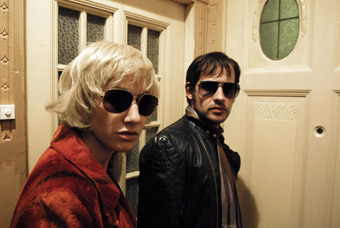
The Baader Meinhof Complex
THE BAADER MEINHOF COMPLEX IS THE LATEST—AND PERHAPS DEFINITIVE—GERMAN FILM EXPLORING THAT COUNTRY’S EXPERIENCE OF DOMESTIC TERRORISM FROM 1967 THROUGH TO THE LATE 70S AND BEYOND: THE RED ARMY FACTION (THE ‘OFFICIAL’ UNDERGROUND ORGANISATION WHICH AROSE OUT OF THE ‘BAADER MEINHOF GANG’) FORMALLY DISBANDED IN 1999; THE LAST KILLING ATTRIBUTED TO THE RAF WAS IN 1991.
active recall
From this distance (in both time and geography) it’s perhaps difficult to recall or imagine the extent of the turmoil that swept across western Europe in the late 60s, as a generation of students, unionised workers and intellectual activists from the Left loudly took to the streets – and took up paving stones if not arms—to protest against US imperialism (not just the war in Vietnam, but the Cold War itself) and the continuing hold of the ‘old’ political elites on formal power and culture in countries finally emerging from the ruination and austerity of the immediate post war years.
For most of us in the ‘Anglosphere’, our understanding of the cultural impact of those events is largely French inflected, seen through the lens of the Nouvelle Vague, and inculcated in the academy through the philosophical pyrotechnics of Deleuze, Guattari, Derrida and their ilk. The streets of Paris in May 68 exist in our ‘imaginary’ as a carnival of youthful and Utopian abandon, and the political legacy of that period includes a generation of the French political elite, only now passing from the scene (Sarkozy is the first president since that time who had no role in ‘les événements’ of 1968.)
In (the then West) Germany, as it did in Italy, the carnivalesque quickly turned bitter and violent. The stakes were higher, and both the State and elements of the extra-parliamentary opposition played harder, with a conservative press urging an ever-tougher government response. The students and academics protesting against American involvement in the war in Vietnam were also railing against the presence of hundreds of thousands of US troops in their own country, in a state of perpetual readiness for war with the bordering Soviet Empire. The political class was dominated by a generation who had grown up under the Nazis—many had actually held positions of power in the Nazi bureaucracy. The perception of the moral corruption and illegitimacy of the State was compounded by the fact that the Federal government was in fact a ‘grand coalition’ of left-liberal Social Democrats and conservative Christian Democrats, forcing political opposition from the Left out of the parliament into more informal—and extreme—forms of protest. Meanwhile the West German economy was powering along—creating a sense of frustrated entitlement among a rising generation who wanted more access to both political and cultural power.
The Baader Meinhof Complex follows the trajectory of the core members of the most notorious of the oppositional groups that emerged out the chaos of that time, tracking the three principals—Andreas Baader, Gudrun Ensslin and Ulrike Meinhof from their earliest forays into protest in 1967, through their descent into ‘underground’ violence, their arrest, imprisonment and trial, and finally, the suicide in October 1977 of Ensslin, Baader and a colleague. Meinhof had committed suicide in prison 18 months earlier.
art and baader meinhof
The film directed by Uli Edel (Last Exit To Brooklyn, Body of Evidence) written and produced by Bernd Eichinger (who also wrote the script for Downfall) is the latest attempt by German filmmakers to account for the transformation of middle class liberal protestors into violent underground terrorists. The protest movement, the fatal violence of the underground, the savagery of the State response and the horror of the prison suicides combined to create a deep cultural wound, and a generation of filmmakers and writers have worried at it, from well before the dust settled. The extraordinary group devised and directed documentary drama Deutschland im Herbst/Germany in Autumn (with Rainer Werner Fassbinder and Volker Schlöndorff among its 13 participating filmmakers!) came out in 1978 incorporating footage from the funeral of Baader et al into its final scene; The Lost Honour of Katherina Blum, directed by Margarethe von Trotta and Volker Schlöndorff from the novel by Heinrich Böll was released in 1975, when the events it sought to address were still very much in progress.
The central concerns of these artists have been the questions that constellate around the transformation of middleclass liberalism into underground violence—and the countervailing transformation of the liberal democratic state into a police state. Is violence inevitable? Is it the only way to truly transform society? Or is it always doomed to failure—not least because it destroys the souls of those who take up arms? What should be the proper response of a democratic state to the violence of its citizens? And what is the proper response of the artist? What are the limits of representation? Do I take up the camera (or the pen) or do I take up the gun?
From an Australian perspective such questions can seem both futile and abstract, but the body count was real enough—more than 30 dead, and hundreds wounded through RAF related violence—and still more if one takes into account the events surrounding the Munich Olympics in 1972. The questions Fassbinder, Böll, Schlöndorff, von Trotta et al asked themselves were at the time very real; they seem hardly less so now as the world contemplates escalating levels of terrorism.
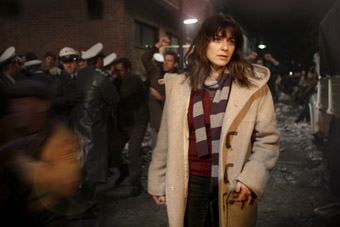
The Baader Meinhof Complex
At first glance, Edel and Eichinger’s film seems to address these questions by simply recounting in as objective a manner as possible the key events of the historical narrative, with minimal psychologising of the motivations of the protagonists: we are given the opportunity to witness the actions of both State actors and the terrorists, to see their effects, and track their catastrophic consequences. The apparent objectivity allows us to see good and bad on all sides, and we watch in horror as good (or at least recognisably ordinary) people are caught up in events which lead toward their doom. As often as not death and destruction are the product of accident as of intent.
The filmmakers essentially follow the narrative of events laid out in Stefan Aust’s 1997 book of the same name. Aust is a former editor of the German news weekly Der Spiegel, and knew many of the protagonists from his own student days. His book is a forensic account not just of the story of the key members of the Baader Meinhof ‘gang’, but also an engrossing and fine grained detailing of the activities of numerous splinter groups and the background to people caught up in events as they unfolded over a decade. This is the ‘complex’ to which the film’s title refers, and in cleaving closely to this detailed and multilayered narrative, the resulting film is sprawling, episodic and very long (at 150 minutes).
the power of mythos
Students of German history and culture—and anyone with an interest in the nature of terrorism—will find the experience of watching the film exhausting but fascinating. However, the real power of the film, and the insight it offers, is in its understanding of the Baader Meinhof complex as a mythos, and its episodic structure to an extent disguises an elegant formal structure in which the mythic or archetypal character of the work is fully revealed. And it is in recognising the mythic qualities of the Baader Meinhof story that we understand its enduring impact on the German national story (and the ever present attraction of passionate idealists to violent direct action).
The early clue to the intention of the filmmakers to render the story as myth as much as history, is evident in the way the three main characters are introduced. We meet Ulrike Meinhof (Martina Gedeck) as a celebrated liberal journalist with the radical monthly konkret, and a fixture (the radical voice and token woman) on TV chat shows in which the subject of youthful rebellion, the war in Vietnam and other hot topics of the day are debated; her frustration with her limited ability as a journalist to influence events is clearly visible, as is her almost erotic fascination with those who are prepared to take direct action. Similarly, we meet the angry young Gudrun Ensslin (Johanna Wokalek), bawling baby in her arms, cigarette hanging from her lips in her family’s modest apartment, arguing about the evil of the war in Vietnam with her father, a liberal but austere Lutheran pastor. She is possessed by a holy fire and impatient with the compromises and complexities of ‘bürgerlich’ civility.
By contrast, Andreas Baader (Moritz Bleibtreu) simply appears, a force of nature with neither history nor narrative. Whereas Aust’s book gives us an extensive account of Baader’s background as a working class juvenile delinquent with a chip on his shoulder and a preening self regard, the film posits him as a kind of demiurge, at once erotic and violent, whose arrival at political activism is both accidental and opportunistic. He and Ensslin become lovers, and it she who both contains (barely) his most violent impulses, and serves to interpret his native rage as revolutionary fire. Literally—his first act in the film is to set fire to a department store.
Meeting Ensslin and Baader in the course of reporting on the trial of the department store fire-bombers, Meinhof is drawn step by step into taking direct action, literally jumping through the window (after Baader, whom she has helped escape from his imprisonment for the fire-bombing), out of her middle class comfort into life on the run—an Alice-down-the-rabbit-hole moment.
Most of the key figures constellating around Baader (a decidedly un-intellectual leader) are women, and women enact the violence he wills as readily as the men. The film reveals revolutionary terrorism as a kind of Dionysian revel, in which a laughing god drunk on wine and dope urges his ‘cunts’ to ever more destructive acts of violence against those outside his charmed circle. Once they plunge into the underworld, the ‘Baader Meinhof Gang’ are consumed more by ‘wilding’ than by obviously political action: racing through the streets in stolen BMW’s and Porsches, robbing banks and rolling in the cash, setting bombs and blowing things up.
The defining relationship of the film—and of the historical ‘gang’—is the archetypal triad of Baader, Ensslin and Meinhof, in which forces of eros (Ensslin) and logos (Meinhof) revolve around the dangerous centre of mad Dionysus. Meinhof never fully surrenders her grasp on logos—until in the end she seeks to rationally account for her choices and to locate them within an historical and institutional framework—but the erotically charged force of Baader and Ensslin overwhelm and breakdown Meinhof’s fragile grip on rationality.
the descent
This descent into something like madness is amplified by the formal shape of the film. It begins with the movement of the protagonists from the domestic into the public realm—television, street demonstrations, public meetings. Taking direct action, becoming criminals, they are forced underground, and the film becomes pre-occupied with night time journeys between apartments with blinds drawn, and the protagonists move around in public in disguise. After their capture, the space occupied by the film is further reduced—now they are confined to a series of prison cells, a court room (the proceedings reduced to farce by the inability of the court to contain the wildness of Baader and company), meetings with lawyers. Meinhof is held in solitary confinement, and driven to despair, and finally, suicide. As the final act of the film unspools, Baader Ensslin and their comrades are reduced to speaking to each other over an improvised intercom system, sealed up in cells that have been soundproofed by the addition of padded wooden panels. They listen on a smuggled radio to reports of the final desperate attempts of their companions ‘outside’ to secure their release—namely, the hijacking of a Lufthansa airliner. The move fails—German commandos kill the hijackers while the plane is on the ground in Mogadishu—and it is this failure that apparently precipitates the penultimate act of the film, the suicide of Baader Ensslin and their fellow prisoner Carl Raspe. (The final act is the killing, by ‘third generation’ members of the RAF, of the industrialist Hans Martin Schleyer, kidnapped weeks earlier in an attempt to force the release of Baader & co—again, unsuccessfully.)
good moves and bad
There are dud moments and frustrating elisions, of which two are worth noting. The films credits roll to the sound of Dylan singing “Blowin’ in the Wind” which strikes a tone at total odds with the sentiment of the film, suggesting the final scenes of suicide and murder are ameliorated by recourse to comforting images of doves nesting in the sand. The use of music throughout the film borders on the banal, despite the references being entirely accurate historically—from Janis Joplin singing “Oh lord, won’t you buy me a Mercedes Benz…” over the opening titles, to fragments of “My Generation” and “Wild Thing” which float through the soundtrack.
And Baader, Ensslin and Meinhof all had children whom they ‘gave up’ to pursue their careers underground. This was particularly wrenching for Meinhof who agonised about her decision to abandon her two daughters, and wrote heartbreaking letters to them from her prison cells. These girls make two brief, silent appearances, and we see Ensslin with her baby in the opening moments of the film, but the reality of the children in the emotional lives of the characters is never really acknowledged, and their credibility is reduced as a consequence.
These gaps (and a few others) aside, The Baader Meinhof Complex is an important and powerful film. It tells its potted history of protest and terrorism and the forces arrayed against the would be revolutionaries with great force (and the incidents picked out above are but some moments of many), but its real force derives from the relentless intensification of the experience of its protagonists as the world they inhabit becomes more and more restricted. And its key insight is in revealing the descent into violence as less to do with strategic action and more to do with the surrender to the erotic charge of violence itself.
The Baader Meinhof Complex, director Uli Edel, writer, producer Bernd Eichinger, based on the book by and in consultation with Stefan Aust, co-writer Uli Edel, director of photography Rainer Klausmann editor Alexander Berner, production designer Bernd Lepel; Audi Festival of German Film 2009, April 15-28; www.goethe.de; and cinema release May 7
For more information on the Baader Meinhof gang, visit http://www.baader-meinhof.com
RealTime issue #90 April-May 2009 pg. 25
© Tony MacGregor; for permission to reproduce apply to realtime@realtimearts.net
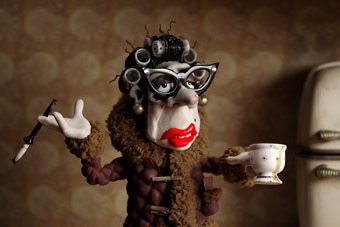
Mary and Max
WHEN ADAM ELLIOT’S SHORT FILMS HIT THE AUSTRALIAN FESTIVAL CIRCUIT IN THE 90S THEY WERE LIKE A SOAKING OF SUMMER RAIN, FRESH AND SWEET. HIS WRY HUMOUR, THE EXPLORATION OF AN ODD ASSORTMENT OF FAMILY MEMBERS WITH THEIR SUITCASES FULL OF QUIRKS—IN THE TRILOGY UNCLE, COUSIN AND BROTHER—AND THE MEMORABLE DEADPAN VOICEOVERS BY THE LIKES OF WILLIAM MCINNES USED TO SING IN YOUR HEAD AS YOU WALKED OUT OF THE CINEMA. AND IT SEEMS THAT HIS SINGULAR TAKE ON AUSTRALIAN SUBURBAN LIFE TRANSLATED INTO A LANGUAGE UNDERSTOOD ACROSS THE GLOBE, HIS FILMS WINNING THE TOP CRITICAL AND AUDIENCE AWARDS AT MOST KEY ANIMATION FESTIVALS—AND THAT WAS BEFORE THE BIG ONE. HIS LONGER SHORT HARVIE KRUMPET WENT ON TO WIN THE 2003 OSCAR FOR BEST ANIMATED SHORT FILM AND IT WAS A HIGHLIGHT OF MY VIEWING CAREER SEEING THE MEEK AND MILD ELLIOT AND PRODUCER MELANIE COOMBS WALK DOWN THE RED CARPET TO ACCEPT THAT AWARD WITH GEOFFREY RUSH SMILING ON.
It’s wonderful to see that moving onto a feature hasn’t lessened the impact or creativity of Elliot’s unique vision. Shooting in Melbourne over 57 weeks, he has extended the boundaries from the Ned Kelly letterboxes of suburban Melbourne to the sky-sculpted landscapes of New York—where the Twin Towers loom crookedly in the background. What unites all of Elliot’s films is his exploration of difference and diversity, his passion for the disenfranchised. I smile to imagine him pitching Mary and Max to Hollywood execs in the post-Academy Award hysteria: “It’s an animation with a subdued colour palette, set in the 70s, about a pen pal friendship between a young girl with a birthmark on her face who has no friends and a loner who has Asperger’s Syndrome and can’t relate to anyone.” Like Elissa Down’s impressive Black Balloon (which took out a host of AFI Awards last year), Elliot has gone back in time to his childhood memories of the 70s (shrinkies; icebreaker swims that make ‘erect nipples’; desert boots) to explore the lives of people coping day-to-day with disabilities/mental illnesses like depression, vision impairment, Asperger’s, stuttering, agoraphobia and just plain awkwardness. Apparently Elliot did have a pen friend in the States for 20 years with Asperger’s and this was the starting point for the script.
What’s incredible about the film is the level of detail, both in the amount of information voiced in narration but also in what’s being designed and animated on screen; there are sight gags so quick you blink and miss ‘em. The narration is rich, every second full of a tonne of ideas and Elliot’s usual offbeat humour. This filmmaker has the ability to pull off tragi-comedy in a way no other can, where you choke on laughter and sobs at the same time: In his letter writing Max veers from “My mother shot herself” to “Do you like chocolate hotdogs?” in the next sentence. By using a combination of an always-present narrator (Barry Humphries) who can comment on all the goings-on, plus the voices of the individual characters (Bethany Whitmore as the younger and Toni Colette as the older Mary and the sublimely sympathetic Philip Seymour Hoffman as the gravelly Max)—and the narrative device of letter writing as an exchange—we get to see the characters in 3D. The animation style features subtle hues of sepia in the Melbourne scenes and whites/greys/blacks in New York, with the occasional shock of colour from the red of a tongue inside an open mouth. It’s exquisite to look at. A wonderfully disturbing hallucinogenic scene revolves around the adult Mary, having taken a bottle of valium, suspended on a chair in that moment of despair before suicide, the song “Que Sera Sera” swirling around her like a noose.
What unites eight-year-old Mary and 44-year-old Max, and most of Elliot’s characters, is their sense of loneliness, their difficulties in adjusting to an external world full of confusing people and their need to create a safer and special universe just for themselves (much like their director playing with clay, I imagine). They both share a love of the TV show The Noblets, because everyone in this land has “oodles of friends.” Mary sits in her suburban home watching her mother Vera ‘test’ the cooking sherry. Her favourite colour is brown and she wonders whether babies really come from the bottom of a beer bottle. She lives next door to Len who is “scared of outside and has a disease called homophobia.” Max sits in his grey apartment eating chocolate hotdogs and trying to keep his life “symmetrical” to avoid being institutionalised. Every Thursday he attends Overeaters Anonymous. He wishes there was a maths equation for love: he once gave his girlfriend a feline rectal thermometer for Valentine’s Day because she adored her cat. His imaginary friend Mr Ravioli sits in a corner reading self-help books with titles like How to Win Friends and Toxic Relationships, and in the end even he hops out the window and abandons Max.
Mary and Max is so full of imagery and words that sometimes it needs more pauses to give it space to breathe (the timing was note-perfect in his shorter films). It’s like Elliot wants to make the most of every moment and, as a viewer, I wanted a few more gaps in the pace to ponder; sometimes just to show rather than tell is enough. But there is so much great material here that he could have used two thirds and it still would have been a wonderfully hearty mix. Love, death, politics, religion. This film tackles all the big themes, along with the smaller, more important ones, like whether you should ever eat anything as big as your own head.
Mary and Max, director, writer, designer Adam Elliot, producer Melanie Coombs, voices Toni Collette, Philip Seymour Hoffman, Barry Humphries, Eric Bana, Bethany Whitmore, director of photography Gerald Thompson, editor Bill Murphy, Melodrama Pictures, 2009
RealTime issue #90 April-May 2009 pg. 26
© Kirsten Krauth; for permission to reproduce apply to realtime@realtimearts.net
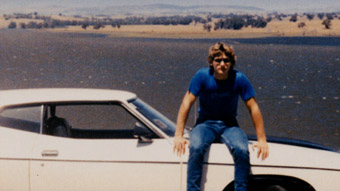
Eric Bana, Love the Beast
ERIC BANA GREW UP IN THE INDUSTRIALISED NORTHWESTERN SUBURBS OF MELBOURNE. THE FLAT PLAINS AROUND TULLAMARINE AIRPORT. ON THE WEEKENDS HE DID NIGHTSHIFT STACKING SUPERMARKET SHELVES. HE LIVED FOR CARS: “IF IT HAD WHEELS AND AN ENGINE I WANTED TO DRIVE IT.” THE CONSTANTS IN HIS LIFE WERE HIS MATES AND HIS “BEAST.”
For the ‘Essendon Grammar Mafia’, a car was the ultimate status symbol. When he saw Mad Max it all came together, a marriage of his two favourite things: film and a Ford GT Falcon Coupe. Twenty-five years later he still has an enduring love for his first car, the subject of this, Bana’s directorial debut.
I grew up in these suburbs too. Niddrie, Essendon and Ascot Vale. Cruising by day in a boyfriend’s Valiant in my teens. A low-slung Jag in my 20s. There were still drive-ins then. It seemed that everyone’s dad, like Bana’s, had a large American 50s car locked up in the garage like a caged bird—or dreamed of one. With hopes of restoration, a red T-bird rising like a phoenix. A cool night out meant snaking through the freeways until the dawn hours. Over the Westgate Bridge, watching the industrial lights on the water at Williamstown, often never leaving the car. Or if we did, to a games alley of Fanta and flashing lights, where men sat in booths gripping wheels. Racing each other on the screens instead of tarmac. While their girlfriends watched on, barracking glassy-eyed, pretending not to yawn. Once (and never again), a police chase after drag racing, where we lost ‘em in the leafy Eastern suburbs.
Chopper Read. Con in The Castle. Henry Tudor. The Incredible Hulk. Spielberg’s next big thing. It just got more amazing to watch our Eric take off into the Hollywood stratosphere, given his beginnings. But Eric Banadinovich was always a bogan to me. And I mean that as a compliment (it takes one to know one). Which is why this film is such a little gem. Because Bana is so conscious of his place in all of this. He belongs in the rollerdoor garage, with his mates who prefer the gesture to the spoken word, loving their cars, planning the rally drives that demand such intense concentration.
The film is meandering and rough-and-ready but is dynamite action once Bana and his buddies hit Tassie for the Targa—a tarmac rally on closed roads that traverses the state and is held over five days with 45 separate races; you’re up against yourself and the clock. Like watching the Tour de France, the scenery grabs you and the racing itself is spellbinding to watch. We become backseat drivers while Bana’s navigator reads out instructions from the pace notes with precision timing, describing his mate as a “big remote control dummy.” Watching Bana drive so fast is like following a musical score. You are suspended by the beats and pauses and pulses. Crescendos as you ride the crests. And as Bana notes, peak performance is not just about feeding his competitive nature, there’s another side where he forgets about cars and can reach “another world”, a meditative state on the line between life and death. And the doco builds a terrific amount of tension in anticipating the inevitable crash—including the voice of Bana’s son Klaus, on his phone answering machine, layered over shots of the race, asking Bana: “When you crashed, did you cry?”
By immersing us in this intimate world of men’s love for each other (and their machines) for most of the film, Bana’s later arrival in Hollywood takes on a surreal edge with which we can fully empathise. Bana plays the game beautifully and appears to be in his element. He man-hugs Jay Leno and visits his obscene palace of cars and motorbikes (car showroom in size); he sits opposite Dr Phil (hand on chin and, perhaps, tongue in cheek) and gets some therapy on whether he should continue with this hobby that puts his life at risk. But in a hotel room, preparing for the premiere of a film, Lucky You, that he made two years ago with Drew Barrymore, he seems lonely. He jokes about wearing his racing shoes on the red carpet, fully understanding the implications for world fashion as we know it—”Wow, those shoes are soooo awesome”, he says in a perfect American accent, summarising the banality of the media world he inhabits. And true to form, when he arrives to face the cameras, an eyelash flutterer with a microphone, in her big moment to ask about the film, says, “I love your hair, you have such great hair.” Priceless. No wonder he prefers the company of his car and his taciturn mates.
Love the Beast, director, writer, producer Eric Bana, producers Peter Hill, Matt Hill, cinematographers David Rose, Rod Pollard, editor Conor O’Neill, composer Yuri Worontschak, Whyte House Productions, Pick Up Truck Pictures, 2009
RealTime issue #90 April-May 2009 pg.
© Kirsten Krauth; for permission to reproduce apply to realtime@realtimearts.net
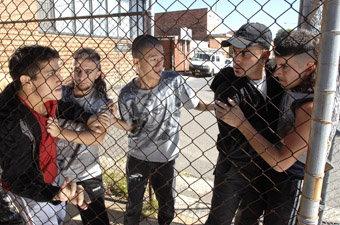
The Combination
WHEN VETERAN AUSTRALIAN ACTOR DAVID FIELD SOLD A SECOND-HAND CAR TO ONE OF GEORGE BASHA’S FRIENDS, GEORGE TOOK THE OPPORTUNITY TO SHOW DAVID THE DRAFT OF HIS SCRIPT FOR THE COMBINATION. THEY HIT IT OFF AND TOGETHER SPENT SIX YEARS TRYING TO FUND THE FILM THROUGH THE TRADITIONAL CHANNELS. EVENTUALLY, SCRIPT EDITOR, JOHN PERRIE, SECURED A PRIVATE INVESTOR FOR THE FILM AND BECAME ITS PRODUCER, LEARNING TO NEGOTIATE THIS NEW ROLE WHILE ON THE JOB.
The Combination has a gutsy rawness about it that seems to be connected to the fact that it was realised through these unconventional channels and networks, facilitating the film’s successful integration of emerging and experienced players.
The veteran players involved in The Combination have themselves mostly taken on new roles or new approaches for this film. This is David Field’s directorial debut after an acclaimed acting career stretching over more than 25 years and extensive experience as a dramaturg. It also marks George Basha’s debut as screenwriter and leading actor. However his insights into the events portrayed in the film, based on his own experiences of growing up in Western Sydney, are integral to its power.
The team has achieved a great deal with a $1.3 million budget. The Combination is one of the first feature films in Australia shot with the revolutionary Red digital camera system and the cinematographer, Toby Oliver, has made a very good-looking film in the process of pioneering this new technology. Ken Sallows, a well-respected industry veteran, has done what he does best and cut the film together with a tight and powerful visual economy.
This is only the second film to be distributed by the new company, Australian Film Syndicate, launched in September last year, headed up by the co-founders of the Dungog Film Festival, Stavros Kazantizidis and Allanah Zitserman. The Combination has achieved strong box office performance for the company, taking well over $500,000 in limited release around the country, mostly at Greater Union cinemas.
Unusually extensive media coverage has contributed to the success of the film. The Combination attracted a great deal of attention in its opening weeks, generating bold headlines and plenty of controversy.
A lot of the discussion that has taken place in the media about the film has, however, focused on events that have occurred off-screen. Three days after its release, Greater Union suspended screenings of The Combination from its cinemas after a security guard and an usher were assaulted and a fight broke out during the credits at one of the screenings in Parramatta. Ali Haidar, who plays Zeus in the film, was sentenced to six months jail for his role in a bashing on George Street in Sydney not long into the film’s run. These are definitely the kinds of events that get the mainstream media going.
Although distressed by these events and Greater Union’s three-day suspension of the film in NSW, the filmmakers have, on the whole, been delighted by the high profile publicity. This hype, however, has mostly sensationalised the very same stereotypes that the film itself is trying to investigate and complicate. Gang violence, racism, rage and revenge in Western Sydney, The Combination faces all of these issues unflinchingly.
Shot around Parramatta, Guildford, Granville and Merrylands, The Combination introduces us to John Morkos (played by Basha), a Lebanese-Australian man recently released from a two year stint in gaol and determined to straighten out his life, only to discover that his high-school-aged younger brother Charlie (Firas Dirani) is caught up in the same web of violence and crime that put him behind bars—leading some critics to dub the film Australian History X.
There is also an awkward love story between John and an Anglo-Australian girl, Sydney (Clare Bowen), which remains the film’s least sophisticated exploration of race relations. Unlike the rest of the film, it relies on the clichés rather than diving in and unpacking them.
It’s the lives of the two brothers, however, that form the central core of the film around which all else circulates. Both actors are riveting in their roles, as is Ali Haidar as Zeus, the leader of the bad crowd that Charlie gets involved with at school. Together, these three characters present three different potential outcomes for those struggling with the lures of violence, crime and drugs.
The Combination is a raw examination of the choices we make and how we live with the consequences. All the characters in the film have at least one difficult choice to make about the direction their life is heading. They are choices that mean risking their life, facing gaol, losing loved ones or being disowned by family. Some characters make those choices fully aware of the consequences of their actions; others make them without really thinking them through.
In a critical scene between John and his mother, Mary (Doris Younane), he insists that the choices he and his brother have made have been their own. As she despairs, he tells her that she cannot attribute the blame for their bad decisions to bad influences. Whatever the consequences, he argues, they are each ultimately responsible for their own actions. It’s an intense and interesting moment in a film that has spent a lot of time exploring the complex web of events that lead up to the devastating consequences that he and his brother must face.
The dramatic narrative structure of The Combination powerfully weaves together the dilemmas of the characters as they orbit each other, bear witness, clash and ricochet off one another, the choices each makes knocking on to other characters. Collision courses have been carefully honed without being predictable. Some of the events are truly shocking and the resolution we get is not the one we might have thought we were heading for.
Rage is a strong driving force in The Combination with John, Charlie and Zeus as three very different portraits of the condition, giving the film an intense momentum. John and Zeus, in particular, have rage on tap. The film helps us understand why as we watch it rise and fall, always ready to boil over as each character channels fury in different ways, and with very different consequences.
The Cronulla riots occur towards the end of the film’s narrative, and all the characters are suddenly glued to their television sets, watching in surprise, horror and disbelief. The reference is late, fleeting, an aside. It has no direct impact on the events of the narrative and barely enters the dialogue. Indeed, the riots themselves were not an inspiration for Basha’s script. When the Cronulla riots erupted in 2005, his plans for this film were already well formed and underway.
The film’s negotiation of this event is interesting. Keeping the riots oblique but still a reference point gives us the space to think through the connections for ourselves, helping us understand howThe Combination contributes to an ongoing, unresolved dialogue still taking place on our screens, in our homes, on our streets and in our everyday lives.
The Combination, director David Field, writer George Basha, cinematography Toby Oliver, editor Ken Sallows, producer John Perrie, distributor Australian Film Syndicate, 2009
RealTime issue #90 April-May 2009 pg. 28
© Megan Carrigy; for permission to reproduce apply to realtime@realtimearts.net
THE FIRST OF THE NEW MEDIA PROJECT DEVELOPMENT LABORATORIES SPROUTED IN AUSTRALIA EARLY IN THE DECADE AND HAVE SPREAD NATIONALLY TO A SCALE COMMENSURATE WITH THE BURGEONING GROWTH THAT FORMS THE DOMESTIC CROSS-PLATFORM SECTOR. EVENTS SUCH AS X MEDIA LAB (WWW.XMEDIALAB.COM) ARE NOW SIX-YEARS OLD AND INCLUDE PROMINENT INTERNATIONAL PRESENCES IN CHINA, INDIA, SINGAPORE AND SOUTH KOREA. THE AUSTRALIAN FILM TELEVISION AND RADIO SCHOOL’S LABORATORY FOR ADVANCED MEDIA PRODUCTION (LAMP, WWW.LAMP.EDU.AU) HAS A WELL ESTABLISHED AND REPUTABLE ROTATION OF RESIDENTIAL AND OTHER PROFESSIONAL DEVELOPMENT ACTIVITIES. CROSSOVER AUSTRALIA (WWW.CROSSOVER.ORG.AU), A LAB WITH A SUBTLY DIFFERENT FOCUS AND TONE RECENTLY HAD ITS THIRD LOCAL INCARNATION SINCE 2003 IN THE LEAD UP TO THE AUSTRALIAN INTERNATIONAL DOCUMENTARY CONFERENCE (AIDC) AND THE ADELAIDE FILM FESTIVAL.
From a participant’s perspective, Crossover Australia was an invaluable collaborative hothouse unique in the media landscape , a timely primer in current audience behaviour trends in media consumption, and a periodically stressful but ultimately highly rewarding creative exercise.
Crossover director Frank Boyd is a veteran of the creative laboratory process, having run dozens of high-level residentials with partners such as the BBC, Channel 4 and the UK’s National Endowment for Science, Technology and the Arts. He espouses the frameworks and stimulants for innovation and creativity with gravitas, and together with Sheffield Documentary Festival Director (and former AIDC Director) Heather Croall has successfully transported the Crossover model to Scandinavia and Canada, tweaking it to suit specific genres such as content for children, games and documentary. Three more international mentors plugged knowledge gaps and provided excellent one-to-one and team-based guidance: Matt Adams, the versatile co-founder of digital artist group Blast Theory (UK); Margaret Robertson (UK), a well informed games consultant and journalist; and Sandi Dubowski, an award-winning New York documentary filmmaker.
In the salubrious setting of the McLaren Vale wine district, 20 professionals from an eclectic range of media backgrounds converged with the broad brief of creating prototypes for “innovative interactive digital experiences.” Positioning itself as an accelerated development lab, Crossover emphasises the brainstorming and shaping of concepts rather than arriving with preconceived projects and team structures. Additionally, an explicit aim is to migrate practitioners from “vintage media” into the cross-media realm, or at least introduce them to the conceptual potential of genres and delivery platforms outside their comfort zones. Amongst the selected participants was an award-winning fantasy author, a playwright and a visual artist, blending with digital natives such as a game developer and an artificial intelligence programmer. This mixture of skills served to test the Crossover hypothesis that a good source of innovation is to bring together creative professionals from different sectors.
Crossover is structured into four key phases: an introductory stage that explores the territory of the lab and allows participants to understand each others’ skills; an idea generation phase encompassing a series of brainstorming exercises; the formation of teams to develop some of the stronger ideas further; and finally the pitching of these projects to a panel of funding agency representatives and commissioning editors. It’s an adrenaline-fuelled week.
The introductory phase was blessedly light on the getting-to-know-you theatre sports and more concerned with discussion of current intersections between audience behaviour, modes of delivery and emerging trends across media. Recurring themes included the ‘digital divide’ yawning between the technologically savvy and those unengaged or disaffected, and the issues facing rights exploitation. It was also an opportunity to learn about the complementary skills and personalities of those in attendance, to begin scoping out those with whom you would be willing to work closely as the week progressed.
The idea generation phase signaled the commencement of the lab proper. Using a range of techniques including classic brainstorming and lateral thinking tools, constantly changing teams started creating original concepts for cross-platform projects. For example, randomly selected teams were assigned a genre, a digital delivery platform and a demographic and asked to generate a project to suit the combination. Teams might be served Internet television, comedy and teen girls, and have 40 minutes to devise and pitch a concept to the larger group. Also employed was a useful user-focused design process, where teams each created a very specific, detailed individual audience persona and then came up with a digital project that it would enjoy. The exercises poured forth a stream of ideas of varying robustness, but also generated a palpably exciting environment.
Augmented Reality Games, commercial online software properties and community campaigns making intricate use of social media tools all were pitched, boiled down to fit on an A4 sheet of paper and fastened to the communal “ideas wall.” During the third stage of Crossover, a crucial turning point occurs in which participants select the projects from amongst the 60 or so generated to develop further and present on the final pitch day. The stakes were raised as political manoeuvering was necessary to secure preferred concepts and mixture of personalities. Ideas were teased out, directions tweaked and roles assigned as the projects grew more flesh.
As Crossover builds towards a public presentation the selected projects are developed in the prism of a five minute discussion, and in particular are pushed to address the value propositions enshrined in the Stanford Research Institute’s innovation methodology. What audience need is the project addressing? What unique approach is used to address this need? What are the benefits of this approach? And finally, what is the existing competition to the project? In the last 36 hours of the lab the direction changes markedly from a forum of ideas to the polishing of pitching skills, with some needing more intensive coaching than others. Most of the adrenaline surge occurs in this final phase as the teams are whisked to the AIDC to present to financiers for feedback. Although the presiding panel is aware that the ideas are only a few days old, it’s the potential for embarrassment that hangs most like Damocles’ sword. As it happened, the teams rose to the occasion, with a solid batch of proposals including serious games (projects designed to provide educational and social awareness instead of or in addition to entertainment) and community digital storytelling projects that had benefitted from being fired in the kiln of accelerated development.
The intimacy of the creative laboratory generates an intense atmosphere; the experience of having 20 new friendships progress in rapid-fire fashion created moments of tension and pseudo-melodrama. Fortunately (and perhaps incredibly), this Crossover was seemingly devoid of aggressive egos which made the experience smooth and enjoyable under the circumstances, and a safe and fertile breeding ground for creativity. My sole criticism is that, due to the idiosyncratic nature of the laboratory, Crossover is geared towards developing “concept cars” rather than projects that are ready to go into production; the quest for innovation occasionally leaves pragmatism behind. Nevertheless it’s a valuable exercise, and the networking benefits alone are enough to justify the process. The insertion of a focused business modeling component could add further value to what’s already a high quality and rewarding professional development opportunity.
Crossover Australia, 2009, South Australian Film Corporation, Adelaide Film Festival, Australian International Documentary Conference, McLaren Vale, Feb 15-19;
http://crossover.katalyst.com.au
RealTime issue #90 April-May 2009 pg. 29
© Sandy Cameron; for permission to reproduce apply to realtime@realtimearts.net
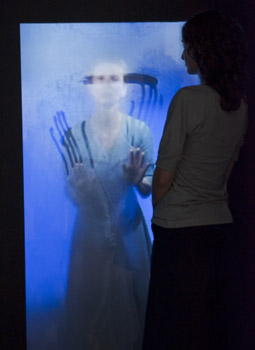
Lynette Wallworth, Invisible by Night, 2004
photo Grant Hancock, courtesy Samstag Museum of Art
Lynette Wallworth, Invisible by Night, 2004
SCREEN CULTURE IS EXPLODING AND MUTATING INTO NEW FORMS ALL AROUND US. IT’S HAPPENING IN PLACES AND FORMATS THAT ARE CHALLENGING THE VERY NATURE OF THE SCREEN AND THE BOUNDARIES OF MEDIA THAT MANY ARGUE HAVE BEEN CRUMBLING FOR DECADES. WHILE IT’S TRUE TO SAY THAT ART, CINEMA AND VIDEO HAVE CROSS-POLLINATED EACH OTHER SINCE THEIR INCEPTION, I WANT TO REFLECT ON THE POST-MEDIUM CONDITION IN WHICH WE FIND OURSELVES. THE SINGULARITY OF CINEMA (IF EVER THERE WAS SUCH A THING) HAS BEEN CONFRONTED BY THE EVOLUTION OF CAPTURE TECHNOLOGIES, MULTI-IMAGE LITERACIES, MULTI-PLATFORM DELIVERY AND NEW FORMS OF PRESENTATION YET TO BE INVENTED.
The idea of the medium as a physical substance for creating artistic forms is hard to maintain as the material conditions for this technical support are undergoing such massive transformation. These days it’s not uncommon for screens and projected images to appear on massive public displays, or on tiny 500-micron living tissues. Windows of office buildings may form the individual pixels for a giant image, or microscopic cells can be used for the purposes of “bio-cinema.” The night sky provides the canvas for orchestrated projections of light and sound. Portable domes and low cost sound/projection systems are becoming increasingly available for artists to work with. Enterprising designers are imagining car headlights as projectors that can beam these highly mobile images onto any available surface.
Even clouds, satellites and other celestial objects can now double as screens for the moving image. According to Scott Hessels (who reminds us of many of these things in the Summer issue of ANAT’s Filter magazine) “it is no longer so important what we are watching, but rather how we watch it.”
The Double Helix: Art and the Moving Image Symposium, held at the Samstag Museum as part of the Adelaide Film Festival, provided the impetus for stimulating insights into this question of how we watch and experience moving image culture. The two-day conference program also included a series of screenings, exhibitions and a selection of works from the DomeFest program (exhibited in a university planetarium). The relationships between visual artists, filmmakers and the plethora of new screen contexts lies at the centre of all these discussions. This article is not so much a review of this program as a reflection on the larger issues raised by this engaging international event.
For me the most challenging issue to come out of the Double Helix program is to do with the nature of the post-medium universe we work and play in these days. It makes little sense to talk about the media-specificity of cinema, for instance, in a moment where many films are made without the help of Kodak, the existence of sprocket-holes or a multiplex to play in. As Larry Kardish, Senior Curator of Film and Media from NewYork’s MoMA put it, cinema is no longer film, and films are made for contexts that can no longer be described as cinemas.
In this year’s Sundance Festival, for the first time in its history, more video was screened than celluloid. Nobody really seems to care any more about the ‘purity’ of film, and most of the directors shooting on HD and other digital formats continue to refer to themselves as filmmakers. As we head towards a massively networked ‘laptop cinema’ jacked in to LCD projectors configured for public and private viewings, it’s worth probing a little more into these and other forms related to the various screen cultures and practices that have emerged over the last couple of years.
The Double Helix conference presented plenty of opportunities for speakers and audience to reflect on the extent to which conventional rectilinear screen formats and cinema-style screening spaces predetermine and limit the potentialities of an expanded cinema. Gene Youngblood’s term (invented in the late 1960s) remains pertinent today as the possibilities for screen experiences outside conventional cinema proliferate significantly. Over the weekend there were plenty of talks referring to “cinema outside the cinema”, and plenty of opportunities to sample works barely recognisable as cinema in the ‘classic’ sense.
The DomeFest program clearly demonstrated the enormous possibilities being explored with ‘fulldome’ filmmaking and production techniques. Fulldome is a relatively new format (since around 1995) that provides immersive experiences via digital technologies presented on a hemispheric screen normally associated with planetariums. No longer constrained to imaging the night sky, fulldome is ‘exploding the frame’ of what planetarium domes might deliver. There are currently 500 fulldome facilities around the world, and the CGI-heavy short ‘films’ presented in the program clearly showed the potential for artists to push the boundaries. Scott Hessels’ extraordinary visualisation work Celestial Mechanics was made for fulldome, and reveals a digital universe that contains more than just stars. His patterns in the sky remind us of the mechanical constellations that invisibly encircle us in the form of satellites and all manner of human-made air traffic.
The questions that emerged from the symposium go to the heart of the dissolution and reformation of the screen. The work of Joyce Hinterding and David Haines (presented by way of an artists’ talk) is illustrative of this condition. Their work deals with fiction and phenomena, sensation, sound and the image plane in gallery and other spaces. It is a practice that is truly post-medium specific. (These ideas and others are explored in Haines’ blog, titled 21st Century Holograms, dealing with post-object art, aroma molecules, and post audio-video art practice—well worth a look.) Their work hints at an entirely different trajectory to cinema where, as Hinterding evocatively described their recent aroma works, “the image arrives directly to your brain in a powerful way” (see RT89, p27).
Another artist working in a similarly expanded practice is Mexican-Canadian Rafael Lozano-Hemmer (RT89, p22). While Australian audiences have had few opportunities to see his work, his keynote at the conference highlighted the extent to which the ‘cinematic’ can be transposed to techniques, viewing contexts and technological means that seem to have nothing to do with movies or filmmaking.
His large-scale public artworks and ‘interactive’ installations engage the public in playful and sometimes profound ways. He describes the work he presented (well documented on his website, www.lozano-hemmer.com) as a “dis-intermediation” of experience—a series of very public interventions into screen and public space. In many of his projects, the screen has nothing to do with a circumscribed surface. His projects play with the ability to skew, rotate, shift and map the image onto a variety of unexpected surfaces, and with playful, engaging and surprising results. He captures, re-presents and plays with the visualisation of data in complex and challenging ways.
As with many artists working at the limits of media specificity, his emphasis on “relational architecture” brings screen and sound technologies into dynamic relation with audience participants and the surfaces of projection. Many of Lozano-Hemmer’s works play with the absence of image and the heightened sense of real time interaction by way of the simplest of forms: public projections of light into the sky or onto public buildings at large scale. His work encourages audiences to participate in what he refers to as “a corporeality of shadows” that come to life in a self-organising fashion. In the words of the artist, these works “cast people’s presence onto the media.”
It’s an idea that many working with interactive media would want to claim, though it’s not always successfully achieved in screen-based forms that rely on the clicking of buttons and standardised navigation practices now highly codified in our everyday lives. How much has Flash and CSS shaped the way we click, drag and drop our way around the four-sided screens we work with these days?
Lynette Wallworth’s major show at the Samstag Museum, Duality of Light, brings together a number the artist’s major interactive works created in recent years. Her work demonstrates the kinds of potential for new screen-based experiences that ask for our bodily engagement and personal (inter)action with her images and sounds —no clicking here.
The way we touch, walk, and navigate our way through these works brings them into existence. We may capture the projected images on a beautiful translucent bowl, or raise our hand against the glass wall she’s projected her video portraits against in order to commence the work. The artist asks us to quite literally make a connection with the work.
Intimate, social and communal, these works are light years from conventional narrative cinema, and yet they gesture towards the power of the image in sequence, in space and in relation to the body of the audience.
The lines of distinction between cinema, video, installation, architecture and data visualisation seem less and less convincing as each moment passes. As John Conomos put it during his presentation, “artists don’t think categorically, they think a-categorically about these things.”
In the post-medium situation we find ourselves in, the media that artists use are infinitely differentiated, composited together, emergent and interconnected. In short, these are the tools of a dynamic media beyond the cinema.
Adelaide Film Festival and Samstag Museum of Art, Double Helix: Art & Moving Image Symposium, Feb 27-March 1; Domefest Project, Feb 24-27; Lynette Wallworth, Duality of Light, Samstag Museum, Feb 19-April 24; www.unisa.edu.au/samstagmuseum
RealTime issue #90 April-May 2009 pg. 30
© Ross Harley; for permission to reproduce apply to realtime@realtimearts.net
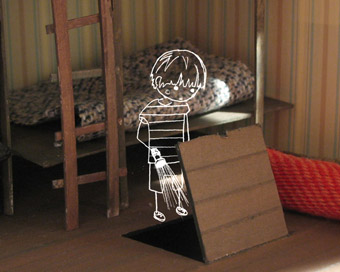
Ruckblende (‘Flashback’), Nils Deneke
THE COMBINED INSIGHTS OF A HUMAN-COMPUTER INTERACTION DESIGN RESEARCHER, A SOUND DESIGNER, AND A CYBER POET MADE FOR A LIVELY, IF SOMETIMES CONTRADICTORY, DISCOURSE AT THE RECENT ART U GAME FORUM IN TOWNSVILLE.
Earnest, passionate and irreverent respectively, experts Nicola Bidwell, Tom Ellard and Jason Nelson come at game design from three wildly differing angles. The forum complemented Pinnacles Gallery’s Wired 4 Games, an exhibition of eight award-winning, independent, online computer games from around the world. Curated by Anthony Edwards, the interactive show is a concrete demonstration of how games design is being more widely recognised as intersecting with art, while the forum revealed the broad draw of this relatively new genre, with few boundaries apart from cost and computer memory limitations.
Nicola Bidwell, senior lecturer in IT at James Cook University (Cairns), acknowledged that her phenomenological research and experiments into how people experience, feel, remember and navigate in natural environments creates the potential for “designing games not to replicate the outdoor experience, but to get at that feeling…games to take the self into a different space.”
“While some [existing] game environments are beautiful”, Bidwell said, “the narrative is a difficulty—you have to keep shooting people to progress through that world. Traditional games use devices such as shortcuts and teleportation, adding to the time challenge. They are not used like real places for memories, stories, enjoyment and the range of emotions which make a place a specific place for you. There are few opportunities to placemake; no footprints, no path abrasion, no scars from your fires, no real physical indication of meaning, and this interrupts the flow of any sense of belonging.”
Bidwell’s research underpins her belief that nature and landscape can represent a protagonist, make a player work hard, pay attention and make memories, draw them through and reward them with momentary pleasures like the light filtering through trees.
“Natural views, trees and water are notoriously difficult to animate without costing too much computer memory, so artists circumvent this by creating the sensation in the eye that views the subject, rather than recreating the subject.” Bidwell explains that when this is done successfully it can, like Impressionism, evoke sensations without needing high fidelity focus on the subject, as in Cloud, one of the more meditative games in the exhibition.
Mixed reality gaming is another application Bidwell’s research points to. “Why not play inside a video” she asked, “and allow the player to become author and artist?”
Tom Ellard of CoFA (College of Fine Arts, UNSW) told the forum that he focused on sound design because “You can spend four years at uni and 200 years in a gulag in Siberia [studying game design] and still not be able to code Tetris.” Animated by his subject, Ellard packed the history of sound in games design into a memorable hour, impressing on the forum that the audio component is 50% of the experience in hybrid arts, but is generally underfunded and usually left to the last minute.
Covering everything from Space Invaders (the first computer game with a continuous soundtrack) to the dialogue parsing in Halo, Ellard illustrated how sound focuses a player’s attention, frames scenes, anticipates action, provides emotional guidance and extends game worlds. “Sound can be a cheap way to enlarge a gameworld in terms of processing power and design time”, Ellard explained. “If the budget is $5, one sound like birdsong can imply a whole gameworld outside a virtual room.”
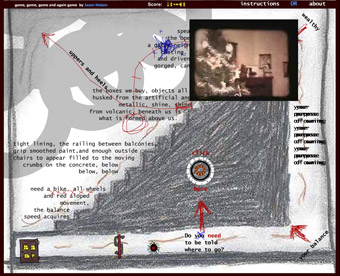
Jason Nelson, Game, game and again game
Jason Nelson, a cyber poet who originally hails from Oklahoma and now teaches Net Art and Electronic Literature at Griffith University on the Gold Coast, good humouredly repudiated Bidwell and Ellard’s input with his audacious lack of consideration for gaming conventions of any kind. “Made on a lark”, one of his online games has received over eight million hits. “But, he added self-deprecatingly, “cats throwing up can get two million hits on YouTube.”
Nelson described his works as “anti-games…messy, screwed-up and strange…digital poetics with interactive narratives…some confusing type of hell built from messy lines, originally meant to overload your computer so you’d have to back out.” He builds using “played to death platform engines [which] form a bridge into artwork because even if people have never been in a gallery, or don’t understand the content, they’ll still play around with it.”
Nelson encouraged would-be game designers, artists and writers at the forum to “think as imaginatively as possible…collect interfaces…and make your own games not from your coding skills, but from your creative skills.” He has used hand-drawn graphics, Flash for music, Fruity Loops for samples, snatches of advertising soundtracks and Super 8 films from his childhood, even borrowing poker machine technology to create games which randomly predict comically dark death scenarios for the player, and a Christmas disaster generator.
Game, game and again game (2007, see www.realtimearts.net/portal), Nelson’s award winner, was the Australian inclusion in Wired 4 Games, alongside games from Canada, Germany, France and the USA. “C’mon and meet your maker”, intones Nelson’s game every time you die (but don’t die) in this colourful and cacophonous reflection on belief systems, inspired by “Mormon pamphlets in laundromats.” With levels labelled fundamentalist, Buddhist and real estate, among many, the game observes game conventions just enough so that “people will follow if told to ‘go there’ or ‘click this’”, but there’s no point scoring in the traditional sense—you may be rewarded with a snatch of text from The Book of Swordfish instead.
The game is an addictive sensory assault when played online at Nelson’s website www.secrettechnology.com, and projected on the wall at Pinnacles the disorienting effect was magnified, but still magnetic.
In complete contrast to Nelson’s busy screens, Rod Humble’s (USA) Stars Over Half Moon Bay is mesmerising, with slow and restful duotone minimalist graphics and a quiet piano and steel guitar soundtrack by Critical Monkey. The only effort required is some languid scrolling to collect stars and create constellations in a virtual equivalent of star gazing.
Ruckblende (‘Flashback’) by German Nils Deneken has a fairytale quality in its cutout forest, overlaid at intervals with little sketched people, objects and arrows suggesting clues to further stories. As the player navigates through, small events occur, but it appears there’s no particular goal to the game. It had a slightly claustrophobic and sinister feel to me, as though something Grimm was yet to occur.
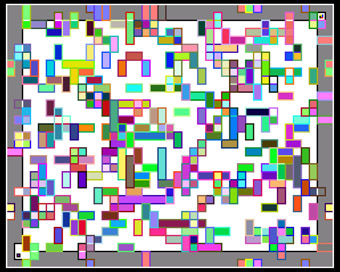
Mondrian Provoked, Jim McGinley
Mondrian Provoked, created by Jim McGinley (Canada), has increasingly difficult mazes of moving graphics—you are trapped in a Mondrian painting. If the player manages to navigate the maze without being crushed by a block of colour, the reward is a frenetic dance by the painting’s elements, which I can only liken to the vision disturbances at the onset of a migraine.
The most popular game in the exhibition, in terms of eager players, was Kloonigames’ (USA) Crayon Physics Deluxe, which is also fairly conventional in terms of gameplay levels and rewards. It faithfully replicates the laws of physics and applies them to the crayon objects the player creates using a mouse (or stylus on tablet), setting off chains of responses in real time. The game is completely engaging, and elicited the most uninhibited verbal responses (bursts of laughter and howls of frustration) of any game in the exhibition.
Pinnacles, a purpose-built gallery at Townsville’s Riverway complex, is not large but accommodates new media exhibitions well. For Wired 4 Games a low-light ambience was created by deep purple-blue walls with rough edged white patches left as screens for the game projections. Plinths contained the necessary keyboards, mice and headphones (in some cases), and light- and sound-spill was minimal and not distracting. The labelling and instructions were adequate, and an attendant was available to provide guidance if needed, and to troubleshoot the occasional technical glitches. All of the games are accessible online. Most are free, but be warned that some are big downloads due to the complex graphics.
Wired 4 Games, curator Anthony Edwards, Feb 7-March 15; Art U Game Forum, Pinnacles Gallery, Townsville, Feb 28
Rod Humble, Stars Over Half Moon Bay, www.rodvik.com/rodgames/
Nils Deneken, Ruckblende
http://indygamer.blogspot.com/2007/12/new-rckblende-mirror.html
Jim McGinley, Mondrian Provoked, www.bigpants.ca/mondrianprovoked/
Kloonigames, Crayon Physics Deluxe, www.kloonigames.com/crayon/
RealTime issue #90 April-May 2009 pg. 31
© Bernadette Ashley; for permission to reproduce apply to realtime@realtimearts.net
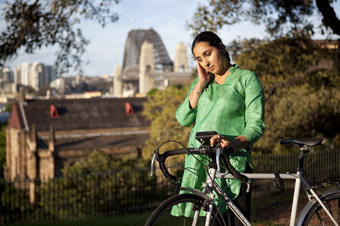
Rider Spoke, Sydney, Blast Theory
photo Alex Kershaw
Rider Spoke, Sydney, Blast Theory
NAVIGATING MY WAY THROUGH CROWDS OF TOURISTS AT CIRCULAR QUAY, I ARRIVE AT A SPECIAL CHECK-IN COUNTER INSIDE SYDNEY’S MUSEUM OF CONTEMPORARY ART READY TO EXPERIENCE BRIGHTON UK-BASED NEW MEDIA GROUP BLAST THEORY’S RIDER SPOKE. THE ARTIST TEAM WHO WELCOME ME—CORE BLAST THEORY ARTISTS MATT ADAMS, JU ROW FARR AND NICK TANDAVANITJ WITH THE ABLE ASSISTANCE OF A GROUP OF LOCAL GUEST ARTISTS—ARE POLITE AND FRIENDLY, CASUALLY DRESSED IN COLOURFUL CHECKED SHIRTS. I AUTOGRAPH VARIOUS INSURANCE AND INDEMNITY FORMS, DISPLAY MY CREDIT CARD, AND THEN RECEIVE A SHORT BRIEFING AND MY EQUIPMENT—HELMET, HEADPHONES, AND A BICYCLE WITH A SMALL TABLET COMPUTER MOUNTED ON THE HANDLEBARS.
So far, everything in Rider Spoke seems very relaxed and low-key, radically dissimilar to Blast Theory’s last Sydney appearance back in 2002 with the immersive Gulf War-inspired gaming performance Desert Rain. Far from the extreme containment of Desert Rain’s high-stakes virtual world, Rider Spoke embraces the open air, allowing its participants to explore vistas of their own choosing and perhaps increase their fitness in the process.
On my first visit I ride left, following the sunshine and sparkling water. It’s a perfect summery Sydney day. The gentle voice of Ju Row Farr in my headphones lulls me into the experience, telling me small stories and making gentle suggestions as to what I might wish to do during the work’s duration. As I roll along the waterfront, I feel relaxed, safe, and contented. What could be more perfect than cycling for art on such a day? At the request of the recorded voice, I stop and record a description of myself, feeling for some reason the need to be entirely honest. What follows over the next hour is a gentle yet deeply fascinating ambulatory artwork, encouraging me to do no less than reconsider my entire physical and psychic relationships to the city in which I live.
The format of Rider Spoke is simple. The voice in my headphones encourages me to ride in any direction I wish, to discover the city for myself; to feel its wind on my face and breathe in its air; to use the cycling experience to take account of the city, and of my physical presence within it. At various points, I am asked to stop and offered the opportunity to record responses to given questions. Each of these acts of recording are referred to as ‘hiding’, and each time I ‘hide’ to reveal a personal story, the process is marked on the handlebar screen by the image of a flock of birds. The birds swirl outward, circling and returning, as if enfolding my story in their feathery embrace. There is never any sense of coercion or compulsion in these acts of hiding, simply calm requests for stories framed by the gift of other small anecdotes from Farr.
It’s clear that her stories have taken place in a different city, but as I listen to them while drifting along the Sydney streets they are woven into the local urban landscape. Farr’s intimate disclosures encourage an equivalent sharing, and the more stories I record, the more other stories I am able to find, generating a fascinating interpersonal map across the city streets, a map whose territory increases the more closely it is examined. As I lurk in nooks and crannies out of the flow of vehicle traffic, previous travellers on the street whisper in my earphones intimate reflections upon place, emotion and memory. Every secret story, wish, or promise is linked to every other, with the city reimagined as a web of story traffic. Every other bicycle rider that I pass feels like family—a fellow sharer of private whispers. Rider Spoke seems to propose a mode of urban navigation that borders on sacrament.
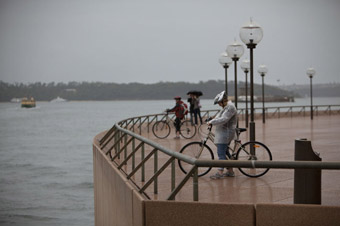
Rider Spoke, Sydney, Blast Theory
photo Alex Kershaw
Rider Spoke, Sydney, Blast Theory
A week later I partake for a second time, choosing to cycle right into the gloomy grey of a rainy Saturday afternoon. Chronology goes askew as I cycle further through the rainy and only sparsely populated city streets. I listen as ‘Adam’ describes holding his girlfriend’s hand, and consider my own memories of this experience. Close by, I listen as ‘Sarah’ promises to stay angry and not feel bad. As I eavesdrop on these public secrets I lean my bike in a laneway watching a wedding photographer at work as the rain falls steadily around me. ‘David’ finds a clear view of the sky and tells me of his worries about debt, worries that keep him awake at night. But he only does so after I obey my guide’s instructions and follow a man as he navigates his way across a public square and describe his actions. One act of voyeurism deserves another, it seems. In the sheltering scaffold outside the High Court on Macquarie Street, I listen as ‘Olivia’ promises to be honest for a day. I wonder how best to respond to this, and whether I should make a promise in return, and if so, what sort of promise I might be able to make.
Rider Spoke hints at the presence of deep social relations, and allows me to pass easily amongst them, mapping the city using a unique blend of pedal power and storytelling. The work suggests that perhaps such simple interventions might allow the city to care more deeply about the people who pass through it, about their stories and commitments to the future. As I ride ever onward, time begins to feel out of sync, and my travels somehow out of space. I traverse the grid of inner city streets, dodging cars and passing pedestrians, and as I travel I feel the weight of other times and places pressing upon me—fleeting experiences whose intensity of feeling suggestively marks these urban landscapes.
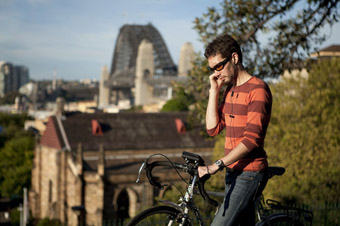
Rider Spoke, Sydney, Blast Theory
photo Alex Kershaw
Rider Spoke, Sydney, Blast Theory
At times, Rider Spoke feels as if it is navigating the boundaries of a new public privacy, encouraging the making of confessions while surrounded by strangers. In a sense, this is quite an ordinary experience—after all, we do this unthinkingly almost every day as we talk on mobile phones, often discussing the most personal and intimate details in public spaces, often at relatively loud volumes. Somehow we expect that, in the city, no one will listen. Or if they do, that there is no way anyone will remember. In Rider Spoke the city’s nooks and crannies, the eddies in its flow of near-continuous movement, are reframed as spaces of memory, contemplation and intimacy. Small secrets play out privately in public spaces, and their presence suggests the elusive passage of many more, just out of my audio reach, suggesting that if only I could cycle every inch of the city and discover all of its hiding places, every delicate secret might be revealed.
The voice in my headphones informs me that my hour is up, and that I should return. As I unwillingly meander back to the beginning of my journey, Blast Theory has the final word. “I feel very close to you right now. Very close and a million miles away at the same time.” I weave through the milling crowds at Circular Quay and the voice continues: “There was something in the silence, but you spoke over it. You always do.” I return and leave my bicycle behind, but somehow I know that an important part of me has remained, enmeshed in a suspended web of whispered secrets.
Blast Theory, Rider Spoke, Sydney Harbour Foreshore Authority, British Council, Museum of Contemporary Art, Sydney, February 6-15
RealTime issue #90 April-May 2009 pg. 32
© David Williams; for permission to reproduce apply to realtime@realtimearts.net
CYNETART IS AN INTERNATIONAL FESTIVAL BASED IN DRESDEN, GERMANY. SINCE 1997 IT HAS SHOWCASED NEW TRENDS IN CULTURAL DEVELOPMENT, BROACHING ISSUES OF CHANGE IN THE PERCEPTION OF THE BODY BY NEW INFORMATION TECHNOLOGIES. THE FESTIVAL ALSO REFLECTS ON THE IMPACT OF INTERFACES AND DIFFERENT KINAESTHETIC VOCABULARIES FOR PERFORMANCE AND INCLUDES PROJECTS THAT INTEGRATE ART, SCIENCE AND MEDIA TECHNOLOGY. SINCE 2000 IT HAS BEEN PRESENTED AT FESTPIELHAUS THEATRE, HELLERAU.
The forum, Post Me_New ID is part of CYNETart 08 and is one of a series of dynamic collaborations between body>data>space (London, UK), Eira (Lisbon, Portugal), CIANT (Prague, Czech Republic) and 16 international partners. It is co-produced by an international consortium from the Czech Republic, Germany, Slovenia and the United Kingdom within an action/research project of the same name, which focuses on “the future of the body”, and is co-financed by the European Commission under Culture 2007 programme.
ZAP PARAMETER RAM—PRAM. This is an old Mactinosh term, circa 1995-2003, pre intel chip—to refresh memory.
That’s what it feels like when you land tired but wired into cities and peoples steeped in histories of all kinds. Like me, Dresden is recovering from time, re-forming its past (the lag of jets, 53 hours in flight, the destruction of wars, five stopovers, occupation). I am here because of my experience in making and thinking about the subject matter of bodies, architectures, electronic networks, the physical, the virtual and states of interconnectivity that cross borders of art, science, culture, design, the social and political as a complex choreography of human evolution.
Running late to the tram stop, I note with pleasure the intricate patterns of contoured cobbled paths under foot, fine mist and rain. Sulphur yellow leaves flash past as the tram turns into the forest on the edge of Hellarau.
I’ve been invited by the co-producers of the forum, Thomas Dumke, Head of CYNETart and Ghislaine Boddington, Creative Director of body>data>space, to add my thoughts about digital performance/choreography and the embodiment of physical/virtual networks with other interdisciplinary practitioners from art, science and technology who are arriving from across Europe and beyond to address the themes of the forum: the future of the body; the complexity of 21st-century European identity; the effect of digital technologies and networked communities on future generations.
My Random Access Memory, that grey matter of mind that connects all senses Zaps, Refreshed into simultaneous embodiment of the feeling state—Heimweh (that German expression for homesickness) and Heimkehr (a coming home). For it seems in present/future times of fire and flood, financial fear and screens of smoke, there is no safe home; but there is a safe return—to people; to dwell in thought, activated by the propositions presented by CYNETart & Post Me NEW ID Forum—and in so doing, to rekindle the spirit of Festspielhause Theatre Hellarau that blossomed too briefly 1911-1914.
The theatre was built as a home for Emile Jacques Dalcroze’s Eurhythmics; his movements were designed to make rhythm flow through the body, expressing the shape and nature of music. Designed collaboratively by architect Heinrich Tessenow, stage designer Adolphe Appia, Georgian painter and set designer Alexander von Salzmann, it was conceived as a meeting place for the European avant-garde, a cathedral of the future, where audiences and performers were to melt together to become a spiritual and sensual unity. Occupied since 1915 by the German and Russian armies, it was reclaimed for art in 2002.
Night. I run from the tram to Hellarau, enter CYNETart award ceremony late. I hear the words “Second Life” jump out from the German. I see a zombie figure, slumping, printed on the T-shirt of award winner Susanne Berkenheger, as she moves to the microphone to accept flowers and a cheque for her project, MOVEMENT-FOR-ACCOUNT-CORPSES. I sense a playful politic reminding us of other crossover balancings between physical and virtual worlds, ethics and responsibilities. She is animating forgotten souls (14 million avatars) abandoned by their makers; sad remains of the data of users who logged out long ago, now living, invisible, half-dead slumping like zombies in the metaversum of Linden Lab’s Second Life.
Post Me New ID commences the following morning. Guests and participants arrive from near and far. Included among the presenters and speakers are Ghislaine Boddington and Leanne Bird (UK), kondition pluriel (Germany/Canada), Mika Satomi and Hannah Perner-Wilson (Austria), Steve Dixon (UK), Yacov Sharir (USA), Masaki Fujihata (Japan), Denisa Kera (Czech Republic/Singapore), Michael Takeo Magruder (US/UK), Fiddian Warman (UK), Sita Popat (UK), Susanne Berkenheger (Germany), Marlon Barrios Solano (USA dance-tech), Johannes Birringer (Germany/UK/USA), Thomas Dumke (Germany) and many, many more.
Each morning over three days seminal artists and practitioners deliver keynote presentations that reflect on their frontier research in developing performance/interactive installation, using telematic, human computer systems, virtual 3D multi-user environments, to trigger the day’s discussions, provoke questions.
Choreographer Professor Yakov Shahir (USA) reminds us how long dance has been extending itself into virtual ‘stages’ to question and expand choreographic forms. He compares his earlier works, wearing heavy, hot, hard-wired computers, to the lightness of new software and wireless connectivity that he can perform in real time to his interactable double—a cyberhuman, in a continual dance of transformation one into the other; virtual shifts both embodied and disembodied at the same time, as a flow of consciousness.
Steve Dixon (UK), author of Digital Performance (MIT Press, 2007), one of the most comprehensive books on the subject, reminds us that we have always had multiple identities, from masked balls to performance personas, as mirrors of or aspects of self. His telematic collaborations with Paul Sermon and the Chameleon Group (UK) allow improvisatory participation between audience members in the USA and a performer in London. The screen becomes a magic mirror we step through, a portal between shared worlds, not only a reflection of self but also shared space for play and interaction.
Masaki Fujihata (Japan) takes us on a journey of thought through time from the design of tea houses to his early interactive 3D spaces, to learning calligraphy and on to new frontiers of neuroscience that will become pertinent in how we design into the future smart interactivity that privileges the infinite intelligences of our embodied memory.
In their installation performance, Kondition Plural-Passage (Canada-Germany) develop a complex crossing between the physical installation space and the electronic interactive computer architecture, where audience and performer relationships merge. Synaesthetic transformations of data, generated by us as we twist and slide dials sewn into the performer’s clothing, alter her movement vocabularies and simultaneously generate 3D images and sound environments across a matrix of five curvilinear screens and speakers. And so time turns back and we at Hellarau in CYNETart and Post Me New ID in 2008 inhabit the vision of 1911—a cathedral of the future where audience and performers were to melt together to become a spiritual and sensual unity.
There were many other works but not the space to cover them including a beautiful slow-moving pixel sea-sky-horizon, bathers caught still in motion over time. Our visual perception affects our conscious state. A Wagnerian chord suspends time as we lie two at a time in slumped back canvas deck chairs.
post-post me_new id
Given we are curiously and ambiguously hooked into networks like flickr, twitter, jitter and Max in our multi-identity, networked Facebook of life, looking towards the future with smart solutions for creative survival, we could turn our gaze skywards for a moment to clock those turbulent, giant black balloons from our frequent Google flyer rewards system, served up from all those searching engines looking for answers.
Post Me_New ID will be producing a book and a DVD. In addition, a series of Creation Processes will result in a public installation/performance.
I would like to thank the last of ANAT’s quick response funds for partly supporting my presence in Dresden, and my artistic collaborators on Darker Edge of Night Stage One, the Australia Council’s Inter-Arts Office and Arts House’s Arts Lab who helped me have something to say.
CYNETart_08 and Post Me_New ID Forum, Festspielhaus Hellerau, Dresden, Germany, Oct 30-Nov 9 2008
RealTime issue #90 April-May 2009 pg. 33
© Hellen Sky; for permission to reproduce apply to realtime@realtimearts.net
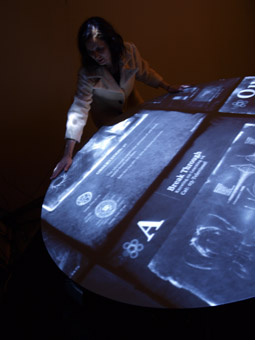
KNOWMORE (House of Commons)
THE STATE LIBRARY OF QUEENSLAND IS A NICE ENOUGH BUILDING DOWN BY THE EDGE OF THE BRISBANE RIVER. ON THE GROUND FLOOR IS THE INFOZONE, WHERE YOU CAN LOOK ACROSS TO THE CBD OR JOIN THE TOURISTS AND CHAT OVER A LAPTOP WHILE USING THE FREE WIFI. JUST INSIDE, NEAR THE FRONT AND ON THE LEFT, A SECTION IS ENCLOSED WITH DRAPES THAT LOOK A LITTLE LIKE BLACK HOSPITAL CURTAINS. IN FRONT OF THE DRAPES A SIGN ON A CHROME STAND INVITES THE PASSER-BY TO HAVE A LOOK AT KNOWMORE (HOUSE OF COMMONS).
Brush past the curtains and into a space that is darkish, but not too dark, because the curtains don’t go all the way to the floor and they are not thick enough to block out all the light anyway. A round cafe-size table, for four to six persons, takes up the centre. There’s enough room to walk around it, but it’s still pretty cosy. An overhead projector hangs above, pointing onto a mirror at just the right angle to reflect the projection onto the dark top of the table. There’s a spatial sound set-up too, although I don’t really notice the speakers at all.
The installation is operated by grabbing the edge of the table and giving it a spin. Clockwise or anti-clockwise, either way is fine. Give it a spin and the graphics on the table become animated. Move around the table and the graphics change. There are five different scenes and each scene gets its own slice of the table-as-pie, with a little overlap and overlay at the slice boundaries. The overlap adds to the smoothness of the experience—no jumps from scene to scene. The sound seems to change as well, although the changes are not particularly dramatic or obvious. Again, this adds to the coherence of the experience.
The graphics are great—first up I’m seeing some acid green polyps, chasing each other around and around the table, flagella beating away behind them, tentacles fluffing about in front. They twist and turn, and the faster the table spins the more it acts like a centrifuge, driving the polyps outward to the edge. There is a genuine sense of watching something alive and swimming in a current controlled by the lazy-Susan spin of the table.
Another scene and another biomorphic form—circular, symmetric, hairy with cilia, more varied in colour than the polyps. I spin faster and the image speeds up and zooms to cover all the table surface. The physics of the animation is great—utterly natural in the way the cilial hairs are pulled out straighter and straighter as the speed increases. But it is the clarity of the interaction that stands out. There is no apparent lag between giving the table a spin and seeing changes in the animation—the table is beautifully engineered and the interface between table and animation is completely transparent.
Rather than imitating life forms, the next two animations show particles and clouded shapes sucked down into the centre, faster and faster with the table spin. These two sections don’t work as strongly for me, the interaction is less direct—the table spins around but the animation works radially across the spin, from the edge to centre.
Moving around the table a little more and we see a faded database on old style microfiche—blue grey images and defocused text. Now the table spin moves our view on to the image, like driving crosshairs with a shuttle wheel. Spin one way for the X-axis, reverse the spin for Y. There’s a nostalgia evoked by the monochromatic microfiche that is reinforced by arranging the information into cells. It’s like the periodic table of elements with micrographs and quasi-elementary chemical symbols: Er for Erbium, and Ke for… what? But the nostalgia is not just for a look, but for a system of knowledge based on recording, codifying, naming—partitioning the phenomenal world into atomic events.
I play some more, spinning and slowing, trying to make out the images, reading the grainy cells where I can: “Observation 03: the action of language and knowing are of different registers”; “Observation 06: the should of conduct exists in relation to a crisis in conversations rather than an embodiment of concern.”
As I read the information in the database cells the animation slows, the direction changes. Text and image ripple like flowing water, then submerge completely. A few more steps around the table and the polyps emerge again—a few living cells chasing each other, as at the beginning.
Keith Armstrong describes KNOWMORE (House of Commons) as concerned with common interest and empowering through embodied knowledge and communal action. However this was not obvious from my interaction with the work. ‘Spin’ is an unusual choice for physical interaction. The movement of the spinning hand is across the body and works against primary gestures of incorporation and repulsion.
However, perhaps working against the poetic engagement of the sole user is a strength of the work. KNOWMORE (House of Commons) is an installation that is meant for small groups of users. One can imagine a forward and backward tussle between the various people over which way the table spins, and who gets to spin it. A negotiated and dynamic exchange of control will emerge and bring the underlying concerns of ‘common interest’ deeper into the experience. As the only person using the installation perhaps I missed that negotiation, that deeper meaning. Perhaps playing alone is not supported at this time.
KNOWMORE (House of Commons), interactive installation, directors Keith Armstrong, Chris Barker, visual artist Stuart Lawson, Quest3D author Darren Pack, sound design Luke Lickfold, Infozone; State Library of Queensland, Brisbane, Feb 21-May 24; www.embodiedmedia.com
RealTime issue #90 April-May 2009 pg. 34
© Greg Hooper; for permission to reproduce apply to realtime@realtimearts.net
AUSTRALIAN MEDIA ARTISTS HAVE A STRONG REPUTATION AS BEING AMONGST THE MOST ACTIVE, CREATIVE AND INNOVATIVE IN THE WORLD. THESE ARTISTS AND THE INFRASTRUCTURES THAT SUPPORT THEM HAVE CREATED A STRONG COMMUNITY OF PRACTICE THAT HAS INFLUENCED BOTH ART MAKING AND ART INSTITUTIONS HERE AND INTERNATIONALLY. LOCATING THE EXACT TIME AND PLACE WHEN THIS BEGAN IS ALMOST IMPOSSIBLE. HOWEVER, IT IS CLEAR THAT SINCE THE EARLY 1990s, THE DIGITAL TURN HERALDED BY THE EMERGENCE OF THE PERSONAL COMPUTER AND THE INTERNET HAS LED TO AN EXPLOSION OF DIVERSITY IN ART PRACTICES. THESE PRACTICES HAVE NOT ONLY CREATED A BREADTH AND DEPTH OF MEDIA ART BUT ALONG THE WAY HAVE TRANSFORMED MANY MORE TRADITIONAL ARTISTIC FORMS FROM DANCE TO PAINTING TO SCULPTURE.
While funding for media arts in Australia has been multifaceted if somewhat erratic, it is education that has played a pivotal role in developing and supporting media arts practice. As Elaine Lally noted in the Australia Council New Media Arts Scoping Study Discussion Paper (2006), “Higher educational institutions have supported the sector strongly since the early 90s, in terms of training but especially [with] access to infrastructure…Many artists first got access to equipment and studios through study and subsequently find work or fellowships as academics and this is at least partly because it gives them access to the infrastructure they need to make work” (Lally, E., New media art scoping study discussion paper, Australia Council for the Arts, July, 2006).
In fact, media arts education goes back even further than this. The School of Art and Design at Phillip Institute of Technology (now RMIT) was offering courses in media arts as far back as the late 1970s. Leading media artists such as Philip Brophy, Philip Samartzis, Martine Corompt and Ian Haig can all trace their practice back to this outer suburban island of arts culture in Melbourne’s northern suburbs. The fact that this now appears to be a little known or remembered fact is testament to the lack of information available about the evolution of media arts education in Australia. There are undoubtedly many other instances of courses taken and taught of which this author is unaware (all feedback welcomed). But the point here is that the evolution of media arts education and its current profile in higher education institutions in Australia is poorly documented and, as a consequence, not well understood by those either within the field itself or in the broader community.
None of this would matter much if such art practices were given the respect and attention they deserve within the very higher education institutions that purport to support them. However, with a few notable exceptions, such as SymbioticA (at UWA) and iCinema (at UNSW/COFA), to name just two, this is rarely the case. As universities move towards what Marilyn Strathern has most aptly described as an “audit culture”—where “higher education is being moulded and managed according to what seems to be an almost ubiquitous consensus of aims, objectives and procedures” which seek to endorse “government through the twin passage points of economic efficiency and good practice” (Marilyn Strathern, Audit cultures: anthropological studies in accountability, ethics, and the academy, Routledge, London, 2000), the necessity of providing those who control the higher education budget with clear and compelling evidence of the vibrancy of the field is vital.
With this in mind, the group behind the Media Arts Scoping Study Symposium (MASS) and the National Organisation of Media Arts Database (NOMAD), led by Paul Thomas at Curtin University, applied for and received funding from the Australian Learning and Teaching Council (formerly the Carrick Institute). The group include Eleanor Gates-Stuart (formerly head of Centre for New Media Arts, ANU; currently Fellow at ANU), Vince Dziekan (Faculty of Art & Design, Monash University), Associate Professor Brogan Bunt (Faculty of Creative Arts, University of Wollongong), Professor Julian Knowles (QUT Creative Industries Faculty), Lyndal Jones (Creative Media, RMIT), Ross Harley (CoFA, UNSW), Mitchell Whitelaw (School of Creative Communication, University of Canberra) and artists, theorist and electronic engineer Stephen Jones. They have secured the support of each of the institutions already mentioned as well as ANAT and the ANAT supported Synapse project, the Australian Screen Production Education & Research Association (ASPERA), Melbourne University and the Victorian College of the Arts. It is hoped that more institutions will get on board to support the project as it gains momentum.
The aim of both MASS and NOMAD is to encourage the creative exchange of ideas, information, curricular models and best practice solutions in the field of media arts education. The MASS symposium will be held in Melbourne at the Victorian College of the Arts on July 4 with the explicit aims of both exploring theoretical, scientific and philosophical pedagogies that have influenced the development of media arts and establishing the basis for a functional network model for the establishment and growth of NOMAD. The organisers hope to attract anyone who is interested in the introduction and infiltration of digital media, technologies and related pedagogies in disciplines such as Art & Design, Architecture, the Humanities and Arts & Social Sciences; as well as to showcase examples of interdisciplinarity through art-science-technology collaborations. The respected artist (and co-editor of White Heat Cold Logic: British Computer Art 1960-1980, MIT, 2009), Paul Brown, will deliver the keynote address.
While it is hoped that the symposium will provide a chance for media arts educators and practitioners from around Australia to have some much needed face to face discussion and debate, there’s no doubt that it is also designed to provide some impetus for the development of NOMAD. The National Organisation of Media Arts Database is integral to the success of the overall MASS/NOMAD venture as it constitutes the longitudinal outcome of the entire project. It is currently located at http://www.nomad.net.au.
NOMAD is not the first attempt to create a national database of new media and media arts education. The Fibreculture network began trying to compile a list of subjects and courses relating to these fields back in 2003. However, NOMAD is the first to do so with a reasonable amount of short term funding. That said, similar issues faced by Fibreculture may plague the project if attention is not paid to the inherent difficulties that beset such missions. (And missions they most certainly are as they require a degree of zeal to really make them work.)
The database is set up to work as a kind of social network in the sense that members are able to share information about who they are, by creating a profile, and what they do, by uploading materials they wish to share with others to the site. However, like all social networks, it will requires a critical mass (no pun intended) to make it work. At present there are 27 registered members and that includes the working group who have established the site. With a view to building the numbers, Paul Thomas has been working hard to visit institutions and individuals to explain the project and to encourage them to participate. Part of the difficulty is getting them to understand the critical nature of the project in terms of the need to create a stronger sense of identity for media arts education within higher education institutions and funding bodies. While the initial outlay of time required to join and contribute may seem initially onerous to those of us who already feel overworked and undervalued, the long term rewards of having an easily accessible, well documented, identifiable and legitimised network of resources and people at our disposal, from which we can draw and towards which we can point our institutional auditors will be invaluable.
Close attention also needs to be paid to the penchant of media arts practitioners and educators to get bogged down in nomenclature. Clearly, debates about what constitutes media arts, electronic arts, new media arts, intermedia, interarts or any of the other descriptors applied to the field are vital. But they are debates that most of those whose approbation we need to gain, in order to continue to do what we do, either fail to understand or prefer not to hear. Surely it’s possible to preserve the diversity of practices and programs within a community whose approaches may vary wildly but whose ultimate interest in survival unites it? NOMAD will no doubt go some way to answering that question, one way or another.
The MASS symposium will be held in Melbourne at the Victorian College of the Arts, July 4; http://mass.nomad.net.au
A digest of RealTime’s annual surveys of media arts education can be found here.
RealTime issue #90 April-May 2009 pg. 35
© Lisa Gye; for permission to reproduce apply to realtime@realtimearts.net
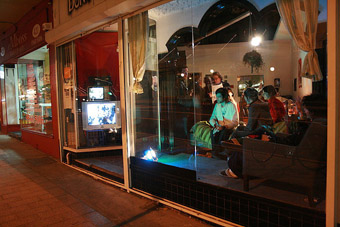
Dulwich Hill DayZZZe, Matt Rochford in residence
courtesy the artist
Dulwich Hill DayZZZe, Matt Rochford in residence
AS WITH MANY CITIES, SYDNEY HAS A DEMARCATED INNERCITY CULTURAL ZONE: YOU GO BEYOND THIS AT YOUR OWN PERIL, EXPOSING YOURSELF TO THE HIDEOUS POSSIBILITY OF ART STARVATION IN SUBURBIA. UNTIL RECENTLY, THE WESTERN EDGE OF THIS ZONE FINISHED OFF AROUND MARRICKVILLE (UNLESS YOU GO ALL THE WAY TO THE CULTURAL RICHES OF BLACKTOWN, CAMPBELLTOWN, CASULA AND PARRAMATTA), BUT AS MORE ARTISTS MOVE FURTHER OUT TO FIND AFFORDABLE HOUSING AND STUDIOS IT SEEMS THAT THE PRESSURE IS MOUNTING ON THIS PERCEIVED BORDER, AND WITH THE ARRIVAL OF DON’T LOOK GALLERY, PERHAPS THE TIME HAS COME TO REDRAW THE MAP AND INCLUDE THAT NEXT LITTLE SUBURB, DULWICH HILL.
Greg Shapley started Don’t Look Gallery two and half years ago because he wanted to create a place for people, including himself, to exhibit that was inexpensive and accessible. A resident of Dulwich Hill, he realised that the commercial rents in the area were in fact reasonable, which has meant that he can keep the rates for artists reasonable too. What is perhaps most interesting about this venture is that Shapley designated the gallery to be specifically for new media work which he defines as “not just digital art…not just computer based art. It’s really anything that’s not defined as old media—so sculpture and painting are definitely out. Most photography would probably be out…Work that is not easily commodified would be my definition.”
Shapley also encourages artists to use the space as an opportunity for creative development: “People think that their exhibitions have to be final products by the time they get to the gallery. And I think people judge exhibitions like that too…people want to see a polished product for some reason, and I think that’s a shame. A work that has a way to go can get encouragement for artists from the viewers…We’ve had lots of people trying things out that they’ve taken elsewhere and worked on more and more. I think we’ve been a good starting point for artists.”
In the two and half years of its existence the gallery has presented a diverse selection of exhibitions and activities including a silent film festival, the robotics of Wade Marynowsky, an interactive audiovisual installation by Jessica Tyrrell, :the braille box: (RT82), a creative development and presentation by dancer Eleanor Brickhill and video artist Anne Walton; a group exhibition from 16 international artists from a winter residence in Halifax, Nova Scotia; and a durational performance by Matt Rochford (‘Rochy’ from the reality TV show Nerds FC) who lived in the shop window for 3 weeks.
The gallery also provides a focus for many of the local artists in the area. There is even the 2203 collective (titled from the postcode of Dulwich Hill), made up of Alexis Armytage, David Urquhart, Frank Jones, Irit Pollak, Jacqueline Olivetti and Matt Rochford who have contributed a variety of exhibitions of their own work but also engagements with the community such as the Howdy Neighbor exhibition of sound and video recordings and photographs documenting some of the local identities of the area.
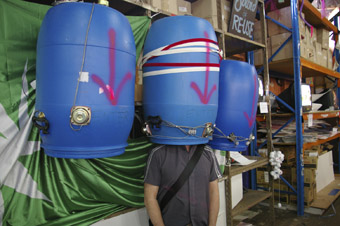
Max must we use the cone of silence, I don’t think its working properly, Ian Andrew’s work in the Sound of Re-use, Reverse Garbage, as part ot The Sound of Failure
photo Neil Jenkins
Max must we use the cone of silence, I don’t think its working properly, Ian Andrew’s work in the Sound of Re-use, Reverse Garbage, as part ot The Sound of Failure
Another important contribution is Shapley’s The Sound of Failure festival which began in 2007. By last year the event had already grown to a multi-sited event with installations not only at Don’t Look but also at the Chrissie Cotter Gallery and Reverse Garbage and a major concert night at The Factory (all local-ish venues); a closing party at the Hollywood Hotel in Surry Hills; a workshop collaboration with UTS; and a sound picnic!
The curatorial premise of the festival is to explore “organised and indeterminate music/sound/noise as conceived and experienced in this, our post-digital era.” This is a pretty broad ambit that could be used to describe any number of current events but it is perhaps the sense of inclusiveness that defines the event. Shapley says: “I would actually like to see the Sound of Failure taking on a broader genre…including instrumental experimental music and experimental sound.” He’s interested in breaking down the division between what might be perceived as the contemporary classical camp and the electronic and digital end of the experimental sound and music spectrum. He also sees the emphasis on presenting local artists and having an almost 50/50 split of performance and installation setting the Sound of Failure apart. The last two festivals have been primarily self-funded (with a little help from Marrickville Council), however Shapley is hoping for further funding to continue the event. Meanwhile, all the activities of the gallery to date have been self/artist funded.
A new addition to the 2009 program is a performance series on every second Sunday night. Shapley said that from the call for proposals for this year there was a strong interest in performance events, and the program is already filling up with local artists as well as international and interstate visitors such as Mike Cooper, Tom Hall and Jason Sweeney.
Greg Shapley is also an artist himself with a background in both music composition and visual arts and at the time of my chat with him his video work, David Lynch’s Hands, was on exhibition. Across three monitors, Shapley has created a collage of the idiosyncratic hand movements of the famous director which, if you have watched the extras on any David Lynch DVD, you will not have been able to ignore. His hands take on a life of their own, fluttering, flicking, articulating…perhaps even more than the man himself. These play in a loop across the screens taking on different rhythms and mini-narratives. The video work is aptly accompanied by a soundscape of four Casiotones set to a selection of cheesy rhythm sections, each slightly out of sync, which Shapley hopes creates a kind of “phase minimalism.” As you wander down busy New Canterbury Road, past the perfectly preserved old Greek barber shop (a very special sight in itself), the bleeps and buzzes emanating from a strange, darkened shopfront are a perfect invitation to the curious to check out just what is happening at Don’t Look Gallery.
Don’t Look Gallery, director, curator Greg Shapley, 419 New Canterbury Rd Dulwich Hill, Sydney, www.myspace.com/dontlookgallery
RealTime issue #90 April-May 2009 pg. 26
© Gail Priest; for permission to reproduce apply to realtime@realtimearts.net
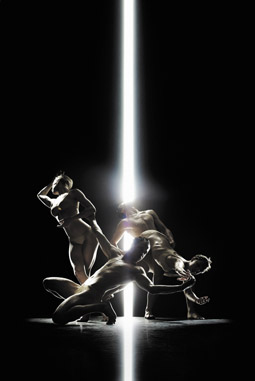
We Unfold, Sydney Dance Company
photo Tim Richardson
We Unfold, Sydney Dance Company
RAFAEL BONACHELA, ARTISTIC DIRECTOR OF THE SYDNEY DANCE COMPANY, EXUDES THE KIND OF ENTHUSIASM AND ENERGY THAT IS INFECTIOUS. HE IS FULL OF NEW IDEAS AND PLANS, WHICH WILL NOT ONLY IMPACT ON THE COMPANY ITSELF BUT ALSO, TO SOME EXTENT, ON THE DANCE COMMUNITY AT LARGE. SO, HOW DO THE CHANGES HE IS GOING TO IMPLEMENT SIT IN RELATION TO WHAT HAS GONE BEFORE HIM? BONACHELA DOESN’T MISS A BEAT. HE EXPRESSES RESPECT FOR THE ACHIEVEMENTS OF WHAT HE CALLS THE OLD SYDNEY DANCE COMPANY, UNDER THE DIRECTION OF GRAEME MURPHY AND JANET VERNON, BUT INSISTS THEY ARE NOT HIS REFERENCE POINTS. HE DOES NOT FEEL TIED TO A LEGACY BUT KEEPS HIS EYES FIRMLY ON THE VISION HE HAS FOR THE COMPANY UNDER HIS OWN DIRECTORSHIP—THE NEW SYDNEY DANCE COMPANY.
Born in Barcelona, Bonachela trained at the London Studio Centre and danced with Spanish company Lanonima Imperial before joining the Rambert Dance Company in 1992. A company member for the next 12 years, he started creating choreographic works for Rambert in 1998 and continued to do so until 2003 when he was appointed Associate Choreographer, holding that position for two years. Now best known for works with an artistically innovative approach, often fusing multiple artforms while retaining an appeal for larger audiences, Bonachela early on straddled the artistic and commercial dance sectors.
working with kylie
In 2002, he was commissioned to choreograph a routine for Kylie Minogue at the Brit Awards. It was a resounding success and he went on to choreograph Minogue’s Fever tour. While some artists might worry about losing their artistic integrity when working commercially, Bonachela has no such qualms. On the contrary, he says he welcomed the opportunity to collaborate with Minogue and the challenge it brought to work outside of his comfort zone. For the tour, he had to get used to directing large teams, juggling the interests of numerous stakeholders and working incredibly fast. When he returned to choreograph for Rambert, he felt he had grown as an artist and was much more confident in his choreographic vision and in his ability to communicate with his dancers.
a not so double life
In addition to his role as artistic director of Sydney Dance Company, Bonachela maintains his own small company, the Bonachela Dance Company, based at the South Bank Centre in London. How is he going to negotiate simultaneously directing two companies on opposite sides of the world? Bonachela is not worried. His own company is project-based, he explains, not constantly requiring his attention. Employed on a three-year contract, he makes it clear that being director of Sydney Dance Company is his full-time job and will increasingly become his priority. For the time being, though, he has an agreement with Sydney Dance’s Board of Directors allowing him to work outside as long as there are no clashes with the company schedule.
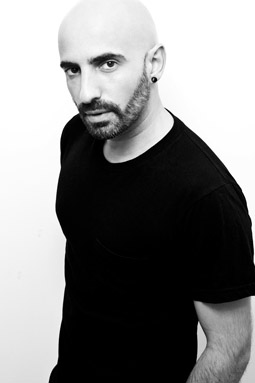
Rafael Bonachela
photo Ione Saizar
Rafael Bonachela
commissioning choreographers
It is no surprise then to hear that being able to make his own work was not the factor that attracted Bonachela to the job at the helm of Sydney Dance. As the director of his own company and sought after by both leading contemporary dance companies and commercial clients, he had no shortage of choreographic work. What interested him most about the coveted job as Sydney Dance’s artistic director was the opportunity to be in a position to commission other choreographers, both international and local, and to introduce their work to Australian audiences. He is convinced that this incentive will also benefit the dancers of the company, ensuring their artistic development by continuously being challenged and provoked by the different approaches of various choreographers. With the program for his first season at Sydney Dance Company, Bonachela puts his money where his mouth is. It not only features a new full-length work by well-respected Finnish choreographer Kenneth Kvarnstrom, but also continues the Overture Series, conceived last year as a platform for independent and emerging Australian choreographers to create and refine their work before Sydney Dance Company’s established audiences.
a new bonachela work
The season opener, due to premiere at the end of March, however, is a new work by Bonachela himself. We Unfold is its title and, after last year’s 360°, it’s his second work for the company, the first as its artistic director. Set to a symphony by Italian composer Ezio Bosso, We Unfold features a video installation by filmmaker Daniel Askill and costumes by his designer brother Jordan.
The conceptual starting point for the new work was to look at the need to slowly reveal oneself to others and the discoveries, both individual and collective, made along the way. The premise mirrors the situation Bonachela and his dancers find themselves in. With several new dancers joining the company this season, they are all part of a process of getting to know each other and developing a way of working together. Evidence that the process is already taking shape was revealed in the 25-minute section of We Unfold that I saw in rehearsal in early March, four weeks out from the opening. Against the aural sweep of Bosso’s emotional score, the dancers perform Bonachela’s intricate choreography with concentration and commitment. Sections have the entire company weave around each other, swirling across the stage, in contrast with more intimate quartets, trios, duets and solos, exploring various ways of relating—tender, determined, forceful. The movement clearly draws on the dancers’ idiosyncracies, distilled through processes of improvisation during the early stages of rehearsal.
making the future
It’s almost an understatement to say that Sydney Dance Company has had a turbulent last few years. These were financial problems, controversy over funding, the resignation of founder and long-time director Graeme Murphy and the sudden death of new artistic director-designate Tanja Liedtke in a road accident. Last year’s season, put together by executive director Noel Staunton and featuring works by Meryl Tankard, Bonachela and Aszure Barton, brought some success but couldn’t conceal the fact that it had been almost four years since the presentation of a new full-length work by the company’s artistic director. Bonachela is expected to rebuild audiences and develop a new identity for the company. Audience development, in that respect, is an important issue and measures to boost the visibility of the company have been stepped up. A presentation of excerpts from 360° at the Sydney Festival First Night in front of an estimated crowd of 250,000 in Martin Place was followed by an appearance on the ever-popular So You Think You Can Dance. There will also be extensive touring this year, both of Bonachela’s 360° and Aszure Barton’s Sid’s Waltzing Masquerade.
And how does Bonachela cope with the expectations placed on him? If he feels any pressure, he certainly doesn’t show it. He appears to have boundless energy, thriving on what’s going on around him. On the day we spoke I witnessed him switching seamlessly between instructing dancers, consulting with the designers and his assistant, signing a document for someone in administration and chatting to a team from Foxtel making a documentary about him. He remains focused and friendly, almost joyous, at all times. There is a sense of fearlessness about Rafael Bonachela that gives you the impression he might just pull this off. It’s a fearlessness anchored in the confidence derived from past successes and a commitment to moving forwards with curiosity and determination, embracing challenge and opportunity. It’s a potent combination that just might prove to be a winning one.
Sydney Dance Company, we unfold, choreography & concept Rafael Bonachela, Sydney Theatre, March 27-April 11; www.sydneydancecompany.com
RealTime issue #90 April-May 2009 pg. 37
© Martin del Amo; for permission to reproduce apply to realtime@realtimearts.net
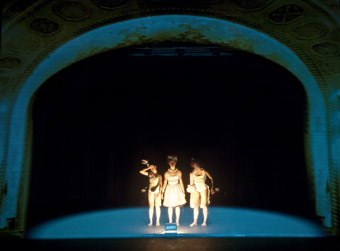
Mia Hollingworth, Carlee Mellow, Clair Peters, Out of Light
photo Sylvia Kreinberg
Mia Hollingworth, Carlee Mellow, Clair Peters, Out of Light
OUT OF LIGHT IS A DREAM OF A PERFORMANCE AS DREAMT BY THE DANCER. NOT A DANCE TO SHOCK OR AMUSE, INSTEAD IT’S AN ELUSIVE ONE THAT PLAYS WITH PERCEPTION, ONE THAT LOOKS AND FEELS LIKE A TANTALISINGLY DISTANT MEMORY OF ITSELF: CONFUSED SERIAL ORDERING, BLEEDING SOUND AND IMAGE, VIEWING ANGLES ASKEW.
The bodies, sounds, light subtly but consistently disperse out of sync, swarm in and out of coherence. Carlee Mellow, Clair Peters and Mia Hollingworth fall out of rhythm and rejoin the movement arc. Cascading figments of feminine choreography are performed with clarity and focus, but then collapse into stretching exercises, long breaks in the wings, memory gaps. Mellow will dance in unison with her own shadow on the screen, dark, gigantic and precise, yet the two keep falling out of sync. A screen separates the dancers from the audience, creating horror-like, sublime remoteness. The imaginary surroundings rotate frivolously from a catalogue of 19th-century painted sets into a thick rain of falling roses; yet all, even the smoke effects, reveal themselves as mere projections.
Parker’s dance waxes lyrical on performers’ mysterious ability to reproduce complex sequences of information. ‘Body memory’ is a misguided term, for all archival memory is reliant upon the body. Our speech-privileging culture forgets that mnemocultures like the Sanskrit textual tradition or Aboriginal songlines rely primarily on the mnemonic potential of gesture and music to preserve knowledge. Every performance of such a mnemotext is a singular recreation ex novo, making mnemocultures perhaps more at ease with the fleeting, unstable nature of dance, the most ephemeral of arts. Taking it one step further, Parker explores the retrieval errors that occur as memories fade or morph, and residual marks, traces of the unavailable past come alive. Loose threads of possible narratives appear as the dancers perform a balletic pas de trois: Hollingworth and Peters with ornamented grace, Mellow with an almost masculine, heavy, streamlined simplicity. How have their paths diverged? Has one body unlearned its clichés?
Out of Light, kept together by a strong backbone of clarity and precision, never dissolves into impressionist muck. Amidst the conflicting lights, changing angles, confounding music cues, the three dancers pick up their moves with absolute intent. Tiredness creeps in, yet the body endures, the rhythm is preserved, the woman behind the choreography stands tall and victorious. Memory and desire are inseparable: the drive to preserve the past in the future, salvage creation from extinction, is an act of pure will. Parker sings praise to the strength that emerges within the freedom of unstructured memory.
Building up the precision of learned movement, never succumbing to approaching fatigue, bodies tortured ever closer into structured, perfected violence, the piece is suddenly dramaturgically transformed by the unexpected addition of fairy costumes, classical movement and an entire baroque proscenium arch. The playfulness is gone, and what remains is children’s ballet, infused with gentle mutual correction, elbows raised, arms outstretched, until the three infantilised girl-princesses manage to correct and straighten each other into stern, stoic Victorian dolls, unable to do anything more than stare—finite, immobile and proper—into the audience, while the warm light gently dims.
Out of Light, direction, choreography Sandra Parker, dancers Mia Hollingworth, Carlee Mellow, Clair Peters, lighting design Jenny Hector, projection design Rhian Hinkley, composer Steven Heather; Gasworks Arts Park, Melbourne, Feb 26-Mar 7
RealTime issue #90 April-May 2009 pg. 38
© Jana Perkovic; for permission to reproduce apply to realtime@realtimearts.net
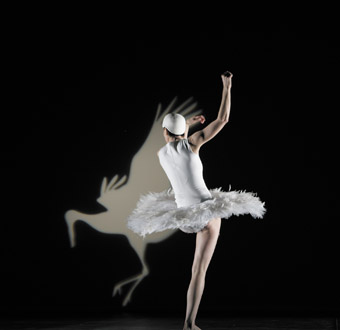
Ros Warby, Monumental
photo Jeff Busby
Ros Warby, Monumental
ROS WARBY IS WITHOUT DOUBT ONE OF AUSTRALIA’S MOST IDIOSYNCRATIC DANCERS. HER CREATIONS CONVEY AN INTENSE SERIOUSNESS INFUSED WITH DROLL WIT AND FLASHES OF SILLINESS. THE TOTALITY OF HER LATEST WORK, MONUMENTAL, IS NOT EASY TO SUMMARISE BUT IT COMPRISES A MAGICAL, HUGELY SUGGESTIVE UNITY THROUGH THE INTERPLAY OF DANCE, PROJECTIONS AND A CELLO-BASED SCORE.
Margie Medlin’s projections generate the performing space for Monumental, a place both intimate and, yes, monumental, filled with black and white archival film images—close-ups of individual birds and vast, sweeping flocks of them. The age of the films suggests an earlier time, as does the first appearance of Warby as ballet dancer, rather child-like in tutu, as does the inherently reflective melancholy of Helen Mountford’s recorded cello.
What follows is a very lateral series of transformations: from Warby in ballet whites to Warby in stylish, dark-side blacks; from onstage performer to shadow dancer; to Warby dancing with video Warby; to Warby as off-kilter mock-marching pre-20th century soldier shouting out gruff French-ish instructions; to Warby as dancer-cum-bird. Throughout, the cello changes mood, from lyrical to pulsingly minimalist to stridently orchestral and then elegiac as dancer and bird images begin to fuse.
Warby’s distinctive physiognomy lends itself to juxtaposition with a beautiful close-up image of an owl. Staccato moves in her choreography likewise heighten the connection, suggesting our deep kinship with other species. The anti-gravitational appeal of dance is, of course, like our dream of flight and winged selves, but here the embodied connection goes deeper. The audience become birdwatchers who, by way of Warby-Medlin-Mountford alchemy, suddenly sense not only the dancer’s ‘birdness’, but also their own, and, as they cast their minds back to Monumental’s opening image, the birdness (and not just swans) of ballet. Meanwhile the interpolated world of shouted orders and marching bizarrely parodies the soldier figure in classical ballet, here a wounded containment of dance, a restriction of all that sings, flies and flows.
–
Monumental, conceived, directed, choreographed, performed by Ros Warby, lighting, projection, design Margie Medlin, music Helen Mountford; Performance Space, CarriageWorks, Sydney, Feb 19-21
RealTime issue #90 April-May 2009 pg. 38
© Keith Gallasch; for permission to reproduce apply to realtime@realtimearts.net
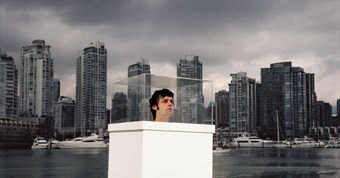
Promotional image, Radix Theatre, Assembly
courtesy the artists
Promotional image, Radix Theatre, Assembly
YOU’VE ARRIVED IN YOGA LAND WHERE SELF-ACTUALISED SPIRITUAL SEEKERS FREQUENT WESTSIDE CAFES AND BEACHES, THEIR UNLEASHED DOGS GENTLY PATROLLING THE OUTER LIMITS OF THEIR EXPANSIVE PASTEL AURAS; PAY NO ATTENTION TO THE JUNKIES AND THE HOMELESS ACROSS TOWN.
Let me restate that from across town: you’ve arrived in crack alley where crystal meth and heroin flow like an open sewer at Canada’s largest street market for illicit drugs; pay no attention to the spiritual seekers except when they drive by looking for a fix. Vancouver is both the yoga capital of Canada and home to the nation’s poorest urban neighbourhood, the downtown eastside (DES).
In many ways middle-class Vancouverites—due to a mix of guilt, fear, and curiosity—use the DES as a badge of authenticity. The neighbourhood confers both grit and compassion: “We care”, our yuppies might say, “Look at the needle exchange programs and look at Insite, North America’s first safe injection site.”
crime and punishment
Many of Vancouver’s innovative theatre companies also like to wear this badge. Several have created work in which the DES is a major focus, as in the 2005 adaptation of Dostoyevsky’s Crime and Punishment. The show was the culmination of years of collaborative work by DES community members, Vancouver Moving Theatre and director James Fagan Tait. Over the years they put on a number of large-cast productions featuring predominantly untrained performers from the neighbourhood. In 2005 they joined with Neworld Theatre and the PuSh Festival to create Crime and Punishment, a watershed production in the local scene. The adaptation featured three musicians and 21 actors (a cast size unheard of due to the usual budget constraints), four of them untrained performers from the DES. In the process, Tait drew upon well-established European theatre traditions going back to Meyerhold and Reinhardt, with a nod or two to more recent phenomena like Les Mis. A beautifully stripped-down musical score composed by Joelysa Pankanea for marimba, violin and double bass held together the choral work—sung, chanted or spoken in unison.
While the kind of critical distance advocated in Brechtian acting theory was well represented, the direct-address delivery of 21 performers calmly stating in unison, “You are walking down the street”, had such force that spectators were drawn into identification—not so much with individual characters (although that was part of it) but with a community of diverse performers. The dominant tendency to equate realism with truth in North American theatre was replaced by the hyper-realism of foregrounding the actor body—nothing as extreme as Romeo Castelluci’s Giulio Cesare in which the female parts are played by two emaciated women suffering from bulimia, and in which Antonius (Mark Antony) is played by a man with no larynx who can only growl through his throat into a microphone. But the goal was not to alienate, it never is in Vancouver theatre, which is always haunted by New Age spiritualism, even when trying to face the grim realities of a class structure we don’t talk about.
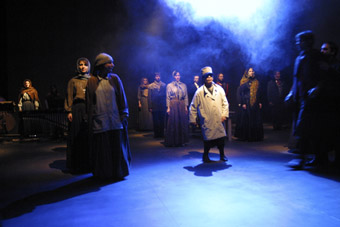
Crime & Punishment, Neworld Theatre
photo Tim Matheson
Crime & Punishment, Neworld Theatre
It was Tait’s treatment of the performers’ bodies that anchored Dostoyevsky’s 19th-century novel in the here-and-now of Vancouver. Dramaturg DD Kugler probably put it best when he said he felt he was seeing, for the first time, a cross-section of the city on stage. Others (mostly from the large regional theatre crowd) argued that it was the polish of the professional actors that kept the show together. My personal view is that the material and spiritual struggle of the novel was best embodied by Steve Lytton, an intense actor from the community who always held the downstage centre spot when the chorus of 21 got into position. Lytton suffers cerebral palsy; as a result his right leg lags behind his left. When the chorus entered, the first thing heard was Lytton’s walk. This actor’s particular physicality, matched with the riveting intensity of his performance (itself influenced by the effort it took him to get from point A to B), made it hard to get lost in the fiction. You couldn’t completely lose sight of this performer’s body. In this sense there is, indeed, overlap between Tait’s unsettling of the actor-character relationship in Crime and Punishment and Castellucci’s in Giulio Cesare.
In foregrounding the performers’ bodies, Tait was able to set up a tension between the actors and their fictional referents. The spectator suffered, or enjoyed, a double vision: 19th-century St Petersburg slum and 21st-century Pacific Coast city. In foregrounding the actual, Tait sought an authenticity of body that is unique because it is local, and because the uniqueness of each performance denies the possibility of using an analogous mix of professional and community actors in another city to replicate the event conditions.
assembly
This February I directed Nanay, a testimonial play about Filipino domestic workers in Canada, for Urban Crawl at the PuSh Festival. It was performed at the Chapel Arts Center, a former funeral home situated right in the heart of the DES. In attendance was a German presenter who told me that in Nanay she felt she was seeing Vancouver on stage at the festival for the first time. I failed to ask her what exactly she meant by that. Upon reflection I wonder if it was the fact that it featured Filipino-Canadian actors encountered in gritty settings? Or was it the unusually high number of Filipinos in attendance at a theatre event? Finally, was it simply the geographical location of the venue? I recommended the German presenter check out Radix Theatre’s Assembly. She had, and didn’t feel there was anything particularly local about it. I had to disagree.
Assembly is the quintessence of New Age Vancouver, albeit approached with an eye for parody. The show was sited in a hotel conference room, the kind of place you go to for a self-help seminar. This was, in fact, the conceit. For the first half of the show an interactive seminar took place in which the spectators were encouraged to openly express their unfulfiled desires. Seminar leadership by the Radix team eventually broke down and the spectators became witness to some very uncomfortable personal confessions. Partly scripted, partly improvised, the performers wove autobiography with fiction. The biographical parts gave an air of authenticity to the performances; in fact, with most of the ‘testimony’ it was impossible to tell fact from fiction.
When the confessions became just a little too raw, the spectators were led into another room, where they were confronted with surrealistic images of actors’ heads in glass boxes, seemingly random videos, naked actors on slabs in front of projected beach scenes, and a monologue about time traveling molecules. Here Radix was returning to one of its recurring preoccupations: the body’s relationship to constructed spaces.
In the past Radix has used the DES as an architectural palette. The concern here has not been with the neighbourhood bodies themselves, but with how bodies shape, and are shaped by, architecture. In Assembly, Radix made a departure (not necessarily for the first time) from the architectural imprint of the DES, with its tendency to fracture identity, and fully confronted the New Age spiritualist’s yearning for wholeness. Bucking postmodernist insistence on fragmentation, artistic directors Andrew Laurenson and Paul Ternes consciously made a show about “getting together.” They did so by setting up the logic of a self-help seminar, debunking notions of success that go with it, throwing the spectator into a surrealistic world which defies navigation by rationalist compass and, finally, by the simple act of having the performers tell stories of personal significance to spectators in an intimate, candle-lit setting. They accessed Yoga Land’s promises of spiritual wholeness, while putting into question its claims and methods.
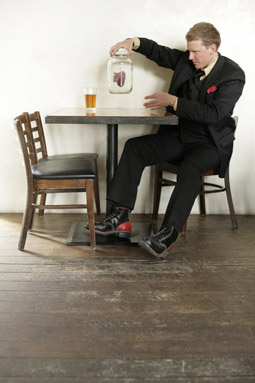
David McIntosh, Battery Opera, Lives Were Around Me
courtesy the artists
David McIntosh, Battery Opera, Lives Were Around Me
lives were around me
In January, Battery Opera charted Eastside geography with a very intimate guided tour called Lives Were Around Me. Battery Opera is a dance/theatre company that sometimes blends disciplines and sometimes keeps them apart. In Lives (a theatre piece) an audience of four was guided through the streets and into a local pub. The voyeuristic distance a spectator typically enjoys in a theatre setting was hard to maintain in these circumstances. Rachel Scott, a Plank Magazine reviewer, described the pub as “a dingy watering hole” in which a drunk female patron shouted “why do you people keep coming into our bar?” . Because of the explicit framing of the show, the neighbourhood was theatricalised: the denizens became unscripted characters (in the eyes of the ‘tourists’).
Battery Opera’s mandate is to interrogate “the contemporary body as a site of intersecting and displaced histories.” On this tour the spectator body intersected with the neighbourhood-resident body provoking uneasy negotiations. The spectator’s experience is partly mediated by an actor-guide who speaks excerpts from James Kelman’s novel, Translated Accounts, an opaque chronicle that provides a parallel story. In the novel the narrator describes walking through a port city that has passed its prime, something that could be said of the DES which was once the commercial centre of the city. Scott felt it was her own body that became the site of intersection: “My body was the landscape upon which the Eastside and Kelman’s narrative could meet.”
And so we’re back to bodies, the preoccupation of so much postmodern performance; Westside and Eastside bodies, performed or performative, bodies that stake their claim to authenticity because they live in the DES or because they’ve brushed up against it; and sometimes, as in Crime and Punishment, bodies that put themselves downstage centre in a mainstream production. I’m not sure if it’s a stand off. The two sides of the city seem to be trying to talk to each other. The theatre companies mentioned above, as well as others, have all offered their work as sites for dialogue. But in many ways Yoga Land is still setting the terms of reference. It would be interesting to see a version of Lives Were Around Me created by DES residents, with the guides taking their neighbours on a tour through the Westside, inverting the subject-object relationship; in effect, turning their wealthier counterparts into art objects to be studied. Now that would be an interesting exploration of who’s representing whom. On the other hand, these innovative theatre companies have at least tried to provide a place for the city’s two halves to come together. To, you know, get their auras talking. Or do I mean to get them sharing a pipe?
Neworld Theatre/PuSh co-production, with Vancouver Moving Theatre, Crime & Punishment, Roundhouse Community Theatre, Jan 27-Feb 6, 2005, http://vancouvermovingtheatre.com, www.neworldtheatre.com; Radix Theatre, Assembly, conceived by Andrew Laurenson, Paul Ternes, director Paul Ternes, Granville Island Hotel, Vancouver, PuSh Festival, Feb 4-8, www.radixtheatre.org; Battery Opera, Lives Were Around Me, conceived, directed and hosted by David McIntosh, Jan 13-24, www.batteryopera.com
This article is the first of series on contemporary performance, innovative theatre and dance in Vancouver.
RealTime issue #90 April-May 2009 pg. 39
© Alex Ferguson; for permission to reproduce apply to realtime@realtimearts.net
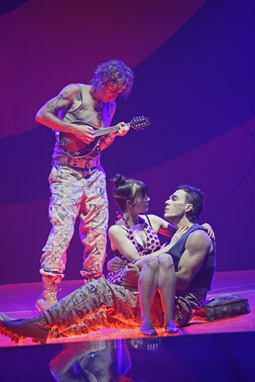
Tim Rogers, Bojana Novakovic, Socratis Otto, Woyzeck
photo Jeff Busby
Tim Rogers, Bojana Novakovic, Socratis Otto, Woyzeck
BUCHNER’S WOYZECK IS ONE OF THOSE WORKS THAT SIMPLY CAN’T BE DONE PROPERLY—NOT THAT IT CAN’T BE DONE WELL, BUT ITS VERY NATURE AND FORM DEMANDS THAT EVERY PRODUCTION IS AN OBVIOUS INTERPRETATION. IF THERE ARE CERTAIN PLAYS THAT ACTORS LONG TO HAVE A CRACK AT—FROM YOUR HAMLETS TO YOUR WHO’S AFRAID OF VIRGINIA WOOLFS—WOYZECK IS THE ONE THAT DIRECTORS DREAM OF.
But for all their variety, most versions of the notoriously open work have several things in common. Firstly, there’s a tendency to psychologise the central, murderous protagonist, making the play a “why did he do it?” investigation. Secondly, the roles of repressive social institutions (the military, the medical establishment) are highlighted as particularly modern problems which directly influence the tragic course of events. And finally, Woyzeck himself is consistently portrayed as a tormented wretch, a man who commits an unspeakable deed but must ultimately be understood, if not forgiven.
Michael Kantor’s recent Malthouse Theatre production was notable for avoiding these clichés: instead of a work of psychological realism, he gave us a piece of carnivalesque theatre that never explained itself or its characters. Like an out-of-control merry-go-round, it was populated by figures that were either gross caricatures or strangely flat. Woyzeck himself was less a man descending into a maelstrom of madness than an unfathomable abyss whose motives were never clear.
Kantor has long displayed a fascination with live music as both a symptom of performance’s immediacy and as a reaching towards the sublime power of the non-narrative. It’s obvious then why he has chosen this Icelandic adaptation of Woyzeck, complete with a stunning score by Nick Cave and Warren Ellis. If Büchner’s play is one of the first works of modern theatre, Kantor’s production is a postmodern take on a classic, in which insanity is not pathologised—indeed, that tendency is uncomfortably close to the medical world the work critiques. Instead, madness inhabits every moment of this piece, which itself seems inexplicable.
Musician Tim Rogers is the unequivocal star, playing a Mephistophelean angel of death with brilliant confidence. It’s unnerving to witness an accomplished musician’s command of the stage—intuitive, spontaneous, receptive to audience cues—in contrast to the well-trained and actorly performances of the more classically educated players. Socratis Otto in the titular role doesn’t really do an awful lot; Mickey-Mouse-eared Mitchell Butel offers cartoonish mania and leaves it at that. Only Bojana Novakovic gives a genuinely empathetic performance as Woyzeck’s doomed wife, with a stirring song that forms the highlight of the work. But praising an actor’s convincing performance in a production that is more giddy irrealism than seductive naturalism seems odd.
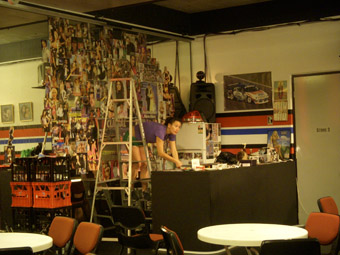
Fake Porno, Ride On Theatre
photo Bojana Novakovic
Fake Porno, Ride On Theatre
ride on theatre, fake porno
When not taking to the stage herself, Novakovic has also been building a profile as a director of note. Her Ride On Theatre, co-founded with Sydney-based Tanya Goldberg, has produced a small body of work to consistently positive reviews. Fake Porno is Novakovic’s original translation of a Serbian work and a few Melburnians were fortunate enough to catch a one-off performance held as a benefit to take the work to Brisbane (staged just a few days before Woyzeck opened).
Fake Porno delivers an urgent, unsettling vision of contemporary Serbia—a series of monologues linked by a taxi driver whose own story ends up horrifically twisting our earlier sympathies. The actors here are simply outstanding—Peta Sergeant’s oversexed, gangsta hip-hop-obsessed teen is one of the most overpoweringly visceral performances I’ve seen, while Black Lung regular Dylan Young provides the work’s most moving moment as a bride standing atop a city building addressing his lost love through a megaphone. And underneath the trappings of kitschy turbofolk music, Western trash and cheap bling, Fake Porno is really all about lost love, loneliness, and the emptiness at the heart of Today. Young’s drag bride pleading into the deaf void is about as potent an image of contemporary life as I can imagine.
talya chalef, eyton road
Talya Chalef is another theatremaker whose concerns are not limited to the local. Her Eyton Road spans the 20th century and several continents, drawing on personal history to explore themes of displacement, diaspora and social memory. In some ways this is territory already well-trodden: questioning the notion of “home” was a mainstay of university campuses and independent theatre throughout the 90s. But Eyton Road displays enough innovation to keep things fresh: Chalef and fellow performer Andrew Gray build a house of cards upon which is projected footage of places half-remembered, but the instability of the construction (which collapsed more than once) was a subtle yet effective hint at the fragility of any sense of home. Eyton Road isn’t the most focused of works but, like her previous In Other Words, suggests that Chalef will be worth keeping an eye on.
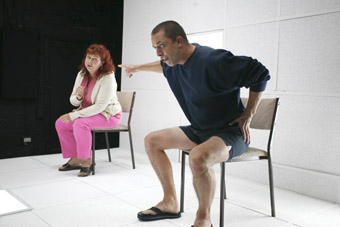
Angus Cerini, Susie Dee, Wretch
photo Ponch Hawkes
Angus Cerini, Susie Dee, Wretch
angus cerini, wretch
Angus Cerini’s Wretch left me a little speechless—I’ve known Angus Cerini for a decade, at least, and we’ve shared a stage on a few occasions. Wretch feels like the culmination of all of his work so far, as well as connoting a stellar leap in his ability as a writer. The piece follows a young man in prison visited by his mother, detailing the hopelessness and failures each have experienced and which have led to his senseless crimes. In lesser hands, it might have been soap opera stuff, but here Cerini delivers soap as if envisioned by Anthony Burgess and articulated by James Joyce. Though the two performers—Cerini and co-director Susie Dee—are almost entirely confined to chairs for the show’s duration, their language is choreographic virtuosity. Cerini serves up these lives with words that move from ocker realism to Byronic splendour to impenetrable gutterisms in a single breath.
It’s difficult to summarise Wretch, since it’s an experience both dependent on brilliant wordsmithing and entirely beyond language—an impactful, passionate address that defies easy interpretation. I’d like to see Angus Cerini beat this one.
elbow room, there
All of these works have provided diverse, fascinating alternatives to psycho-realism while nonetheless maintaining an essential link to ‘reality’, however you wish to define that troubled term. Elbow Room’s There, on the other hand, is really something else. I first saw this piece in the Melbourne Fringe Festival and had a return visit during the Adelaide Fringe. As I exited this second viewing, I muttered something to the effect that it was pretty much my perfect piece of performance. I stand by that view—it might not be for everyone, but it’s the kind of show I could watch again and again.
The less you know about this piece the better. It begins in darkness, before a torch-lit pair of fingers finds itself on a foot-square stage from which it cannot escape. From here, performers Emily Tomlins and Angus Grant produce an enchanting series of scenes, each of which is like a cinematic zoom-out revealing a new layer of reality. It’s simultaneously an ontology of theatre, a self-reflexive history of performance and a laugh-out-loud joke. Here is where the actors are, and there is where you are. That’s all you need to know. Aside from the fact that, as every audience member should know, being There is brilliant.
Malthouse Theatre, Woyzeck, writer George Büchner, adaptation Gisli Örn Gardarsson, director Michael Kantor, performers Mitchell Butel, Marco Chiappi, Hamish Michael, Bojana Novakovic, Socratis Otto, Merfyn Owen, Tim Rogers, music Nick Cave, Warren Ellis, design Peter Corrigan, musical director Peter Farnan, lighting Paul Jackson, Malthouse, Jan 31-Feb 28 ; Ride On Theatre, Fake Porno, director Bojana Novakovic, producer Pia Johnson, translated & adapted by Bojana Novakovic, performers Jim Daly, Daniel Frederiksen, Tomek Koman, Louise Quill, Peta Sergeant, Katherine Hicks, Hallie Shellam, Wazzadeeno Wharton-Thomas, Dylan Young, Lupa Art, July 28-Aug 9; Eyton Road, by Talya Chalef, Andrew Gray, co-collaborator Domenico de Clario, dramaturg Kelly Somes, lighting Bronwyn Pringle, sound Jared Davis, La Mama Theatre, Feb 4-15; Wretch, writer Angus Cerini, director-performers Angus Cerini, Susie Dee, design Marg Horwell, sound Kelly Ryall, lighting Richard Vabre, La Mama Theatre, Feb 19-March 8; Elbow Room, There, director Marcel Dorney, performers Emily Tomlins, Angus Grant, Adelaide Fringe, Garden of Unearthly Delights, Feb 20-March 21
RealTime issue #90 April-May 2009 pg. 40
© John Bailey; for permission to reproduce apply to realtime@realtimearts.net
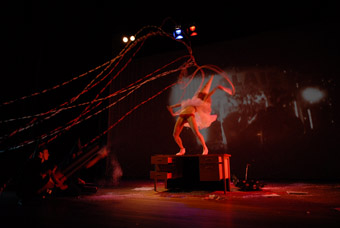
Annabel Lines; Dunce Vignettes, Quick and Dirty
photo Alex Davies
Annabel Lines; Dunce Vignettes, Quick and Dirty
LAST YEAR’S QUICK & DIRTY, OF WHICH I WAS ONE OF MANY CURATORS AND ARTISTS, RECEIVED MUCH PRAISE AND CRITICISM (see RT84). MOST OF THE LATTER WAS FOR THE EVENT’S PERCEIVED NOSTALGIA. IT DID REFER EXTENSIVELY TO THE HALCYON DAYS OF QUEER PERFORMANCE, BOTH IN THE REPRISAL OF PAST SHOWS AND MORE OBLIQUE REFERENCES TO THE WILD 90S. SOME WOULD ARGUE THIS WAS MANDATORY FOR THE RE-IGNITION OF QUEER CULTURE AT PERFORMANCE SPACE. THIS YEAR’S EVENT HAD A MORE CONTEMPORARY FOCUS. CURATED BY A MUCH SMALLER TEAM OF Q&D FOUNDER VICTORIA SPENCE WITH MAT HORNBY, MATT STEGH AND JUSTIN SHOULDER, IT FEATURED THE SAME LINE-UP OVER THREE NIGHTS, APART FROM A COUPLE OF GUEST APPEARANCES.
Most of the cathedral-like Carriageworks foyer was given over to the audience for So You Think You Can Dance, but the small Q&D area was teeming the moment doors opened. Acrobat trio Candy Stripe Circus (Craig Hull, Kate Reid, Martin Peacock), dressed as vaudie characters, did a light-hearted performance in tissues above the crowd. Pomegranates from Tehran had Y in chador smearing white sliced bread with pomegranate jam, walling himself into the corner with the bread slices or giving them to hungry audience members. Whilst the first performance didn’t hold up well to serious scrutiny, the pathos and subtle political commentary of the second was somewhat overwhelmed by its convivial environment. I think the risk in programming such work is well worth it, but if the venue can’t give Q&D more foyer space, then beginning the event earlier with an art show opening ambience might enable the audience to appreciate non-theatre space works more.
Cindy Pastel’s old school drag number—scabrous division—was entertaining enough but I wondered why it took place in the foyer on a purpose built stage, instead of in the theatre. On Friday in Pluto Savage’s vertical suspension, the artist’s body, in y-fronts, black stilettos and elaborate cosmetic mask, was dangled from hooks throughout interval. Savage’s intention to create an image that affronted mainstream gay culture was largely successful, the stained brickwork of the wall an ideal backdrop to his small white figure with stark black face and shoes.
Dean Walsh greeted the crowd entering the theatre with a stunning image. He stood naked over a bucket of drinking water, fluid running down and through his body. The Bends was a reflection on the place of art in society, using the analogy of water as 98% of the body. Close-ups of sea life gulped across the screen as Walsh danced a jerky hominid paen. The poetry of the piece was somewhat smothered by its verbal polemic. Then came Norrie May-Welby singing her way through the bleachers with a local rewrite of Walk on the Wild Side. The first verse was brilliant, May-Welby’s trademark bare feet completing the picture, but by the time she reached the stage she was singing the song virtually straight and it fizzled out.
The perfectly named Adonis is a punky, fleshy, brash new regular of alternative spaces. I was excited to see what she would do in a well equipped theatre. With her Leigh Bowery make-up skills, she looked amazing as ever, but the performance didn’t go far. She rubbed offal over herself, accompanied by projections of being smeared in tomato sauce. She lost her step and incorporated this into the show with comic flair, but then seemed to lose her nerve altogether.
Celia Curtis is one of the best artists to have evolved in the queer scene over the last decade, belying nostalgia for a 90s heyday. Her Picnic at Hanging Rock was a reprised club show, with all the grimy absurdist inventiveness of the genre in its foam rocks and black garbed ‘stagehand’ animating the wildlife. Curtis acted parts from the movie to hysterical effect, building to a climax that promised a solid kicking of Australiana, but the tussle with toys to Solid Rock fell flat.
George Tillianakis’s plangent Greek folk song straight after this mayhem was a jolt. I loved the song, and his insouciant exit with the cello still bowing, but I questioned the inclusion of this performance in a queer season. With no MC and a program without artist statements, bios and running order, I could only guess this was in fact Tillianakis. Wife closed this bracket with Waking the Beast, which I read as a sort of Arabic pagan invocation. Dressed in a black veil and orange beads, wrapping thread from giant spools around herself, Wife crossed herself, cunt included, then collapsed amidst the falling beads. An amazing visual feast—but maybe no more than that.
Frumpus opened the second bracket with a mash-up of signature themes: beauty myth, horror movie, ironic athletes. The donning of the Australian flag took me back to Curtis’ Picnic at Hanging Rock: another opportunity for political commentary again unfulfilled. But overall Cheryle Moore, Julie Vulcan, Rose Ertler and Stephanie Hart were compelling in their craziness. The video projections were just as deft, and perhaps the masterstroke of the night came with their segue into Drew Fairley’s superbly polished Hotel California. He had the audience eating out of his hand for every second of his pastel anthem—another reprise—and his schtick afterwards. He fed a craving that again suggested the event needed an MC.
Annabel Lines was the star act, her dunce an evolved spookier version of the clown character she has been exploring for some time. Before aerial views of a strange apocalyptic city, Lines skittered across the stage like a lost doll, contorted on a desk, got stuck in a snowstorm, then enclosed herself in a smoky pod. None of which conveys the sheer ingenuity of the work in terms of stagecraft and delivery. Here was a performer with a unique vision, her persona fully succumbing to dementia, her years of training and expert skills lightly worn.
Justin Shoulder’s Coels from Concrete Towers showcased possibly his best costume to date, the coel beautifully complemented by a tree skeleton, projections of black ink staining water and an eerie soundtrack. The coel was especially impressive in flight, horns/fingers jabbing aggressively, but Shoulder’s disrobing at the end was a bit ad hoc. Then came Kknopants with a she-devil scenario. With so many more performers out there than spots available, and seven on the bill who mysteriously didn’t appear, the underdeveloped Kknopants was another strange inclusion.
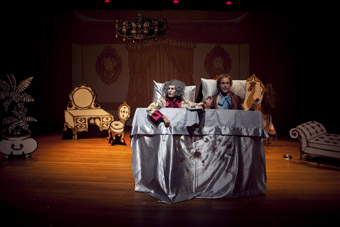
Dick & Dickie (Matts Hornby & Stegh), Quick & Dirty
photo Alex Davies
Dick & Dickie (Matts Hornby & Stegh), Quick & Dirty
The final show was Matts Hornby and Stegh with a reprise of Dickie and Dickie which I reviewed for RealTime as part of their brilliant U Little Stripper! (RT81, p34). The Matts took full advantage of the lush facilities with a comical overture wherein chandelier and other poofy objets d’art were installed by a hapless workman. The costumes and make-up were just as over the top, the repartee rejuvenated with gems like “$900 from Kevin oh Seven!”, “Ooh, scatter cushions!” But the final track overstated the hilarious visual gag of falling testicles, and the segue into a finale with all performers coming on stage detracted from the work’s trenchancy.
Criticism of Quick and Dirty from artists and audience alike was again vigorous: part communal ownership, part Australian self-deprecation? Queer seasons at the Performance Space struggle for survival in an environment bereft of funds, and queer anything is under pressure these days as an area of continuing relevance. However, that Q&D has sold out two years in a row and is being discussed with such urgency says something. And if Mardi Gras pays a Neighbours star thousands of dollars to perform at their party while turning a blind eye, as ever, to the coalface of local work, then a gauntlet has been laid down no matter what anyone says.
I craved more political commentary in Q&D, more extreme expression, more rawness and sophistication both. I wanted Norrie-May Welby to rewrite every verse of Walk on the Wild Side to full street-walking swagger; Shoulder to be more monstrous; Adonis to throw the offal at us; the Matts to throw more of themselves into their Dickies. Maybe then the audience would have let down their hair in a foyer fantastically decked out by the Matts and Marty Jay. Despite great music, the ambience was subdued. According to some, CarriageWorks is too imposing and bureaucratic a space for the intense Dionysian energy this sort of event needs. But wherever the gauntlet is thrown down will be most exciting and pertinent. And whether or not Q&D continues, queer performance must prevail.
Quick & Dirty, Performance Space, CarriageWorks, Feb 26-28
RealTime issue #90 April-May 2009 pg. 42
© Fiona McGregor; for permission to reproduce apply to realtime@realtimearts.net
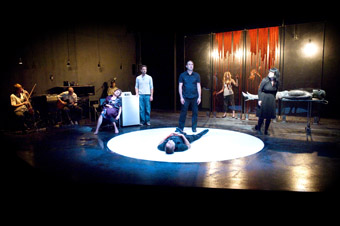
Antigone, Thinice
photo Nic Montagu
Antigone, Thinice
“ON THURSDAY 26TH FEBRUARY 2009, US DEFENCE SECRETARY ROBERT GATES ANNOUNCED THAT THE OBAMA ADMINISTRATION WAS LIFTING THE 18 YEAR BAN ON THE PHOTOGRAPHING OF FLAG-DRAPED CASKETS OF SOLDIERS KILLED IN THE IRAQ WAR. HOWEVER, THE FINAL DECISION TO RELEASE SUCH PHOTOS WOULD NOT BE MADE BY THE STATE DEPARTMENT. ‘MY CONCLUSION WAS WE SHOULD NOT PRESUME TO MAKE THE DECISION FOR THE FAMILIES’, SAID GATES. ‘WE SHOULD HONOR, NOT HIDE, FLAG-DRAPED COFFINS,’ SAID SEN. FRANK LAUTENBERG, D-N.J. ‘THEY ARE A SYMBOL OF THE RESPECT, HONOR AND DIGNITY THAT OUR FALLEN HEROES DESERVE’.” HUFFINGTON POST, 26 FEBRUARY, 2009
In the program notes for Thinice’s Perth International Arts Festival production of Sophocles’ Antigone, adapter Eamon Flack describes the play as “terrifyingly contemporary.” While acknowledging the textual complexity and instability of the play written in the 5th century BC and set in the Bronze Age of ancient Thebes, he signals a firm orientation towards the present. “I started searching for moments in the modern world that are like moments in the play”, he writes, citing Iraq, Kosovo, Palm Island, Iraq, women in war zones, public and political panic. But can theatre be other than contemporary? Antigone is a text burdened with translations and centuries of theatrical incarnations: Christian Antigone, Antigone the individualist, the feminist heroine, the exception to the rule; all such manifestations are contemporary at the time of their production, and flap about noisily in the wings of any new adaptation.
Thinice’s Antigone eschews direct reference to current events, choosing instead to signal its modernity not at the level of text, but through its directorial decisions. Befitting the modern moment, Matthew Lutton’s production is all sound and fury. The production opens with an interpolated prologue (from Oedipus Rex) in which Oedipus provides a context for the tragic events. Musicians sit to one side, singer Rachel Dease keens freely, Eurydice (Nicola Bartlett) slumps over a washing machine while her daughter carries out the ritual cleansing of the body of her brother, Eteokles.
When Antigone (Kate Mulvany) defies the order of her uncle Kreon (Colin Moody) that only Eteokles deserves the rights of sepulture and instead sets about burying the traitorous Polynices, audiences at the Subiaco Arts Centre would not be dissuaded of the idea that Antigone is a victim who stands clearly on the side of women and family, in opposition to Father or ‘State.’ But, as legal philosopher Bonnie Honig argues persuasively, what is played out in the ancient text is the struggle between two orders of law; between fidelity to family, blood and the old laws of the Homeric gods (signified in Antigone’s blind defiance of her uncle Kreon’s prohibition), and fidelity to the people, the polis, to the needs of the state and the emergent democracy, upheld blindly by Kreon (“Antigone’s Laments, Creon’s Grief: Mourning, Membership, and the Politics of Exception”, Political Theory, 2009). Both of these “economies of mourning”, argues Honig, are excessive and politically unstable. Ambiguity and lack lie on the side of both Antigone and her uncle, and while this ambiguity may have been suggested by the text of Lutton’s production of Antigone, the compression of action and the absence of space and silence on stage obscure any real examination of “limited right.”
In the Greek play, news of death is reported by messengers; true horror is unknowable, the rotting body haunting yet unrepresentable, and death is mediated by the slippery passage of language across the stage. Lutton chooses to situate the off-stage action onstage, placing events in front of the audience. In the final stages of the play we witness the suicides of Antigone and her betrothed Haemon through a wall of transparent glass behind which Antigone has been imprisoned. They die upstage, smeared in blood. Such is death in the contemporary world; Antigone and Haemon die deaths fit for celebrity—private deaths enacted in the public sphere of theatre. Kreon’s wife Eurydice, unable to bear her grief, removes her dressing gown and kills herself, like a suburban Sylvia Plath. While Kreon stands by in horror, we are free to feed on the modern tragedy, like paparazzi claiming to adore the invaded object.
The full house no doubt came away agreeing that stubborn pride and inflexible rule are no good for anyone, be it father, daughter, or Prime Minister; that you ignore good council at your own peril and that blood runs thicker than water. Most reasonable people would agree with President Obama that fallen soldiers should be mourned openly and given full honour. But what of the terrorist and the traitor? What of Polynices? What do we do with those who remain, in Judith Butler’s term, “ungrievable”? A terrifyingly contemporary question.
Perth International Arts Festival: Thinice productions, Antigone, writer Sophocles, adaptation Eamon Flack, director Matthew Lutton, performers Nicola Bartlett, Rachael Dease, Brendan Ewing, Colin Moody, Kate Mulvany, Samantha Murray, Gibson Nolte, Kingsley Reeve, composer, lyrics Rachael Dease, designer Bryan Woltjen, sound designer Kingsley Reeve, lighting Nick Higgins; Subiaco Arts Centre, Perth, Feb 21-March 7
RealTime issue #90 April-May 2009 pg. 43
© Josephine Wilson; for permission to reproduce apply to realtime@realtimearts.net
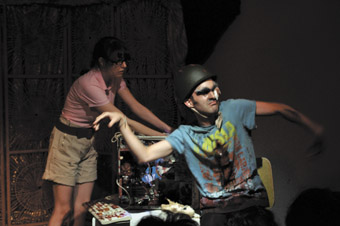
Kittenbone Bridge, Imperial Panda Festival
photo James Brown
Kittenbone Bridge, Imperial Panda Festival
IMPERIAL PANDA FESTIVAL IS A DIFFICULT BEAST TO CHARACTERISE, BUT IT HELPS AT THE OUTSET TO NOTE THAT THERE IS NOTHING IMPERIAL ABOUT IT, AND PANDAS FEATURE NOWHERE ON THE PROGRAM. THE NAME, IT SEEMS, IS CHOSEN MORE TO INDICATE THE SCOPE OF ITS AMBITIONS RATHER THAN THE NATURE OF ITS CONTENT. ALL THE SAME, IF YOU IMAGINE “THE IMPERIAL PANDA FESTIVAL” AS CONNOTING A SECRETIVE YET IMPORTANT CELEBRATION, CARRIED OUT FOR THE SOLEMN EDIFICATION OF A HIDDEN NOBILITY IN A LONG DEAD EMPIRE, YOU’RE PROBABLY HALFWAY TO UNDERSTANDING THE INTENT OF THE DIRECTORS (EDDIE SHARP, ZOE COOMBS-MARR, ROSIE FISHER, MISH GRIGOR) WHO INITIALLY WANTED TO SCHEDULE PERFORMANCES THAT HAD ALREADY TOURED TO SOME SUCCESS, BUT THAT SYDNEYSIDERS COULD NO LONGER SEE.
The secret and underground element was provided by the locations. Spread over five venues, it occurred across a cluster of the more important artist run spaces in Sydney, each one too small to house more than a single event. Finding the venues had a conspiratorial feel, like being initiated into a resistance movement that’s adopted a cellular structure. These are intimate spaces. Penguin Plays Rough, at 475 King Street, is literally set in somebody’s bedroom.
The hidden nobility? That would include both the audience and the performers. They’re almost all young. Barely anyone over the age of 30 knows that these venues exist, let alone where to find them. Appropriately, it was also a dedicated crowd. People queued for up to an hour to secure tickets for these shows (no bookings) regardless of the fact that they were usually less than an hour in length. This is a festival for people who make art, and who want to see productions in the process of creation, with the wizard’s curtain permanently open, and the performers treated that engagement with a marked respect. Throughout, one had the feeling that the shows were being performed to peers, to an audience whose critical opinion—not just the price of their entry ticket—was critically important.
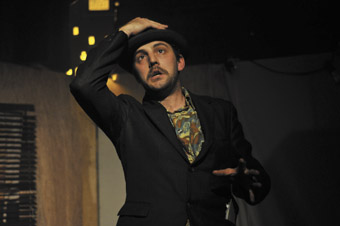
The Ballad Of Backbone Joe, The Suitcase Royale, Imperial Panda Festival
photo James Brown
The Ballad Of Backbone Joe, The Suitcase Royale, Imperial Panda Festival
The edification? Literally, it’s a performance festival. That’s a broad brief, and so for some it will be interesting to note that, this year, performance means something live, personal and often openly and unfashionably theatrical. Nick Coyle’s Kittenbone Bridge, which had previously been produced for Sydney Theatre Company’s Wharf2Loud was recreated without a budget and only three actors, resulting in a production that was—astonishingly—an improvement on the STC version. The Suitcase Royale presented the Ballad of Backbone Joe, a pugilistic noir tale with live music, occasional bouts of puppetry and an infinitely ingenious use of props. The Royale have already established a cult following in Melbourne, and the show oozed confidence in spite of hackneyed gags in the script.
Eddie Sharp, Zoe Coombs-Marr and Johnny Leary were part of the large team of collaborators who created the Mad Max Re-mix, an astonishing condensation of the entire Mad Max trilogy into a single, short romantic comedy about incest and the love of dance. It was Mad Max in its perfect form, the film that George Miller always wanted to make but never had the courage to attempt, with bush doofs, rehab centres and more dick jokes (which would have been insufferable without Leary’s comic genius). Erotic Fan Fiction consisted of readings of pornographic fantasies about your favourite celebrities, while even Brown Council’s Six Minute Soul Mate was an exception to their normally strict performance orientation, by being an intensely funny and cruelly painful stripped-down theatre piece about speed dating culture.
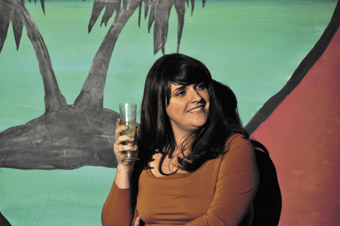
Di Smith, Six Minute Soul Mate, Brown Council
photo James Brown
Di Smith, Six Minute Soul Mate, Brown Council
As an aside: someone ought to erect a monument to Rosie Fisher, who is arguably the most important and underestimated figure in experimental Sydney theatre. I don’t know a single experimental production that hasn’t, somewhere down the line, benefited from her enormous resourcefulness and inexhaustible generosity. When Suitcase Royale traveled up from Melbourne, Fisher not only found them accommodation, but bought bedsheets from the Salvation Army and laundered them in her home, while at the same time managing media, hustling venues, and generally greasing the wheels of production with endless patience and deft tact. The fact that there isn’t a bronze statue in a public park dedicated to her is an impudence, and that she hasn’t been headhunted by a film company for a six figure sum is an astonishment.
Many of the performances drew on a shared language of early 20th century stylistic references. Bizarrely, one couldn’t help but think repeatedly of Orson Welles: Mad Max experimented with the live sound techniques of early radio plays; the Suitcase Royale took an entire visual language from early noir cinema; Kittenbone Bridge had a positively expressionist edge. This might in part have been a language developed in response to constraints. Props cut from cardboard and musical instruments on stage, awkward silences and overacting could be read as heinous marks of amateurism, but none of these performances was amateur, rather they carefully exaggerated exactly those elements of theatre that made the production as raw as possible.
All of the shows were comedies in one sense or another, but they were deflationary comedies, often building up and then consciously frustrating the desire of the audience for zingers, gags, the catharsis of laughter. If the Imperial Panda Festival can be taken as a barometer of a generation (and I think that it can), it’s a generation that is sometimes awkwardly feeling its way to creating its own genres, and it’s defining itself against earlier avant gardes through the conscious invocation of nostalgia. Although often ramshackle and edgy, this sort of highly intelligent work is closer to the Nature Theatre of Oklahoma [RT89, p6, RT 86, 56] than to any school eisteddfod you’ve ever seen, even if it doesn’t want to let you know that straight away. But then, it should take you more than six minutes to consummate a date.
The Imperial Panda Festival 2009, Kittenbone Bridge by Nick Coyle; The Mad Max Re-mix; Brown Council, Six Minute Soul Mate; The Suitcase Royale, The Ballad Of Backbone Joe; Erotic Fan Fiction; Cab Sav; venues Serial Space, Helen Rose Schausberger Laboratorium, Penguin Plays Rough, Sydney, Bill & George; February 10–21
RealTime issue #90 April-May 2009 pg. 43
© Adam Jasper; for permission to reproduce apply to realtime@realtimearts.net
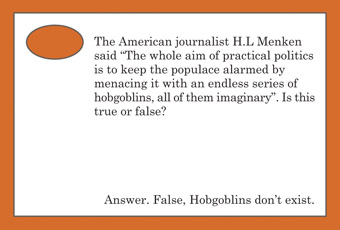
A.R.T. Pursuit, 2008, Yara El-Sherbini
courtesy the artist, commissioned by The Delfina Foundation
A.R.T. Pursuit, 2008, Yara El-Sherbini
2009 WILL BE THE 3OTH ANNIVERSARY OF THE CONCEPTION OF THE BOARD GAME TRIVIAL PURSUIT. IT’S A GENERAL KNOWLEDGE GAME (POPULAR ENOUGH TO MAKE APPEARANCES IN SEINFELD AND ONLY FOOLS AND HORSES) WITH QUESTIONS DIVIDED INTO CATEGORIES LIKE ART AND LITERATURE OR SCIENCE AND NATURE. YARA-EL SHERBINI’S A.R.T. PURSUIT, COMMISSIONED BY THE DELFINA FOUNDATION, REWRITES THESE QUESTIONS TO FOREGROUND ISSUES OF ETHNICITY, MORALITY, PROPERTY…AND MORE.
El-Sherbini’s practice is what Nicolas Bourriaud would characterise as Relational Art—art that relies on viewer interaction and participation. Previously she has deployed the format of the pub quiz and the patter of the stand-up comic; this piece is part of the Delfina Foundation’s series, With a small p, which explores game-playing to ask whether play can be a political gesture. I’m one of 24 participants who responded to the artist’s invitation to find out. After the delicious buffet supper, the room has the intimacy of an after-dinner game (one player longs for coffee and chocolates), even with so many people. We are arbitrarily divided into teams so from the outset there is a good chance of being among strangers, discussing potentially divisive issues which makes me wonder how it might be with a less liberal set of players.
The prototype on the table looks like any new board game. There are die and three letters—A,R,T—which the players must collect. The only indication we have that it’s an art object is a reminder to keep drinks away. Eventually, there will be a limited edition of 15 but this is almost irrelevant because the work exists in the playing. The use of modified games is not new to performance. In the 1970s Fluxus created many, most sold in inexpensive box sets through George Macunias’ Fluxfest store on Manhattan’s Canal Street. At Fluxus events too, people were asked to join in and play. However, the point of those games was that ultimately they were not really playable (the pack of cards consisting purely of Jokers; soccer played on stilts). A.R.T. Pursuit is the opposite. It’s extremely playable—for almost three hours.
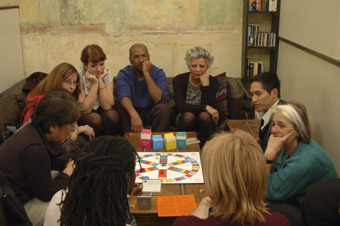
A.R.T. Pursuit, 2008
courtesy the artist, commissioned by The Delfina Foundation
A.R.T. Pursuit, 2008
Though designed to exist without her presence, tonight El-Sherbini (every bit the charismatic hostess) reads out the printed rules, telling us we are collectively responsible for reaching a consensus on how long players should take before giving their final answers and how exact those answers must be. After this, she is an unobtrusive presence. A couple of times, teams look to her to mediate on what is or isn’t fair but she reminds us it’s not her decision to make. This is such a clever tactic, instantly empowering participants and drawing attention to those processes by which decisions are made: the negotiations between team members, the firmly held convictions, the congratulations or finger-pointing. It asks—who is responsible; who decides? It’s a neat introduction to the issue of agency: only by participating in the decision-making can we alter the course of the game.
The questions themselves are topical, comic, and disturbing. How many people on America’s Most Wanted list are Muslims? Which parliament took an early recess so its members could get home on time to find out who shot JR? How much yearly profit did Charles Saatchi make by owning Damien Hirst’s The Physical Impossibility of Death in the Mind of Someone Living? There are a few with no apparent gravity (Who is the movie star Brad?) but by placing them alongside the weightier ones (What did Ralph Peters say works: ethnic cleansing or rechargeable batteries?), El-Sherbini reflects contemporary experiences of cyber-crawling whereby every headline is reduced to the same level of importance (today’s: “Men shot dead in US toy store” alongside “Truffle sells for 130K”). By requiring us as players to ask these questions (literally, to read them out), A.R.T. Pursuit alerts us to the fact that these are questions we should be asking anyway; all the time.
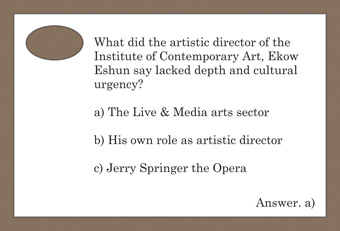
A.R.T. Pursuit, 2008, Yara El-Sherbini
courtesy the artist, commissioned by The Delfina Foundation
A.R.T. Pursuit, 2008, Yara El-Sherbini
El-Sherbini’s methods of compiling the questions reminds me of the Guerrilla Girls’ strategy. In an interview, one of them,“Romaine Brooks”, described how they got “personal dirt on the critics from confidential sources all over town.” I can vouch for the veracity of El-Sherbini’s questions being created from anecdotal evidence because I unwittingly contributed to one when I told the artist about my experience of tagging along on a Tate Modern tour. I don’t think I was the only person left open-mouthed when one of the official Tate guides referred to Chris Ofili as: “a coloured painter who makes work about coloured people.” But none of us challenged her. Why? Was it because the woman seemed so “nice”? It’s exactly this kind of insidious racism that Yara El-Sherbini asks us to confront.
Of course any game that has been altered in this way also draws attention to its own construction, to its rules. There are losers, and winners (eventually). Here, we become aware of a tension between intellect and plain old-fashioned winning. Teams are busy strategising. As players on Team Pink, we want to reduce the length of discussions by our opponents on Team Orange. (Are we scared that if they do too much talking they’ll get to the right answer?) Yet, in doing that, are we in danger of curtailing debate? Is this, in part, the point of the game?
The Enlightenment’s love of knowledge for its own sake has given way to knowledge as commodity. As Lyotard reminds us, postmodernist society needs to ask itself who is deciding which knowledges are paramount. Sometimes the answers to Yara El-Sherbini’s questions highlight the impossibility of the enterprise. Example: is money the root of all evil? If you were foolish enough to consider anything as the root of all evil, you should pass your turn. It’s in these humorous moments when we realise what a ridiculous and arbitrary pursuit the categorisation of knowledge is. A.R.T. Pursuit succeeds on so many levels: as a way of introducing thorny subjects, as a networking tool, as a thought-provoker, as an education. And you know what, it’s really good fun too.
Yara El-Sherbini, A.R.T. Pursuit, Delfina Gallery, London, Nov 27 & Dec 2, 2008
RealTime issue #90 April-May 2009 pg. 44
© Marie-Anne Mancio; for permission to reproduce apply to realtime@realtimearts.net
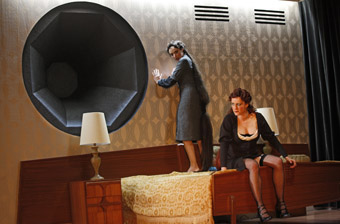
Melissa Madden Gray, Susan Prior, Venus and Adonis, Sydney Theatre Company
photo Jeff Busby
Melissa Madden Gray, Susan Prior, Venus and Adonis, Sydney Theatre Company
MARION POTTS’ STAGING OF SHAKESPEARE’S POEM VENUS AND ADONIS AND RANTERS’ HOLIDAY ARE HISTORICALLY WORLDS APART; THE FORMER IS ENGLAND’S MOST POPULAR POEM OF THE 1590S, HERE HYPER-DRAMATISED AS A DUET FOR TWO FEMALE ACTOR-SINGERS; THE LATTER IS AN ULTRA-NATURALISTIC, AWKWARD MEETING OF TWO MALE STRANGERS, INTERLEAVED WITH SOLO, BAROQUE LOVE LAMENTS. BOTH PLAYS ARE ABOUT LOVE, ONE OVERTLY, THE OTHER IMPLICITLY; BOTH FEATURE DESIGN BY ANNA TREGLOAN AND SOUND BY DAVID FRANZKE, AND I SAW THE SHOWS WITHIN A FEW DAYS OF EACH OTHER, AND WAS STRUCK BY SYNCHRONICITIES OF ARTISTRY AND THEME.
For the Bell Shakespeare and Sydney Theatre Companies, Tregloan has created a convincingly realistic, moderately luxurious hotel room where Venus and her double (Melissa Madden Gray and Susan Prior) long for a sexual encounter, ogling the audience, making us their Adonis (a conceit that lasts for some two-thirds of the show until, after he is gored by a boar, the young man’s ashes are grieved over in the hotel bed). The set for Venus and Adonis might be a smallish box that we peer into and from which the performers leer out, but we are subtly enveloped by Franzke’s sound world, which is as verité as Tregloan’s hotel room: voices in the corridor, footsteps, the whining of elevators, the inevitable 4am grind of a garbage truck.
This resonant realism of set design and sound is juxtaposed with larger than life performances (apt for two goddesses, elegantly gartered and stockinged, surreally coiffed with trailing, body length hair) and Andrée Greenwell’s memorable lyrical songs (evoking without pastiching Elizabethan music, beautifully accommodating Shakespeare’s long lines, and sung against a trio of musicians on percussion, recorder and electric guitar barely hidden in the greenery outside the window). Potts’ production gives full vent to the vividness, rawness even, and the numerous double entendres of Shakespeare’s verse as well as conveying Venus’ passage from lust to, perhaps, love and then despair. Like a human, she learns the inequalities and agonies of love but, like a goddess, she curses us with them forever. The real and the hyperreal coalesce in this Venus and Adonis, to make modern sense of a four-century-old poem.
Across town, for Holiday, written by Raimondo Cortese, directed by Adriano Cortese and co-presented by Ranters Theatre and Griffin Theatre Company, Anna Tregloan has whited-out the Stables theatre, making it feel unusually, indeed eerily, capacious. We are very conscious of being inside it. At its centre is a wading pool, and to one side a chaise longue. In a series of encounters, interpolated with solo songs, two reticent men (actors and co-devisors Paul Lumm and Patrick Moffat) find themselves chatting. It all seems inconsequential.
Around us are Franzke’s surround sounds of nature—water, birds, distant conversations. At times these subtly underscore pauses and brief silences in the conversation, at others they are everything: the men stop talking, look out at us, appear to listen, for a long time. We are the others, unreferred to, on this holiday, as these men barely get to know each other, reveal little of themselves (save a handful or two of mysterious recollections and observations) but, in the play’s final moment, open up to empathy, the beginnings perhaps of friendship or even love. As with Venus and Adonis, the play between the real and the hyperreal, here the innocent conversation and the sounds of nature pitched against the calculated, banal otherworldliness of the design and the bursts of unacknowledged song, generates for its audience a state of enveloping reverie and, at the same time, an enriching hyper-awareness.
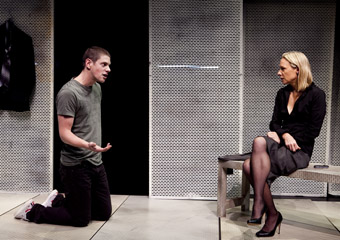
Sam North, Belinda McClory, Concussion
photo Alina Gozina
Sam North, Belinda McClory, Concussion
The Griffin and Sydney Theatre Companies have come together to co-produce and premiere Ross Mueller’s impressive fable, Concussion. Mueller crafts superb dialogue, is adept at brisk characterisations and, best of all, has the ability to give pretty much equal weight to all six of his characters as their lives complicatedly intertwine. He has a particularly good ear for the voice of the young, in this case Sergio with his eager if blunt intelligence (expertly realised by Sam North), and adds to the under-age sex debate in a frank depiction of a female lawyer (Belinda McClory) inadvertantly trapped in a relationship with an adolescent. Typical of the play’s world, the same lawyer is less principled in a crisis when she has to deal with the likely guilt of her client, police detective Caesar (Terry Serio) who is suffering from amnesia after perhaps having perpetrated a violent crime. The core of the play is the return to memory, and around it constellate tense, overlapping relationships between husband and wife, wife and ex-husband, husband and lawyer, brother and brother, father and son.
Director Brett Adam draws fine, equally weighted performances from his actors: the sense of ensemble is palpable. However, the demands on the performers are sometimes considerable especially Mueller’s filmic intercutting of couple dialogues, running two or three at a time, but more rarely (and more effectively) delivered simultaneously. Occasionally this editing seemed to strand the performers, a condition exacerbated by the growing spatial distances between pairs on Brad Clark and Alexandra Sommers’ rather thematically undefined set (slightly unhinged metal pannelling on split-level modern scaffolding evoking home, office, cafe etc and a bridge above). As in Venus and Adonis and Holiday, music is also a felt presence in Concussion: loud bursts of it and pulsing light accompany dream-state-ish dancing, grapplings and tusslings. Although they’re in the script, there’s an air of dated superfluity about these interludes, interrupting the otherwise dynamic seamlessness of Mueller’s time-shuffling narrative drive. Reservations aside, I left the theatre exhilarated by Concussion’s fine performances, idiosyncratic characters, the acuity of the writing and the surprising moral turns. Unlike Holiday (which shares much with contemporary performance), Concussion is straight theatre, but entertainingly lateral and, in the end, positively crooked.
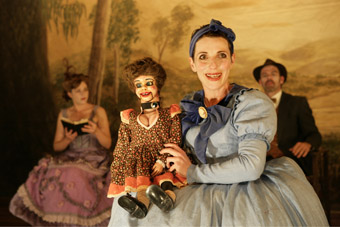
Julia Zemiro, Christen O’leary, Jim Russell, Goodbye Vaudeville Charlie Mudd
photo jeff busby
Julia Zemiro, Christen O’leary, Jim Russell, Goodbye Vaudeville Charlie Mudd
For Malthouse and Arena Theatre Company, Goodbye Vaudeville Charlie Mudd is the latest work from the dynamic duo of director Chris Kohn (now Arena’s artistic director) and writer Lally Katz. In recent years they’ve created a fine body of work for Stuck Pigs Squealing with a rich theatricality, drawing on and perverting tradition, and a bracing sense of the absurd (at its peak in Lally Katz and the Mystery of the Two Volcanoes). While not producing psycho-realism, the pair have nonetheless, quite laterally and elusively, suggested disturbing complexities of character, for example in the deluded central figure in The Black Swan of Trespass and acutely in the incestuous brother and sister relationship in Eistedfodd.
Directed by Kohn with his usual finesse and inventiveness, this new play is half good: well, the second half is good. The first, unusually for Katz and Kohn, pretty much conventionally unfolds the plot, broadly delineates characters and the 1914 Melbourne context and is full of entertaining vaudevillian business—songs, magic, acrobatic feats, ventriloquism and bad manners. It’s anchored by a superb performance from music director Mark Jones in blackface (and perfect black vaudeville voice; see p6 on blackface in The Wooster Group’s Emperor Jones) the narrative centring on the arrival of a replacement female performer (Julia Zemiro), “insect impersonator and singer of dramatic arias” who is immediately forced to adopt the name of her predecessor amidst hints of dirty deeds by the show’s owner, Charlie Mudd (Jim Russell).
The set, a small Edwardian theatre, is a fine one, again conventional, going for a sense of historical accuracy. The second half goes backstage, leaps forward in time (Mudd’s business has declined, The Swanston River is likely to flood the building and the manager’s relationship with the new girl has soured). It’s here that things take a surreal turn, evoking Edwardian ghost stories, venturing a sizeable metaphysical leap into the future and displaying Katz’s sense of the ridiculous—for example, how to defeat a pygmy curse against having sex with tall people by doing it with the ventriloquist’s doll. Chirsten O’Leary as the ventriloquist with the foul-mouthed doll that bespeaks her mistress’s desires, Matt Wilson as the emotionally and physically stunted brother of Mudd, Alex Menglet as the cursed magician and Zemiro as Mudd’s latest victim, all propel the second half’s flight into desperation and bewilderment. Finally, if lacking some of the authority and showbiz verve warranted by the main role, Russell has something to get his teeth into as Mudd grapples with his crimes and a bizarre otherworld. Goodbye Vaudeville Charlie Mudd is an enjoyable and eventually rewarding work, but in terms of the Katz and Kohn oeuvre it’s a long wait (including an interval) for the pay-off. Curiously, for all the nostalgia the play evokes and the growing compassion for its depleted characters, the play’s portayal of vaudeville has it, in effect, dying by its own murderous hand. Just too many bodies buried beneath the stage?
Ben Jonson’s The Alchemist (1610) is nearly all business. The play is a powerhouse of conning, double-dealing and fast improvisation as exploits stack up perilously close to collapse, all of it ably captured in this pacy joint Bell Shakespeare and Queensland Theatre Company production. The role-playing core of the crookery is emphasised in the dressing room set with its large mirror (facing the audience but not otherwise exploited), packed clothes racks and assorted props. Director John Bell does not, as some have done, overlay the play with the devices and rituals of alchemy—there are no onstage test tubes, vats and furnaces, and no grand costuming of the crooks.
Face (Andre Tighe), a household servant whose master has left London in fear of the plague, has invited in the lazy Subtle (Patrick Dickson) so they can con the local citizenry with prophesies, charms and alchemy. Almost in view of his victims, Face creates the sound of laboratory bubblings simply by blowing into a straw in a milkshape carton. Bell’s vision, so apt for our own age of spin, is that the conning is pretty much all in the language, and there’s no shortage of it in Jonson’s rich parodying of alchemy and his illustrations of the gift of doubletalk. The result is that the victims of Face and the Alchemist seem even more gullible than usual, especially the elegantly attired Sir Epicure Mammon (David Whitney), totally oblivious to the tatty guises of the crooks (at least Georgina Symes as Doll Common, provides a fashionable decoy with her high blonde coiff and long red frock amongst other outfits). Dickson’s Alchemist changes little in tone or manner or costume (looking mostly like a bargain basement guru), there seems no need, but Tighe’s Face is an able chameleon in all respects. Russell Kiefel as the master of the house brings a Guys and Dolls verve to the proceedings, in the end conning the con men.
This is a serviceable account of The Alchemist and an opportunity to see a rarely performed classic—Jonson’s most popular play, Stanley Wells tells us in his informative Shakespeare & Co (Penguin, 2007), until the disapproving 19th century. And it’s a joy to see a city comedy, one of many from the period and one, writes Wells, that Jonson set in the year of its composing. The spin in politics and economics over the last two decades has had appalling consequences; The Alchemist is a comic reminder of just how easy it can be to deceive—all that was spun, like mortgage derivatives, was not gold.
One thing is clear from all the above: the developmental programs (Bell Shakespeare’s Mind’s Eye, STC’s Next Stage), creative teams, collaborations, co-devisings and co-productions have become an essential part of contemporary Australian theatre’s creative and networking ecology, taking more and more productions to wider audiences and across borders (and Venus and Adonis to the Auckland Festival) and, visibly, to younger audiences. It’s almost surreal.
Bell Shakespeare Company, Sydney Theatre Company, Malthouse, Venus and Adonis, director Marion Potts, performers Melissa Madden Gray, Susan Prior, set and costumes Anna Tregloan, lighting Paul Jackson, composer Andree Greenwell, sound design David Franzke, dramaturg Maryanne Lynch, musicians Felicity Clark, Michael Sheridan, Bree Van Reyk; Wharf 2, STC, Feb 13-28; Ranters Theatre with Griffin Theatre Company, Holiday, text Raimondo Cortese, concept, direction Adriano Cortese, set Anna Tregloan, lighting Niklas Pajanti, sound David Franzke, performers, co-devisors Paul Luun, Patrick Moffat, Stables Theatre, Feb 4-28; Sydney Theatre Company’s Next Stage & Griffin Theatre Company, Concussion, writer Toss Mueller, director Brett Adam, designers Brad Clark, Alexandra Sommer, lighting Luiz Pampolha, sound Basil Hogios, movement Fiona Malone, Wharf 2, STC, from March 17; Malthouse and Arena Theatre Company, Goodbye Vaudeville Charlie Mudd, writer Lally Katz, direction, concept Chris Kohn, cast Mark Jones, Alex Menglet, Chirsten O’Leary, Jim Russell, Matt Wilson, Julia Zemiro, set, costumes Jonathon Oxlade, composer Mark Jones, sound design Jethro Woodward, lighting Richard Vabre, dramaturg Maryanne Lynch, CUB Malthouse, March 6-28; Bell Shakespeare Company and Queensland Theatre Company, The Alchemist, writer Ben Jonson, director John Bell, performers Patrick Dickson, Andrew Tighe, Georgina Symes, Bryan Probets, Lucas Stibbard, David Whitney, Sandro Colarelli, Richard Sydenham, Peter Kowitz, Scott Witt, Liz Skitch, Russell Kiefel, designer Bruce McKinven, lighting Matt Scott; Playhouse, Sydney Opera House, March 20-April 18
RealTime issue #90 April-May 2009 pg. 45
© Keith Gallasch; for permission to reproduce apply to realtime@realtimearts.net
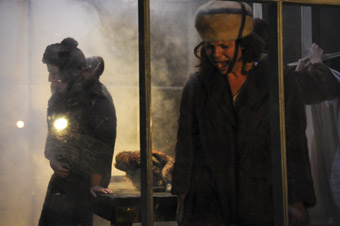
Night Garden, My Darling Patricia
photos Heidrun Löhr
Night Garden, My Darling Patricia
A DARK AND MYSTERIOUS BACKYARD DOMINATES THE SPACE OF NIGHT GARDEN. VIEWED FROM EITHER END OF CARRIAGEWORKS’ CAVERNOUS BAY 20, THE CENTREPIECE OF THIS STUNNINGLY REALISED STAGE ENVIRONMENT IS A SMALL SHED IN WHICH ALL OF THE WALLS ARE TRANSPARENT—A GLASSHOUSE, SEEMINGLY ITCHING FOR STONES. SURROUNDING THE HOUSE IS A SHADOWY LAWN INCONGRUOUSLY POPULATED WITH SUN LOUNGES, A CLOTHESLINE AND A BACKYARD TENNIS GAME THAT SPINS LAZILY AROUND WHEN HIT. THE AUDIENCE PEERS INTO THE BACKYARD THROUGH A SCORCHED SKELETAL WALL, AND STARS GLISTEN FAR IN THE DISTANCE. DESPITE THE SUBURBAN TRAPPINGS, THERE’S NO SENSE HERE OF THE PROXIMITY OF ANY OTHER HOUSES. THE BUILDING AND YARD FORM AN ISLAND, ONE IN WHICH THE INHABITANTS MAY NOT BE ENTIRELY SAFE.
A boy (Sam Routledge) enthusiastically expounds on his topic for the day: cicadas. He lists an abundance of species, becoming increasingly effusive about the qualities of each and culminating in a demonstration of the noises they make when they want to communicate joy, hunger, danger or lust. It’s the first of many references to the animal world throughout Night Garden, a realm alongside which the isolated suburban garden sits awkwardly Clearly, the inhabitants of this damaged house identify with the outsider status of animals and insects. Foxes, cicadas, whales, deer and geese move through the terrain of the performance with their unidentifiable night cries, their smells, and their bodily remains lingering as eerie emblems of half-grasped secrets, not-quite-expressible family traumas, and a longing to escape this stifling suburban placelessness. These animals are dream creatures, and their evocation amplifies the sense of unfolding reverie through which the performance operates. They also become surrogates for the fear and pain suffered by the inhabitants of the house, as well as victims of casual human cruelty. A fox’s freedom to roam fearlessly beyond the fence line is violently curtailed as it becomes a fur stole for a night out, only to be tossed aside as the mood shifts. A goose struts about the yard, a figure of wonder for its young playmate/puppeteer, but later another has its neck absent-mindedly wrenched by the mother, and its broken body dragged around the yard.
Inside the glasshouse, the boy’s mother waits restlessly, almost as if she too might be some barely contained animal. While the boy stands alone, the figure of the mother is tripled (Halcyon Macleod, Clare Britton and Katrina Gill) and, much later in the performance, gains a puppet aspect as well. While this splintering of the mother occasionally clutters the narrative world of the piece, it grants the My Darling Patricia performers licence to generate some striking imagery. The mother paces tensely, laughs with forced lightness, wanders languidly in a layered array of nightdresses, and lounges idly in flowery swimwear. Often she seems utterly disconnected from her son, as if he too is some kind of creature.
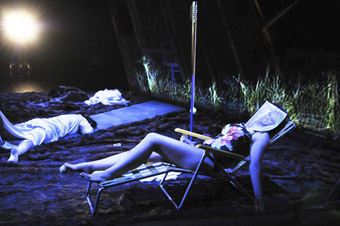
Night Garden, My Darling Patricia
photo Heidrun Löhr
Night Garden, My Darling Patricia
The kaleidoscopic narrative of Night Garden seems primarily concerned with this dysfunctional relationship between mother and son. Absent from this suburban island is any father figure, though there are regular references in the performance text to a man, or possibly several men, who may or may not be the boy’s father and whose mention evokes sex and violence, often so densely intermingled as to be indistinguishable. Hidden beneath the bed, the boy tells of the horrible animal noises his mother and the man make, detailing his visceral terror at the violent implications of human sexuality. The boy’s tale ends with him in a puddle of his own piss, waiting to be the next victim, only to face his mother’s wrath instead. The mother’s own account, possibly of the same event, culminates in actual horrific violence. In the aftermath, attending ambulance officers helpfully ask her what she has done to herself, as if it might be possible that such extreme injuries could be the result of self-harm.
Despite the density of spoken text there is little conventional dramatic shape to Night Garden. The protagonists evoke and animate their beastly surrogates, play out their violent cycles of sex, injury, mutilation and death, and somehow through this process maintain the ritual behaviours of suburbia. Through these intense vignettes Night Garden steadily reveals a deeply disturbing maternal relationship that reverberates long after the performance is over. Like much of My Darling Patricia’s impressive body of work to date, Night Garden blends extraordinary craft skills in design and puppetry with evocative video imagery and performance to produce a work of visual wonder. Despite the occasional loose thread in the weave, the result is striking and strangely haunting.
My Darling Patricia, Night Garden, devisors, performers Halcyon Macleod, Clare Britton, Katrina Gill, Sam Routledge, design concept Halcyon Macleod, Clare Britton, Bridget Dolan, director, animateur Margaret Cameron, sound design Declan Kelly, film, video Sam James, lighting design Neil Simpson, dramaturg Chris Ryan, puppet maker Bryony Anderson, costumes, props Wandjina, producer Marguerite Pepper Productions; Performance Space, Carriageworks, Sydney, March 5-17
RealTime issue #90 April-May 2009 pg.
© David Williams; for permission to reproduce apply to realtime@realtimearts.net
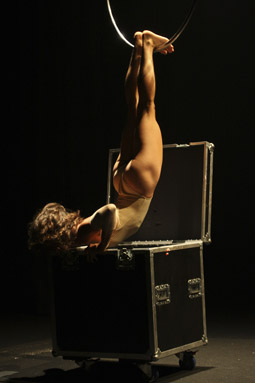
Rachael Gibson, Lira
photo Justin Nicholas
Rachael Gibson, Lira
AT LEAST A QUARTER OF A CENTURY OLD, NEW CIRCUS IS NOW A BIT OF A MISNOMER. CURATED BY YARON LIFSCHITZ, NEW CIRCUS NOW WAS CIRCA’S SECOND ANNUAL SHOWCASE SEEKING TO UNDERWRITE THE PERSISTENT LIVELINESS AND HYBRIDITY OF AN ALREADY WELL-ESTABLISHED, CONTEMPORARY ART FORM THAT OFTEN SEEMS TORN BETWEEN ITS POPULAR ROOTS AND A HANKERING TO CONTINUE THE PROJECT OF MODERNISM, THE PROJECT OF NEGATION, BY OTHER MEANS. THIS ALWAYS PROMISED TO BE AN INTERESTING EVENING. AS WELL AS PROMOTING NEW ARTISTS AND ACTS, NEW CIRCUS NOW ALSO SERVED AS THE PILOT PROGRAM OF CIRCULATION—CIRCA’S NEW PRODUCTION HUB—THE IDEA BEING TO PROMOTE NEW WORKS, AND TO DEVELOP ARTISTS.
The first three acts provided an opportunity for individual members of Temptation to present solo performances. The first of these—Tissu—featured Alex Mizzen in an aerial act involving silks (tissu) from which a white chair was tied and suspended. On the minimalist soundtrack (“Democracy” from the Balanescu Quartet’s Luminitza CD) the violins trace a series of high figures while viola and cello maintain the rhythm. Balanescu delivers his accented vocals almost as an authority figure, lending the whole piece the ambiguous quality of either a propaganda broadcast or protest via a loud hailer. Mizzen performed overall with fluid, strong, controlled movements that juxtaposed this unnerving music. However, there was a tentative quality in Mizzen’s repeated, questioning glances as she sought to gauge a response from the audience. When she released the chair, she became correspondingly more at home in her aerial environment. But she insidiously gravitated back to earth as if drawn to the magnetic pull of the chair with all its queasy connotations of torture victims, and with the sly suggestion of a concommitant sense of relief. This short work, so confronting to our post-Abu Graib sensibilities, subtly wove Balanescu’s caustic reflections on a liberated, democratic, post-Ceaucescu Romania into an unsettling and reverberative commentary on present times.
Li Pawson’s Straps took a severely masculine view of human bondage. Lights and an edgy violin accompaniment provided the obstensibly dramatic setting. Bare torsoed, wearing prosaic jeans in place of tights, Pawson affixed wrist straps for his aerial act, one that he attacked with increasing fury. Part bovver boy, part modern gladiator, part corporate warrior, Pawson demonstrated both physical strength and power. He was an athlete in training. He wanted to subject, but in turn was subjected. Tangled in the rope, he became an icon of crucifixion. Dangling, he was a puppet. Frustrated, he restlessly paced, contemplating fresh attacks. He couldn’t walk away. He took more risks, applied greater tests of strength. And his act was breathtaking. But was he spinning out of control? Far from being a hero, was he the epitome of an empty inner man? An automaton, as Erich Fromm expresses it, who, lacking spontaneous life of his own, takes as surrogate any kind of thrill: the thrill of drinking, of sports, of manipulating the stockmarket? Ironically, these substitutes are akin to the vicarious thrill and excitement we experienced watching Pawson perform. The more we admired his strength and skills, the deeper perhaps we fell into a trap cleverly contrived for us.
Lira was a change of pace. Annie Lennox sang “Everybody’s Looking for Something” as a vamp in red wheeled on a stage box, kicked it contemptuously and exited. A gagged Rachael Gibson rose, blonde, glittering, holding on to a steel hoop a la aerialists of yore, posed rather than poised. Her routine was likewise subjected to the centrality of pleasing through conventionally glamorous pictures, which she achieved effortlessly. The hoop was not her partner but a perimeter, a form of restraint with which she had to negotiate. Her descent was headfirst, hanging, to a remix of “Strange Fruit”, only to re-emerge from the box sans gag to rise again for a much more self-assertive routine, genuinely erotic, risky and adventurous. Her strength, agility and grace soared. On her descent, the vamp girl is flipped triumphantly into the box before Gibson exits.
The individual strengths of these three performers were not so much in evidence in the ensemble piece, Temptation, directed by Brian Lucas. This was a romp set in the playground of the jeunesse d’or. It had all the light and froth of a film by Chabrol but sadly, perhaps owing to opening night nerves, the performers couldn’t quite find their feet. It depended on exquisite timing to keep it in the air, and the mix of dance and acrobatic skills didn’t quite adhere. The opposite was the case in Floor Routine featuring Todd Sutherland and choreographed by Louise Delere. Here was the joy of effortless movement. Sutherland’s background as gymnast as well as professional dancer stood him in good stead. In a pure dance piece that often literally upended the skyward tendency of Western ballet, a series of modified yoga-like flows conveyed in movement the sense of bas-relief or vase paintings on a curved surface—as if the fourth dimension of time was being visibly recreated from some archaic source.
Scattered Tacks, from Melbourne trio Skye Gellmann, Aelx Gellman and Terry Cat Silvertree was created in a squat and the absence of electricity caused this three person ensemble to improvise their own lighting with torches strapped to their heads. No extraneous effects. Fragments of a life obscurely shared were dimly recreated. The light distorted, flattened and sculpted identifiable shapes into pure, foreboding forms. A woman is dissected by light. She is shaken, bent, turned into a mower, energetically fucked. A man lies on the ground with a heaving stomach. Another man tenderly puts a tea bag in his mouth and a tea cup on his forehead. He rises and hops to a teapot balancing a juggling ball on his foot. He puts the teabag in the cup and pours water from the teapot. He performs an exquisite three ball juggling act, ultimately balancing balls along his spine. The woman picks up an onion, peels it and tosses skins like petals. She eats the onion with sensuous gusto, breathing deeply and exhaling fumes until she begins to convulsively sob as if for release from the cycle of increasingly pungent desire.
Yaron Lifschitz described Scattered Tacks as “one of the most challenging and significant pieces of New Circus to emerge in years.” I would like to suggest another contender for such high stakes, not to be contrary, but to underscore what he clearly sees as the direction New Circus should be going. Sofia Woods’ Blurred Lines was a standout in the line-up at the Brisbane Powerhouse last year. Scouting the possibilities for transformation, Blurred Lines was itself transforming. It encompassed circus and dance, utilising the trapeze as a poignant and risky vehicle for an inner balancing act while affectionately trying on for size self-parodying lesbian roles—butch, femme, drag king—setting them up for an hilarious and bawdy contest for dominance within her own psyche. But she took us to a deeper level through a series of morphing projections of her own ‘bisexuality’, akin to what Virginia Woolf called “the androgynous mind.”
Woods’ scenario of reflecting mirrors was eventually stripped away, arriving at the liberating moment of a return to and a rediscovery of the body, representing the kindling of the kind of desire that, as Hélène Cixous puts it, “wouldn’t be in collusion with the old story of death.” By wholly eschewing ‘routines’, Woods was able to create a complex movement vocabulary unto itself, at times suffused by a vertiginous, melancholic poetry revealed in momentary glimpses of other (discarded?) selves—a spasmodically dying swan on point, a shadow boxer or, most strangely, a lupine beast loping with forefeet of high-fashion shoes. Like Scattered Tacks, Woods’ journey took on the risk of the other, of difference she was content to leave alone in the territory of the unknown, adding to, not subtracting from, the world’s possibilities. This kindred metamorphosis of an art form seems to be the one Lifschitz endorses.
C!RCA: New Circus Now, curator Yaron Lifschitz, showcase director Anni Davey, Tissu; performer Alex Mizzen; Straps, performer Li Pawson; Lira, performer Rachael Gibson; Floor Routine, choreographer Louise Delour, performer Todd Sutherland; Temptation, director Brian Lucas, performers Alex Mizzen Li Pawson Rachael Gibson; Scattered Tacks, creators/performers Skye Gellmann, Aelx Gellman, Terry Cat Silvertree; Judith Wright Centre, Brisbane, March 10-14; Blurred Lines, created and performed by Sofia Woods, dramaturgical/directorial consultant Celia White, movement/choreographic consultant Dean Walsh, set design Greg Clarke, costumes Emma Ikin, AV digital design Jennifer Jackson, photographic images Kate Nutt, musical composer Pete Goodwin; Visy Theate, Brisbane Powerhouse, Aug 6-9, 2008.
RealTime issue #90 April-May 2009 pg. 47
© Doug Leonard; for permission to reproduce apply to realtime@realtimearts.net
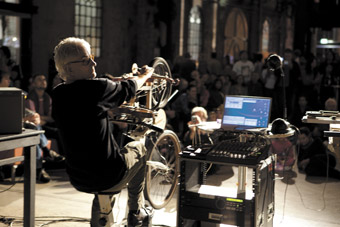
Jon Rose, Pursuit
photo Alex Davies
Jon Rose, Pursuit
JON ROSE’S RIGOROUS PURSUIT OF NEW APPROACHES TO THE VIOLIN STRETCHES BACK OVER 30 YEARS, INVOLVING IMPROVISATION, INSTRUMENT BUILDING, GAME PIECES AND UNUSUAL PERFORMANCE CONTEXTS. A MAJOR NEW WORK IS ALWAYS HIGHLY ANTICIPATED. CREDITED TO JON ROSE AND ROBIN FOX, PURSUIT WAS A COLLABORATIVE PROJECT, BUT CLEARLY DRIVEN BY ROSE’S VISION. IT BUILT ON THE RECENT TRANSMISSION PROJECT, FOR WHICH ROSE ASSEMBLED A FORMIDABLE TEAM, INCLUDING INSTRUMENT BUILDERS ROD COOPER AND JIM SOSNIN, AND FOX, IN ORDER TO INVESTIGATE THE MUSICAL APPLICATIONS OF WIRELESS TECHNOLOGY AND ELEMENTAL FORCES. THE TRANSMISSION PROJECT HAD A NUMBER OF OUTCOMES, INCLUDING KITE MUSIC, WHICH WAS PERFORMED AT THIS YEAR’S NOW NOW FESTIVAL.
For Pursuit, the Transmission team was expanded, with the addition of instrument builders Paul Bryant and Harry Vatiliotis and composer and software developer Garth Paine, as well as several prominent members of Sydney’s cycling community, for bicycles were at the heart of this project. Rose first developed a bicycle powered violin in the early 1980s, but with Pursuit this was expanded into a ‘chamber orchestra’ of bicycle instruments, developed during a residency at Performance Space.
A one-off, free performance of Pursuit took place on a Saturday evening in the huge foyer of Carriageworks. I arrived to find the venue already full. It felt like everyone in the experimental music community was there, but the crowd was also diverse, including cycling enthusiasts and children. It was quite a social event, with people clearly enjoying themselves.
Towards the rear of the space stood the crew, including Rose and Fox, beneath a huge projection screen. Tracks were marked around the edges of the space, lit dramatically in places. Prior to the performance some video documentation was played, while Rose pedalled away on a stationary bicycle which I later learned was being used to power some of the equipment.
Rose introduced the performance by requesting that the audience be as quiet as possible, so as to hear the subtleties of the sound generated by the bicycles, but it was a lost cause. While the audience was polite, and the bar was closed during the performance, the informal setting and number of people meant that there was a constant background noise of chatter.
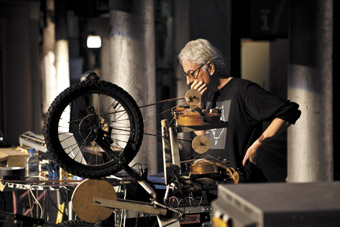
Jon Rose, Pursuit
photos Alex Davies
Jon Rose, Pursuit
The first bicycle emerged with a startling, siren-like sound, as if to warn that what we were experiencing was serious. Adding to the slightly ominous feeling was the projection from a helmet-mounted camera, alternating with surveillance cameras placed at various vantage points. As the lone cyclist made his way around the venue the sound was amplified, modulated via Fox’s laptop and spatialised through a multi-channel speaker setup. Gradually other cyclists appeared, each with a different pedal-powered instrument, including a large hurdy-gurdy-like violin and a bellows-powered pipe instrument. The tone shifted to deadpan humour as the absurdity of some of these contraptions became evident, particularly Rod Cooper’s belt-driven turntable churning out easy listening.
Although the bicycles travelled slowly for the most part, they were still too fast to get a really good look at the instruments, but there was compensation in the inclusion of pre-recorded close-ups on the video screen. As I adjusted to the spectacle I was able to focus on the musical points of interest. The modulation of the instruments’ pitch and tempo by the speed of the pedalling was augmented by large doppler shifts as they went past, and the cavernous reverb of the space which glued it all together.
The scale of the reverb meant that the distinction between the acoustic and electronic sounds became blurred in a way that was unhelpful. I wandered outside of the ring of speakers to experience the acoustic sounds more clearly. Moving around the space added another dimension which was not experienced by most of the audience, who stayed put, oriented towards the screen. I found myself thinking that the best way to enjoy this piece would be to ride one of the bicycles. The sound continued to build towards a climax, like a bicycle race but without the competition, and then finished after approximately an hour.
Pursuit was an ambitious, impressive project, dealing with issues of transport, energy, acoustics, the nature of musical instruments and performance, and there was a lot to enjoy in the performance. In fact, there was too much going on to properly appreciate each of the elements, some of which felt less than fully developed. However the audience was treated to a unique experience, and as we left, most seemed happy with a good night out.
Performance Space: Jon Rose and Robin Fox, Pursuit, with Jim Sosin, Garth Paine, Rod Cooper, Paul Briant, Harry Vatiliotis; CarriageWorks, Feb 14, Sydney; www.jonroseweb.com
RealTime issue #90 April-May 2009 pg. 48
© Shannon O’Neill; for permission to reproduce apply to realtime@realtimearts.net
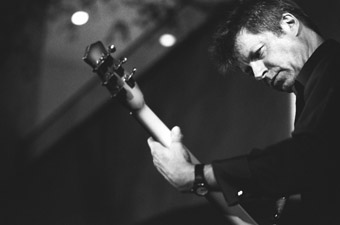
Nels Cline
courtesy Melbourne International Jazz Festival
Nels Cline
JAZZ FESTIVALS TEND TO BE ABOUT ‘JAZZ’ IN THE MOST PEJORATIVE SENSE. FOR A GENRE WHOSE MOST IMPORTANT OPERATIVES ARE STILL FOLLOWING UP ON THE COMPLEX ROUTES OF LOGIC PROVIDED BY FREE JAZZ’S MID-20TH CENTURY EXPLOSION, JAZZ WITHIN THE FESTIVAL/FUNDING CIRCUIT TENDS TOWARD THE POLITE AND INEFFECTUAL—FOR ANYONE WHO’S ALSO WATCHED THE ENGLISH TV COMEDY THE FAST SHOW, THEIR MOCKERY OF THE BLANDNESS OF MUCH MODERN JAZZ, VIA THE HILARIOUSLY CHEESE-BALL JAZZ CLUB TV PROGRAM SKIT, WILL BE BOTH FAMILIAR AND HORRIFYING.
Kudos is due, then, to the Melbourne International Jazz Festival, who this year have made some gestures toward jazz’s fringe activity, while acknowledging several of the genre’s heaviest conceptualists. The presence of Cecil Taylor and Tony Oxley is instructive here. Taylor is one of free jazz’s most rigorous artists, whose oft-quoted description of the piano as “eighty-eight tuned drums” acts as the hinge to much of his playing. Traditionally read as one of the most overtly percussive of free piano players, Taylor’s conceptions are a lot richer than this codification, and one of the joys of his playing is hearing his leaps in complex tonal logic manifest through the physicality of his performance.
Taylor is joined by long-time sparring partner, English drummer Tony Oxley, who was a member (alongside American free jazz alumni William Parker) of Taylor’s Feel Trio. As one of the players who’s successfully negotiated a compact between the two key styles of free playing—blithely put, American free jazz and European free improvisation—he’s best placed to be negotiating the curveballs that a character like Taylor throws to his accompanists. (Also, having played with the late Derek Bailey over four decades, he’s probably good at negotiating the ornery behaviour that often characterises jazz and improvisation’s high flyers.)
Taylor and Oxley may be the great drawcards for avant music fans, but it’s the presence (as artist in residence) of Charlie Haden and his Liberation Music Orchestra that has me most thrilled. This may be more for historical reasons—the first Liberation Music Orchestra album, a political protest song suite released in 1969 on Impulse!, is one of jazz’s most enduring documents. But the Australian line-up assembled for the LMO’s opening night performance is solid, if lacking in wild-card figures like the original line-up’s Don Cherry, Roswell Rudd or Andrew Cyrille.
Other great names, quickly. Nels Cline may be best known as guitarist for American rock group Wilco, but his solo and trio music evidences a player whose fluency in rock forms can translate easily into free and jazz idioms. The Anthony Pateras, Sean Baxter and Dave Brown trio have always offered the most articulate and forward-thinking context for Pateras’ concepts, and they bring welcome electro-acoustic anarchy to the festival program. Baxter and Brown’s sparring partner in Bucketrider and Embers, Adam Simmons, is also performing, as is punk-primitive trio Bum Creek (giving a series of National Gallery of Victoria ‘Sound Walks’), and free percussionist Joe Talia appears alongside Stephen Magnusson and Eugene Ball.
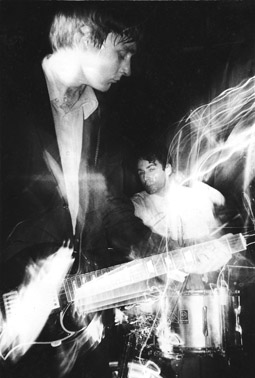
Ed Kuepper and the Laughing Clowns
courtesy Melbourne International Jazz Festival
Ed Kuepper and the Laughing Clowns
Most thrilling of the Australian performances, though, is the appearance of Ed Kuepper’s Laughing Clowns. After their first shows in over 23 years at 2009’s All Tomorrow’s Parties festival, now feels like the right time for the resurrection of Australia’s greatest rock group, one of the few outfits to not so much ‘cross jazz with rock’ as completely explode the tired notion that the two were ever somehow unrelated. Great jazz is rock, and vice versa, and Kuepper understands this at gut level.
Program Director Sophie Brous and Artistic Director Michael Tortoni certainly deserve commendation for their selections. However, they do need to further avoid relying on ‘canonical avant’ to fill out the riskier sections of their program. The underground has long used improvisation and free jazz to bolster the wilder sides of electronic, rock and DIY/folk practices, and more representation from genuinely outsider creatives would be welcome. A closer look at both free jazz’s and free improvisation’s healthy American and European underground scenes would also help balance out a slightly conservative caste, even among these more relatively ‘outre’ selections.
The Melbourne International Jazz Festival also must be wary about the framing of the music itself—very little spells aesthetic stagnation more than the fencing-in of artists by the often overly dictatorial framework of festivals, funding and ‘curation.’ There have been several relatively recent examples of festivals or events which manage to avoid this socio-cultural impasse, such as Winter Tragic in the Blue Mountains, or Other Film and Audiopollen in Brisbane. This year offers possibly the best line-up yet for the Melbourne International Jazz Festival; now it needs to work on the ideological aspects of its practice.
2009 Melbourne International Jazz Festival, various venues, Melbourne, April 26-May 2;
www.melbournejazz.com
RealTime issue #90 April-May 2009 pg. 50
© Jon Dale; for permission to reproduce apply to realtime@realtimearts.net
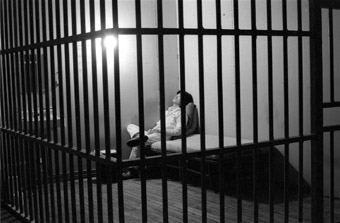
Tehching Hsieh, One Year Performance 1978–1979, Life images
photo Cheng Wei Kuong,
copyright 1979 Tehching Hsieh, New York
Tehching Hsieh, One Year Performance 1978–1979, Life images
ON SEPTEMBER 30, 1978, TEHCHING HSIEH BEGAN HIS FIRST ONE-YEAR PERFORMANCE WORK, KNOWN AS CAGE PIECE. GOING BY THE NAME OF SAM HSIEH, HE ISSUED A STATEMENT DESCRIBING IN THE BALDEST TERMS ITS TEMPORAL AND SPATIAL CONSTRAINTS: THAT HE HAD BUILT A CELL-ROOM WITHIN HIS TRIBECA STUDIO AND WOULD SEAL HIMSELF INSIDE FOR EXACTLY ONE YEAR. HE ALSO HINTED AT THE WORK’S PSYCHOLOGICAL DIMENSIONS: “I SHALL NOT CONVERSE, READ, WRITE, LISTEN TO THE RADIO OR WATCH TELEVISION, UNTIL I UNSEAL MYSELF ON SEPTEMBER 29, 1979.” HE ADDED, “I SHALL HAVE FOOD EVERY DAY” AND, FURTHER, ASSISTING HIM IN THE CORPOREAL DUTIES OF STAYING ALIVE WOULD BE HIS FRIEND, CHENG WEI KUONG, WHO WOULD BRING HIM FOOD AND CLOTHING AND TAKE AWAY HIS REFUSE.
Though not stated, Cheng’s other task was to take a fixed-position, portrait photograph of Hsieh every day. Accompanying the statement was a poster with a photograph of the cell, prior to occupation, and a calendar covering the months of occupancy. Nineteen dates are circled, designating the days that the work would be open to the public.
On April 11, 1980 at 7pm Hsieh began his second one-year performance, Time Clock piece. Again, he set out the conditions of the lifework in advance: “I shall punch a Time Clock in my studio every hour on the hour for one year. I shall immediately leave my Time Clock room, each time after I punch the Time Clock.” Again, the actions were verified by several human and mechanical regimes: prescribed days in which the work would be open to the public; a 16mm movie camera positioned to register Hsieh immediately after the hour had been punched, one frame for each hour, this time operated by Hsieh himself using a shutter release; and at the end, a witness who signed the 366 time cards and checked the paper seals on the Time Clock.
By the time Hsieh was immersed in his third one year work, Outdoor piece, I had emerged from art school in Brisbane, begun work at the Institute of Modern Art and was becoming ever more drawn to the work of Australian and international conceptual artists (loosely categorised). Performers such as Ulrike Rosenbach, Mike Parr, Jill Orr, Jill Scott, Bonita Ely and Henri Chopin tore through town like Queensland’s famous cyclones. In 1982 the visiting US performer, Ellen Zweig, asked me to co-perform her Fear of Dining, a text work for two simultaneous voices. The script was published in the issue of High Performance that she’d brought with her. I eagerly took out a subscription. I think this is how I first came to know about Tehching Hsieh’s work—from a one-page report in the Fall issue of 1982. It included a single image of Hsieh, peering at his own weather-worn face in a mirror fragment on the streets of snowy New York during his year outdoors.
I didn’t know it at the time (it took me years to know it) but he created the paradigm for my own work. It gave me courage. His was a practice that was rigorous and uncompromising and exacting, so committed to its own logic that it took art to a place that felt like the reason for life itself. This was not the art life. This was art as life.
<img src="http://www.realtime.org.au/wp-content/uploads/art/26/2682_campbell_hsieh1.jpg" alt="Tehching Hsieh, One Year Performance, April 11,
1980–April 11, 1981, collection of the artist “>
Tehching Hsieh, One Year Performance, April 11,
1980–April 11, 1981, collection of the artist
photo Michael Shen,
copyright 1981 Tehching Hsieh
Tehching Hsieh, One Year Performance, April 11,
1980–April 11, 1981, collection of the artist
For 30 years the bare documents and an occasional photograph accompanying a review were the only ways to experience Hsieh’s work. Like much conceptual work in the 1960s and 70s Hsieh’s performances had to be built in the mind by each viewer. How else to experience them? At the institutional level Hsieh’s work was invisible perhaps for the simple reason that museums are still struggling with the implicit paradox of preserving time-based work. Presenting it, though, and allowing the artist to reshape the work so that it is made anew is a very good start.
This northern winter/spring, two of Hsieh’s one-year works can be experienced (I won’t say ‘seen’) in two major New York museums and a large, attentively-illustrated monograph published by Live Art Development Agency and MIT Press and authored by Adrian Heathfield in collaboration with the artist.
In the first of a series simply called Performance, The Museum of Modern Art is presenting One Year Performance 1978–1979 (Cage Piece) in all its evidentiary simplicity and conceptual complexity. The 365 self-portraits are arrayed in a continuous line along three of the gallery walls; the posters, statements and 17 still images fill out the documentary narrative. Taking up much of the Yoshiko and Akio Morita Gallery on the second floor is a room built to the original dimensions of Hsieh’s TriBeCa loft and within this, set in its original position is the primary artifact, the cage itself complete with original bed, basin, mirror and wastebucket, kept in storage all these years by the artist. My first surprise was to see the warm tones of the cage’s wooden construction (previously disguised by the cold black and white photographs).
Seeing it there, at human scale, but without its one-time and only inhabitant, it invites all of us looking through those thick bars of pine dowel to imagine ourselves in the artist’s place. It sucks us in and projects back anxious questions: the how questions: how did he wash, shit, sense time passing, think without stimulus or dialogue, survive without sunlight? The why: why did he do it? (perhaps, but not for me). The what: what was in his head, his body, his each and every moment? For some, the answers come back readily, as reasons: “about” imprisonment, immigrant status, isolation, disenfranchisement and these responses are indeed reasonable but insufficient. In the end I found it more productive to forego rationalisation and let the questions multiply.
Further uptown the Guggenheim museum is presenting Hsieh’s One Year Performance 1980–1981 (Time-clock piece) as part of a larger exhibition, The Third Mind: American Artists Contemplate Asia, 1860-1989, curated by Alexandra Munroe.
Unlike most of the works in The Third Mind, the Time Clock piece is privileged within a discrete gallery space off the top end of the spiral ramp that holds the larger exhibition in thematic and chronological progression.
For me the most compelling of the artifacts in the presentation of this work is the time punch clock itself, mounted on the wall near the entrance and, again (or perhaps, still), running in synch with lived time. It has no second hand—silent through absence. The minute hand, though, is disarmingly loud when it clunks forward. Its sound works in concert with the ‘silent’ 16mm film projecting on the wall directly above. Here the clock spinning around at comic speed shares the frame with Hsieh as co-performer but also as co-director. Projected at 24 frames per second, each day is condensed to one second; the whole year passes in a little over six minutes. Turning around, I see the source projector threaded up with the film loop running continuously, and above, mounted from the ceiling is the original 16mm camera. I am held there: time, its semiotics and effects playing over me.
Hsieh also gives us the option of travelling along these images at our own speed. Hung around the walls in a continuous line is each of the year’s time punch cards and, underneath, the set of portrait stills that corresponds to the hours punched on the card. I found it stifling to walk along them all, wondering at the blank frames in the film (mostly caused by technological failure), painful to see the handwritten explanation beside any “late”, “early” or missed (“sleeping”) punching of the hour, though only a small number of appointments ‘failed’ in these ways. And yet, for all these portraits—8760 pieces of lived evidence, I still wonder at the Hsieh who wasn’t there. Who was that Hsieh when he wasn’t punching the clock? Did he exist at all?
A much deeper contemplation of these works is now available to us in Out of Now, the monograph of all Hsieh’s lifeworks.
There is a lot of love in this publication, not in the hagiographic sense, but in the pastoral sense. It’s not often that an artist receives the kind of respectful, patient, uncompromising, searching attentiveness that Adrian Heathfield, the author (in this instance writer/editor), has brought to his subject. All the works are contextualised and analysed with an authority that doesn’t flatten. All the works are exhaustively illustrated: for the two performances described above, every self-portrait, every time punch card, every statement and every documentary image is there. Compiled in this way, and against expectation, they seem to create a kind of poetics of facticity. In the final third, other voices and responses are brought in. Heathfield and Hsieh engage in a thickening dialogue that comes as a welcome counterpoint to the silent artist of all those self-portraits. A series of letters both archival and recently commissioned from Peggy Phelan, Marina Abramovic, Tim Etchells and Santiago Serra follows. The conclusion, “Afterthoughts: Stilling the World”, is written by Carol Becker who does a brilliant job of reiterating the philosophical concerns that generated the work and are generated by it.
I was not there to see Hsieh in the cage or cheer when he punched his last time card. But I saw something very important in New York this January last and I cheered when I read Out of Now.
Tehching Hsieh, Performance 1: Tehching Hsieh; Museum of Modern Art; Jan 21–May 18; The Third Mind: American Artists Contemplate Asia, 1860–1989 Guggenheim Museum, New York; Jan 30–April 19
Hsieh’s other lifeworks include two further one-year pieces: being tied by an eight foot rope to the artist Linda Montano, but without contact (Rope piece); and not engaging with art, “just [going] in life”. These were followed by a 13-year work (1986-1999) during which Hsieh produced art but did not show it publicly.
Adrian Heathfield and Tehching Hsieh, Out of Now: The Lifeworks of Tehching Hsieh, Live Art Development Agency and MIT Press, 2009
RealTime issue #90 April-May 2009 pg. 52
© Barbara Campbell; for permission to reproduce apply to realtime@realtimearts.net
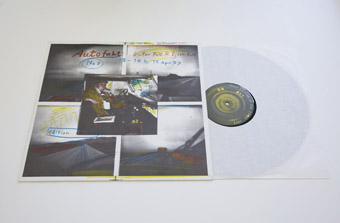
Autofahrt (car journey), 1979, Dieter Roth
photos Tobias Titz, courtesy The Narrows
Autofahrt (car journey), 1979, Dieter Roth
DIETER ROTH’S LIFE WAS ALMOST AS ITINERANT AS HIS ART. ONE OF THE 20TH CENTURY’S GREAT POLYMATHS, HE WAS BORN IN HANNOVER, GERMANY TO A SWISS FATHER AND GERMAN MOTHER, LIVED FOR A WHILE IN ZURICH, SWITZERLAND, HAD A STUDIO IN PROVIDENCE, RHODE ISLAND, AND SPENT SIGNIFICANT PERIODS OF HIS LIFE IN REYJKAVIK, ICELAND AND BASEL, SWITZERLAND, WHERE HE PASSED AWAY IN 1998. BUT MORE IMPORTANT, PERHAPS, WAS THE SEEMING ROOTLESSNESS OF HIS ART. I SAY ‘SEEMING’ BECAUSE THERE IS A COHERENT META-LEVEL GOING ON IN ROTH’S ART THAT BINDS HIS APPARENTLY DISPARATE PRACTICE, THOUGH CORRECTLY DIVINING AND EXPRESSING SAID COHERENCY HAS ALWAYS BEEN A CHALLENGE.
My key interest in Roth is his obsession with documentation and publication—the way he embraced both the multiple and the reproduction, and subsequent degradation of the ‘aura’ of the artwork. In much the same way, his infamous food paintings and sculptures, using bananas, chocolate and cheese, are all about removing the ‘stain of aura’ from the coherent, historicised artwork.
For North Star/Dark Star, curated by Greg Fullerton, The Narrows gallery focused on four artists who, in Fullerton’s words, “share an experiential bond with the polar region, an aesthetic sense of place, geographic distance, time and light.” The three other artists, Austria’s Franz Graf, Norway’s Sandra Vaka Olsen and Iceland’s Huggin Pór Arason, acquitted themselves well, Olsen’s gorgeously indistinct photographic works in particular. But their works were humbled by the power of Roth’s art, and indeed the context it brought to the exhibition. Roth deals with base elements—one of the books on display was his wonderfully titled Die die Die DIE GESAMTE VERDAMMTE SCHEISSE (The the The THE COMPLETE DAMNED SHIT), and it’s publications like these that best express Roth’s sometimes conflicted personality: anal expulsive in his obsession with fluid, decay and a kind of ‘playful abjection’, yet incredibly anal retentive in his need to catalogue, document, keep and maintain his body of work. (As Fullerton puts it, Roth’s work was “[a] process of accumulation and regurgitation of pulp, poo and pop.”)
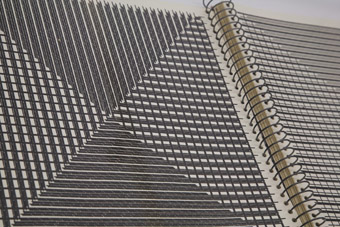
Bok 2b, 1961, Dieter Roth
photos Tobias Titz, courtesy The Narrows
Bok 2b, 1961, Dieter Roth
There was a mere handful of Roth’s works on the walls of The Narrows, and it felt as though they were selected almost randomly. And although it was good to see his art up in the small white cube, you gained a far more powerful and revealing sense of Roth’s creative processes from the small glass cabinet containing several books and one record, which sat to one side of the room. It looked like an afterthought at first—some books collected from local libraries and an audio record, Autofahrt, which, if you were lucky enough to come to The Narrows toward the end of the exhibition’s run, was playing quietly in the background on an old portable record player. But flipping through books like Mundunculum or Die die Die DIE GESAMTE VERDAMMTE SCHEISSE, one gets a very real sense of not just Roth’s prolific nature, but his compulsiveness, his need to repeatedly toil over ideas, and also to try things from all angles, to not get bogged down in any one field or approach.
The energy contained in his drawings—fast, almost off-the-cuff productions which have all the humour and freakish humanity that you also find in Daniel Johnson’s eschatological, religious pop-comic art—translates to the stamped pattern that snakes across the cover of Mundunculum. Here you see a mind moving quickly, perhaps too quickly, searching for a process or form that can keep up with his movement. In that relentless need to create and reproduce, Roth is very much a precursor to many DIY and punk practices of the late 20th century, and in his embrace of the book or record as artist multiple, but also as viral contagion, as a form for dissemination, his work reminds us of other savvy art-print-noise iconoclasts—New Zealand’s Witcyst; England’s Vitamin B-12; even the silences and reticence of avant-gardist Raymond Djikstra owe something to Roth.
With Autofahrt bubbling away in the background, a simple 33RPM vinyl documentation of a road trip taken by Roth with his son Björn, North Star/Dark Star almost accidentally opened up another way of thinking through Roth’s art. It’s no surprise that he’s a towering figure amongst the German underground, from the A-Musik label’s adoption of his Selten Gehörte Musik (Seldom Heard Music) motto as their guiding principle, to his influence on artists like Albert and Markus Oehlen. The best representation of Roth considers his dualities—his untrammelled energy meeting the precision of his documentarian mind; the messy curator; his ability to sit at odds in any context.
A closing example. Autofahrt, while ‘sound’ and ‘art’, is as far from institutionalised ‘sound art’ as you could hope/pray. It would grubby up those pristine, laptop-sheen surfaces. And God bless Dieter Roth for that.
North Star/Dark Star, curator Greg Fullerton, The Narrows, Melbourne, Jan 29-Feb 28; www.thenarrows.org
RealTime issue #90 April-May 2009 pg. 54
© Jon Dale; for permission to reproduce apply to realtime@realtimearts.net
An occasional table displays copies of Currency Press playscripts—by David Williamson et al—a casual altar to an education in Australian drama. Meanwhile on the floor, Team MESS, graduates of Wollongong University, shambolically go through the motions of a contemporary Don’s Party as if hosted by the Y Generation and gutted of familiar characters and anything resembling a plot.
There are sagging couches, tacky decorations, skerricks of rapidly disappearing snacks and a bathtub full of beer. There's an unwieldy speech of thanks and welcome, calculatedly short on closure. Someone takes to the microphone and sings off-key with confident abandon. From time to time, we’re drawn to a cocoon in the middle of the room where performers appear to be engaged in private conversation. They’re giving nothing away.
Later, a couple in a fevered tussle move diagonally across the space winding and roping themselves into a tangle of twine and desire as the gear comes off—they collapse helplessly onto a mattress on the floor. The singer grabs the microphone again. This time attempting to whip up some enthusiasm with fabulous empty whoops and come-on’s across the opening chords, but every time he's about to lock into synch with the karaoke accompaniment the track changes and he's trapped in a loop of false starts, the comedy turning to the agony of endurance…and we drift away, leaving to him his plight and his barely flagging commitment.
Before the Australian playscript altar, there's a convincing display of team barfing following a binge-drinking demo. Soon we're watching the classic video of Cory Worthington Delaney blithely surviving the Today Tonight third degree with a pitch for himself as a party planner. Finally, a pale, thin youth strips to the waist and buries his head in the wall to provide the projection screen for a set of desultory suburban family snaps. In the event's sole cathartic moment he is slapped by another party guest, and we watch as the impression of the hand on his skin slowly fades. The party's over, the food's gone, most of the drink has been drunk, the balloons artfully released now and then, sit high above, lonely, pushing against the ceiling.
I wrote to one of Team MESS, Malcolm Whittaker, asking about the work's origins. He replied in part: “Don's Party was initially introduced as an in-joke around the beginnings of the project when [we were] asked to submit a working title. During development though the play came to represent something almost allegorical to our project. A piece of nostalgia from the Australian theatre canon, memorialised and continually produced out of this sense of nostalgia, a museum piece stuck in a vacuum. Important in its time, redundant now.” However, he does goes on to say that specific connections with Williamson's play evaporated as the work evolved, save for reference to it in the title. However, the preoccupation with recollection remained: “Our subject was remembrance itself, somewhere between a celebration and a lamentation of memory and nostalgia—personal, global, cultural and theatrical.”
In performance Team MESS certainly deliver on conviction and Killing Don has its moments, including those that query the nature of recollection—the traces that are photographs, songs, the touch of flesh. But as a series of loosely segued live art routines comprising party pieces of variable quality for an audience as bemused guests it's short on cohesion and vision if nonetheless entertaining and intriguing in itself. Like the food, there’s not quite enough to get your teeth into. You expect, from the show's title and the table of playscripts, some kind of commentary on Don’s Party. But instead of, say parody or critique, you get something quite lateral; the play was merely a starting point and finally unimportant. Perhaps that's an apt realisation of a younger generation's disenchantment with the iconic work of another. Like many a party, Killing Don's a hit and miss affair, but you're glad you went, if not quite sure why.
Team MESS, Killing Don, Evolution of a Memory, conceived & directed by Dare Gill, Travis Hodgson, Luke Holmes, Same Kinetic, Frank Amino, Georgie Meagher, Natalie Randall, Malcolm Whittaker; Performance Space, CarriageWorks, Feb 25-28
RealTime issue #90 April-May 2009 pg. web
© Keith Gallasch; for permission to reproduce apply to realtime@realtimearts.net
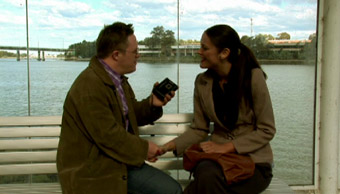
Be My Brother
Prior to a packed out industry drinks night in the foyer of the Chauvel Cinema in Sydney, Metro Screen showed a program of its 2008 short films, celebrating two wins in Tropfest 09.
In the whimsical The Last Cherry (director Lisa Kowalski; Raw Nerve program) a shoolgirl virgin decides it's time to have sex and hires a stud who turns out to be as innocent as herself. The encounter ends with sentimental hand holding—all this to the rousing accompaniment of “You're a dirty, dirty girl” and anxieties about herpes. Visually vivid and pop-videoish, and burdened with a taxing over-talkative voice-over, The Last Cherry works as either a naive or quite perverse take on the self-help film, wickedly creating more problems than it can solve.
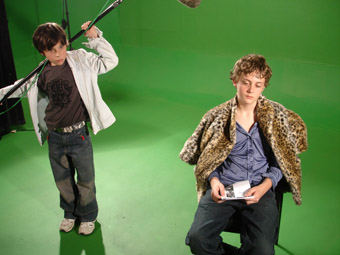
Dry Water
The 2009 Tropfest TropJr Winner, Dry Water: The Making of… (director 14-year-old Gabriel Colomb), is a droll mockumentary in which a self-obsessed film director, beret and all, alienates his initially loyal crew and much put-upon runner (“He wouldn't run, just jog!”). Director and crew are played by performers in their early teens, broadly aping adult behaviour and film industry stereotypes. The director's initial confidence becomes arrogance and finally despair, and there's no finished film to be seen—and no point to the making of 'the making of…” Dry Water is casual, confident filmmaking, produced during a Metro Screen Young Filmmaker school holiday workshop.
A Tenor's Tale (director Brendan Roberts as part of Certificate IV in Screen) is a straightforward documentary about a young man of partly Maori origin who rises from a despairing life on the streets of Sydney to a career in opera, finding his mother and extended family on the way. The singer's self-belief is almost overwhelming. His recommendation to 'just be yourself' in order to succeed doesn't altogether convince, given the nature of his former self (although we're spared the details). Instead of 'overnight success' myth making, A Tenor's Tale could have committed to probing just how the singer's talent was discovered, how he developed his voice and how his performances have been received. Instead we see him serenading tourists outside the Sydney Opera House. He certainly can sing, and the film is ably made, but begs a few too many questions.
This is 'Lexo' has been created from within a Sydney suburban community, Maroubra's Lexington Place, in a one-day filmmaking workshop. The participating youngsters ask older residents (two characterful men who hint at their prejudices and problematic backgrounds), young toughs and curious children their opinion of the place. Responses include: “bashings…just young guys on a mission”, “it's fun but violent” and “it's only Lexo, it's just a brothel.” The film's direct approach yields a rough charm and a sense of some very real people before the camera.
The highlight of the screening was Tropfest 09 Best Film, Genevieve Clay's Be My Brother, about a slightly uncomfortable bus-stop shelter encounter. A chatty, well-dressed young man with Down Syndrome irritates another young man while charming an attractive woman. On boarding the bus our charmer pays for and hugs the other man, who turns out to be his presumably embarassed but possibly loving brother. Economically staged and shot, and convincingly acted, Be My Brother manages to suggest much about its characters while generating both humour and tension. The film was funded by Metro Screen's Jump start program and Clay now has a Raw Nerve mentorship.
The screening selection on this Metro Screen industry drinks night revealed the various levels of ambition and accomplishment you'd expect as emerging filmmakers make their inevitably bumpy way to not just proficiency but insight and quality—some are well on their way, others are finding out just what it takes.
Metro Screen, Industry Drinks and Selected 2008 works: The Last Cherry, writer, director Lisa Kolwalski, producers Adam Marshal, Chantelle Robertson; Dry Water, The Making Of…, director Gabriel Colomb; A Tenor’s Tale, director Brendan Roberts, producer Amy Le Brocq; This is “Lexo”, crew Kel Henderson, Nioka Timberg, Afri Gregory, Tania Toman, Monica Gonzalez, Bowie Nash, Monica Nash; Be My Brother, writer, director Genevieve Clay, producer Eleanor Winkler; Chauvel Cinemas, March 3, http://www.metroscreen.org.au
RealTime issue #90 April-May 2009 pg. web
© Keith Gallasch; for permission to reproduce apply to realtime@realtimearts.net
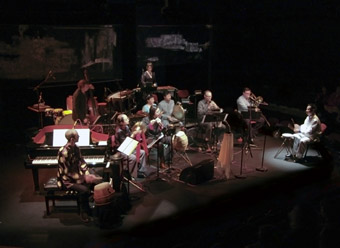
Clocked Out, The Wide Alley
photo Sharka Bosakova
Clocked Out, The Wide Alley
The bringing together of very different musical cultures in dialogue, juxtaposition or fusion can be challenging for musicians and audiences. While musicians are likely to enjoy a period of adjustment and assimilation, for the audience the experience can be a one-off, aural shock of the new.
If the audience is familiar with both cultures, fine, but that’s unlikely in the case of Clocked Out’s interweaving of the idiosyncratic traditional music of the oldest neighbourhood of Chengdu in China’s Sichuan province and the ensemble’s Western jazz and avant-garde roots. Doubtless there were Chinese members of the substantial audience in the Sydney Opera House’s The Studio for the concert who were conversant with all the idioms on offer; for the rest of us, it was a great adventure—the beginnings of an inner re-tuning. And we can further that new listening when Clocked Out release the CD of The Wide Alley they recorded shortly after the Sydney concert.
Clocked Out’s approach displays a meeting of forms across cultures and musical languages but also allows the musics of Sichuan enough time-space to stand on their own: in the presentation of traditional works, in re-framings of native classics and in wilder experimental fusions where traditional instrumentalists reveal how they can transplant their virtuosity to new terrains.
The sources for Clocked Out’s The Wide Alley are a mix of music of Sichaun opera percussion and street and folksong with which the company’s directors, Vanessa Tomlinson and Erik Griswold, have become familiar through visits to the region across a decade. They acknowledge particular inspiration gained from composer and national living treasure Zou Xiangping.
What follows is my humble attempt at recollection of some of the works from an engrossing concert. In Griswold’s lyrical and then bracing opener, “Da Dao Wu Wei” (Don’t just do something, stand there!), the flute (Shi Lei) dances little riffing runs with cymbals across electric bass (Robert Davidson) and a jazzy trombone (Adrian Sherriff) that slides growling to the depths and then soars, singing surprisingly high. After the stirring flights of flute and trombone, “Zhai Hai Tang” (Picking Begonia Flowers) introduces us to another remarkable instrument, the voice of Tian Linping. Griswold describes the distinctive local style as “a mix of high art with flutter tongue.” The effect is of a lilting, gargling trillgargling complete with astonishing glissandi in a composition replete with passages where flute and erhu (Zhou Yu) intricately entwine. The overall effect, aided by the singer’s smiling demeanour, is oddly reminiscent of the charm of Western light opera.
Impressionistic images of cyclists float on screens above the stage, pedalling serenely to Vanessa Tomlinson’s “Bicycle Groove/Moon Music/Beatrice”, in synch with Griswold’s typically dense but easeful pianism, some moody trumpet and the composer on drum kit driving the clockwork pulse.
In “Huangsi Pagoda”, the first of Two Poems of Du Fu, Tian Linping subtly engages with composer Griswold’s spare piano accompaniment, hovering between art song and jazz. Fragments of the lyrics such as “…tired and need the breeze…” are projected: The second poem, “Shu Lai” (Happy Meeting), is a traditional bamboo flute solo from Shi Lei with virtuosic glides that sound like a strange bird strikingly interrupting the dominant melody in a totally different key before the work resolves into a galloping jig.
Vanessa Tomlinson’s “Cotton Man” walks to the spare beat of a twanging bass to which hard-edged Chinese percussion, calls from the ensemble and replies from the trombone build complexity and volume until the whole ensemble has created a resonating epic of working life.
On the screen people dance slowly in western ballroom embraces; the erhu sings like a human voice; Griswold’s plucked piano and Tomlinson’s xylophone ratchet sweetly like a music box. Here, in “Er Quan Ying Yue” (Moonlight over Hui Spring), there are moments of delightful suspension. In another traditional melody, “A Bing Gan Hua Hui” (Enjoying the markets), Tian Linping’s voice and Zhou Yu’s erhu dance together and the entire orchestra soon becomes one, a unison celebration of spices, flowers, noodles…
Griswold describes “Chuanju Overture” (traditional, arranged by Zhong Kaizhi and Zou Xiangping) as a collage of all the styles of the region, including Sichuan opera. Built around gong and cymbals the work engenders rich textures from seemingly limited means, adding timber percussion, then skins, erhu and flute, long bass notes, a call and reply passage, and an epic march to the end. The beat is catchy but elusive; as Griswold declares, “the rhythms are unbelievably complex.” The orchestra is watchfully led, in traditional manner, by percussionist Zou Xianping.
Griswold’s version of the traditional tune “Di Da Kwa” (12 month story) celebrates the calendar and the influence of Clocked Out’s inspiration, Zou Xiangping. Each section of the work is given to a month and a corresponding activity: in January, play with dragon kites; in April, plant seeds; in June, start to use fans…The year unfolds, the pulse quickens, the sense of celebration endlessly escalating in glorious orchestral communalism.
For those of us familiar with the Australian Arts Orchestra’s dynamic partnerings with Indonesian, Indian and Australian Aboriginal musicians over many years, Clocked Out’s engagement with the musicians of Sichuan proved to be another heartening example of the great potential of such long-term, considered cross-cultural collabrations. The specifity of this collaboration—the focus on aspects of the Chengdu heritage—is particularly significant, the partnership giving longer life to threatened traditional forms. And the music sounds so very good, strangely familiar by the end of the concert as very different musical languages find common ground through the capacity of avant garde music and jazz to accommodate rhythmic complexities and alien modalities, and as traditional musicians willingly engage with the new.
Clocked Out, The Wide Alley, co-directors Erik Griswold (piano) and Vanessa Tomlinson (percussion), Robert Davidson (double bass),?Peter Knight (trumpet), Adrian Sherriff (trombone), Shi Lei (bamboo flutes), Tian Linping (voice), ?Zhong Kaizhi (percussion),?Zhou Yu (erhu),?Zou Xiangping (voice/percussion), design Sharka Bosakova, Utzon Music Series, curator Marshall Maguire, The Studio, Sydney Opera House, March 1, www.clockedout.org
RealTime issue #90 April-May 2009 pg. web
© Keith Gallasch; for permission to reproduce apply to realtime@realtimearts.net
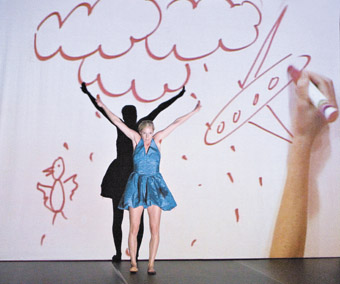
Kristy Ayre, Lifesize
photo Belinda: artsphotography.net.au
Kristy Ayre, Lifesize
LIFESIZE IS DEDICATED TO ANNA NICOLE SMITH AND DON LAFONTAINE. SO, CLEARLY, THE TITLE IS IRONIC. IF THERE IS ONE THING THAT THESE TWO NAMES STAND FOR, IT IS BEING LARGER THAN LIFE, WHETHER THROUGH DEED, IN SMITH’S CASE, OR THROUGH VOICE, IN THE CASE OF THE BARITONE SPLENDOUR OF LAFONTAINE’S MOVIE TRAILER VOICEOVERS.
Conceived by Luke George, Lifesize is a dizzying example of form as content. Taking on the vapid, electronic immediacy of popular culture, George and his collaborators have set themselves the outrageously far-reaching task of distilling more or less the entire postmodern lexicon. Naturally, the result is a multivalent pastiche of art forms, references, digressions and parodies. What remains relatively simple is the overarching narrative, an old-fashioned love story in the guise of a modern one. A man, Luke George, and a woman, Kristy Ayre, exist as individuals: they imagine themselves in a certain way; they imagine a potential lover in a certain way. These acts of imagination allow them to meet each other and to find themselves occupying a new imaginative realm transcending anything they could have imagined in isolation. It sounds complicated but this trajectory is nothing new; imagination has existed far longer than YouTube. What has changed is the degree of commodification.
Imagination is now more purchasable and externalised than ever. Imagined worlds and personas can be published and shared with no delay in gratification. In turn, this all feeds and is itself nourished by what is inadequately referred to as ‘celebrity culture’—it is, quite often, notoriety culture. The result is disposability, millisecond relevance and instantaneous feedback. So, the challenge for Lifesize is to be able to cannibalise this undeniably fascinating vein of material without itself being devoured in the process.
Lifesize begins very simply. Ayre is clad in a turquoise dress that, from a distance at least, looks like a taffeta high school dance affair. She stands demurely, facing slightly away from us; three standing lamps positioned to her side cast her in an unbalanced light. Her face is obscured, her shape seen in dramatic chiaroscuro. She begins to move a little more violently than the dress suggests is appropriate and when her face does appear her eyes are distant and disengaged. She turns on a video camera and steps in front of it. Positioned on the floor, the camera picks up her feet and legs. This live image is fed to a digital projector and shone on the full aspect of the rear wall.
The use of live cameras in performance always puts the audience in the dilemma of which to watch. In Lifesize, this dilemma forms part of the piece’s investigation of simulacra. Ayre is a perfectly watchable performer at any time, so why does the audience’s attention switch so readily to the screen? What the camera offers is, first and foremost, the opportunity to see what Ayre’s character wants us to see. Also, in a live performance, we as an audience are conscious of our physical presence and the barrier to invisible voyeurism that this puts up. When a camera is used as it is in Lifesize, our sense of seeing through the character’s eye serves to eliminate this corporeal barrier. We are removed from our chairs and placed inside the head of the character—the realm of psychology that is so important to filmmaking.
The sideways slant of the light still serves to obscure elements of Ayre’s body but in the camera’s gaze it is clear that this is part of her conceit, part of the image she is trying to manufacture, rather than any demureness. In a subsequent sequence, this coy bit of foreplay is exploded into an astonishing moment of faux amateur porn. As Barry White, slowed to a drawl, plays in the background, Ayre and George video grotesque close-ups of themselves creating lurid scenes with innocuous body parts—an elbow joint becomes a crotch with a moustachioed man eagerly licking, a hairy belly button becomes an improbably sexualised orifice that sings. To make fun of porn is nothing new, but to make porn truly funny is a very enjoyable achievement.
Lifesize gallops apace through references to dating services, Bindi Irwin, scrapbooks and tabloid magazines. At times, it skirts a fine line between professional exploration of subject matter and amateur infatuation, but this is part of the fun. To make something about pop culture, you have to know pop culture. And to know something you aspire to, as well as wish to explore, you have to like it. Luke George likes pop culture.
–
Lifesize, choreography Luke George, performers Luke George, Kristy Ayre, sound Luke Smiles, video Martyn Coutts, lighting Benjamin Cisterne, Dancehouse, March 12-13; Dance Massive, Melbourne, March 3-15
RealTime issue #90 April-May 2009
© Carl Nilsson-Polias; for permission to reproduce apply to realtime@realtimearts.net
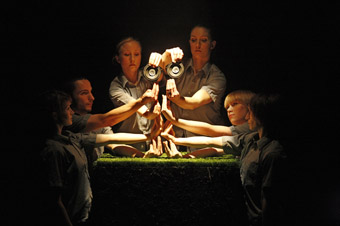
Laura Levitus, Derrick Amanatidis, Danielle Canavan, Kathryn Newnham, Holly Durant, Sara Black
photo Jeff Busby
Laura Levitus, Derrick Amanatidis, Danielle Canavan, Kathryn Newnham, Holly Durant, Sara Black
IN A FESTIVAL DOMINATED BY CHOREOGRAPHERS, ROGUE IS THE EXCEPTION—FUNDAMENTALLY A COLLECTIVE OF DANCERS. THAT IS NOT TO DIMINISH THEM OR THEIR CHOREOGRAPHERS, FOR THAT MATTER. BUT ROGUE’S TRILOGY OF SHORT WORKS, PERFORMED AS ONE SELF-TITLED PROGRAM, IS STAMPED WITH THE UNMISTAKABLE DEMOCRACY OF AN ENSEMBLE.
Byron Perry and Antony Hamilton, who are both dancers in Lucy Guerin’s Untrained, contribute their own choreographic turns for the first and second segments respectively. Compared with the fresh-faced members of Rogue, Perry and Hamilton must qualify as senior statesmen—with the exception of Harriet Ritchie, the ensemble all graduated from the Victorian College of the Arts in 2006. The concept and choreography for the third and final section of the night’s offerings are credited to the ensemble as a whole, with Sara Black and Derrick Amanatidis stepping up to direct their colleagues.
Perry’s work, A Volume Problem, begins with a spotlit box wrapped in fake grass. Crowded around the box are the seven dancers, their hands darting across the greenery and then retreating. Fingers become legs, become bodies, become mouths. The images fold out and back in dexterously until two protagonists arrive in the form of disrobed speaker cones. Individuated from their familiar box and mesh habits, the cones are easily anthropomorphised with their central circle suggestive of a monocular perspective. Given a set of finger legs and the ever-propelling beats of Luke Smiles’ sound design, the speaker cones soon find themselves bounding about on the grass in harmonious stereo.
It is a beginning that echoes, with a touch more ornateness, the opening moments of Elbow Room’s excellent There (Melbourne Fringe 2008; p40). And, just as in There, this micro beginning bursts out of its frame when the speaker cones disappear and their character is transferred into the larger bodies of the dancers themselves; the contained box stage giving way to the stage proper. The dancers have their hair pulled back in simple ponytails and are dressed in grey shirts and black pants that give them an appearance of anonymity, androgyny and austerity—the focus is on movement, not bodies. The dance itself is steeped in the waves and beats of sound, with Smiles’ mastery of drum and bass composition a vital player.
As solos, duets and ensemble moments come and go, the figurative language of Perry’s choreography remains intact. Each body produces a beat and concentric circles of sound waves that emanate, propagate and overlap with those of others. The result is interference, both constructive and destructive, that either amplifies or mutes one’s partner. Towards the end, Ritchie and Amanatidis solo in isolation and then come together, the beat becoming that of their hearts and the very specific form of propagation that this entails.
Hamilton’s piece, The Counting, does away with Perry’s austerity from the outset. The costumes by Doyle Barrow, fluoro leggings and thin white cotton singlets, sit somewhere between Merce Cunningham and an American Apparel advertisement. The dancers, who have suddenly been given gender and sexual presence, are accompanied by an amazingly slappy bass line and undulate in unison.
Yet, despite its grinding sensuality, there is something very formalistic in Hamilton’s choreography here. He tweaks and replays movements and gestures with a modernist sense of purpose—seeking nothing more than a rediscovery of forms, of shapes and physical textures. There is no narrative or psychology to speak of, nor any of the impish fancy that characterised Blazeblue Oneline (RT85, p35) or I Like This (a collaboration with Perry, RT89, p12). Not that this is surprising per se because, as a dancer, Hamilton has always seemed particularly entranced by the quality of movement and this explorative instinct has made him one of the most formidably gifted dancers in Australia.
The final part of the night’s program is named after the prankster sprite Puck, though the arcade-like set by Anna Cordingley suggests that the title may well reference the video game Shufflepuck as well. The twin associations work well together because the piece, especially created for this Malthouse season, is all about interactivity. The rise of video games as an artform and medium of entertainment has dubiously, though nevertheless firmly, entrenched interaction as a byword for contemporary. The concept in Puck is that the audience, equipped with various noisemaking devices can, with the sounds they create, prompt certain responses in the dancers: go back to the beginning, change places, wiggle while dancing.
The effect of course is utter mayhem. The audience is put to the test in deciding how disruptive or respectful they want to be. But a fundamental paradox is set up because it is the disruption that creates the elements worth respecting. The form is inherently messy and prone to somewhat facile conclusions—in the end, all that can be affected is the pictures we see as an audience. While there are moments of exaggerated emotion, it will be interesting to see if Rogue can develop this cheerfully enjoyable concept into something that extrapolates more on the relationship between the audience and the performers, between the eyes and the bodies, between what is liked and disliked, where the stakes are almost as high as they once were in the interaction at the Colosseum. That could make for some real mischief.
–
Rogue, A Volume Problem, choreographer, costume designer Byron Perry, composer Luke Smiles, original set construction Anita Holloway; The Counting, choreographer Antony Hamilton, sound design Pansonic, costume designer Doyle Barrow; Puck choreography, performance Rogue: Derrick Amanatidis, Sara Black, Danielle Canavan, Holly Durant, Laura Levitus, Kathryn Newnham, Harriet Ritchie; Tower Theatre, CUB Malthouse, March 11-15; Dance Massive, Melbourne. March 3-15
RealTime issue #90 April-May 2009
© Carl Nilsson-Polias; for permission to reproduce apply to realtime@realtimearts.net
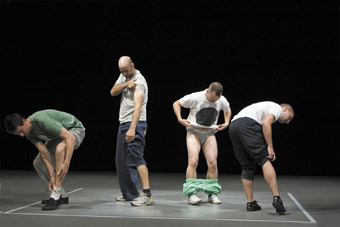
Ross Coulter, Simon Obarzanek, Antony Hamilton, Byron Perry, Untrained, Lucy Guerin Inc, photo Belinda: artsphotography.net.au
photo Belinda: artsphotography.net.au
Ross Coulter, Simon Obarzanek, Antony Hamilton, Byron Perry, Untrained, Lucy Guerin Inc, photo Belinda: artsphotography.net.au
THERE ARE PERFORMANCE WORKS THAT PLAY WITH AND DISORIENT THE SENSES—IN DANCE MASSIVE, SIMON ELLIS AND SHANNON BOTT’S INERT, THE HELEN HERBERTSON-BEN COBHAM MORPHIA SERIES AND CHUNKY MOVE’S MORTAL ENGINE; IN RECENT THEATRE, BARRIE KOSKY’S TREATMENT OF POE’S THE TELLTALE HEART. AT THE SAME TIME, GAME AND TASK-BASED WORKS FOR PERFORMERS AND AUDIENCES ARE ON THE RISE IN LIVE ART EVENTS AROUND THE WORLD, AND IN PROVOCATIONS SUCH AS PANTHER’S EXERCISES IN HAPPINESS AT THE 2008 MELBOURNE INTERNATIONAL ARTS FESTIVAL.
These phenomena resonate, on the one hand, with the immersive media arts and virtual realities of the 21st century and, on the other, with computer game playing and the ongoing surge of popular competition, from quiz shows to reality TV. With none of the latter’s dumbed down Darwinism, Lucy Guerin Inc’s Untrained benignly offers us reality dance—an extended set of tasks that pit two trained dance artists (Byron Perry, Antony Hamilton) against two visual artists (Simon Obarzanek, Ross Coulter)—revealing much about how we perceive the human body and what we think we know about dance.
The ‘reality’ of Untrained, however well constructed the overall work might be, is that the non-dancers’ lack of dance skills provides a considerable likelihood of risk and of chance happenings, moments of surprising verve and sheer failure. Nor are the tasks simple for the trained dancers: there’s a large quotient of improvisation and passages where they have to closely mimic the unpredictable moves of the untrained or interpret their choreographies. As much as these amuse, they’re also telling. The untrained pick up the broad patterns of movement, but rarely the detail (hinged on acute degrees of propulsion, balance and articulation), while the trained briskly realise additional layers of possibility.
So, instead of a finished dance work, we are witness to a series of revealing portraits and tests with a chancy, cumulative impact. Above all, we are implicitly asked to look very closely at, and listen to, these four men, our role as observers considerably heightened. This is accentuated by the spare staging—a large open space with a square marked out in the middle, a frame in which everything happens as soon as the men enter it from the queues they form either side. Initially, each man stands before us, motionless. We take each in. We’ll subsequently see these same faces, these same bodies again, at rest (as if asleep), pulling faces, making weird sounds, reading aloud comments they’ve made about themselves. Towards the end, each of them simply stands before us again, but now we know more about them—not a lot (this is not the confessional faction of reality TV), but details of physiognomy and assessments of mobility, risk-taking, engagement with each other and us. We have guessed at and largely learnt this not from the brief images of the men alone, but from their work together.
There’s even a moment where, with cards and textas, the men stand at the four corners of the frame and sketch each other’s faces, then show the results to the audience. In another, they display photographs of themselves, and elsewhere, videos they’ve directed. They even comment on each other’s dance and visual art capacities. But it’s the dancing itself which is most revealing. One after another the performers execute a move; as the image mutates the effect is of a visual Chinese whisper. More brief moves—balances, kicks, spins, painfully slow motion extensions—ensue and morph. Ross Coulter wittily removes his shoe and uses it puppet-like to mimic a slow motion fall while his body remains at rest. The tasks grow more demanding, if leavened with moments of yawning or sighing, or long jumps, or solo songs or speaking backwards, or performing favourite pop culture figures. The extended copying duets break the frame as each trained performer follows an untrained one around the space and then the roles are reversed—concentration, effort, surprise and amusement are palpable.
These competitive duets tell us much. Obarzanek tries very hard, he’s a bit of a performer (naturally inclined to dance when he sings in his emphatic baritone); Coulter is economical, more low key, laconic, if nonetheless committed. With the trained dancers the differences are subtler; theirs is an easy-going naturalism, the singing more polished, personalities less overtly expressed. Not surprisingly it’s their dancing which is telling: Perry’s spring-loaded, quietly dramatic articulacy, Hamilton’s sinuous, rippling intensity.
As well as the duets, there’s recurrent group work which comes affectingly into its own at the end—where you find yourself wishing that there’d been more of it, as big a demand as that might be. In the course of the show, the group moans, cries and, among other things, demonstrates various, revealing techniques for removing and putting on t-shirts. Above all the men collectively convey an undemonstrative competitiveness, mutual empathy and good humour as they perform their long list of tasks, while the audience doubtlessly reflects on what its own dance abilities might be in the same circumstances.
Perhaps, too, the audience think about the pleasure of witnessing a benign image of men collaborating and competing without corporate, militaristic or sporting straitjacketings. However well or not they can dance, these men flow, as Klaus Theweleit put it in his anti-fascist classic Male Fantasies (1977), and the sense of them as real and complex, beyond artifice, is rooted in the lucid pragmatism of Guerin’s task-based formulation for Untrained.
–
Lucy Guerin Inc, Untrained, concept, direction Lucy Guerin, performers Ross Coulter, Antony Hamilton, Simon Obarzanek, Byron Perry, music Cusp by Duplo Remote, producer Michaela Coventry; Arts House, March 11-14; Dance Massive, Melbourne, March 3-15
RealTime issue #90 April-May 2009
© Keith Gallasch; for permission to reproduce apply to realtime@realtimearts.net
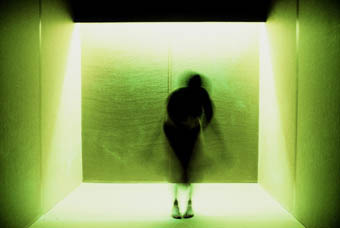
Helen Herbertson, Morphia Series
photo Rachelle Roberts
Helen Herbertson, Morphia Series
OVERHEARD AUDIENCE MEMBER AT DANCE MASSIVE EVENT: “I DON’T KNOW ABOUT DANCE; I’M SAFER IF THERE’S A TEXT. OTHERWISE I FIND MYSELF INVENTING NARRATIVES. I WATCH A DANCER MOVING AND I THINK ‘WATCHFULNESS’, THAT’S WHAT IT’S ALL ABOUT. BUT I KNOW IT’S NOT THAT AT ALL!”
In Morphia Series, Helen Herbertson and Ben Cobham offer text as well as everything else but audience members searching for meaning might find themselves in the same cul de sac.
I experienced an earlier work in this series a decade ago at Performance Space in Sydney. In that version (which is with me still), the audience was separated from the performer in her yellow stage box by Ben Cobham hovering over a slide projector, placed between us. In this new version, the technology has progressed considerably, such that no lighting source is visible and we, the audience, are totally in the artists’ hands. I won’t give the game away by revealing how this works—surprise is part of its magic. Suffice to say that the relationship between performer and audience here is crucial and echoes the matter of the work (rather than the meaning) stated in the program as “working with the notion that life hovers somewhere between the ordinary and the metaphysical.”
Of the dancer’s movements I remember only fragments. They are pedestrian but equally, earth shattering. There’s geometry but no patterns, no obvious displays of skill or prowess—if you don’t count navigating the unconscious. There’s a feeling that something crucial is on the tip of the tongue. What pervades is the atmosphere, the sense of being elsewhere. When you leave the room after the 18-minute performance, it feels like crossing a border into another country. A friend greeting me as I emerged reported on a kind of collective double take amongst departing audience members. As they left, he said, they each took three steps through the door, dipped their heads, looked up, blinked and then moved off.
In the first sequence, we see Herbertson at a distance and hear her recorded voice uttering a poetic text to do with a dream of Estonia (was it?). A fine white mist appears in the yellow box. Movements from the silhouetted dancer are at first deliberate as if being slowly recovered or performed without full consciousness. At one of many illusory moments an arm becomes a serpent. Stabbing gestures mirror explosive, whipping sounds.
Next comes a dream of place, faintly familiar to me, featuring my own fantasy of the perfect living space in which human and nature are separated only by glass and inside there’s nothing to bump into. The black clad silhouette moves with the same minimal gestures feeling her way as she imagines the space into being.
In the third sequence, the text is of a vision, a body leaving its marks on nature. Were there hooves? Whatever is being said is over-ridden by the strange power of the dancer’s gaze. I remember no movement save turning, and Herbertson’s now entirely vulnerable features facing us squarely while she remained elsewhere, as if clothed in memory.
Just as shadows from the earlier incarnation of this work have stayed with me for a decade, this new work takes its place in my own unconscious. Searching for comparisons, what surfaces the morning after Morphia is the sharp memory of an hour in the Rothko Room at the Tate in London in 1997, gazing into the deep colours of the huge canvases, overtaken by an enveloping sensory reverie.
–
Helen Herbertson and Ben Cobham, Morphia Series, design concept Ben Cobham, Helen Herbertson, performance, text, sound concept Helen Herbertson, lighting Ben Cobham, sound compile David Franzke, morsels John Salisbury; Arts House, North Melbourne Town Hall; March 10-15; Dance Massive, Melbourne, March 3-15
RealTime issue #90 April-May 2009
© Virginia Baxter; for permission to reproduce apply to realtime@realtimearts.net
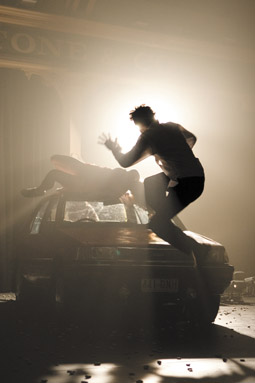
Roadkill, Splintergroup
photo Belinda: artsphotography.net.au
Roadkill, Splintergroup
TANZTHEATER IN AUSTRALIA—SAVE FOR MERYL TANKARD AND SHAUN PARKER—IS THE DOMAIN OF SPLINTERGROUP AND PRODUCER DANCENORTH. THEIR VISIT IS A RARE TREAT FOR THE EUROPE-FRIENDLY PALATE.
Theirs is a dance grounded in the world as we know it: it transpires with sex, with physical violence, club music, everyday clothes and places, everyday emotions, everyday torpor. It is a dance resolutely post the abstract, monochrome modernism of Russell Dumas’ Dance Exchange, and with no patience for either the intimist slowness of Michaela Pegum, or the anti-spectacular navel-gazing of The Fondue Set.
From Sweeney Todd to the Grand Guignol, horror in theatre has a long and respectable, if forgotten, history. The stage, balancing its semiotic inevitability of real, material signs (chairs, lights, bodies) with a necessarily abstracted construction of situations, is a strong place from which to wildly associate gestures and events with submerged fears. As Hans-Thies Lehmann puts it, the signifying nature of theatre points to the constitution of meaning in general.
Dance Massive, coincidentally yet appropriately, is teeming with monsters. We have the slick, almost romantic spectacle of haywire eugenics in Mortal Engine. On the other end of the theatrical scale, Jo Lloyd’s one-man short, Melbourne Spawned a Monster, is a delicious attempt at a Penny Dreadful in 2009, and achieves sublime, almost tragically alienated banality. Originally danced by Lloyd, the choreography sits uneasily on Luke George’s body, hips swinging and shoulders circling into a feminine figure only to grow into the Hulk-like, psychotic body of a monster. The intimate relationship with abstraction that contemporary dance has cultivated allows for the full effect of these figurative disharmonies to be experienced.
Roadkill, our third horror-show so far, instead opts for the cinematic road. It possesses both the manic rhythm of a music clip and the tactile, solid mise-en-scène of film, grounded with some very heavy props: a phone booth and a car. Twisting mundane reality into pop-cultural hallucinations, Roadkill wouldn’t look out of place in David Lynch’s oeuvre. It edits and furiously remixes cinema language recreated on stage: bodies twist in slow-motion, car crashes rewind, sounds cross-fade; even panning and zooming out into a panoramic shot are achieved, the latter with some clever use of miniatures. The result is hyperreal: an impossible, yet undeniable, assemblage of scenarios.
Opening with a couple stranded in the outback, waking up in their broken-down car to birdsong and increasing paranoia, Roadkill rummages through every commonplace fear we are taught to cultivate, from rapist strangers to hitch-hiker murderers. Yet each progressively more surreal scenario hiccups back to the initial moment: after each fantasy catastrophe the couple wakes up again.
Roadkill was developed with the assistance of Sasha Waltz and Guests (p10), while Gavin Webber’s company has cultivated a style imported almost verbatim from his training with Ultima Vez, and the two influences clash without merging. The aggressive, 1990s MTV cool of Ultima Vez sits in the uneasy company of hysteric banality reminiscent of Waltz’s early works. Consequently, Roadkill attempts two conflicting types of dramaturgical progression. On the one hand, there’s the realist descent into hard-edged, psychological horror, as movement slows down into gripping narrative sequences eschewing dance, gesture or certainty for suspicion, double-edged hints, and short circuits of frightened imagination—theatre outweighs Tanz.
When Grayson Millwood, the stranger danger, appears out of nowhere, Sarah-Jayne Howard locks herself in the car, brimming with unspoken fears. Millwood and Webber’s conversation mutes, the microphone amplifies the sound of Howard’s car-bound breathing. Avoiding psychological profiling, Roadkill utilises the full range of horror devices at its disposal: from thundering, seat-vibrating beats; unreliable sources of light (at times reduced to a torch flickering towards the audience); repetition of uncertain scenarios with variation and other intrusions in linear time; Luke Smiles’ impressionist soundscape; overheard fragmented conversations; to moments when the only certainty is the enormous fear of the characters, mirrored, medusa-like, back on the audience.
On the other hand, Roadkill slides laterally into surrealist comedy of absurd, brainstorming exaggerations: the first stranded morning escalates into an anatomically improbable backseat romp; a car chase is illustrated with Webber and Howard running past with trees, road signs and dead animals. An argument between the couple is interrupted by a rain of pebbles. When gravity changes direction, Webber prevents Howard’s dead body from flying away with a pile of stones, while Millwood hovers upside down in a phone booth. Moments later, he appears, hanged by the phone chord, in a strange descent back into horror.
As Mortal Engine’s abject images demonstrate, terror resides in the least defined, least certain. Filmic attention to detail works against desired effect in Roadkill, and the production labours very hard to make strange without resorting to abstraction. To suspend reality, every hyper-real moment needs to be contradicted by another; every movement forward by an inexact rewind. The strongest moments of the performance are precisely in the pauses, uncertain junctions of dramaturgical sway, U-turns of stage action: Webber driving a toy car over Howard’s prostrated body, or a long, ambiguous duet between the two men, their mirrored motion broken by outbursts of aggressive collision. Which one is the other’s fantasy becomes unclear, as they spin against each other’s neck, shoulder or waist in Vandekeybus-like, energetic contact work. Having spun in rewind over the car bonnet, Webber and Howard comfort each other in dreamlike, decelerated grief. Which one, if either, is dead, we are left to wonder.
Without anchoring wildly imaginative hysteric outbursts in myth or psychology, Roadkill struggles to find its emotional gravitas. The result is a highly palatable comedic horror, an upbeat and furious montage of improbabilities.
–
Splintergroup, Roadkill, choreographed and performed by Gavin Webber, Grayson Millwood, Sarah-Jayne Howard, composition, sound design Luke Smiles/motion laboratories, dramaturg Andrew Ross, lighting designer Mark Howett, Bluebottle, producers Brisbane Powerhouse, Dancenorth, toured by Performing Lines for Mobile States; Arts House, Meat Market; March 5-8; Dance Massive, March 3-15
RealTime issue #90 April-May 2009
© Jana Perkovic; for permission to reproduce apply to realtime@realtimearts.net
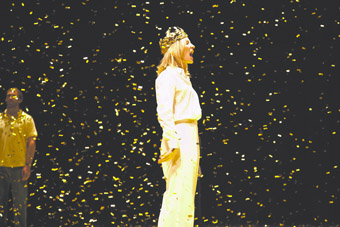
Cate Blanchett (Richard II), The War of the Roses, Sydney Theatre Company
photo Tania Kelley
Cate Blanchett (Richard II), The War of the Roses, Sydney Theatre Company
THE STANDOUT PRODUCTION OF THE 2009 SYDNEY FESTIVAL WAS THE SYDNEY THEATRE COMPANY’S THE WAR OF THE ROSES, A MAGNIFICENT CONFLUENCE OF VISION, SKILFUL EDITING, DIRECTION, ACTING AND DESIGN. IT WAS ALSO THE LAST PRODUCTION FROM THE STC ACTORS COMPANY (WITH GUESTS CATE BLANCHETT AND ROBERT MENZIES). WHAT FOLLOWS IS NOT A REVIEW SO MUCH AS AN EXTENDED APPRECIATION IN THE SPIRIT OF THE PRODUCTION, IN AN AGE IN WHICH REVIEWS (ONE OR TWO SIGNIFICANT BLOGGERS ASIDE) GROW SHORTER AND SHORTER AND THE CONVERSATION DIMINISHES.
act one: part one: richard ii
The stage heavens gently snow gold leaf over the court of Richard II (Cate Blanchett), a simple tableaux of seated king in elegant white slacks and shirt and modest golden crown, facing the audience; behind him an ordered array of courtiers and the lords-at-odds, Bolingbroke (Robert Menzies) and Mowbray (Steve Le Marquand), all in modern everyday dress, quite unglamorous, look out at us, expressionless. But the gold! It utterly fills the vastness of the undressed stage; it mesmerises; it engraves the scene in the mind; it undoes perspective; it suggests a paradise; it never stops.
Here is a king, firmly in control of rancorous subjects, demanding ceremony and obedience, and stillness. Some seven hours later, and several generations of English history on, it snows again over the same bare stage, this time dressed with the very real swings and roundabouts of a children’s playground, the domain of an utterly unceremonious Richard III—and this snow, now ash it seems, turns to deep slush around the bodies of the victims of civil war and its consequent tyrannies. This is the dark, descending arc of the Benedict Andrews-Tom Wright adaptation of eight of Shakespeare’s histories, a decline into the brutal genius of dumb tunnel vision that resonates (broadly here if not literally) with the Bush-Howard-Blair war on Iraq—our civil war, after all, on ourselves, our civil rights and consciences, where we become subjects again, instead of citizens. Pointedly, this production is titled The War of the Roses, the Wars of history reduced to one.
Between Richard II and Richard III of the House of York come the usurper Henry IV and his heirs, Henry V and VI of the House of Lancaster. Between the gold and the slush, there is civil war, war on France (and brief peace at home under Henry V) and then civil war again—bloody murder, here another form of ritual and play. In Henry VI, when the war begins in earnest, red liquid is swigged from plastic bottles and sprayed from the mouths of killers (a variation on the repeated insult of spitting) over their victims, followed by dusting with handfuls of flour. The true artist of this mortification is the soon-to-be Richard III (Pamela Rabe), casting spell-like clouds and arches of white around and over his victims. This Richard is a devious, malicious, loping child who, in the final act of The War of the Roses, chats with child performers in the playground: children witness to, even complicit in, his evil.
But the beginnings of this descent into disaster are already evident in the apparent paradise of Richard II, in another kind of childishness. Richard is kingly in manner but ultimately not in effect. By turns he appears distractedly interior, indifferent, flippant, callous and, worst, petulantly unpredictable. His sudden laughter is loud and inappropriate—as if mocking the passion of others or crudely covering for his possible complicity in the murder of the Duke of Gloucester. His elegance belies immaturity: impulsiveness and a failure to read his subjects lead to serious miscalculation. Instead of allowing Mowbray and Bolingbroke to resolve their quarrel in a chivalric joust he exiles both, but unequally—Mowbray for life, Bolingbroke for 10 years, then for six. On the death of John of Gaunt (John Gaden), Bolingbroke’s father, Richard is stupidly opportunistic, seizing all the old man’s property—Bolingbroke’s by right—and thus creating the grounds for insurrection that will see Bolingbroke become Henry IV and Richard dead—murdered by mistake or impulse, just as he had ruled.
Blanchett’s Richard is spellbinding. Still, authoritative, explosive, in control again, for the time being. We don’t witness the much reported, indolent gregariousness of the king: that is a given here in her detachment from the court with whom she resolutely refuses eye contact. Blanchett’s Richard is a loner at court, unlike, say, Fiona Shaw’s restless, fey Richard, directed by Deborah Warner for television in 1997, always in the arms of her courtier-hangers-on, passionately kissing her antagonists. Blanchett’s steely distancing and Andrews’ formal staging means we can believe in this king and be shocked when he errs. In this tautly edited version of the play, the focus is firmly on the personal trajectory of Richard from king to prisoner, a near tragic fall. So convinced of his right to be king, Richard cannot believe an insurrection is unfolding. But then the rain of gold, the golden reign, finishes abruptly, without ceremony: stage hands and actors with brooms and leaf-blowers drive the tiny, shiny rectangles into a deep pile at the back of the stage, an abject Richard in its midst. Fullness becomes extraordinary emptiness. When removed, Richard’s crown empties its accumulated, fallen gold. It is hollow indeed.
Soon Richard will surrender the crown to Bolingbroke, but it will be a deeply painful process, representing the push and pull between profound belief in his kingship, not just as divine right but as the core of his being, and emptiness, a doubting self. He demands his deposers understand what his giving up of the crown means. But this is the same man who failed to find compassion for Mowbray’s plea not to be separated from the language of his being—English; or the ageing Gaunt’s for the loss of a son he would never see again to exile (both speeches wonderfully delivered by Le Marquand and Gaden with passion constrained by the formality of the court).
In the end, Blanchett moves Richard beyond pathos, pushing him as close to tragic insight as possible as he struggles with an existential bind. When he calls for a mirror, he sees himself, not a king, smashes it to the floor and walks through the splintered fragments, littered, of course, with the last of the gold leaf. Blanchett fully realises the shock, anger and despair of a dislocated identity (“Thus play I in one prison many people,/ And none contented), a condition played to the very end with the requisite mix of ceremony (the surrender litany of “With my own tears…”), bitter irony (“I have a king here to be my flatterer”), self-awareness (“I find myself a traitor with the rest”) and too eloquent self pity. Blanchett give us all of this. Richard’s killer then empties gold leaf on him, like so much trash.
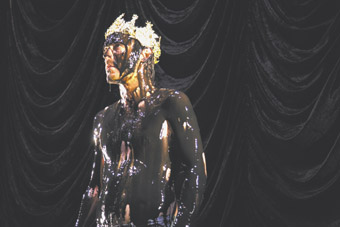
Ewen Leslie (Henry V), The War of the Roses, Sydney Theatre Company
photo Tania Kelley
Ewen Leslie (Henry V), The War of the Roses, Sydney Theatre Company
act one, part two: henry iv, henry v
The obdurate, aloof Henry IV is beset with, first, civil war which has prevented his planned atonement for deposing Richard—a pilgrimage to Jerusalem—and, second, a decadent son, Harry (Ewen Leslie) in the thrall of Falstaff (John Gaden). Henry appears to be ill, holds himself tight, almost stooped, as if, in Robert Menzies’ playing of the king, he is perpetually gripped by anger, disappointment and guilt—no mere bluff, pragmatic statesman but a wounded man who must push every word out into the world with effort.
Henry is still angered by the memory of “that skipping king”, Richard II, his undoing of the kingdom, and his son’s likelihood of doing the same. His lecture to Harry on how to play king is paralleled by a game that Harry plays with Falstaff, reversing roles of king and prince. Ironies abound: the bad father, Falstaff, has taught Hal (the older man’s name for the prince) much about people, in the way the king has not. Gaden seems at first an unlikely Falstaff, but just enough naked paunch, a flagon of malmsey, a blushing nose and broadened voice truly maketh the man. The relationship with Hal is very real, fluid, familiar, and momentarily if rather functionally sexual—Hal gives Falstaff a blow job, and dribbles the cum almost over the front row of the audience (already littered with gold). The sex seems almost incidental, but integral no less when we later witness Henry’s death struggle with Hotspur (Luke Mullins) and the courtship with Catherine of France (Mullins again, in falsetto).
For all his pragmatic wisdom about kingship, Henry IV fails, like Richard II, to see what is before him, thinking the chivalric Hotspur a better ‘son’ than his own. He does not recognise Mullins’ lithe, eager, feckless Hotspur as a challenge to the throne. Harry will, unnoticed, kill Hotspur, saving his father in a strange tussle (like bears wrestling on hind legs, with a convulsive, sexual shuddering). The kill is then claimed by Falstaff, and Hal lets that pass. not yet ready to reject the man.
As in Richard II, the editorial focus closes in on duets: here it’s Prince Henry and Henry IV at odds and in conciliation; Hal and Falstaff at play; Harry and Hotspur in battle. The deathbed exchange between the dying Henry and the prince is particularly affecting with its errors and accidents of judgment and perception. Harry, thinking his father dead, takes the crown; the waking Henry accuses him of virtual patricide. However, an underlying warmth between the two struggles to the surface in this finely played scene. They become one and the succession is guaranteed, by inheritance if not divine right and Harry’s promise of personal reform. Finally, there’s the rejection of Falstaff: Hal, now King Henry V, adds to the pain by spitting on the old man. These intense duets are interspersed with the brutal horrors of rebellion, antecedents to the protracted war in Henry VI.
There is another duet, unspoken, unacknowledged and principally between the king and a musician. Henry IV is given the sparest of stagings: an undressed stage and on it a lone, young electric guitarist (Stefan Gregory) with amplifier and foot pedals faces away from us and plays a long, raw solo we can’t ignore but which does not mess with the words. It grows in complexity and thickening harmonies, becoming beautiful, an eloquent dirge for the sad life of a guilty, disappointed king who bequeaths just enough stability for his son to succeed.
Ewen Leslie’s Prince/Harry/Hal is one of the remarkable character creations in The War of the Roses, a boy-man visibly crippled by his decadence—the hint of a limp, twitching when tense, a cough—but with an ennabling common touch, wit and the capacity to listen. He learns to play king, drawing from the lessons of both his fathers, Henry and Falstaff, without duplicating their weaknesses, if carrying within pain and doubt.
In Henry V that sense of woundedness we saw in Harry is sustained in a radical account of the play in which an ornate rust-red curtain is lowered downstage. There the play’s Chorus prefaces each of a series of solo speeches by the king. Henry performs without grand eloquence or heroics; there is no crowd, no army, just us, whom he addresses with a quiet, heartfelt intensity. First he appears covered in honey and glitter; then, as he invades France and his troops fall prey to bad weather and illness, he is coated in black oil; then as battle and victory ensue he is drenched in thick red blood. As with the falling gold in Richard II, a single, sculptural device in Henry V, a series of still, painted bodies of one man against a stage curtain (for that metatheatrical, most-chorused, pageant of a play) rivets our attention to a man playing the role of king with the utmost determination while something deeper, unspeakable within, quivers. The curtain rises, he is slowly washed clean for his courting of Katherine of France.
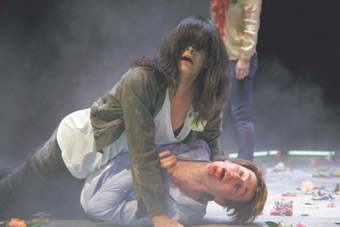
Pamela Rabe (the soon-to-be Richard III in Henry VI), Luke Mullins, The War of the Roses, Sydney Theatre Company
photo Tania Kelley
Pamela Rabe (the soon-to-be Richard III in Henry VI), Luke Mullins, The War of the Roses, Sydney Theatre Company
part two: act one: henry vi
If in Richard II and Henry IV, Andrews and Wright fix closely on their kings and the immediate dynamics of intimate if difficult relationships, and let those flow on to underscore Henry V’s solo turn, the challenge of Henry VI is quite something else. This act draws on three of Shakespeare’s plays in which the king, Henry VI, figures relatively little (the actual Henry became king at nine months, suffered mental collapses in the course of his 50 years, was sometime ruled by his warlike wife, Margaret of Anjou, founded colleges, including Eton, was in and out of power and finally murdered). But here he is central to the realisation of this part of The War of the Roses. It’s as if we witness the decline into civil war through his eyes and, sometimes, ears. It’s a reminder, too that Shakespeare would have known that the real king was found alone, distracted and unattended at the end of two major battles. Here, Henry wanders the battlefield seeing a father who has unknowingly killed a son, and vice versa—here the reversal is played by the same performers, adding to the sense of Henry’s, and increasingly our own, delirium.
This Henry VI is an autistic youth in a garden—a rectangle bordered by floor level fluorescent light tubes and awash with cut roses of many colours. It is here that the dispute between the Houses of York (white rose) and Lancaster (red rose) becomes full-blown and murders soon escalate into a rapid series signalled by digital readout suspended over the stage (“The Killing of York” etc). Thus three long plays become one briskly told tale about a tottering, giggly Lancastrian king, who suffers fits. His power is in the hands of the Duke of Suffolk (Steve le Marquand) who chooses for the king a wife, Margaret of Anjou (Marta Dusseldorp). She and Suffolk mate like playful dogs. Then Henry finds himself governed on the one hand by his wife and on the other by the Protector, the ambitious Duke of York (John Gaden), whose sons include the future Richard III. Tensions in the court mount, but they are beyond Henry, and us with him. In one passage, composer Max Lyandvert’s score calculatedly drowns out everyone’s words, as if Henry is lost in iPod land. He slips in and out of awareness, laughing when Suffolk is murdered, alert to the tell-tale extremity of Margaret’s grieving, amused when his brattish cousins buffet and kiss him in act of false fealty.
Henry’s world is increasingly a nightmare: the blood spray murders multiply, cruelties abound (York’s infamous offering of a napkin to damp tears when the very cloth is stained with the blood of his victim’s beloved); York’s sons play with bodies; roses are stacked high, like the gold become rubbish in Richard II. A cycle of vengeance spirals out of control, victims and murderers rise up to repeat themselves; a half dozen Margarets of various ages and genders appear across the stage; her son Edward is murdered by the soon-to-be Richard III. She washes Edward, as he stands before her (as the dead do here) but with blood, which will never clean the horror she too has unleashed. Richard murders Henry in a cruel disabling, severing the neck from behind. The last Lancastrian king is dead, Edward IV of York rules, the war is, in a way, over. Now Richard will eliminate members of his own family.
Amidst the horrors of the war, Henry VI remains a simple figure, Eden Falk affectingly conveying the varying degrees of innocence, detachment, horror and guilt (that he might be a cause of all this), with the body language of an undeveloped child. Gaden’s Duke of York is frightening in his growing resolution, Marta Dusseldorp is a relentless then distressed Margaret, Pamela Rabe emerges from the shadows as Richard, just another one of the boys, but much more dangerous.
part two, act 2: richard iii
The grim, wintry playground of Richard III is peopled with children, idle ghosts and those soon to be added to the dead as Richard play-acts and murders his way to the throne. Pamela Rabe’s idiosyncratic Richard is a lumbering adolescent attired in baggy clothing that obscures his hump while a mass of hair frequently hides his face if not his perpetual amusement. Rather than sharing his self-justifications and strategies principally with us, his confidantes, he spreads them about amiably, offering them to his playground fellows. He plays a game of murder with one child; both are delighted to have fooled us.
Richard is persuasive in his seduction of Anne (her dead husband, Edward IV, Richard’s victim, lies nearby buried in ash) but without ever losing his casual boyishness. Blanchett responds with the requisite anger but then a sense of astonishment that this could be happening, followed by grim acceptance, as if it is best to play along. Soon, true to the stark realism of this rendering of Richard III (no spraying of blood here), she hangs herself from the swing.
This Richard is greedy not just for power and the fun of the chase, but for food, tearing into a chicken with his fingers while planning his worst. Deceptively casual and slow, he soon moves dangerously fast. He springs into a cock-like strut (“I am not in the giving vein”) when turning on his partner-in-play-and-crime, Buckingham who is astonished at the sudden escalation of events—the murder of the princes in the Tower. Richard’s end is likewise near as Henry Tudor (a descendant of the House of Lancaster’s John of Gaunt) and army approach. Richard III’s state of mind at the end, like Richard II’s, is complex, here a momentary but deeply felt oscillation into fear and self-pity before a re-assertion of will. Defeated in battle, fallen, he slowly reaches out to Henry Tudor, offering the crown in what looks deliciously like a mocking invocation of Richard II surrendering the very same crown to Bollingbrook. Has the war finished, or another usurper of the same house taken the throne? At the end of The War of the Roses, a child stares out at us from an ashen landscape, the instruments of play draped in funereal black. A war has made malicious children of men and women and, true to Shakespeare’s vision, revealed the sheer fragility of sovereignty.
The Richard III with which Rabe, Andrews and Wright intrigue and fascinate us comes as a very real surprise after generations of rather like-bodied and minded villains. This murderous child may test the already limited but critical empathy that we feel for Richard at the end, but as the final part of a trajectory of increasing childishness from Richard II’s immaturity on, through Henry V’s delinquent youth, Henry VI’s naivety and York’s murderous sons, this Richard is an apt creation, not least because in our world children, willing or not, have increasingly become warriors. There’s also much of the victim child in Richard’s rationalisations. For all his assertiveness and defiance he sees himself as cheated, deformed by nature and by witchcraft and has turned this anger out on to the world with all the rational cunning of a psychotic. But, as with the other kings in The War of the Roses, we glimpse in this man disturbing moments of insight and complexity, the warring elements of the un-singular self.
whose world?
To achieve their vision of a kingdom’s inexorable decline into civil war, to present Shakespeare’s disparate body of history plays as one and to focus principally on the men who wore the crown (and only their immediate allies and antagonists) has meant Andrews and Wright have had to reduce the vast world of these plays (some 30 hours of stage time if you did them all), sweeping aside bishops, whores, taverners, mayors, mercenaries, ambassadors, popular rebels and petty criminals, and Joan of Arc, all part of the great canvas of Shakepseare’s innovation. It’s a large price to pay, but a small one too for the great achievements of The War of the Roses—the rigour and persistence of its vision across near eight hours, the sheer power of its ensemble playing (sadly, the last of the Actors Company productions) and the memorable, virtuosic and emotionally complex performances from Cate Blanchett, John Gaden, Ewen Leslie, Pamela Rabe, Robert Menzies and others. The descent into death of a kingdom and its people, so emblematic of The War of the Roses, resonates acutely with today’s states of war. It is brilliantly counterpointed with the production’s fidelity to Shakespeare’s skill in evoking psychological complexity and testing an audience’s capacity for empathy for these flawed kings and their families.
Sydney Theatre Company, The Actors Company, The War of the Roses, William Shakespeare, adapted by Benedict Andrews, Tom Wright, director Benedict Andrews, performers Narek Armaganian, Cate Blanchett, Brandon Burke, Peter Carroll, Marta Dusseldorp, Eden Falk, Holly Fraser, John Gaden, Louis Hunter, Michael Kilbane, Ewen Leslie, Steve Le Marquand, Haley McElhinney, Amber McMahon, Robert Menzies, Pamela Rabe, Emily Rusell, Billy Shaw-Voysey, Leo Shaw Voysey, set designer Robert Cousins, costumes Alice Babidge, lighting Nick Schlieper, music & sound design Max Lyandvert (Act 2, Part 1), musician and original music Stefan Gregory, Sydney Theatre, Jan 9-Feb 14; Perth International Arts Festival, Feb 27-March 12; www.perthfestival.com.au/theatre/waroftheroses
RealTime issue #89 Feb-March 2009 pg. 4-5
© Keith Gallasch; for permission to reproduce apply to realtime@realtimearts.net
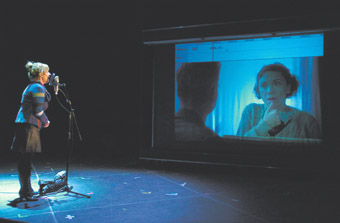
Frederike Bedard, Lipsynch, Ex Machina
photo Erick Labbé
Frederike Bedard, Lipsynch, Ex Machina
ALTHOUGH THE GLOBAL ECONOMY WAS IN STEEP DOWNTURN AND THE SYDNEY FESTIVAL WAS FEELING SOME OF THE CRUNCH, THERE WAS STILL MASS DANCING IN THE STREETS, LED BY GARRY STEWART, THE FONDUE SET AND OTHERS IN THE CITY ON THE OPENING NIGHT. WHEN WE ARRIVED AT THE HUMBLE ABRAHAM MOTT HALL IN THE ROCKS WE FOUND THE CO-DIRECTORS OF NEW YORK’S NATURE THEATRE OF OKLAHOMA MAKING US WHITE BREAD SANDWICHES—CHOICE OF PEANUT BUTTER AND JELLY OR HAM AND CHEESE WITH MAYONNAISE OR MUSTARD—AND THROWING IN A CAN OF DIET COKE OR A DR PEPPER. THESE WERE INCLUDED IN THE TICKET PRICE, BUT THERE WAS FOR A MOMENT A HINT OF THE BREADLINE, ACCENTUATED BY NATURE THEATRE’S LOW, LOW BUDGET FOUR-HOUR PRODUCTION, NO DICE, PERFORMED IN ALMOST OVERWHELMING, HUMID SUMMER HEAT. HERE WAS A SHOW THAT, UNLIKE CHRISTOPHER WHEELDON’S STRAITJACKETED MORPHOSES BALLETS, REALLY DANCED, IN WORD AND BODY.
Although No Dice yielded exhilarations and profundities that could not be approached by Lipsynch, the nine-hour Robert Lepage production also danced when it was not locked into an increasingly silly melodrama or hamstrung by superfluous effects. The complexly integrated set, operated by a huge team of visible stage hands and technicians, turned itself inside out and rotated in a waltz of overlapping lives and cultures, homes, hospitals and sound and film studios. Best of all was Lipsynch’s attention to sound and listening—the match, or not, between voice and body, the mismatch between seeing and hearing, the aural trickery of filmmaking, the loss of voice to a tumour and its recovery through song, and much, much more. In one scene we witness a female employee dealing with night-time customers in a bookshop. We see her though the window; we can’t hear what is said. We know she’s recently been released from psychiatric care. Outside the shop we see the two ghosts that haunt her, demanding her attention. She seems to ignore them, but we wonder if she is coping at all well with her customers. The set turns and we watch the whole scene again, hearing what is said. We wait anxiously for the ghosts to appear. They don’t. And what we hear contradicts all our expectations and projections. Here is a woman on the way to recovery, returning to engagement, listening and poetry. If only Lepage had applied this approach to his Dickensian plotting, where creaking predictability and deterministic Roman Catholicism make a saint of a Nicaraguan victim of the sex slave trade, but never a real person, always a cipher. Whereas the sonic world of Lipsynch floats and fascinates in tandem with the perspectives offered by the mutating set, Lepage nails his narrative to the stage floor.
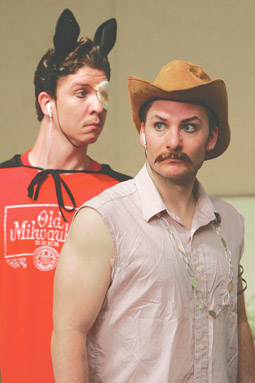
Zachary Oberzan, Jarid Rychtarik, No Dice, Nature Theater of Oklahoma
photo Prudence Upton
Zachary Oberzan, Jarid Rychtarik, No Dice, Nature Theater of Oklahoma
In No Dice, there was dancing towards the end of each of the two acts. It was inexplicable, but bracing, wild yet choreographed and as idiosyncratic as the rest of this remarkable show—as if a release from the incredible labour of human conversation we’d been witnessing. The Nature Theatre of Oklahama performs recorded conversations. Roslyn Oades directs similar work for Urban Theatre Projects but in a different way, resulting in a lyrical, revealing naturalism (p36). Nature Theatre does quite the opposite. The No Dice performers hear edited telephone conversations on their in synch iPods and deliver them according to a set of rules, which include a fixed number of strange gestures (sourced from a magician, disco dancing and blocking clichés from the stage and soap opera) as well as a range of accents. The pacing of the speech is slow and hyper-emphatic, the volume is high, the rhythm heavily accented, allowing for an aural slow motion analysis of conversational patterns and personality traits. Utterly shorn of context, apparently banal conversations about work (whether in call centres or in the theatre), family and the best performance of Hamlet (Mel Gibson; the others “made Hamlet look like a sissy”) become very funny but also assume a surreal gravitas—they seem crazy but deeply meaningful as we grow adept at listening and decoding. Conversational tropes recur, whole passages are repeated with roles reversed and accents dropped. But at all times the bespectacled Hasidic pirate, the New York, moustachioed cowboy and the sparky, fishnet-stockinged showgirl (and their Batboy hip-hopper-cum-sound artist, a lean keyboardist and the two guest-spotting directors) perform everyday talk as if every word is of the utmost importance. And so it is. In a late reversal, the hyperreal formula is dropped, the stage darkened, and the projected transcript of one of the conversations we’ve heard scrolls down. We hear it as well, at normal conversational pace. The key speaker turns out to be female, not male after all, and is the mother of one of the performers talking to the show’s male director. She’s idiosyncratic, quick and droll. She talks about dancing in a wheelchair. We’re now hyper-attentive, curiously moved. And then the company dances (“…dance will solve all the world’s problems”) and we celebrate as one.
The Belarus Free Theatre (see David Williams’ interview/review on page 9) in Being Harold Pinter also made us listen, and read very fast as the surtitles rattled by. Fragments from Pinter plays, from early works to late, took us from threatening moments in everyday life to the overt threats, tortures and murders of totalitarian states. What we heard was Pinter’s text delivered at breakneck pace, largely bereft of classic pauses, but when they did occur it was at great length, opening up chasms of anxiety and pure fear. What we saw was reminiscent of western radical theatre of the 60s and 70s: stark symbolism built from deployment of simple props and neatly choreographed correlatives to the text, here performed with subtlety and passion.
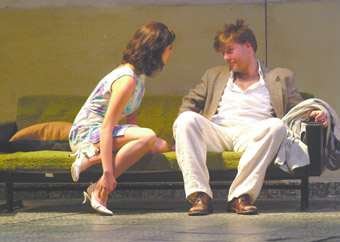
Krno Fekete, Adel Jordan, Ivanov, Katona Jozsef Theatre
photo Kata Schiller
Krno Fekete, Adel Jordan, Ivanov, Katona Jozsef Theatre
Reading the surtitles in the Katona Josef Theatre’s Ivanov was more leisurely and the unintelligible Hungarian a musical delight. This early Chekhov proved to be the festival sleeper (No Dice, on the other hand, was sold out almost as soon as bookings opened), a totally engaging, faithful account of the work. It too danced. The opening solos and duets involving Ivanov, his chair and the comings and goings of visitors are preludes to other intimate patternings and larger scale social events involving the 22-strong ensemble. Director Tamas Ascher deploys his actors with the eye of a film director, constantly shifting our perspective within the frame. The 1960s setting is a run-down building, doubling as Ivanov’s bankrupt farm and the local club, in the declining Soviet Republic of Hungary. So it’s not surprising that the production is reminiscent of films of the period, not least those of the Czech director Milos Forman. Every character, however minor, is closely observed, a touch eccentric and living in a bitter world eased by wonderful comedy, sometimes verging on slapstick, but always rooted in the absurdities of appalling local prejudices, a failing social system and personal weaknesses. The transposition of the play from late Czarist Russia to 60s Hungary works perfectly, and there’s much in Ivanov about racism, the destruction of nature, the challenges of rural life and the enduring agonies of love and indecision that seem utterly contemporary. What impressed about Ivanov were the unforced historical transposition, superb ensemble playing and rivetting principal players. It was above all a production faithful to the play but with the provocative visual and choreographic sensibility of 21st century performance and, at the same time, a disarming intimacy.
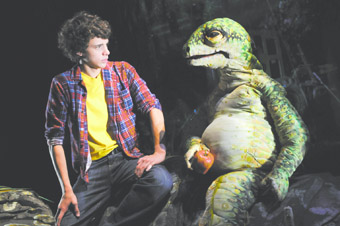
Tom Green & the Potkoorok, The Nargun and the Stars, Erth
photo Heidrun Löhr
Tom Green & the Potkoorok, The Nargun and the Stars, Erth
Erth’s The Nargun and the Stars, an adaptation of the famous Australian novel for children, also danced. Simon discovers spirit creatures in the bush around his cousins’ farm where he has been sent after his parents’ death in a car crash. There he encounters the spirit life of the local environment realised here as magical creatures: the monkey-ish Turongs, the boy’s lizardy confidante, Potkoorok, the cute fruitbat-like Nyols and the massive, stage-filling Nargun, a rock monster attracted out of its territory by its first sight of the stars. The Nargun is troubling the local spirit ecology while developers ruin the natural one. The puppeteering of Bryony Anderson’s wonderful creations is a delight, especially for the Nyols, flying in precise formation, settling on Simon, shaping his movements into comic dance. I subsequently learned that a number of the puppeteers have dance backgrounds. It shows.
The setting is realised virtually in Sam James’ projections of farm house, forests, cave, night sky and rain, and physically in Steve Howarth’s design, which includes a rock pool, a huge grader and tall inflatable trees. The two layers of design, aided by Bernie Tan’s necessarily discreet lighting, merge beautifully, allowing actors, puppets and images to magically live as one, not least in an underwater swimming scene. James’ images are multi-layered, rich in detail, animated and provide exciting shifts in perspective and depth of field. The performances are good, the puppeteering and the multimedia design are exceptional and the lucid direction by Wesley Enoch and Erth’s Scott Wright of Verity Laughton’s adaptation yields laughter, anxiety and surprise. While Wrightson’s tale was progressive for the 1970s and still has many strengths, its fictional imagining of an Aboriginal spirit world now seems culturally awkward (this is compounded by the voice-over narration). But that’s the challenge that comes with realising any classic in performance and, to their credit, the collaborators largely override these concerns with a vividly memorable creation.
Ex Machina, Lipsynch, director Robert Lepage, text Lepage, performers & dramaturg Marie Gignac, set Jean Hazel, lighting Etienne Boucher, sound Jean-Sebastien Cote, Theatre Royal, Jan 11-18; Nature Theatre of Oklahoma, No Dice, conceived and directed by Pavol Liska, Kelly Copper, performers Anne Gridley, Robert M Johansen, Zachary Oberzan, Jarid Rychtarik, Kristin Worrall, design Peter Nigrini, Abraham Mott Hall, Jan 11-16; Belarus Free Theatre, Being Harold Pinter (see p9); Katona Josef Theatre, Ivanov, by Anton Chekhov, director Tamas Ascher, set Zsolt Khell, Drama Theatre, Sydney Opera House, Jan 22-27; Erth—Visual and Physical, The Nargun & the Stars, from the novel by Patricia Wrightson, adapted by Verity Laughton, co-directors Wesley Enoch, associate puppetry director Colin Sneesby, performers Annie Byron, Tom Green, Bill Young, puppeteers Jacob Boehme, Joshua Bond, Johanna Clancy, Sharon Kerr, Colin Sneesby, set Steve Howarth, puppet design Bryony Anderson, composer Phil Downing, audiovisual artist Sam James, lighting Bernie Tan, producer Performing Lines, Parramatta Riverside Theatres, Jan 15-21, Perth International Arts Festival, Feb 18-March 1
RealTime issue #89 Feb-March 2009 pg. 6,8
© Keith Gallasch; for permission to reproduce apply to realtime@realtimearts.net
I KNOW WHY THE BELGIAN MAKERS CALL THIS WORK THE SMILE OFF YOUR FACE, YET EVERYONE EMERGING FROM THE THEATRE WORE EXACTLY THE SAME GRIN. I DON’T KNOW WHAT IT’S LIKE FOR MEN TO EXPERIENCE THIS SHOW, BUT FOR WOMEN, OR THIS WOMAN, THE WORK RECREATED THE MULTILAYERED SENSATION—THE BLISSFUL MELANCHOLY, THE PAINFUL PLEASURE—OF BEING IN LOVE. AND EVEN THOUGH WE HAVE TO LEAVE THIS WORLD AT THE END OF OUR 20-MINUTE TIME SLOT—BE WRENCHED AWAY FROM OUR LOVE—THE SHEER JOY OF HAVING THAT EXPERIENCE IS WORTH SMILING ABOUT.
There’s so little I can say without giving the work away (it’s rumoured to show in Melbourne later this year) but, suffice to say, blindfolded, confined to a wheelchair and hands tied, you are subjected to multi-sensual stimulations. Nothing in particular stands out, nothing is said that is truly profound, no sensory image is completely gobsmacking, yet it accumulates, and you must attend to the moment, trust in the moment to experience it.
For those accustomed to direct interaction between performer and audience, Smile Off Your Face will perhaps not be quite as mind-blowing as for the unwitting participant. Yet even for the most seasoned contemporary performance aficionados, the intimacy of this work is utterly disarming. And if you go with it and trust the makers of this world, a truly beautiful gift awaits you.
Sydney Festival, Ontroerend Goed, The Smile Off Your Face, AADA Pilgrim Theatre, Jan 14-Feb 1
RealTime issue #89 Feb-March 2009 pg. 8
© Gail Priest; for permission to reproduce apply to realtime@realtimearts.net
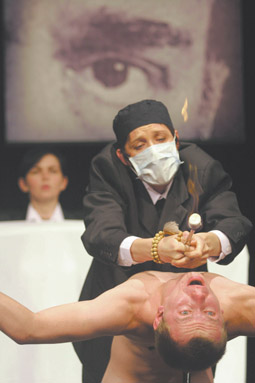
Being Harold Pinter, Belarus Free Theatre,
photo Trent O’Donnell
Being Harold Pinter, Belarus Free Theatre,
THE MINSK-BASED PERFORMANCE GROUP BELARUS FREE THEATRE MADE THEIR MUCH-ANTICIPATED AUSTRALIAN DEBUT WITH BEING HAROLD PINTER AT THE SYDNEY FESTIVAL, AND THIS WORK TOOK ON A GREAT POIGNANCY FOLLOWING HAROLD PINTER’S RECENT DEATH ON CHRISTMAS EVE.
Much of the excitement around this company’s work derives from its political context. Described by producer Natalia Koliada as “Europe’s last dictatorship”, Belarus under President Alexander Lukashenko is very far from a safe place to create political theatre. In a nation where every aspect of life, including artistic practice, is strictly regulated, Belarus Free Theatre work underground to produce uncensored accounts of life under the totalitarian regime. Co-founded in 2005 by Koliada and her husband Nikolai Khalezin, a playwright and journalist, the Belarus Free Theatre has created 11 productions, and regularly travels internationally, drawing attention to the plight of their homeland. For their efforts in daring to imagine a free and democratic Belarus, their audiences in Minsk have been arrested, performances broken up by armed police, actors denied exit visas, artists threatened and assaulted, writers banned from production and company members and their families fired from State-run institutions.
For Koliada, “it’s very complicated when you have family, when you have small children. When you get fired you cannot get any other job in our country…But we understand this. We have a very great teacher, who is Vaclav Havel, who told us we need to speak very loudly and openly in order to stop dictatorship. Otherwise we would just prolong this dictatorship.”
Attending a Belarus Free Theatre performance in Minsk is a clandestine experience. Performances take place in private homes, basements and cafes, rarely at the same place more than once. Performances often occur in the middle of the day, and audiences are notified by text message as to the time and location. According to Koliada, the desire has always been not only to resist oppression by using theatre to address forbidden topics, but also to produce a visceral and dynamic theatre aesthetic. “When we organise the theatre, we decided that it should be aesthetic opposition first of all. If we have a high standard of aesthetic opposition then…we could change aesthetically a society, and when we have such an artistic product then we could attract more attention for political changes.”
being harold pinter
When asked why Belarus Free Theatre chose to work with Pinter’s texts, Koliada replies: “when we read it we understood that he understands us better than many people who live in Belarus.” Even though the plays are not about Belarus, their inherent menace seemed to the company to perfectly capture the experience of contemporary life under Lukashenko. In Pinter, they found that there could be “an essence of violence in just words”, and Being Harold Pinter explores this in detail, using Pinter’s drama and commentary to sharply critique and devastatingly enact the violence that underpins intimate relationships and social institutions.
Adapted and directed by Vladimir Scherban, the performance incorporates Pinter’s Nobel Prize address as a springboard to analyse the hidden currents of his writing and simultaneously demonstrate the arbitrary demands that totalitarian regimes make upon the bodies of citizens under their power. Scherban’s textual montage blends Pinter’s speech with excerpts from six of his plays, and into this he inserts accounts from political prisoners in contemporary Belarus. It’s a startling interpretation, delivered at a pace that allows little space for the famous Pinteresque pauses. Questions swirl about the different needs for truth in art and politics, the possibilities of making political art, ways of negotiating the dissimilar responsibilities of the artist and citizen, and the violence inherent in dramatic language itself.
The performance begins with Pinter (Oleg Sidorchik) brandishing a cane, describing a recent fall he has suffered. As he speaks about his head hitting the pavement, and blood splashing, Sidorchik places a hand over his face. Another cast member sprays him with red paint and places a sticking plaster over his eye. Returning home, the news informs Pinter that he has died and, shortly afterward, that he has not, but rather that he’s been awarded the Nobel Prize. “So I’ve risen from the dead”, he declares.
Pinter reflects upon the beginnings of several of his plays, noting that “our beginnings never know our ends.” All he knew at the start were the opening lines. This reverie is radically broken as the Sidorchik turns on one of his colleagues. Cane pressed against throat, he makes a violent interrogatory demand: “What did you do with the scissors?” The world of the performance has disorientingly tilted on its axis. Is he still Pinter? The character Mac from the play The Homecoming (1964)? A secret policeman in Belarus? All of the above?
Being Harold Pinter is most effective in these early scenes—an utterly riveting, relentlessly paced and forcefully delivered theatrical presentation. Even simple exchanges bristle with menace and acquire accusatory overtones. The seemingly laid back opening conversation of Old Times (1970) reveals a deep vein of potential violence. “You lived with her” is transformed in the mouths of the Belarus Free Theatre actors from a question into a threat. Shortly afterward, an excerpt from Ashes to Ashes (1996) oscillates between intimacy and madness. “I’ve just paid you a compliment. In fact I’ve paid you a number of compliments.” The threats get less oblique as the performance continues, with Scherban’s treatments of Pinter’s The New World Order (1991) and Mountain Language (1988) recognisably mirroring the operations conducted in the name of the War on Terror. In The New World Order, a parade of torturers amuse themselves by first teasing, then mutilating a prisoner. One confesses to the other that these actions make him feel pure, and his comrade responds that this purity is because he is “keeping the world clean for democracy.”
Order itself becomes a form of amusement for the prison guards who populate Mountain Language, with violent acts deemed to have not truly occurred until they can be properly accounted for. A woman savaged by a guard dog has no injuries that can be recognised until she is able to name the dog that is to blame. Unless the dog gives its name, there has been no violence. Another woman’s husband has been mistakenly imprisoned, but the guards refuse to acknowledge that anyone but the Mountain people might be contained within the prison. Finally, after being punished for speaking in the forbidden language, the prisoner is advised that the rules have changed. They are now allowed to speak in their own language, but it is too late. The old mother has already been beaten to death for an infraction now deemed innocent.
Each of these sharp vignettes is introduced by the figure of Pinter himself, who reels from one desperate exchange to another, searching for truths about art and power. “Political language, as used by politicians, does not venture into any of this territory since the majority of politicians, on the evidence available to us, are interested not in truth but in power and in the maintenance of that power.” Coming as they do from a nation in which the maintenance of power involves the active repression of citizens, the Belarus Free Theatre are courageous theatre makers.
the pianist
In contrast to the dynamism of Being Harold Pinter, The Pianist is a largely static performance. In the dark Belvoir Street upstairs space, a grand piano sits centrestage with music stands scattered about. Within this simple staging, The Pianist is essentially a recital performed by Mikhail Rudy, intercut with narration from actor Sean Taylor.
Adapted from the memoirs of Polish pianist Wladyslaw Szpilman, the narration tells an extraordinary tale of endurance and survival in a world gone mad. Beginning with a series of portraits of life in the Warsaw ghetto in 1941, we follow Szpilman as he manages to escape transportation to the concentration camps, and finally traces his subsequent years in hiding in the deserted city. Concealed in an attic, lying quietly day after day, Szpilman kept himself sane by rigorously rehearsing every piece of music he had ever played, a silent discipline to help him ward off certain death. Music itself became materialised through memory, a way of mentally inhabiting better days and a means of survival through imagination. In an encounter with a German officer in the last months of the war, music literally becomes the currency ensuring life, as Szpilman successfully proves he is in fact a pianist by playing Chopin’s Scherzo in B Minor on an untuned, abandoned instrument.
As the voice of Szpilman, Taylor is suitably restrained, and Rachel McDonald’s direction is simple and uncluttered. The Pianist is hardly groundbreaking theatre, but is nevertheless quietly effective. Rudy’s passionate delivery of Chopin’s Nocturnes provides the emotional underpinning of Szpilman’s almost clinical account of his experiences. It’s as if Chopin’s music contained all that remained unsayable for Szpilman: the combination of the barely said and the emotive musical overflow makes The Pianist a frequently moving experience.
Belarus Free Theatre, Being Harold Pinter, based on the plays of Harold Pinter, adaptation, direction Vladimir Scherban, performers Nikolai Khalezin, Pavel Gorodnitski, Yana Rusakevich, Oleg Sidorchik, Hanna Solomianskaya, Denis Tarasenko, Marina Yurevich, producers Natalia Koliada, Nikolai Khalezin, lighting Stephen Hawker; Belvoir St Theatre, Q Theatre, Sydney Festival, Jan 6-Feb 1; The Pianist, based on memoirs of Wladyslaw Szpilman, concept, script Mikhail Rudy, director Rachel McDonald, performers Mikhail Rudy, Sean Taylor, design Jo Briscoe, lighting Stephen Hawker; Belvoir St Theatre, Sydney Festival, January 16-27
RealTime issue #89 Feb-March 2009 pg. 9
© David Williams; for permission to reproduce apply to realtime@realtimearts.net
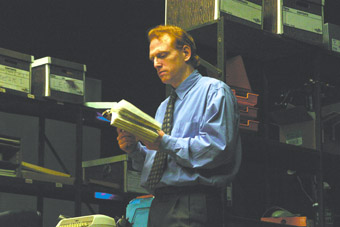
Scott Shepherd, GATZ, Elevator Repair Service
photo Chris Beirens
Scott Shepherd, GATZ, Elevator Repair Service
FROM NOW UNTIL JUNE THERE’S A WEALTH OF ADVENTUROUS ART TO EXPERIENCE ACROSS THE COUNTRY. HERE’S ADVANCE NOTICE OF SOME OF THE SHOWS THAT HAVE GRABBED THE INTEREST OF REALTIME’S EDITORS.
elevator repair service, gatz
You enjoyed the plethora of theatrical epics in this year’s Sydney Festival and you’re a fan of Scott Fitzgerald’s The Great Gatsby. Or you’ve never read it but would love to have it read aloud to you, word for word. Then GATZ is for you: a seven-hour show that’s travelled the world since 2006 from New York’s Elevator Repair Service innovatively tackling the very nature of reading and performance. Adventures, Sydney Opera House, May 15-31; www.sydneyoperahouse.com
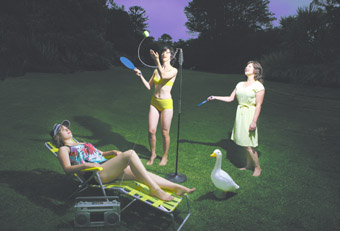
My Darling Patricia, Night Garden
photo Jeff Busby
My Darling Patricia, Night Garden
peformance space: my darling patricia’s night garden
Following the success of the award-winning Politely Savage, the long awaited Night Garden from My Darling Patricia looms (see photo page 2). This work furthers the company’s exploration of gothic Australia, distinctively fusing performance, puppetry, video and installation—here the skeleton of a burned-out house. The Australia-Japan photomedia collaboration, Trace Elements, is also on show until March 21. And in May, There Goes the Neighborhood, curated by Zanny Begg and Keg de Souza, explores the politics of urban space. Meanwhile performer Rosie Dennis’ highly anticipated new show Fraudulent Behavior premieres in June. Performance Space, Night Garden, CarriageWorks, March 6-14; www.performancespace.com.au
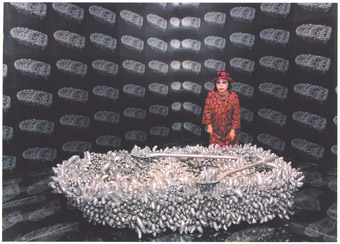
Yayoi Kusama, Walking on the Sea of Death, 1981
courtesy the artist, Victoria Miro Gallery, London and Ota Fine Arts, Tokyo
Yayoi Kusama, Walking on the Sea of Death, 1981
mca: yayoi kusama: mirrored years
You won’t see stars, but spots will certainly appear before your eyes when you enter the immersive worlds of Japanese artist Yayoi Kusama (see page 3). Single works have been exhibited previously in Australia but here is an exhibition on the grand scale: film, performance documentation, sculpture, installation work and painting, including 50 recent print works. A unique vision, a transformative experience. Museum of Contemporary Art, Sydney, Feb 24-June 7; www.mca.com.au
malthouse/arena: goodbye vaudeville charlie mudd
Some of the most innovative theatre of recent years (The Black Swan of Trespass, The Eisteddfod) has come from Melbourne’s Stuck Pigs Squealing underpinned by the collaboration of director Chris Kohn and writer Lally Katz. Kohn is now artistic director of Arena Theatre, but the creative relationship with Katz persists in a Malthouse-Arena co-production, Goodbye Vaudeville Charlie Mudd. With Kohn’s keen eye for the languages of theatre this show resurrects the vaudeville world of 1913 Melbourne but through the prism of Katz’s surreal imaginings. Malthouse, March 6-28, www.malthousetheatre.com.au; www.goodbyevaudeville.blogspot.com
clocked out: the wide alley
The dynamic Brisbane-based duo of composer-pianist Erik Griswold and percussionist Vanessa Tomlinson have an extensive 2009 program taking them to Sydney, Auckland, remote Queensland and Canberra. In March at Sydney Opera House’s The Studio and then at the Auckland Festival they will fuse traditional music from the street and opera of China’s Sichuan Province with their own avant-garde creations. Aural excitement is guaranteed in a Clocked Out gig. The Studio, Sydney Opera House, March 1, 5pm, www.sydneyoperahouse.com
stc: martin crimp’s country
Looking well ahead to late June, here’s one for the diary: Benedict Andrews’ production of The City by leading English playwright Martin Crimp (Attempts On Her Life, The Country). Those who saw Andrews’ engrossing production of Marius von Mayenburg’s Eldorado for Malthouse in 2006, will recognise what has doubtless attracted the director: everyday suburban life goes doggedly if bizarrely on while a ‘secret war’ rages. In the meantime STC’s offering a welcome revival of Tom Stoppard’s Travesties in March and two visiting Kafka shows in April: Kafka’s Monkey (from his Report to the Academy) performed by the UK’s Kathryn Hunter, and an Icelandic physical theatre rendition of Metamorphosis (p3, p16). STC, The City, June 29-Aug 9, www.sydneytheatre.com.au
casula powerhouse: nam bang!
Thirty four years after the Vietnam War, Casula Powerhouse is mounting a major show of works by 25 artists from Australia, Vietnam and beyond that reflect imaginatively on the experiences of those involved and their descendants. Artistic director Nicholas Tsoutas aptly asks, “When does war become art?” An international conference, with prominent arts writer and activist Lucy Lippard as keynote speaker, will take place April 17-18. Casula Powerhouse, Sydney, April 4 –June 21; www.casulapowerhouse.com
sound travellers 2009 and free cd
Now in its second year, Sound Travellers has a substantial touring program of sound art, improvised jazz and contemporary classical music.You can see the program on the organisation’s website and while there request a free CD of a collection of works by the touring artists—including Topology, Ross Bolleter (a featured artist in Ten Days on the Island), Pivot, Joel Stern, Ensemble Offspring, Mark Isaacs, Camilla Hannan, Klumpes Ahmad and more. www.soundtravellers.com.au
double take: ann landa award 2009
You may well do a double take when you see the list of artists competing for the 2009 Ann Landa Award for Video & New Media Arts: Cao Fei (People’s Republic of China), Gabriella Mangano & Silvana Mangano (Australia), Phil Collins (UK), TV Moore (Australia), Lisa Reihana (New Zealand) and Mari Velonaki (Australia). Yes, the award’s gone international. The mix of video, interactive robotics and digital photography will inherently tackle the big question, “How can we be both the self, and an other at the same time; both a self, and an out-of-body split self?” Art Gallery of New South Wales, May 7-July 19, www.artgallery.nsw.gov.au
the chauvel cinema does expanded cinema
As part of its Cinematheque program, Sydney’s Chauvel is showing an expanded cinema program “devoted to (mostly) Australian experimental art films that use multiple projectors.” The program includes Paul Sharit’s twin screen, looping Razor Blades (US,1968), John Dunkley’s pattern-play Rotunda, Dirk de Bruyn Experiments (1982), a veritable catalogue of techniques and “a scream from suburbia”; Arthur and Corinne Cantrill’s The City (1970), “a composite view of the city is created by three films screened simultaneously”; and from the same filmmakers, Meteor Crater—Gosse Bluff (1978). Also coming up at the Chauvel on March 6 is a rare opportunity to see two recent films by popular, award-winning Czech filmmaker David Ondricek. Chauvel Cinema, Paddington, Sydney, Feb 23, 6.30pm; www.chauvelcinema.net.au
blacktown arts centre: blind as you see it
We haven’t seen their work yet, but the emerging Shh Company are tackling a challenging subject with their director and composer Michal Imielski. Blind As You See It fuses puppetry, theatre, music and dance in an exploration of the experience of losing one’s sight. Blacktown Arts Centre, Sydney, Feb 27-28; www.artscentre.blacktown.nsw.gov.au
syncretism: lawrence english + no anchor
Brisbane’s No Anchor experimental duo “creates an utterly engulfing wall of sound” while Lawrence English generates immersive sound fields with material from his album, Colour for Autumn. With a guest appearance from Heinz Riegler. Judith Wright Centre, March 21; www.judithwrightcentre.com
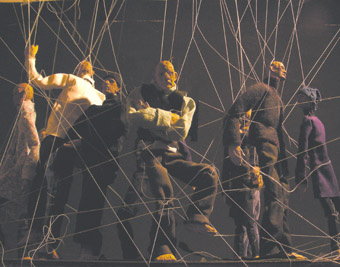
Fleur Elise Noble’s filmic-theatre production 2-Dimensional Life of Her
come out: 2-dimensional life of her
One of the many intriguing hybrid performances in the 2009 Come Out Festival is young Adelaide artist Fleur Elise Noble’s 2-Dimensional Life of Her (see photograph on page 2). An earlier version won the Best in Show award in the 2008 Brisbane Festival’s Under the Radar program. The work involves three projectors, animation, drawing and an audience immersed in paper, and will have an accompanying drawing installation at the Experimental Art Foundation. Come Out 2009, Adelaide, May 18-30; www.comeout.on.net
griffin theatre company: ross mueller’s concussion
In a co-production with STC, Griffin is staging Ross Mueller’s Concussion, an edgy comedy about a man who wakes up without a memory. Melbourne’s Mueller, like Tasmania’s Tom Holloway, is a distinctive and relatively new voice in Australian theatre. In the meantime, don’t miss Ranters’ Holiday at The Stables (it closes Feb 28)—a potent example of the strange paths opening up in contemporary theatre. Griffin Theatre Company, Concussion, Wharf 2, Sydney, March 17-April 4; www.griffintheatre.com.au
song company: tenebrae iii
An annual highlight has been the Song Company’s Good Friday event, a powerful fusion of song and dance, directed in the past by Kate Champion at Sydney Town Hall (2005, 2006), this time by Shaun Parker in the vast industrial spaces of CarriageWorks. Tenebrae III is based on Gesualdo’s Responsories for Holy Week, sublime music evoking the spiritual extremes of belief. And you don’t have to be Christian to appreciate the emotional power of Tenebrae III. CarriageWorks, Sydney, April 8, 10; www.carriageworks.com.au
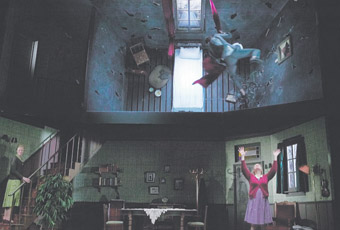
Metamorphosis, Vesturport Theatre
photo Eddi
Metamorphosis, Vesturport Theatre
10 days on the island
This unique across-the-island biennial event draws on its own and other island cultures to entertain and challenge us. It’s a wonderfully intimate live-in festival. In 2009 the festival includes a significant Indigenous dance program in Launceston and innovative performances all over, including two hot shows from Iceland. See page 16 for Carl Nilsson-Polias’ interview with Ten Days director Elizabeth Walsh. Ten Days on the Island, Tasmania, March 27-April 5; www.tendaysontheisland.org
RealTime issue #89 Feb-March 2009 pg. 10
© RealTime ; for permission to reproduce apply to realtime@realtimearts.net
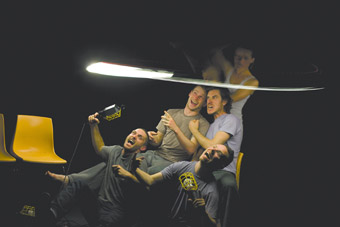
Byron Perry, Antony Hamilton, Lee Serle, Stephanie Lake, I Like This, Chunky Move
photo Genevieve Bailey
Byron Perry, Antony Hamilton, Lee Serle, Stephanie Lake, I Like This, Chunky Move
THE VARIOUS LABELS WE USE TO CATEGORISE THE CAREER DEVELOPMENT OF ARTISTS—EMERGING, PRO-AM, MID-CAREER, FRINGE, PROFESSIONAL—ALWAYS HANG UNEASILY UPON THEIR SHOULDERS, LIKE A RENTAL TUX THAT’S BEEN THROUGH THE WASH ONE TOO MANY TIMES. THEY’RE USUALLY EMPLOYED TO POSITION SOMEONE WITHIN A LARGER ‘INDUSTRY’, BUT THE AMORPHOUS NATURE OF THE ARTS, ALONG WITH FICKLE FUNDING, THE DIFFICULTY IN DEFINING A ‘MAINSTREAM’ AND THE WONDERFUL CROSS-DISCIPLINARY ACTIVITIES WHICH MAKE UP SO MUCH OF OUR CREATIVE LANDSCAPE CONTRADICT SUCH PIGEONHOLING. THREE PRODUCTIONS WHICH APPEARED AT THE TAIL-END OF 2008 ARE CASES IN POINT.
Byron Perry and Antony Hamilton are amongst the most recognisable contemporary dancers in Melbourne, having featured heavily in the calendars of Chunky Move and Lucy Guerin Inc for several years as well as popping up in the works of younger dancemakers. Their first original collaboration, I Like This, can’t really be classed as the debut of two emerging choreographers. There are two immediately apparent reasons: firstly, both dancers have distinct styles and interests which have been evident in their previous performances for others. Secondly, the influences of these earlier mentors have left particular traces in the witty, astute form of I Like This.
Billed as a choreographic conversation between Hamilton and Perry, the work is partly an exploration of the process of dance-making, in which their ideas of what the work is to become are played out around them by a cadre of talented performers. But while this kind of meta-theatre is hardly ground-breaking—and reached a superb apex in Guerin’s and Chunky Move’s respective contributions to the last Melbourne International Arts Festival (see RT88, p4), both starring Hamilton and Perry—I Like This takes its concepts in pleasing new directions. It’s not a navel-gazing piece of the sort presented in Wendy Houstoun’s Desert Island Dances, another MIAF event. Here, action supercedes analysis.
The duo clearly recorded their rehearsal process and used the result to produce a kind of remixed dance. The performers begin to move, then rewind, skip or become stuck in loops. All the while, Perry and Hamilton sit surrounded by lighting panels, power boards and snaking cables, orchestrating the handheld lamps carried by the dancers. In fact, Perry and Hamilton’s visual design for the work deserves particular mention, becoming a character almost in itself, with hundreds of perfectly executed changes whose sometimes stroboscopic effect makes lighting operation appear a form of choreography in its own right.
It’s self-reflexive dance, certainly, but by incorporating technology in such a sophisticated way it becomes something much more. And when the work ends with the two choreographers covered by a giant quilted doona, lights sparking underneath like flashes on a distant mountain range, the result approaches the sublime. Emerging artists? Far from it.
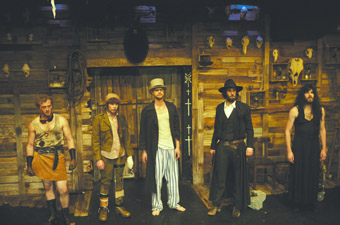
Avast, Black Lung
photo Jeff Busby
Avast, Black Lung
The Black Lung are another ensemble well entrenched in Melbourne’s independent arts scene while occupying an utterly, defiantly outsider space. But, testament to the inadequacy of such categories, they were picked up by the Malthouse for a residency in its Tower program.
The Tower season consisted of a remounting of Avast, first produced three years ago, and a new work entitled Avast II: The Welshman Cometh. The theatre itself was radically transformed during the three month residency, outfitted with dingy couches, graffiti-covered walls and a massive wooden set filled with animal skulls, worn leather, animated dummies and dusty ephemera. Both productions were equally ramshackle, eclectic and brilliantly detailed.
The Black Lung create the kind of anarchy that can only result from incredible precision, an effect most notably associated with Forced Entertainment. During Avast, a confrontation between two brothers haunted by a legacy of familial murder and betrayal is interrupted by a falling spotlight which crashes to the ground inches from the actors’ feet. They are visibly shaken as they attempt to continue the scene, and convincing the audience that this wasn’t a pre-planned moment only proves the astounding capabilities of these performers. Similarly, the constant sense of competition, potential violence and despair of the actors themselves creates a brilliant blurring of understanding—are we watching something taking place, or something failing to take place?
Underneath the deliberate chaos is a thick questioning of theatre, narrative convention and masculinity. The two works are almost entirely composed of pastiche, quotations from film, literature and generic devices overlapping constantly. It’s all brutally blokeish too, with the only female character killed in the opening moments of Avast (unless you count another male character’s inexplicable change in gender halfway through the second work). And while Avast II is evidently a new work, the three years of development accorded Avast have made it one of the tightest, funniest, scariest pieces of theatre I’ve seen in years.
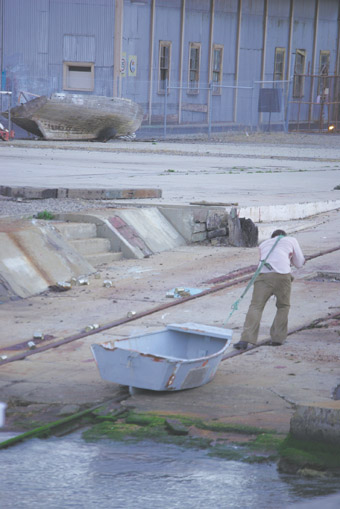
Collapse, Red Cabbage Collective
photo Matthew Scott–Cheeky Monkey Enterprises
Collapse, Red Cabbage Collective
Melbourne collective Red Cabbage might be the artistic equivalent of the Slow Food movement—like incidental fellow travellers such as Eleventh Hour Theatre, Red Cabbage eschew quantity for quality, creating one work per year. The time commitment was certainly evident in Collapse, an epic, large scale installation and performance located across a remote former maritime precinct in Williamstown. Audiences were transported by a 20-minute boat ride to a post-apocalyptic world both staggering and serene. Disembarking from the vessel, we were met by linen-clad survivors of some disaster dredging canned food from the ocean, hauling rotten row-boats across concrete as the twilight descended; we gathered in a vast, weed-strewn warehouse where women lyrically spoke around the mysterious disaster which had befallen the community; we roamed a maze of sheds, alleyways and ruined sites housing countless traumatised inhabitants coping with the new reality into which they’d been reborn. An alchemist conducted strange experiments in a bubbling lab while a babbling wreck spewed poetry in a nearby shanty. The enigmatic, voyeuristic voyage ended in a gargantuan warehouse-cum-cinema, a ragged corps of drive-in speakers standing to attention before the flickering celluloid images retrieved from a lost world. Gaps in the canvas screen revealed blue skies and drifting clouds, as much a memory as the filmic footage being projected. The survivors gathered before this iconic scene in reverential silence. Minutes later, it was all over.
Collapse’s narrative was piecemeal and its meaning kept obscure, allowing each visitor their own interpretation. The audience was allowed to wander individually; unlike the masterfully subtle control of attention exercised by another interesting company, Peepshow Inc’s similar The Mysteries of the Convent (2008), there were plenty of opportunities to miss a dramatic moment or provocative scene here. Collapse’s effect was a cumulative one, however—even the relatively uneventful prefacing boat ride worked to establish a mood of quiet distance and reflection, producing a sense of reverie.
It’s difficult to stamp any of these three works as “emerging”, though all fit a technical definition. But all are equally the products of artists who have been honing their crafts for years and all exceed journeyman status. The next evolutionary step for each will most likely prove just as hard to classify.
I Like This, choreography, direction, lighting, sound Antony Hamilton, Byron Perry, performers Hamilton, Perry, Stephanie Lake, Alisdair Macindoe, Lee Serle, costumes Paula Levis, Chunky Move Studios, Nov 20-29; Avast and Avast II: The Black Lung Theatre Company, The Welshman Cometh, performers Sacha Bryning, Gareth Davies, Thomas Henning, Mark Winter, Thomas Wright, Dylan Young, sound design, music Liam Barton, lighting design Govin Ruben,Tower Theatre, CUB Malthouse, Nov 12 – Dec 6; Red Cabbage, Collapse, creators Louise Morris, Tania Smith, Kirsten Prins, Anna Hamilton, performers Jason Lehane, Claire Reynolds, Maria Sirpis, Jason Cavanagh, Kate Boston Smith, Alice Claringbold, Ross Farrell, Krista Green, Portia Chiminello, Carlo Marasea; Seaworks, Williamstown, Melbourne, Nov 19-30, 2008
RealTime issue #89 Feb-March 2009 pg. 12
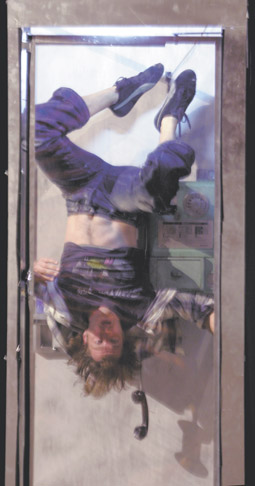
Grayson Millwood, Roadkill, Splintergroup
photo Tim Bates
Grayson Millwood, Roadkill, Splintergroup
REALTIME’S COVERAGE OF LAST YEAR’S MELBOURNE INTERNATIONAL ARTS FESTIVAL FEATURED AN EXCITING RANGE OF NEW DANCE WORK FROM LOCAL ARTISTS. FOR THE DEPLETED SECTOR IN SYDNEY, MASS MIGRATION WAS SERIOUSLY CONTEMPLATED. IN MARCH, IN A WELCOME JOINT INITIATIVE, THE THREE HOUSES OF MELBOURNE’S CONTEMPORARY PERFORMANCE CULTURE—ARTS HOUSE, DANCEHOUSE AND MALTHOUSE ARE THROWING OPEN THEIR DOORS TO CO-HOST TWO WEEKS OF CONTEMPORARY DANCE PROGRAMMING IN THE FORM OF DANCE MASSIVE. THE GENEROSITY IMPLIED IN THE EVENT’S TITLE IS REFLECTED IN A PROGRAM OF 15 WORKS FROM WITHIN AND OUTSIDE THE HOME STATE.
Part of the function of such events is for audiences to survey the form, to muse on its preoccupations. What strikes me in promotional literature for the programmed works is the language constellating around oppositions, the difference between states of being and, biting at those binary ankles, ideas of liminality and hybridity. These spaces of uncertainty and possibility occur both in the form and subject matter of the works. Live performance meets film and installation in Russell Dumas’ Huit à Huit. In Lucy Guerin’s Untrained, four men—two dance trained, two not—“show what each of those bodies can do with the same set of instructions, what they have in common and where their physical histories set them apart.” In 180 seconds in (Disco) Heaven or Hell, “speed dating meets pomo disco” and comes with The Fondue Set’s customary warning of “possible bad dance moves.”
Oppositional themes abound: circadian rhythms underscored by driving beats; population growth and the auditory phenomenon of feedback” (Rogue’s A Volume Problem and The Counting); Australians homesick in Berlin (Splintergroup’s Lawn); a couple stranded in the middle of nowhere (Splintergroup’s Roadkill); the monster within (Jo Lloyd’s Melbourne Spawned a Monster); two performers/two viewers (Inert); the substitution of real life for imitation (Luke George’s Lifesize). Shelley Lasica’s Vianne tests the fissures; in Limina, Michaela Pegum dances at the point where one thing becomes another and is for a time both; Helen Herbertson’s Morphia Series takes us directly to dreamstate (do not pass go); The Fondue’s No Success Like Failure playfully lays bare the schizophrenic state of the dancing life and Chunky’s Mortal Engine dares to come between the performer and her light source.
Steven Richardson, Artistic Director at Arts House, sees Dance Massive as “creating some essential critical dialogue around contemporary dance, setting a national context to present work in a concentrated cluster of programming” and also as offering the chance to host some international guests, “either presenters or potential co-producers, to really enter into that dialogue (and possible co-production) with Australian artists, many of whom are at the leading edge of contemporary dance internationally.” Currently in Australia, according to the Dance Massive program, there are around 50 dance companies and more than 200 choreographers investigating a range of techniques, culturally diverse forms, contexts and media. “Australian contemporary dance is in demand internationally. It has a strong track record for touring work,” says Richardson.
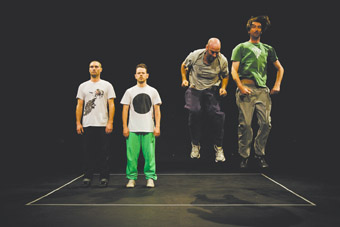
Byron Perry, Anthony Hamilton, Simon Obarzanek, Ross Coulter, Untrained, Lucy Guerin Inc
photo Untrained Artists
Byron Perry, Anthony Hamilton, Simon Obarzanek, Ross Coulter, Untrained, Lucy Guerin Inc
Dance Massive also represents for the partners “a broad audience development strategy, the possibility to create a strong concentration of work over a specific time period…We don’t have the resources to mount a festival but a concentrated program has some added benefits over and above an annual program.”
“Having companies like Chunky Move co-operatively program at the same time as some of the more emerging companies”, says Richardson, gives younger companies and independent artists a chance to have their work seen in the broader context. “I think there’ll be some interest and benefit around the positioning of different kinds of work over the same time period.”
Visiting guests will have an opportunity to see complete works rather than excerpts. “The Australian Performing Arts Market does a terrific job in terms of a kind of broad brushstroke picture of the Australian cultural landscape. But I think having a genre-specific showcase, for want of a better term, creates all sorts of other possibilities. And the fact that we’re able to invite presenters or potential co-producers who have a very strong interest in dance, who can see 12-15 works over a six-day period—that’s a fairly attractive proposition for someone who’s engaged in looking at Australian work.” It’s also a less competitive environment for artists. “Presenting a full-length work with full production values is really important. It honours the work, honours all the effort that’s gone into making it.”
As well as the dance program, there’s an industry forum day on the Monday where artists who may not be in the program will talk about their work. “Australian dance is in a position now where artists have a greater degree of self-esteem and can just talk about upcoming work.”
“Since the demise of Greenmill”, Richardson observes, “there hasn’t really been a dedicated event focusing on contemporary dance. There have been a number of ancillary programs associated with arts festivals. But I think having a stand-alone contemporary dance project is timely and Melbourne is the place to host it. There’s already a critical mass and an ecology of dance in Melbourne that can support this practice. We have a very nice temporal moment, a good confluence of presenters in Melbourne who are open to this idea, so it’s time to give it a go.”
And if it all goes well, Dance Massive may well become a biennial event. Says Richardson, “We’ll certainly undertake some evaluation once we get through the first one and see if we’ve got the design close to right and make some adjustments after that. It may be we’re trying to do too much, or too little. And there are some gaps in the program. Contemporary Indigenous work is something we haven’t really been able to support this time. That’s the tyranny of distance, of resources, of funding. There’s some intercultural, cross-cultural work that, for various reasons, both to do with funding and resources but also to do with the availability of particular works, we haven’t really been able to present. But they’re definitely on the agenda. In fact, if I had to say where the gaps are I’d have to highlight those two areas of potential strength in Australian dance that we haven’t been able to support this time round. We hope to run three Dance Massive episodes as a pilot and see how we go after that.”
Dance Massive, March 3-15; www.dancemassive.com.au
RealTime issue #89 Feb-March 2009 pg. 14
© Virginia Baxter; for permission to reproduce apply to realtime@realtimearts.net
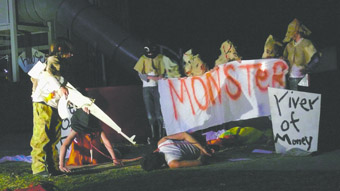
play:ground
photo Irene Rincon
play:ground
IN 2008 I SAW A LOT. ONE HUNDRED AND NINETY EIGHT LIVE PERFORMANCES BY MY RECKONING, NOT INCLUDING LIVE MUSIC. AND I SAW A LOT OF KIDS ALONG THE WAY. I SAW KIDS SHOT OR GARROTTED, DRENCHED IN BLOOD (THE WOMEN OF TROY; THANKS BARRIE KOSKY) OR SCREAMING THEIR INJUSTICES AT ME. I ALSO SAW KIDS BARING RICTUS-LIKE SMILES AS THEY BEGAN PAINFUL BALLET CAREERS, AND KIDS WITH NO DREAMS OF STARDOM RELUCTANTLY DRAGGED ONSTAGE DURING FAMILY SHOWS. I SAW ADULTS ACTING AS CHILDREN, BUT THAT’S RARELY INTERESTING.
Maybe I’m presuming, but I’m pretty sure we were all kids once. I don’t have any children but I think childhood is a fine subject for any artistic worker. This opinion piece—and that’s all it is—is not really a comment on the Bill Henson debate, though it will necessarily intersect with the murky issues that case brought to public attention. What interests me here is less about the depiction of children in art and more about their participation.
Last year I attended a performance directed by a VCA masters student entitled play:ground. Claudia Escobar created the work as a response to the child soldiers who exist around the world, including in her homeland of Colombia. The piece was performed in a twilight-bound park by primary school children who engaged in mock battles, were terrorised or recruited by sinister authority figures, and turned upon each other in savage fashion as they became inured to the reality of violence.
For these child performers, as for real child soldiers, killing bore no more reality than a videogame or schoolyard playfight. This was the point of play:ground, in part. But the spectacle of pre-adolescent kids riddling each other with machinegun bullets or emerging from the trees covered in the sackcloth hoods of terrorists and toting fake semi-automatic weapons was authentically disturbing for its adult audience. An effective and deeply provocative evocation of a very real contemporary horror, yes, but also more unsettling in its involvement of real children playing out—and thus vicariously participating in—the problem.
Barrie Kosky’s Women of Troy was an equally violent spectacle. Its unending cacophony of ear-splitting gunshots was either traumatic or numbing, depending on your response. And near the work’s climax, as dictated by Euripides himself, the figure of a dead young boy appears, carried in a bloody cardboard box. As with play:ground, I doubt that the child in question was adversely affected by the performance. I played dead when I was a kid.
But I’m surprised that the spectacle of violence towards children doesn’t raise hackles in the way that sexuality does. I’m sure it’s something to do with our troubled notion of consent. Children are assumed (legally at least) to be unable to make informed, adult decisions regarding certain aspects of their lives, and laws and safeguards are in place to make those decisions for them. I have no problem with this. But the Henson affair barely touched upon a more challenging aspect of this system of protection: is a child’s right to self-determination also taken out of their hands in the realm of representation? That is, can an adult decide whether and how a child’s image may be presented in the public sphere?
An Anne Geddes calendar featuring babies in pot-plants or dressed as watermelons is a commercial goldmine, but how would the same buying public feel about similar shots featuring people suffering dementia or Alzheimer’s? Not so cute, sure. But ethically on the same level. Former UN Secretary-General Javier Pérez de Cuéllar has suggested that “a society is judged…by the quality of life which it is able to assure for its weakest members.” I wonder if that concept can be extended to the rights we accord others to control their self-representation.
For several years I tutored tertiary students in a subject on art and censorship. Every new class arrived with a surprisingly regular set of opinions on the topic— censorship was unequivocally wrong, and freedom of speech was an essential component of our culture. Western liberal democracy is founded on this rhetoric, though a little nudging suggests limits most people would agree with. Censorship might not be so bad when it comes to child pornography, religious vilification or racial discrimination, for instance. And indeed, if we broaden our notion of censorship from the simple state-imposed variety to the more organic forms of censorship—the way we censor our own thoughts and comments, or the community censorship that exerts an influence on the discursive relations amongst any social group—the black ban on capital-C censorship becomes more muddled.
And what irked me most about the Henson debate and its offshoots was that a most pernicious form of censorship was exercised by even the artist’s most strident defenders. What was absent from discussions was the voices of those in question, for whom we’re all happy to speak. Children simply do not have a public voice in the way that a mature white male artist or a newspaper columnist or a prominent politician has. The censorship of a child’s voice is not legally enshrined but it’s no less institutionalised. And I suppose my concern here stems from the fact that despite all the kids I saw onstage last year, I’ve never had a sense that anyone is particularly interested in speaking to, rather than for, a demographic whose minority status stems from age alone.
The one exception could have been Tim Etchells’ That Night Follows Day, which appeared at the Melbourne International Arts Festival. Here, a few dozen children of various ages chanted a litany of complaints to their audience: “You teach us that in the world there are bad men/ That monsters are not real/ That words are only words/ That the shadows are nothing to be frightened of.”
My sister has recently been working on a documentary called Eleven, which features interviews with 11-year-olds from around the world. Her theory is that kids at that age are no longer children but not yet adults. The results are compelling. Her subjects speak about sexuality, terrorism, cold fusion technology, romance, action movies and politics, often in the same sentence. They are thoughtful and generous, mostly startled that someone would care to hear their opinions on things that are normally considered the discursive province of grown-ups alone.
I recommended That Night Follows Day to my sister, who attended a showing followed by a public discussion of the piece. She was disappointed to learn, as I had, that the text itself had been written by adults. A producer explained that the thoughts of the juvenile participants wouldn’t have produced the effective, impactful political statement which the work ended up delivering. They would have talked about rainbows and boyfriends. I have to disagree.
RealTime issue #89 Feb-March 2009 pg. 15
© John Bailey; for permission to reproduce apply to realtime@realtimearts.net
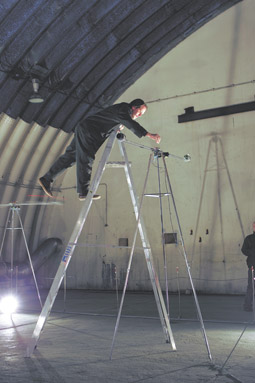
Siren, Ray Lee
photo Steven Hicks
Siren, Ray Lee
ITS UNIQUE BREADTH OF GEOGRAPHICAL LOCATIONS AND ITS DISTINCTIVE SENSE OF PAN-ISLAND FRATERNITY HAVE ALWAYS SET TEN DAYS ON THE ISLAND APART FROM ITS MAINLAND FESTIVAL COUSINS. FOLLOWING ON FROM HER WORK IN 2007, ARTISTIC DIRECTOR ELIZABETH WALSH SEES THIS YEAR’S PROGRAM AS “GOING A BIT FURTHER” WITH REGARD TO PROVIDING AN EVEN MORE INNOVATIVE AND CHALLENGING PROGRAM OF EVENTS.
When I interviewed her, Walsh was in Melbourne for the opening of Woyzeck at the Malthouse Theatre. This particular translation and adaptation of the Georg Büchner play is by the Icelandic writer, director, actor and former gymnast Gisli Örn Gardarsson, whose version of Franz Kafka’s Metamorphosis is one of the headline productions at the Ten Days festival. The popularity of Gardarsson’s work on our shores, though seeming rather sudden, has been only a matter of time. With his theatre company, Vesturport (see page 3), Gardarsson has become a darling of the British theatre scene thanks to the extreme physical acrobatics he employs in his theatrical adaptations—the result of bringing his gymnastic skills and aesthetic to bear on projects from Romeo and Juliet to Faust. And, on most of these pieces, he has collaborated with Australian musicians Nick Cave and Warren Ellis, whose output in recent years has increasingly included scores for stage and screen. In terms of theatrical antecedents, Gardarsson’s Metamorphosis is a very different dish to that served up by Steven Berkoff in 1969. Where Berkoff used his physical alacrity and invention to construct Gregor Samsa’s entire world from lights and a few bits of scaffolding, Gardarsson’s vision is grander and locates Samsa within a much more traditional theatrical design. Nevertheless, both are very much vehicles for physical virtuosity and, in that respect, Gardarsson’s pedigree is hard to fault.
On the topic of pedigree, Wu Hsing-kuo’s company has the potentially hubristic moniker of Contemporary Legend Theatre. However, having studied Chinese opera from the age of 11 and performed as lead dancer for the extraordinary Cloud Gate Dance Theatre, Wu Hsing-kuo has earned the title. He brings to Tasmania what Walsh describes as his “party piece”—a solo performance of King Lear. Though Lear is not what everyone would call a party, there is something undeniably attractive about seeing such an outrageously ambitious project undertaken by such a capable performer. This kind of transcultural adaptation of Elizabethan drama into other equally strong theatrical traditions has some great forebears, such as Akira Kurosawa’s use of Noh elements in his acclaimed films Ran and Throne of Blood. In Wu Hsing-kuo’s version, the narrative arc of Lear’s fall from regal pageantry to barren essentialism is echoed in the costumed glory of traditional Chinese opera being gradually stripped away as the old king’s mind unravels before us.
On the musical front, Ten Days on the Island is flying Perth composer Ross Bolleter back and forth in search of Tasmania’s most attractively derelict pianos. John Cage made the ‘prepared piano’ popular and Bolleter does the same for ‘ruined pianos.’ In other words, he takes those weathered wrecks that have been sitting in a galvanised iron outhouse for a few too many decades and uses their unique aural fingerprint of decay to create his own particular brand of composition. For Walsh, this has been the perfect opportunity for the festival to interact both with the colonial heritage of Tasmania and smaller regional communities. For Bolleter, it is an opportunity to interrogate the idiosyncratic resonances of some truly decomposed ebony and ivory. And for the audience, it is a potentially inspiring call to arms and good reason to lift the sheets from those long-forgotten instruments. Having toured to Stanley, Derby and Ross, the pianos will eventually be installed in the equally neglected and remarkable Bond Store at the Tasmanian Museum & Art Gallery in Hobart, where their stories and their sounds will both be on show.
In a strangely beautiful parallel, another installation-cum-concert takes its aural inspiration from a far more modern instrument—the siren. Created by English sound artist Ray Lee, Siren stretches the possibilities of the Doppler effect to an enticing extreme. Presented at Launceston’s Queen Victoria Museum & Art Gallery, Walsh points out that the venue’s role as a nexus for science and art makes it the perfect place to install this musical experiment. Set on giant tripods, sirens and lights rotate on long arms to create a finely tuned field of sound that is interspersed with inevitable beats and natural harmonics. Within this space, the audience is encouraged to move around, adding another level of sonic mobility and distortion and thereby affording each listener an entirely personal experience of the sound. Together with fellow performer Harry Dawes, Lee moves around the space with the audience, operating the sirens and adjusting their tone. Lee is interested in what he describes, with a nod to outmoded physics, as the “circles of ether”—the invisible forces of electromagnetism and the like. In Siren, he creates an appreciable representation of these forces using the invisible yet sensible nature of sound to make manifest the waves and concentric spheres of radiation.
Someone else who radiates their own special brand of electromagnetism is the pluridisciplinary artist Hiroaki Umeda, who sneaks into the festival program with only a few performances. Bringing two dance works, Duo and ‘while going to a condition’, as well as a short video work, Montevideoaki, Umeda is one of the more exciting prospects in the festival. Watching Umeda dance in ‘while going to a condition’ is like seeing a human oscilloscope, as he builds his movements from Butoh-like restraint into frenetic climaxes. All of this occurs in front of a flickering wall of light and with the audience enveloped by an intensely loud field of electronic crackles and whirs. In Montevideoaki, Umeda’s dance is placed in front of the backdrop of the eponymous Uruguayan capital. The elementary wordplay of the title ought not obscure the fact that it was made in collaboration with Octavio Iturbe, a video artist who has previously made award-winning screen adaptations of Wim Vandekeybus’ choreography.
From the shores of another island-off-the-mainland comes Terra Che Brucia. This Sicilian combination of jazz and projected archival footage is led by saxophonist Massimo Cavallaro. The music fits quite safely into that mode of European electrojazz popularised (and done better) by the likes of Nils Petter Molvaer but the footage itself is a fascinating collection of documentaries on everyday Sicilian life made by Panaria Film between 1948 and 1950, when Italy, especially the impoverished South, was still recovering from the wreckage of the Second World War.
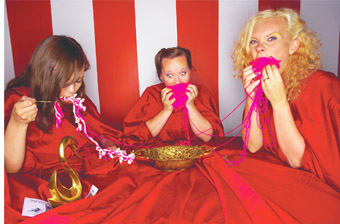
Icelandic Love Corporation, Hospitality
photo Bernhard Kristinn Ingimundarson
Icelandic Love Corporation, Hospitality
One of the more enigmatic forces in Ten Days on the Island will be the Icelandic Love Corporation. This trio of female artists (Sigrún Hrólfsdóttir, Jóni Jonsdóttir and Eirún Sigurdardóttir) produce installed happenings. Walsh met the group in Iceland and invited them to come to Tasmania largely on the basis of the way in which they made coffee. She is gleefully ready to admit that she has no idea what they are bringing to the festival, apart from the title of the show, Hospitality. One suspects there might be a few cups of something involved but the piece will undoubtedly have the wry whimsy that is bred in a country where everyone is related and the banking system has collapsed. You can catch the Icelandic Love Corporation’s particular brand of hospitality at Contemporary Art Services Tasmania in North Hobart for the duration of the festival and a few weeks afterwards.
Ten Days on the Island, Tasmania, March 27-April 5; visit www.tendaysontheisland.org for the full program
RealTime issue #89 Feb-March 2009 pg.
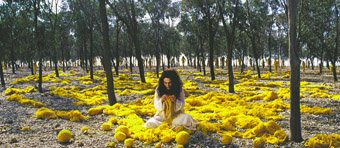
Mahdokht detail, Women Without Men Series (2004)
photo Larry Barns, Shirin Neshat, Courtesy Gladstone Gallery, New York
Mahdokht detail, Women Without Men Series (2004)
RECENT TALK OF PALESTINIAN “AGGRESSION” IN GAZA, AT A TIME WHEN HUNDREDS OF MEN, WOMEN AND CHILDREN WERE BEING SLAUGHTERED BY ISRAEL’S HIGHLY SOPHISTICATED MILITARY MACHINE, IS JUST THE LATEST EXAMPLE OF THE ONE-SIDED VIEW WE RECEIVE OF LIFE IN THE MIDDLE EAST. FOR DECADES THE WEST HAS POSITIONED ITSELF AS THE VICTIM OF ISLAM’S SUPPOSED ANTIPATHY TO DEMOCRACY, EVEN AS WE HELP STYMIE POPULAR MOVEMENTS THROUGHOUT THE MUSLIM WORLD. IN THIS CONTEXT, ARTISTIC VOICES FROM THE MIDDLE EAST PROVIDE AN IMPORTANT OPPORTUNITY TO SEE THESE CULTURES FROM THE OTHER SIDE. MIXING MAGIC, TRAGEDY, HISTORY AND POLITICS, THE FIVE-VIDEO SERIES WOMEN WITHOUT MEN BY US-BASED IRANIAN ARTIST SHIRIN NESHAT OFFERS A SHARP REJOINDER TO ONE-DIMENSIONAL IMAGES OF IRANIAN WOMEN AND THE NATION’S MODERN HISTORY.
Neshat’s videos are based on Shahrnush Parsipur’s 1989 magic-realist novel of the same name, set against the backdrop of the US and British-backed coup in 1953 that toppled the secular progressive Dr Mohammed Mossadegh after he nationalised the country’s oil reserves. It was partly her desire to explore this period that drew Neshat to the project. “I found I wanted to return to this historical moment and touch on how the American government had a direct relation to the overthrow of a democratic government, which eventually led to the deep resentment of Iranians against Americans, and indeed paved the road for the Islamic revolution. I had no interest in making a documentary film or an approach that would be a history lesson, but rather I found it interesting and a challenge to build these events as a background to my story.”
Each of Neshat’s videos portrays a female character from Parsipur’s novel, which traces the fate of five quite different women eventually brought together by chance in the city of Karaj, a short distance from Tehran. The videos vary greatly in approach, but none is strictly realist. “Parsipur’s style fit my work perfectly, as she is known for her surrealistic literature…all her work has one foot in society, history and politics, but is also profoundly timeless, philosophical and universal in expression,” enthuses Neshat. Described by the artist as one of Iran’s “foremost contemporary female writers”, Parsipur was imprisoned by both the Shah and the subsequent Islamic regime before fleeing Iran to live in exile in the US.
Neshat’s videos “give a glimpse into the nature of each woman” rather than extrapolating the plot of Parsipur’s novel. “I basically took each woman’s dilemma and tried to reveal her spiritual, psychological, social or sexual issues”, says the artist. “Since each woman’s problems and aspirations were different, I created totally different narratives and stylistic approaches.”
women without men
Mahdokht, the first video made back in 2004, is the most abstract in Neshat’s series. Playing out simultaneously across three screens, it explores the split desires and tormented nature of a young woman terrified by sexuality, yet obsessed with fertility and children. In the novel, the character resolves this contradiction by planting herself in a garden and becoming one with nature.
Although Mahdokht contains striking imagery—notably the crazed central character knitting in a forest strewn with yellow wool—the video is the least successful of the five. The thematic and narrative relationship to Parsipur’s novel is a little too elliptical, and the symbolism too wide open to interpretation. While the other works stand up as discrete viewing experiences, Mahdokht makes little sense without some prior knowledge of the character.
In contrast, Zarin (2005) is a striking horror movie exploring the psychology of a prostitute suffering from anorexia. She is so alienated from her work and her own body that her clients become blank, faceless monsters. In an unbearably visceral scene in a public bathhouse, the young woman attempts to erase her withered frame and sense of guilt through frenzied scrubbing, until she is reduced to chafed, bloodied mass.
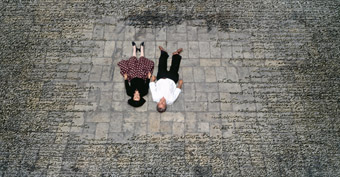
Munis, Women Without Men series 2008, Shirin Neshat
courtesy Gladstone Gallery, New York
Munis, Women Without Men series 2008, Shirin Neshat
Neshat’s final three videos were completed in 2008. Munis most successfully draws together the novel’s magic-realist style, the videos’ commentary on the lives of Iranian women and the historical backdrop of the 1953 coup. The central character is harangued by her conservative brother as she listens to radio broadcasts reporting unrest on the streets of Tehran. Unable to go outside and participate in the demonstrations, she anxiously paces the rooftop of her home. When she witnesses a fleeing protestor shot on the street below, Munis steps off the roof, engaging in a conversation with the man in their shared moment of death. The video beautifully weaves together her personal tale and the broader historical setting, in a quiet reflection on the frustrated possibilities of Iran’s shattered democracy.
Faezeh unfolds as a nightmare of brutality and ruined happiness. A young woman constantly returns to the scene of her own rape, an indictment of the impossible expectations placed on women to maintain their ‘purity’ in societies that often turn a blind eye to sexual violence.
In the final video in the series, Farokh Legha, Neshat adopts a more realist mode, and once again evokes the ’53 coup as a moment of curtailed possibilities. The middle-aged central character hosts a party in a grand house surrounded by an orchard—a symbol of life and fecundity in an otherwise barren landscape. The party is rudely interrupted by armed troops, some of whom sit down to enjoy a lavish meal while their counterparts hunt down and shoot ‘opponents’ outside.
Some time later, the host returns to her house, now deserted and coated in a thick layer of dust. Discovering a young woman lying prone in a garden pond, Farokh Legha takes her inside, where the girl flickers with life. As the camera slowly pans across the room, the cobwebs fade and flames dance in the fireplace once again. The final image seems to be one of hope, a sign that Iran’s culture, as well as the ideals of the nation’s short-lived democracy, live on despite the traumas we’ve witnessed.
book to video to film
While Farokh Legha marks the completion of the Women Without Men video series, Neshat is currently completing a feature film also based on Parsipur’s novel. Utilising the same actors and Moroccan locations as the videos, the artist says the feature will take a more narrative-driven approach that foregrounds the tale’s historical context.
Part of the attraction for Neshat of a two-stage project lay in exploring the mechanics of storytelling in two quite different environments. “I have been very interested in how the experience of viewing the story may change completely due to the setting—a theatre versus a gallery or museum space”, she explains. “So in my construction and editing of the videos and the film, I’ve tried to address this issue. Once I finish the feature it will be up to the audience to draw parallels and distinctions between art and cinema.”
In exploring Iran’s sexual politics and culture, as well as Western complicity in the crushing of Mossadegh’s government, Shirin Neshat has helped kick open the narrow window through which we typically view Iran in the West. Her videos stand as a provocative memorial to a crucial turning point in the nation’s modern history, and the women who have survived the vagaries of Iran’s political strife. The coming feature promises to be another intriguing thread in the tapestry of images Neshat has woven from and around Parsipur’s fantastical novel.
Women Without Men, video series, director Shirin Neshat, based on the novel by Shahrnush Parsipur; Faurschou gallery, 798 Art Zone, Beijing, China; Oct 25, 2008–March 1, 2009
RealTime issue #89 Feb-March 2009 pg. 17
© Dan Edwards; for permission to reproduce apply to realtime@realtimearts.net
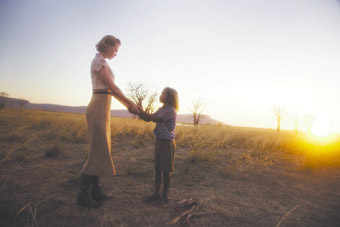
Nicole Kidman, Brandon Walters, Australia, courtesy Twentieth Century Fox Home Entertainment
TITLING A WORK AFTER ONE’S COUNTRY IS A DESPERATE MEASURE, EITHER BORN OF CAUSTIC CRITIQUE OR BOUND BY PATRIOTIC TRAUMA. THE FORMER CREATES THE PALIMPSEST OF NEGATION WHICH DARKENS ANY COUNTRY’S FLAG AND ANTHEM; THE LATTER IS DEDICATED TO CLEANING, BRIGHTENING AND GENERALLY WHITENING THE SAME. ONLY THE DEAD WOULD MISS THAT BAZ LUHRMANN’S AUSTRALIA (2008) EVIDENCES THE LATTER. YET, UNEXPECTEDLY, I FIND THE FILM TO BE ADDRESSED TO THE DEAD: TO SPEAK TO THE GHOSTS OF THIS THING CALLED ‘AUSTRALIA’ WHO HAUNT THE PSYCHE, THE MEDIASCAPE AND THE POLITICAL FORUM WHICH FORM THE AUDITORIUM FOR VOICING THE NAMING OF ‘AUSTRALIA.’
While leftist-leaning critique of the film has centred on its inaccuracies in Indigenous historicism (which completely misses the hyper-iconic self-mythologizing purpose of Australian cinema in general), Australia offers an ulterior reading in its depiction of racial hierarchy. Ultimately, death haunts the film—particularly in its mega-melodramatic final act where the dream family of Australia’s future is thought to become extinct. There’s probably a White Paper (sic) floating around Canberra’s mindscape that dreams of genetically joining anal uptight colonialism (Nicole Kidman in 100 costume changes) with iconic post-convict machismo (Hugh Jackman at the gym again) with a para-animatronic Aboriginal kewpie doll representation of Indigenous culture (Brandon Walters and his flashing teeth). When they all hug at the end, it was like watching white zombies engaged in an unknowing ritual. I felt an overwhelming sense of how utterly dead Australia is and will likely be for a few millennia still. Australia is thus more a speculative sci-fi about a dying gene-pool attempting to forge a nation according to an inane self-politicising blueprint (not to mention a telling historicist aversion to Asia). The opening and closing statements about the Stolen Generations are less solemn reflections on forced Australian nationhood and more semiotic memes that invert that socio-genetic program within the film’s Hollywoodesque melting-pot of universalising (or market-maximising) story-telling. Like all maximal cultural artefacts, Australia says nothing that it thinks it’s declaring, but volumes of what it cannot hear itself saying.
Australia is neither an embarrassment of glazed nationalistic vulgarity, nor a flailing vision of grand auteur onanism. Sure, it’s bursting with flashy neo-camp affectations inseparable from Australian prerogatives to entertain (c1970s’ camp theatre revues). Sure, it’s driven by a pseudo-PoMo flaunting of artifice (c1980s’ art photography revelling in faux-cinematic tableaux). Sure, its full of dumb journalistic paraphrasing of white guilt and patronising enshrinement of Indigenous mysticism (c1990s’ pre-millennial reassessment of post-colonial politics). But what else should we expect from this film? Indeed—what else does a nation that cried over the bloated pomp of the Sydney 2000 Olympics deserve? And what else should an industry that reads a self-centred magazine subtitled “For Australian Content Creators” require from a $130m movie chowing down on a hefty tax rebate and a financial adrenaline shot by the ATEC (Australian Tourism Export Council)?
The film is inevitably an easy target—but using a narrow-gauge shotgun is an ineffective critical strategy when aimed at the nationalist mirage within which Australian cinema’s self-image has shimmered for over quarter of a century. A wide-spray Uzi handled by a blind drunk is a better tactic. Don’t shoot the film or the filmmakers: shoot the whole context within which they are positioned.
To deride Australia yet engage in polite and earnest dinner conversation over films like Phillip Noyce’s Rabbit Proof Fence (2002), Rolf de Heer’s The Tracker (2002) and 10 Canoes (2006) invokes a simplistic binary reaction typical of the Australian intelligentsia’s support of worthy ideals in ignorance of any semiotic evaluation of the works bearing those ideals. To me, it’s straightforward to view Rabbit Proof Fence, The Tracker and 10 Canoes as humanist universalising, artsy, wannabe-informed examples of post-Mabo cinema at its most obsequious. Australia takes those themes and tizzes them up like a Tivoli burlesque revival. Of course, the film’s core impulse to ‘pizzazz’ an audience is an artistic gesture retrieved from the mouldy stage attire of Reg Livermore and his 70s ilk. Indeed, Australia is like Betty Blokk Buster Follies meets Kevin Rudd’s televised ‘Apology.’ But if that’s what Australians want: give it to them.
Any film that starts with a voice-over telling you that you are about to be told a great and wonderful story is bound to induce nausea in anyone bar script doctors. And despite Australia’s relentless bludgeoning of the senses with its mock-crème production design, mum-look-at-me digital compositing, Venusian fantasy goddess costume design and Australian Tourism’s unending dome of panagliding cinematography, Australia’s foregrounded reflexivity amounts to false genuineness through having a half-breed cute-feral androgyne regurgitate Spielbergian monologues of childhood wonder. Having stated that, I nonetheless find that Australia does effectively compress and express its melodramatic heart, and successfully tugs at the appropriate emotional strings. Ciphers that they are, Kidman, Jackman, Bryan Brown, David Gulpillil, Jack Thompson and Ben Mendelsohn can and are allowed to project précised altruistic ticks of empathetic consonance within the film’s swirling artifice. But—as with Spielbergian templates developed in the first wave of Hollywood revisionism in the mid-70s—the effectiveness of such manipulations merely testifies to how any amassed audience is but a throng of humanised puppets responding to strings tugging their collective heart.
To align oneself with the Australian film industry as a ‘content provider’, a mortgage-paying ‘technician’, or a pithy ‘movie reviewer’ and remain uncritical of the cultural implications of the medium’s multiple crafts is unacceptable. If Australia has a ‘film industry’ then let it be a ruthless industry. Make pornography with girls who look like your first-year-uni daughter. Tell stories about footballers on drugs; bogans killing their kids; Dungeons-and-Dragons nerds massacring tourists. Cast wildly and inappropriately and tabloid the hell out of the production’s sensationalist drive. Write scathing comedies about law students who become topical panellists on national TV and wear chambray shirts; bourgeois ABC journalists who become bourgeois politicians; arthouse distributors claiming to know about cinema. Forget the international market because they care as much about you as you do about Finnish historical drama. Find any niche no matter how unsavoury and exploitatively hammer it to death. Do all this and damn everything that Rudd and his Creative Australia (gag!) think-tank proposed, and Australia will have a real industry—one that would dare its practitioners to stand up for the contentiousness of their work rather than allow them to hide behind the giant phantasmal puff-ball of proud ignorance that spawns gaudy carnivales of patriotism like Australia.
Each year, there’s a polite round-up in the mediascape about ‘Australia’s performance at the box office.’ A successful film receives a disingenuous slap on the back. It sounds like a fly-swatter hitting soggy Weetbix. The ‘worthy’ films that didn’t make a dent in the box office excite a plethora of reasons for their criminal neglect. No-one mentions the possibility that the films were simply not interesting as concepts in the first place. The upcoming year’s roster will be optimistic, and articles like the one you’re reading will be posed as ‘part of the problem not the solution.’ Yet those upcoming films will smack of the same insular ‘Aussifying’ themes which smell like state theatre company ‘finger-on-the-pulse’ productions or social studies curricula foisted on Year 11/12 inmates.
This may seem completely off-topic. Wrong. The context which creates then evaluates the likes of Australia is the problem. If all the other forms of alternative non-nationalistic exploitation were allowed in the industry, then Australia would simply be another option for entertaining an audience. And at such a chosen task, the film completely succeeds. What’s missing is all those other films. (Written on Australia Day.)
Australia, director Baz Luhrmann, writers Stuart Beattie, Baz Luhrmann, Ronald Harwood, Richard Flannagan, cinematography Mandy Walker, editing Dody Dorn, Michael McCusker, production design Catherine Martin, 2008
RealTime issue #89 Feb-March 2009 pg. 18
© Philip Brophy; for permission to reproduce apply to realtime@realtimearts.net
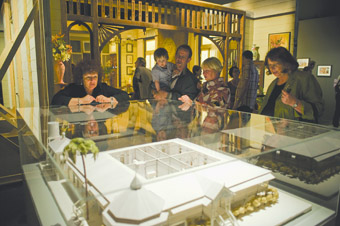
Australia exhibit, Setting the Scene, photo Nolan Bradbury
THE AUSTRALIAN CENTRE FOR THE MOVING IMAGE’S EXHIBITION SETTING THE SCENE: FILM DESIGN FROM METROPOLIS TO AUSTRALIA SHATTERS THE CINEMATIC ILLUSION TO UNCOVER THE IMPACT OF ART DEPARTMENTS, FILM ARCHITECTS AND SET DESIGNERS ON THE HISTORY OF CINEMATIC STYLE. THIS EXHIBITION EXPLORES THE PROCESSES OF CREATION IN THE CONSTRUCTION OF ILLUSORY SPACES AND REVEALS HOW AESTHETICS INFLUENCE TONE, MOOD AND ATMOSPHERE IN THE CINEMA.
Setting the Scene is based on the Deutsche Kinemathek’s Museum für Film und Fernsehen exhibition Moving Spaces: Production Design + Film. The German and Australian curators collaborated to develop a series of diachronic “spatial constellations”, emphasising the evolution of art design and the impact of old and new technologies. ACMI’s exhibition is organised into interrelated zones including: Spaces of Power, Private Spaces, Labyrinth Spaces, Transit Spaces, Stage Spaces, Virtual Spaces and Location Spaces. What emerges is a heterotopia of design with more than 300 exhibits of still and moving images, concept artwork, storyboards, computer visualisations and scale models that coalesce and collide, producing dynamic contrasts and connections by prioritising art design.
The Spaces of Power constellation illustrates the signification of control in the depiction of vast spaces, minimalist design, monumental architecture and access to vision. This area is dominated by a large film still showing the prodigious elevated office designed by Erich Kettelhut for Fritz Lang’s Metropolis (1927). The graphic symmetry of the gigantic window combined with heavy furniture supporting futuristic communications technology renders Jon Fredersen (Alfred Abel) a God-like figure, able to survey and control the city. Images of the subterranean war room set for Dr Strangelove or: How I Learned to Stop Worrying and Love the Bomb (Stanley Kubrick, 1964) display a space filled with screens showing maps the size of walls, extending the connection between power and magnitude into the realm of parody. Both upper and lower spaces are constructed for surveillance and to inspire paranoia through cinematic revisions of Jeremy Bentham’s Panopticon.
While these images are striking examples of control built from monumental set design, one of the smaller artefacts included in Spaces of Power reveals how illusions of entrapment can be created in miniature. A glass box protects a small set built by the production designer Herman Warm for Robert Weine’s The Cabinet of Dr Caligari (1919). This model is the location of the prison scene, its black background with parallel white lines descending towards a spot on the floor are used to direct the eye to the hypnotist/murderer and to radiate a sense of his torture. This exhibit also underlines the influence of the German Expressionist visual style with its high contrast, painted light and shadows, absurdly dysfunctional architecture and its cities built on jagged lines.
The first screen of the Private Spaces zone features a scene from Jacques Demme’s recitative musical The Umbrellas of Cherbourg (1964). Demme’s art director Bernard Evein and costume designer Jacqueline Moreau collaborated to develop scenes based on a specific colour palette. The design of wallpapers and fabrics complement costume, resulting in a visual style so inextricably bound to mood and tone that textures become as expressive as characters. In one scene blue floral wallpaper in the bedroom seems to imply that Geneviève (Catherine Deneuve) sleeps in a watery interior garden. A scene from Jacques Tati’s Mon Oncle (1958) shows a neighbour touring the sterile, empty spaces of the villa Arpel, teetering across the concrete floors on her stilettos, barely able to sit on the furniture which exists for its design, not for comfort. This dysfunctional modernism barely conceals the social critique created by Jacques Lagrange’s spatial design and inherent in Tati’s cinema. The exhibition includes a model of the candy coloured modernist cube house with its obsessively manicured garden surrounding a giant fish water sculpture. The model has buttons that tilt a garage door open and animate a terrier in a tartan coat.
Research photographs, film stills, sequences and a model of the maze from Stanley Kubrick’s The Shining (1980) are the most compelling aspects of the Labyrinth Spaces constellation. In Kubrick’s film, the Overlook Hotel is transformed into a site of terror with labyrinthine corridors carpeted in alarmingly contrasted colours, elevators filled with gushing blood and hallucinatory images of decay and death behind the doors of hotel rooms. Ray Waller’s production design reveals how cinematography and Steadicam can be used to insert a gliding spectral presence in interior and exterior mazes. Dante Ferretti’s film design, inspired by the Italian artist Giovanni Battista Piranesi, is also exhibited here, with production photographs and a wooden model of his staircase leading in all directions, but ultimately nowhere, from The Name of the Rose (Jean-Jacques Annaud, 1986).
Transit Spaces become visual signifiers of Marc Augé’s notion of “non-place.” Steven Spielberg’s The Terminal (2004) is filmed on a bespoke, full-sized airport terminal set built by Alex McDowell and including escalators, elevators, furnishings and 35 retail franchises. Spielberg used a periscope camera to check camera angles. The airport terminal set is a heightened non-place, its depersonalised sites of transience and anonymity emphasise movement rather than stillness. Such a transit space becomes a home for the protagonist. A model of the set, sequences from the film and interviews with the production staff reveal the film’s base in the story of the Iranian refugee Merhan Karimi Nasseri (aka Sir Alfred) who was condemned to live in a Parisian airport for 10 years.
Whilst the 1.5 scale model of the Mach 5 car in Speed Racer (Wachowski, 2009) looks like a toy, it represents the zenith of futuristic set design. For this film the Wachowski brothers and their production designer, Owen Patterson, used “virtual cinematography” to create “reality bubbles.” Curator of Setting the Scene, Kate Warren, explains that Speed Racer’s composite spaces were built from digital images of locations including Italy, Morocco, and Death Valley. These panoramas were then stitched together, manipulated and composited resulting in the creation of an artificial global space that is both everywhere and nowhere.
Australian art directors have high profiles in Setting the Scene. The highly stylised visual aesthetic developed with Tracey Moffatt by Stephen Curtis on studio sets for Night Cries: A Rural Tragedy (1989) and beDevil (1993) created surrealist inspired hyper-stylised landscapes. But some of the most striking images are shot on location, using few visual effects. A montage of research photos of post-apocalyptic locations shot by Chris Kennedy reveals images of New Orleans post-Katrina, Mount St Helens, mines in Pittsburgh and a deserted theme park in Pennsylvania, all preparation for The Road (John Hillcoat, 2009, based on the Cormac McCarthy novel of the same name), a film yet to be released in the cinema.
All paths in Setting the Scene lead to the showcase exhibit, Baz Luhrmann’s Australia (2008). This constellation includes topographic maps and interviews with art director Catherine Martin describing her initial ideas for the design, the impact of the landscape and the ways that design signals a narrative turn and implies cultural change. The most imposing and intriguing exhibit in Setting the Scene is the living room set of Faraway Downs, a key location for Australia. The set has been recreated specifically for ACMI’s exhibition and the visitor can peer into the domestic space and see the combination of European influenced heavy leather furnishings and pristine cut glass decanters sitting alongside woven baskets, boomerangs and bark sculptures. In Australia, visual design enables a subtle shift towards the inclusion of Indigenous cultures.
Setting the Scene provides a heterotopia of visual design constructed from an array of art and artefacts representing disparate times, spaces, ideas and possibilities. This exhibition highlights the visual affect, privileging the pathways, networks and rhizome-like connections between contemporary art direction and visual styles of the past and the future. With Setting the Scene, ACMI has curated a dynamic archive of the work of local and international art directors, revealing film design to be a radically evolving art form.
Setting the Scene: Film Design From Metropolis to Australia, Australian Centre for the Moving Image in collaboration with Stiftung Deutsche Kinemathek, Museum für Film und Fernsehen, Berlin; Melbourne, Dec 4, 2008-April 19, 2009
RealTime issue #89 Feb-March 2009 pg. 19
© Wendy Haslem; for permission to reproduce apply to realtime@realtimearts.net
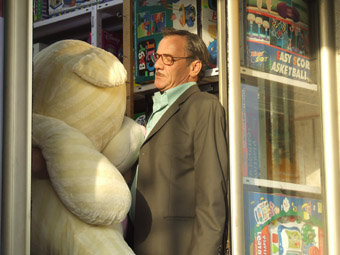
Laila’s Birthday
CULTURAL MEDIA’S MISSION IS TO STRENGTHEN INTERCULTURAL UNDERSTANDING BETWEEN DIVERSE AUSTRALIAN COMMUNITIES THROUGH THE PROMOTION OF ARAB ARTS AND CULTURE. THE FIRST PALESTINIAN FILM FESTIVAL, A NEW INITIATIVE FROM CULTURAL MEDIA—A NOT FOR PROFIT ORGANISATION ESTABLISHED IN 2007—SCREENED OVER TWO WEEKENDS IN DECEMBER AT PALACE NORTON STREET CINEMAS AND SIDETRACK SHED THEATRE IN MARRICKVILLE. IT DREW LARGE, DIVERSE AND ATTENTIVE CROWDS WHO DEMONSTRATED THAT THERE IS INDEED A GREAT HUNGER FOR MORE OPPORTUNITIES TO ACCESS AND ENGAGE WITH PALESTINIAN LIFE AND CULTURE.
The program showcased a broad spectrum of films ranging from six acclaimed feature films to independent documentary production and university sponsored educational materials. The feature film with the highest profile was Annemarie Jacir’s Salt of This Sea. It had screened in Un Certain Regard at the Cannes Film Festival in 2008, was Palestine’s 2009 Academy Awards submission for Best Foreign Language Film and has won a number of awards at international festivals.
Shot in Palestine under difficult conditions, Salt of This Sea follows Brooklyn born and bred Soraya (Suheir Hammad) as she lives the dream to return to Palestine, from which her family was exiled in 1948. Stubbornly trying to reclaim her grandfather’s savings, frozen in a bank account in Jaffa when he was exiled in 1948, she is slowly taken apart by the reality of Palestinian life around her. She meets Emad (Saleh Bakri), a young man whose ambition, contrary to hers, is to leave his home in Palestine forever.
The other fiction feature film in the program, Laila’s Birthday, directed by Rashid Masharawi, follows a complicated day in the life of Abu Laila (Mohammed Bakri) an unemployed judge currently driving his brother-in-law’s taxi to make ends meet. His quest to get a present and a cake in time for his seven-year-old daughter’s birthday is constantly interrupted by surreal, sometimes comic events.
This film captures the streets of Gaza through the windows of Abu Laila’s taxi. The conversations with passengers, and the ordeals to which the taxi is submitted, capture the state of affairs in the territory in all their absurdity and poignancy. Each unpredictable daily difficulty cumulatively begins to wear on Abu Laila, unbeknownst to those he encounters, who continue to make their insistent demands. He finally cracks as he waits for his taxi to be refuelled, unleashing a tirade through a megaphone wrestled from him by its policeman owner. Returning home, Abu Laila finds peace as his daughter giggles at the state of his taxi, accidentally decorated for a wedding during the course of the day’s many events.
On a different note, Reel Bad Arabs and Edward Said on Orientalism, both directed by university professor Sut Jhally, were built around interviews with the authors of significant books on the representation of Arabs in the West. Both films provided sophisticated discussion about the politics of representation. The publication of Said’s Orientalism in 1978 resulted in major shifts in contemporary thought, still reverberating around the world today. However, although Said talks here about the context in which his argument was first conceived and extends his discussions of the concept of Orientalism to media representations, the film shows its age and does not extend the late writer’s insights to the contemporary political situation subsequent to his death.
Sut Jhally’s other film is based on the book Reel Bad Arabs: How Hollywood Vilifies a People, written by Jack Shaheen, Professor Emeritus of Mass Communication at Southern Illinois University. The video successfully integrates interviews with Shaheen and clips from myriad movies ranging from blockbusters featuring the likes of Arnold Schwarznegger right back to some of the earliest representations in the history of cinema—an excellent companion piece to Said’s Orientalism.

Sling Shot Hip Hop
The most talked about film of the festival was Slingshot Hip Hop, directed by Jackie Reem Salloum. This unique documentary deftly intertwines stories of young Palestinians living in the West Bank, in Gaza, in refugee camps and inside Israel as they discover the power of hip hop as a tool for self-expression and cross-border communication.
Slingshot Hip Hop traces the origins and development of hip hop amongst two distinct groups, one located in the West Bank, the other in Gaza, its members young, male and female, who initially struggled against Israel’s stringent travel restrictions to meet each other. That was until they gained the support of an organisation promoting youth development projects across Palestine. These groups build hip hop into an educational tool to teach young people, to provide an outlet for self-expression and connectedness, which throughout the film is voiced in entirely non-violent terms. After the recent devastating attacks on Gaza, no doubt many who saw the film will be worried about the current circumstances of the young men and women from the group, whose stories imprinted themselves so strongly.
Writers on the Borders: A Journey To Palestine(s), directed by Samir Abdallah and Jose Reynes, likewise travelled across Palestine following artists and storytellers. It documented the journey of eight writers from the International Parliament of Writers who travelled to Palestine to visit renowned poet . Darwish, who could not leave his own country to attend their international festivals. This film continues Cultural Media’s focus on Mahmoud Darwish, following an event celebrating the life and work of the Palestinian poet at the NSW Writers Centre in October 2008.
Writers on the Borders incorporates the diverse perspectives of the international writers on the trip, each of whom muses on their experiences of Palestine in an impressive array of languages. This is integrated with readings by Darwish and others at events set up throughout the film and exciting to witness. Relentless in its documentation of almost every detail of the delegation’s journey, Writers on the Borders also successfully produces a series of intense eyewitness accounts of Israel’s ongoing, systematic project to devastate and disrupt the everyday lives of ordinary Palestinian people. It provided a useful context for understanding the relentlessness of Israel’s most recent attack on Gaza. Among many injustices, the writers encounter roadblocks designed to prevent access to universities and homes and farmland freshly bulldozed to make way for the ever-expanding Israeli incursion into Palestinian territory. Such details tend to make it to our television screens only in times of crisis.
The Palestinian Film Festival successfully brought together a diverse array of people to share many different encounters with Palestinian life. Let’s hope it becomes a regular event on the Sydney screen culture calendar and has the opportunity in the future to travel to other parts of Australia.
2008 Palestinian Film Festival, festival artistic director Sohail Dahdal; Cultural Media, Palace Norton Street Cinemas, December 5–7; Sidetrack Shed Theatre, December 13–14
RealTime issue #89 Feb-March 2009 pg. 20
© Megan Carrigy; for permission to reproduce apply to realtime@realtimearts.net
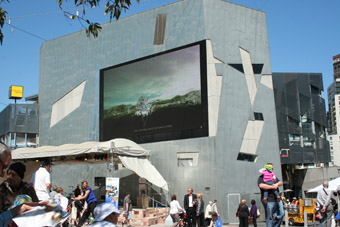
Seed Collective, www.seedcollective.org
photo Gabe Sawhney
Seed Collective, www.seedcollective.org
THEY’RE IN OUR POCKETS, THEY’RE IN OUR HOMES, IN OUR CARS, AND THEY’RE ALL AROUND OUR URBAN ENVIRONMENTS. IT’S HARD TO THINK OF A METROPOLITAN EXPERIENCE THAT ISN’T THOROUGHLY OVERLAYED AND INTERLACED WITH A HUGE VARIETY OF DIFFERENTLY SCALED SCREENS. THIS IS WHAT FIRST CAUGHT MY EYE AND LED ME TO ATTEND THE URBAN SCREENS EVENT IN MELBOURNE AT THE START OF OCTOBER 2008. HOW DO WE DEAL WITH ALL THESE IMAGE SURFACES AND NETWORKED DISPLAYS THAT TYPIFY THE PRESENT GLOBAL PUBLIC SPHERE?
When we think urban screens (as opposed to sub-urban, ex-urban or non-urban ones?), we typically conjure images of oversized projections strangely attached to Gehry-like buildings in hypermodern CBD plazas. Think Seoul. Think Times Square. Think Fed Square.
While the Bladerunner-scale of the moving image takes hold of our imagination and tends to hog centrestage, Urban Screens Melbourne 08 took a broader and more expansive view of the spatial impact of screen technologies in contemporary culture and cities. Urban screens can be seen as providing a new digital layer to the city, an augmented media space that folds and flexes its way into and out of contemporary urban experience. It was the event’s engagement with this broad field that made Melbourne’s Urban Screens 08 such an engrossing and stimulating event.
The third in an ongoing series of international projects (the first was held in Amsterdam in 2005 and the second in Manchester in 2007; RT84, p30), the Melbourne program focused its conference and related events around the theme of “Mobile Publics.” Consisting of a series of keynote addresses, panels and discussions, the conference provided a framework for the presentation of a wide variety of media works presented in public urban contexts. This multimedia program was developed by Mirjam Struppek, who was one of the originators of the Urban Screens conference in Europe, and a founding member of the newly established Urban Screens international network. The Mobile Publics Conference was jointly developed and presented by Scott McQuire, Nikos Papastergiadis and Sean Cubitt from Melbourne University’s School of Culture and Communication, and set the intellectual scene for the event as a whole.
It could be argued that Fed Square houses one of the most successful implementations of a large screen in a public mall/piazza space. Filling up an entire city block, the square was purpose-built in 2002 as a public meeting place for Melbourne. As Kate Brennan (CEO of Federation Square) noted in her opening remarks and comments during later discussions, the Fed Square screen has been programmed by the authorities/managers of that space at the same time as it’s been claimed by the general public. We see this most clearly in the public assemblies and displays of mass emotion around major sporting events and significant moments in our collective political and social history—witness the crowds around this and other large public screens for the Prime Minister’s Apology.
But does this mean that these outdoor screening spaces are appropriate for contemporary artists and media makers? Through the multimedia program, film screenings and joint broadcasting initiative, curator Struppek strove to engage audiences in the social/technical space of the Fed Square environs. This extended from the main 65-square metre Barco screen in the outdoor plaza to numerous indoor and outdoor public LED screens, interactive ticker screens and temporary projection installations. The scale of the programming, and the scope of the works was impressive, though ultimately impossible (for this reviewer at least) to see it all.
The large screen space was used to engage passersby in contemporary interactive works such as MobiToss—MobiLenin by Jurgen Schelble from Finland, SEED by Canadian artists Napoleon Brousseau, Gabe Sawhney, Galen Scorer, Dave Reynolds and Adam Bacsalmasi, and Troy Innocent’s x-milieu abstract interactive installation.
This context and curatorial strategy for works presented in Melbourne is not at all like the infamous SPOTS media façade in Berlin which began showcasing large-scale interactive artworks in 2005. Although this ‘screen’ and others of its kind in Europe were (for some time at least) devoted exclusively to electronic art and experimental/alternative content, the standard large TV format of Fed Square provides a very different, and arguably more difficult set of constraints for artists to work with. Many of the attempts I witnessed to involve the public in this kind of interactive engagement were not particularly successful, and highlight the complexity of making urban scale works that connect with ‘random’ publics.
The interactive program was complemented by a series of projection-based works that played open-air-cinema style in the evening. This is where the scale of screen, urban context and bodily rhythms of the audience fell into sharpest relief. It is incredibly difficult for these works to grab the attention of the casual passerby who has to find an entry point and an acoustic space for linear works such as these. A bit like outdoor cinema for the avant-garde, these works struggled to connect with the mobile and disengaged audience. Without the organising principle of a public political or sporting event, our bodily engagement with this form of public/social space collapses.
A number of speakers at the conference demonstrated these dilemmas from a variety of angles, focusing in on the ways media, art and technology collide with the practical construction and experience of urban space. Saskia Sassen’s opening night keynote was one of the highlights. Her talk, entitled “Heavy Metal and Fuzzy Logic”, neatly contrasted the liquid potential of media with the solid steel structures of the heavy architecture so predominant in the BMX Theatre where the conference took place. Building upon much of the work she has done as an investigator into global city/global slum (she invented the term), Sassen opened up a series of questions that were echoed by other presenters throughout the conference.
ANAT Director Melinda Rackham gave a beautifully illustrated overview of the types of work that artists and designers have been producing for a wide range of public spaces over the past few years. This helped set the scene for more culturally specific presentations by Yoshitaka Mori on “MobileTechnology Culture and the Emergence of ‘Mobile’ Subjectivities” in Japan and Aaron Tan’s impressive discussion of recent work from his Hong Kong design firm RAD. Other international speakers (such as Andreas Broeckmann, who spoke on the “Intimate Publics. Memory, Performance, and Spectacle in Urban Environments”, particularly as it applies to the contemporary reconstruction of Berlin’s social/screen space), and Leon van Schaik’s talk, “Spatial Intelligence”, expanded the theoretical horizons of the conference. Case studies presented by Manray Hsu on the Taipei Biennial and Soh Yeong Roh’s presentation on “The City as Open Creative Platform” were also noteworthy contributions to the discussions.
While it was difficult as a conference participant visiting from another city to find time to see all of the works presented around Fed Square in a couple of days, the informative display in the foyer outside the main conference theatre gave an interesting snapshot of the innovative ways that artists, designers and architects are dealing with screenspaces in urban settings.
It was apt to stage Urban Screens 08 at Fed Square, itself something of a success story in the unfolding narrative of large scale screens in public spaces. This event offered a number of provocative and fruitful ways into thinking about the claims made on behalf of public screenspace, and will provide stimulus for local endeavours in this field for some time to come.
Urban Screens Melbourne 08: Mobile Publics, Federation Square, Oct 3-5 www.urbanscreens08.net; www.seedcollective.org
RealTime issue #89 Feb-March 2009 pg. 21
© Ross Harley; for permission to reproduce apply to realtime@realtimearts.net
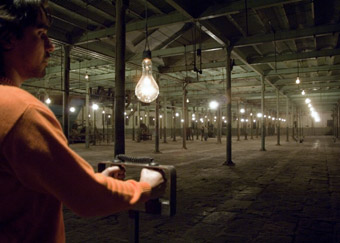
Pulse Room (2006), Mexico, Rafael Lozano-Hemmer
photo Antimodular Research
Pulse Room (2006), Mexico, Rafael Lozano-Hemmer
IN MARCH, RAFAEL LOZANO-HEMMER WILL BE ONE OF THE KEYNOTE SPEAKERS AT THE 2009 ADELAIDE FILM FESTIVAL. WHILE NOT A FILMMAKER IN ANY TRADITIONAL SENSE, LOZANO-HEMMER’S ART PRACTICE, WITH ITS INNOVATIVE USE OF LIGHT AND PROJECTION, IS HIGHLY RELEVANT TO THINKING ABOUT CINEMA IN A CONTEXT WHERE OLD DISTINCTIONS—BETWEEN FILM, PHOTOGRAPHY AND VIDEO AS SPECIFIC MEDIA, BUT ALSO BETWEEN CINEMA AND ART AS ZONES OF PRACTICE—HAVE ERODED.
Although he has been exhibiting for over a decade and half, Lozano-Hemmer’s only work so far shown in Australia was Homographies at the Sydney Biennale in 2006. (Fortunately, he maintains an excellent website with an archive of works, including extensive still and video documentation.) This should change over the next year or two, with projects under discussion for Melbourne, Sydney and Adelaide, as well as the acquisition by Tasmania’s MONA of the Pulse Room installation shown at the 2007 Venice Biennale.
One thing immediately evident in reviewing Lozano-Hemmer’s practice is his interest in working in series. This is signaled firstly in naming, notably the titling of his large-scale public projection works as “relational architecture” and his various gallery-based works as “subsculptures.” It is also manifested practically in the restaging of works in new locales and conceptually in the reconfiguration of elements of a work to explore a particular line of thought. Lozano-Hemmer notes: “Often I work parasitically: I scout a site, for instance, meet local eccentrics and stakeholders, and learn about its constraints and peculiarities. The project uses any of that information as a starting point for development. Other times I am interested in a phenomenon or an effect and pursue variations of that in different scales, or speeds or contexts.”
For instance, Vectorial Elevation (Mexico City, 1999-2000), Amodal Suspension (Tokyo, 2003) and Pulse Front (Toronto, 2006) all involved the utilisation of powerful searchlights in public space. Unlike the dominant modern aesthetic of centrally-controlled urban light spectacles, exemplified by Albert Speer’s notorious “light dome”, Lozano-Hemmer designed forms of public access, making operational the Lettrist proposal that “All street-lamps should be equipped with switches; lighting should be for public use.” While all three projects are united by the aim of redistributing social agency in public space, each deployed a different interface. In Vectorial Elevation, the lights were manouevered via an internet webpage which also became an open platform for comment; in Amodal Suspension the protocol centred on the mobile phone and SMS; while Pulse Front utilised a network of sensors to align the rhythm and orientation of 20 searchlights around the Toronto harbour with the pulses of passers-by.
Series also overlap. The sculptural interface for Pulse Front was similar to that initially developed for Pulse Room (2006), and the biometric principal has also informed recent works such as Pulse Tank (New Orleans Biennale, 2008) and Pulse Park (Madison Square Park, New York, 2008). Lozano-Hemmer comments: “I have done so many pieces with a pulse interface that I have been criticised for ‘recycling’ the interface and not truly innovating; my feeling about this is that it is an experimental approach where you must undertake these variations to get closer to developing a language or typology of interaction. Until a particular combination of media is in concert one does not really know how effective it will be.”
Interest in exploring the typology of interactions is also evident in his subsculpture series, which often involve the movement of massed identical objects. Homographies consisted of 144 fluorescent lights arrayed in a conventional modernist grid. Distributed at ceiling level above the Art Gallery of New South Wales’ main entrance court, the lights were mounted on moveable fixtures controlled by computerized surveillance systems. Seven cameras tracked the movement of visitors, triggering the rotation of the individual light tubes. A series of plasma screens along one wall showed visitors seen from the perspective of the tracking system overlaid with positional data. Wavefunction, which was first staged in Venice during 2007, consisted of nine rows of four chairs arrayed in a grid. The chairs, which combined the classic Eames plastic seat with the famous Saarinen base, filled most of a small rectangular room. As the audience entered the room and walked around, the chairs responded to their presence by moving up and down their vertical axes, generating complex ‘waves.’
Automated movement of objects often generates a strong sense of the uncanny. With works like Homographies and Wavefunction, surprise at the fact of movement is quickly overtaken by interest in the nature of the movement. It is not the position of any one object that is significant, but the movement of the set. What is being actively defined in the interplay between observer and set of objects is a field of relations. If the science of non-linear causality can be understood as the attempt to reconceptualise apparently random phenomena, this undertaking has been paralleled by the increasing importance that contingency and chance has assumed in modern and contemporary art. For Lozano-Hemmer digital media raise new possibilities of “programming without teleology.”
It is the uncertain nature of this encounter between the human and the technological which continually animates Lozano-Hemmer’s art. It also propels him into new forms of collaboration with both peers and audiences: “I programmed enough to know that I am a lousy programmer and thus I work with people who are very specialized…My model is similar to the performing arts: I am the director but there is also a composer, a programmer, a designer, a photographer or whatever other specialisations are required by the piece. In the end, though, there is a definite bias or idiosyncrasy that must be followed in order to ensure that the project has consistency.”
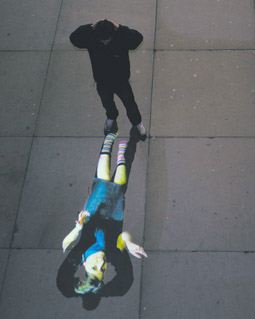
Under Scan (2008), London, Rafael Lozano-Hemmer
photo Antimodular Research
Under Scan (2008), London, Rafael Lozano-Hemmer
His large-scale public space works such as Body Movies and Under Scan demonstrate the potential for counter-intuitive uses of surveillance technology such as motion tracking systems to generate novel and creative forms of affective sociality. Body Movies involved the projection of a database of large-scale portraits onto the façade of a cinema in a public square. However, the portraits were rendered invisible due to powerful xenon lights directed on them at ground level. It was only when pedestrians walked through the square and interrupted the light that the projected portraits were ‘revealed’ in the silhouettes of their shadows. Similarly, Under Scan involved thousands of ‘video portraits’ projected onto the ground in central city thoroughfares and public spaces. The portraits appeared intermittently in the shadows cast by pedestrians, their absent subjects turning and then looking away as the passer-by left the scene. Both works used sophisticated ‘real time’ monitoring of pedestrian movement: in Body Movies, to switch to another set of images whenever all the portraits in a given scene were revealed, in Under Scan to ‘place’ portraits in a pedestrian’s predicted path. This design shifted the nature of ‘interactivity’ from its common reduction to choice from a menu of relatively predictable consequences to a far more open horizon in which contingency and unpredictability assumed a greater role. Instead of the logic of ‘taking turns’, where single users control the apparatus and produce representations that others watch, multiple users could simultaneously explore a multitude of different pathways.
These projects are not just about watching images, but depend upon the co-presence of the crowd— on interaction with others—in order for things to happen. Lozano-Hemmer stresses the active role of the public in ‘completing’ these works: “That’s a collaboration that has often been identified (for example in Duchamp’s maxim “le regard fait le tableau”) but now it is inherent to any interactive proposal. In the end Body Movies or Vectorial Elevation are platforms that are taken over by the public…If no one participates the pieces simply do not exist.”
Lozano-Hemmer’s platforms are notable in achieving a deft balance between individual agency and collective interaction, between active engagement and reflective contemplation. While technically sophisticated, they promote modes of interaction that are not simply instrumental. Passersby aren’t initially sure what is going on, but can best learn by joining in. Habit is suspended in favour of experimentation. When Under Scan was staged in London last November, Lozano-Hemmer found the location improved this experimental aspect: “The project in Trafalgar Square benefited greatly from the fact that there is already a lot of foot traffic at night. This meant people would just ‘encounter’ the work as they went home after work, for instance, rather than having to go to a specific site to see it.”
Despite their scale, the aim of these works is to initiate playful encounters rather than sublime experiences. Lozano-Hemmer observes that Under Scan “is quite underwhelming if your expectations are to see a grand cathartic spectacle in the tradition of son et lumiere or fireworks shows. Yes, we did use the world’s brightest projectors and covered 2,000 square metres with interactive portraiture, but the goal was in fact to create a situation of intimacy not intimidation. Technologies which are used for advertising, or Olympics or rock concerts are here transformed to deliver discrete, individual experiences with no proscenium, no preprogrammed narrative, no privileged vantage point.”
Intimacy is also a hallmark of the recent ‘pulse’ works such as Pulse Room which featured at the last Venice Biennale. The work consists of a grid of 100 incandescent light bulbs suspended in a room. The rhythm and intensity of each discrete light varies in response to the pulse of visitors measured when they grasp a sensor. As new users contribute data, the traces of past visitors move to the next position along the grid. Eventually, the room is filled with a complex pattern made from the mixing of 100 different heartbeats. It is a breathtakingly beautiful work which offers a profound image of the weaving of individuals into a collective without the loss of their uniqueness: an image of multitude rather than mass.
Adelaide Film Festival and Samstag Museum of Art, Art & Moving Image Symposium, Feb 27, 6pm, keynote address Rafael Lozano-Hemmer
RealTime issue #89 Feb-March 2009 pg. 22
© Scott McQuire; for permission to reproduce apply to realtime@realtimearts.net
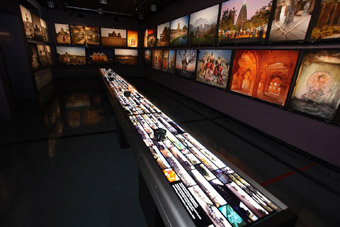
The Photography Room in the Ancient Hampi exhibition
photo Ben Healley, Museum Victoria
The Photography Room in the Ancient Hampi exhibition
VISITORS TO MELBOURNE’S IMMIGRATION MUSEUM HAVE AN OPPORTUNITY TO IMMERSE THEMSELVES IN PLACE-HAMPI, AN INNOVATIVE MULTIMEDIA, MULTI-SENSORY EXHIBITION THAT REVEALS THE WONDERS OF AN ANCIENT WORLD HERITAGE SITE IN INDIA. ON MY FIRST VISIT TO PLACE-HAMPI, A SMALL GROUP OF EXCITED INDIAN STUDENTS FILLED THE SPACE, THEIR VOICES DROWNING OUT THE SOUNDS OF THE EXHIBITION, THEIR SENSES ALIVE WITH THE FERVOUR OF THEIR INTERACTION. THESE STUDENTS WERE CREATING VIRTUAL JOURNEYS INTO CULTURAL HISTORY BY CONNECTING SPATIAL FRAGMENTS AND CONSTRUCTING NARRATIVES FROM THIS MAGICAL LANDSCAPE.
Place-Hampi is an exhibition that combines the imagery of archaeological sites and discoveries of ancient remains and relics with the sacred and the mythological. Experiments with new media technologies developed by Sarah Kenderdine and Jeffrey Shaw at the iCinema Centre for Interactive Research at the University of New South Wales have resulted in the convergence of archaeology and dreaming. Place-Hampi was commissioned for France-India year (Lille3000) and installed at Lille’s opera house in 2006.
Place-Hampi is divided into four interrelated exhibits presented across adjacent rooms. At the entrance, a topographical aerial map spread across the floor reveals a scaled down version of ancient Hampi. The map details Hampi’s terrain, the proximity of its monuments and denotes architectural features and historical locations. It also invites viewers to project themselves into the space by walking across the landscape. This hints at the interactivity to follow. Place-Hampi visually redefines Michel de Certeau’s differentiation of place and space. For de Certeau, while place is a geographically given and can be mapped, space is constructed by presence and engagement. Place-Hampi begins by defining geographic place and then invites the participant to construct their own sense of this space through movement, interaction and immersion.
The first room houses an exhibition of photographs shot by researchers over a 25-year period. This collection features Hampi’s vivid ochre and pink temples, monumental stone structures and elaborate architectural ruins. Some landscapes are illuminated by direct daylight while others are intensified by hazy sunsets. Layers of panoramic photographs fill the walls orienting visitors to the site, while smaller images spread across a tabletop light box can be inspected using a magnifier. Here the viewer shifts from tourist to investigator, scanning the photographs and focusing on details.
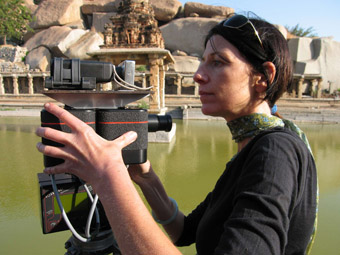
Preparing the Seitz VR Roundshot stereographic panoramic camera for photography at the Krishna Tank
photo S. Kenderdine
Preparing the Seitz VR Roundshot stereographic panoramic camera for photography at the Krishna Tank
The darkened central room requires interactive participation. A circular screen surrounds a user-controlled projection system that invites the participant to step on to a motorised platform and begin an exploration of the ancient landscape. Once on the platform, the user selects from a range of cylindrical dioramas, which are captured and navigated laterally. The driver has the ability to traverse the space and zoom in to investigate buildings and objects within the site. This virtual tour is created from “immaculate shots” of Hampi—images recorded using two stereoscopic 3D cameras. The visceral immersion that results offers a journey into a landscape where tourists can discover relics, visit ruins and explore the wonders of this sacred site.
Virtual tourists share the space with visitors to Hampi, both material and mythological. On the console, an LCD screen displays an alternative map of Hampi emphasising its symbolic links to Kishkinda, the mythological kingdom of monkeys. The surrounding screen reveals composited images of the Hindu deities Shiva, Ganesha, Sita and Durga, adding a hallucinatory vision to the experience. Artists at the Paprikaas Animation Studio in Bangalore created impressions of these Hindu gods, capturing and modelling their movements on the motion of classical Indian dancers. Sarah Kenderdine describes encounters with the mythological as “somatic engagement”, an embodied affect inspired by the Indian aesthetic tradition of chromolithography. The inscription of mythology over archaeology produces magical realism, connecting present with past to emphasise temporal continuity.
The final room repositions the virtual tourist as a researcher, presenting an impressive collection of the fieldwork that underpins Place-Hampi. Images of archaeological artefacts, newspaper articles, historical photographs and journal entries are imprinted onto plastic pages, which can be projected onto a large screen. The four rooms of the exhibition combine to present an experiential, exploratory (rather than didactic) connection with this ancient landscape. This virtual journey invites an embodied engagement, animating historical artefacts and Hindu gods with the use of new technologies. With their commitment to Place-Hampi, Melbourne’s Immigration Museum invests in new forms of exhibition to offer a unique experience and new imaginings of an ancient site, challenging its visitors to create space from place.
Place-Hampi: Inhabiting the Cultural Imaginary, Sarah Kenderdine and Jeffrey Shaw with John Gollings, Paul Doornbusch, Dr L Subramaniam and Paprikaas Animation; Immigration Museum, Melbourne; Nov 13, 2008-Jan 26, 2009;www.icinema.unsw.edu.au/projects/prj_hampi.html; www.place-hampi.museum
RealTime issue #89 Feb-March 2009 pg. 23
© Wendy Haslem; for permission to reproduce apply to realtime@realtimearts.net
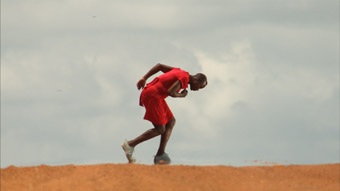
Nora
FILM DIRECTOR DAVID HINTON WAS IN SYDNEY IN NOVEMBER 2008 TO FACILITATE THE SECOND DANCE SCREEN LABORATORY RUN BY CRITICAL PATH AND REELDANCE. UK-BASED HINTON HAS DIRECTED NUMEROUS AWARD-WINNING DANCEFILMS MADE WITH ARTISTS SUCH AS DV8 PHYSICAL THEATRE, RUSSELL MALIPHANT, WENDY HOUSTOUN AND ROSEMARY LEE. HE HAS MOST RECENTLY MADE THE POETIC BIOGRAPHICAL FILM ENTITLED NORA, ABOUT AFRICAN DANCER AND CHOREOGRAPHER NORA CHIPAUMIRE, COMMISSIONED BY EMPAC IN NEW YORK, AND MADE IN COLLABORATION WITH RUSSIAN DANCE SCREEN CURATOR AND FILMMAKER ALLA KOVGAN (SEE JUSTIN SHIH PEARSON’S REPORT ON THE NEW YORK DANCE ON SCREEN SHOWING, P25). HINTON HAS ALSO DIRECTED MANY NON-DANCE DOCUMENTARIES ON ARTISTS SUCH AS FRANCIS BACON, BERNARDO BERTOLUCCI AND JOHN CLEESE.
When did you start to work with choreographers and, as a documentary filmmaker, what drew you to dance?
I knew nothing at all about dance until my early twenties. When I was at university I studied literature and thought I was going to be a writer. So dance wasn’t anywhere in my orbit or the orbit of my friends…I came across it basically because I went to work in television as a researcher on the South Bank Show. A colleague of mine, Geoff Dunlop, made a very good documentary on Merce Cunningham in the 1980s…and it really opened my eyes onto a whole new world that I never knew existed, and which I found very exciting.
Then when I started directing documentaries for the program, one thing became clear to me very quickly…If you make a film about a writer, it’s fundamentally a journalistic exercise rather than a cinematic one. The writer may be a fantastic interviewee but there’s not much you can do, film-wise, apart from setting up a shot of them talking. Dance was by far the most cinematic of the art forms. The minute you walk into a dance studio it’s all about what you can articulate through image and movement. So coming from a literary background, I quickly realised that film can’t really carry much literary content and that if you want to make something very powerful in a cinematic sense, then words are not the way to do it. I needed to find non-literary ways of working, and dance seemed to offer the best possibilities.
The cinematic influences you revealed thoughout the Dance Screen Lab—it seems you came to those after you had discovered dance and found the relevance of those directors to making the most of the cinematic potential of dance?
The influences have been progressive: as the years go by you discover new things and have new concerns. One of the first things that made me interested in film at all was seeing Werner Herzog’s Aguirre, Wrath of God (1972). Up until that time I thought of the cinema as being James Bond movies. So, just as I’d grown up without dance in provincial towns in England, neither was film a big part of my life, certainly not art films. Someone like Herzog relates to dance because of the physicality of the work. He famously said, “film is the art of the illiterates”, and I suppose that relates to dance because its power is not literary.
What models of film were useful in adapting dance work that has narrative elements, or has specific things to say, such as the work of DV8 Physical Theatre?
An important thing to say about Dead Dreams of Monochrome Men (1989) is that we never thought we were making a dancefilm. When we made it I had no sense of there being a dancefilm culture such as there is now. In fact, one thing DV8 were emphatic about was that they hated the word ‘dance’ and called themselves physical theatre. So it is kind of ironic that that film is now talked about as an iconic dancefilm.
But isn’t the success of the film because of the connection or affinity with cinematic traditions? It was physical theatre, physical cinema, not dance.
For me what it represented was a chance to make a silent movie. It was a fantastic exercise in what can be expressed purely through action and image. Up until the end of the 1920s, every film was a dancefilm in the sense that it was all about what could be expressed through the body. There’s the issue of intertitles but, fundamentally, it was about the body. All the people that made cinema into an international success story—Keaton, Chaplin, Gish, Fairbanks—they are people who are very articulate with their bodies. All those references were in my mind when I did Dead Dreams…

Mko Malkhasyan, David Hinton and Alla Kovgan on the shoot of Nora
Let’s jump from there to your new film Nora and the idea that Sergei Paradjanov—an Armenian filmmaker—was a reference point for you and Alla Kovgan. That hardly represents an African aesthetic.
Well that whole production was a kind of cultural melting pot, which was one of the things I liked about it. Alla wanted to work with Mko Malkhasyan, a cameraman from Armenia, and Nora wanted the male lead to be played by Souleymane Badolo who comes from Burkina Faso. On the set there were five languages being spoken. Apart from his tribal language, Souleymane could only speak French, Alla was speaking Russian to Mko, I was speaking English to Nora, the line producer was speaking Portuguese to the police because that is the official language in Mozambique. Then Nora was speaking Shona to the local tribal people who were taking part in the film. So just practically speaking, communication was glorious if nightmarish.
We knew we weren’t going to make an ethnographic film. We weren’t making a documentary about Shona culture. Nora is a Shona who grew up in Zimbabwe, but she’s spent many years living in New York, absorbing a lot from ballet and American modern dance which had a big effect on the movement content of the film. And behind the camera we weren’t pretending to look at the world purely passively like a documentary maker, or to look at it with an African eye. Alla’s a Russian living in America and I’m English and Mko is Armenian and it was very interesting for us to find a vision for the film that we all agreed on—but we found it a strong aesthetic, very vivid, that we all really like.
It reminded me of the Haitian footage that Maya Deren shot—in slow motion and trying to get inside this trance dancing that’s so powerful. And I’ve been thinking about the specificity of bodies, exemplified in the solo dancer in Nora—you are not watching an actor embodying a character, you are watching someone using their ‘real’ body and gestural world. So there is an affinity between dance and documentary.
Yes, it’s become a big issue for me. I’ve been thinking a lot about authenticity in dance which is a huge part of its appeal; the fact that they are actually doing it. That’s what makes it different from acting, which is pretending. And it’s a massive issue how you achieve authenticity in dance on film.
So we are not talking about documentations of dance but the way in which the poetic film structures you find in dancefilm can still contain these very real and authentic film performances.
I’m really interested in both extremes. Paradjanov and Bresson—he’s another one—these directors are basically control freaks. It’s the same with Busby Berkeley. The person making the film has a very clear vision of what they want to create and I kind of like those creative visionaries; people who find the performers they need to fulfil their vision and that’s all they require of their performers…anything else they give is just a nuisance.
And that’s exactly how choreographers can operate.
Absolutely, and often a lot of the tension between choreographers and directors is that they are both used to being tin gods in their professional worlds. It can be hard for them to give it up when they collaborate.
But a director who has a choreographic way of working with moving bodies and staging them for the screen—the way Paradjanov and Bresson do—that’s something you are able to do.
There’s a lot of different ways to make good work. The freedom is there to experiment as much as you like and take your influences from anywhere you like. Working in dancefilm now is like working in Hollywood in 1910—the rules haven’t been invented yet. You might make good work by being very controlling, or by allowing your performers lots of freedom. What interests me is when people really make up their minds, really make a decision about what they’re trying to do, and then push it as far as it will go. Then the result won’t be bland. I’m fundamentally incredibly optimistic about the future of the form.
RealTime issue #89 Feb-March 2009 pg. 24
© Erin Brannigan; for permission to reproduce apply to realtime@realtimearts.net
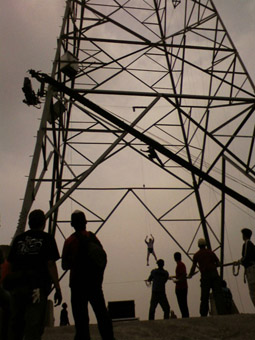
Mysteries of Nature, Dahci Ma
IT IS A COLD GREY DAY IN EARLY JANUARY, AND I AM WINDING MY WAY NORTH ALONG THE HUDSON RIVER TO TROY IN UPSTATE NEW YORK. AMIDST HARD-PACKED SNOW LITTERING THE SIDE OF THE ROAD AND SLEEPY INDUSTRIAL BUILDINGS AWAITING REVITALISATION RISES THE BRAND NEW CURTIS R PRIEM EXPERIMENTAL MEDIA AND PERFORMING ARTS CENTER (EMPAC)—AN AU$300 MILLION ARTS, TECHNOLOGY AND SCIENCE CENTRE FOUNDED BY RENSSELAER POLYTECHNIC INSTITUTE AND OPENED IN OCTOBER 2008.
A monumental glassy structure perched on the side of a hill, the building contains an acoustically awesome 1200-seat concert hall, a theatre, two large studios able to be used as residency spaces, recording studios or flexible presentation environments, and a clutch of offices. With an emphasis on research and a healthy slate of commissions and residencies to date, EMPAC seeks to provide both a place and program in which technology and the arts can inform and transform one another. A curatorial team led by director Johannes Goebel together with the new building’s state-of-the-art facilities—from custom-designed soundproofing panels to its connection to Rensselaer’s own on-campus supercomputer—promise exciting opportunities for audiences, artists and scientists alike.
On the day of my visit concentrated activity was taking place in the theatre, as filmmaker Brent Green prepared for the coming season, and in one of the studios as a team of people experimented with 3D cameras and a live feed. New media artist Sophie Kahn and choreographer Lisa Parra had set up residence in a tiny blacked-out space high in the building where they were working on a new video installation, body/traces, one of this year’s EMPAC DANCE MOViES commissions.
A project started by EMPAC’s Dance/Theater Curator Hélène Lesterlin in 2007, with a gift from the Jaffe Fund for Experimental Media and Performing Arts, the commissioning program supports new work from the Americas in the field of experimental dance film and video. The commissioning program has now been through two highly competitive open calls for proposals, helping to produce four dance films in 2007/08 and three films and body/traces in 2008/09. For a field of practice that has been dominated by European makers, and (given our relative sizes and access to funds) is well represented by Australian and New Zealand practitioners, the EMPAC DANCE MOViES initiative provides a welcome boost to dance screen production in North and South America.
If the inaugural EMPAC commissions are anything to go by, there is a strong and diverse field of activity waiting in the wings. Last year’s four films premiered at EMPAC’s opening in October where they drew capacity crowds to the concert hall. I had the opportunity to see them at the 37th Dance on Camera Festival at New York City’s Lincoln Center one late night in January this year.
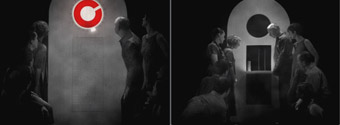
Matchbox, Daniel Belton
The program included Victoria Marks and Margaret Williams’ Veterans, a film featuring five young US veterans with post-traumatic stress disorder who play out memories of combat on the streets and beaches of LA. In Joby Emmons and Elena Demyankenko’s Kino-Eye a lone dancer’s moves through a Moscow apartment building are captured via video surveillance. Using split screen techniques to emulate the layout of security monitors and grainy, glitchy footage produced by the equipment, Emmons reminds us of the surface of the screen as both a flat assemblage of time and colour as well as a voyeuristic window in on the action.
PH Propriedad Horizontal is an excellent short from Argentinean team David Farías, Carla Schillagi and Maria Fernanda Vallejos. An abstract study of holding and being held, gravity and counterbalance, and the geometry of a long narrow alleyway, PH uses close-ups, extreme camera angles and editing to explore rhythm and relationship between the dancers, and between the dancers and their architectural space.
A highlight of the festival was the final EMPAC commission, Nora, directed by Alla Kovgan and David Hinton. Based on the life of Zimbabwean-born dancer Nora Chipaumire, this film is part biopic, part fable, part dramatic cinema and part dance film. Filmed on location in Southern Africa and lusciously coloured, Nora engages with concepts of self and memory, and the active process of remembering, using a language of dance. The traditional tools of filmmaking—lighting and landscape, pacing and movement—draw out story and character, and a searing performance by Chipaumire as herself, her mother, her father and other characters provides a strong emotional centre. Tableaux are carefully composed within the frame and in a gesture towards silent film scenes are punctuated by brief and sometimes humorous intertitles.
Cinema history emerged as one possible theme for this year’s Dance on Camera, with packed houses jostling elbows and braving sub-zero temperatures for a tribute to Busby Berkley, and several shorts in other sessions recreating early cinema aesthetics in new ways. Of these, Richard Move’s Bardo, a study of light on the human form after Martha Graham’s 1930s recording of Lamentation, and New Zealander Daniel Belton’s films Matchbox and After Durer were most notable. Belton, also a finalist in last year’s ReelDance Awards, has developed a highly distinctive style of dance filmmaking in which his dimly lit cast of characters is cleverly manipulated through speed and scale to create a flickering, black and white, Buster Keaton-like world of games, strange instruments, construction and toy theatre.
Korean filmmaker Dahci Ma’s Mysteries of Nature was the winner of the Festival Jury Prize. An accomplished and poetic contemplation of primordial and urban environments, Ma follows fingers probing at a downy skin, children emerging from mud and a man who becomes a torn plastic bag blowing in the wind. Unconventional screen proportions, a sharply dissected frame and inverted camera angles create dizzying but ultimately intriguing perspectives.
37th Annual Dance on Camera Festival, New York, Jan 6-17
RealTime issue #89 Feb-March 2009 pg. 25
© Justine Shih Pearson; for permission to reproduce apply to realtime@realtimearts.net
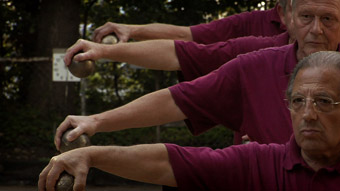
La Boule d’Or
photo Mario del Curto and Marc Perroud
La Boule d’Or
ALL FESTIVALS ARE ESSENTIALLY WORKS IN PROGRESS, WITH NEW DIRECTIONS AND DEVELOPMENTS EVOLVING AND ADAPTING FROM YEAR TO YEAR. NOW IN ITS ELEVENTH INCARNATION, DANCE FOR CAMERA, RUN BY SOUTH EAST DANCE AND SCREENED UNDER THE UMBRELLA OF BRIGHTON’S CINECITY, IS THE LONGEST ESTABLISHED OF THE BRITISH SCREENDANCE CIRCUIT, WITH NEW INITIATIVES THIS YEAR SIGNALLING A SHIFT BEYOND THE REMIT OF TRADITIONAL PROGRAMMING.
Proceedings began with Screendance Expanded, a one-day symposium, jointly organised by University of Brighton, providing a gathering point for the otherwise geographically scattered screendance community, and attracting an internationally representative mix of students, artists and academics. Following keynote speeches from Vena Ramphal and Sarah Wood, sessional focus shifted between funding, providing for youth and distribution, with a discussion forum highlighting the currently narrow range of opportunities—including Birminghan-based Dance TV and BBC commissioning—for televised and cinema-based screening. A workshop on future trends underlined the importance of advocacy and artist-led curation, with former BBC producer Bob Lockyer emphasising the need for bridge-building between contemporary production models. In addition, a panel exploring modes of discourse included visual arts writer Sally O’Reilly and dance critic Donald Hutera, foregrounding the potential of critically-led cross-pollination for a genre hindered by lack of specialist writing.
Within festival scheduling, sell-out status required an immediate repeat screening for a newly introduced, experimentally oriented program of predominantly short, single mood works. These included Christina Von Greve and C-Schulz’s intensely-focused abstraction of intermittent light sources in the monochromatic Flicker (2006); Phil Harder, Rosanne Chamecki and Andrea Lerner’s pleasingly fanciful use of stop frame animation in Flying Lessons (2007); Yves Ackermann’s deconstruction of shoot-em-up mores in Prototype (2007); and the opulent spectacle of Shelly Love’s The Forgotten Circus (2008). A complementary program of work in longer form featured Danièle Wilmouth’s A Heretic’s Primer on Love & Exertion: 29 Incidents of Dual Consequence (2007). Here, a highly-coloured picaresque world evolved from recurrent episodes of poker-faced text and task-based playfulness, with a movement vocabulary of clicks, swings, hops and jumps, linked and punctuated by a deftly rhythmic grammar of camera motion.
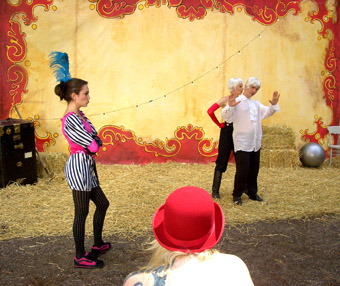
Heretic’s Primer
Also new to the festival, a quartet of documentary influenced work, selected from open call, uncovered a range of understatedly effective screen conceptualisations. Film editor Walter Murch has described the process of editing as “a kind of frozen dance” and Jonathan Perel’s 5 (Cinquo) (2008) skilfully utilised the potential of the kinetic bridge by intercutting between separately filmed versions of the same studio-set sequence. Bruno Deville and Philip Saire’s La Boule d’Or (2008) combined talking head interview with quietly assured camera positioning, alternating overhead and point of view shots as Saire coached four impassive, middle-aged boules players through stylised still positioning and elegantly composed walking patterns. Dirk Hilbert and Kasturi Mishra located the visual richness of Kathak-based studio footage within a contemporary Indian, city-based cultural context in Krishna’s Dancer (2006), while Gideon Obarzanek and Edwina Throsby’s Dance Like Your Old Man (2007) set voice over against front-on framing, as a series of young women inhabited the movement patterning and stylistic tics of their fathers’ social dancing styles, gently illuminating the complex blend of amusement, irritation and affection of one generation for another.
The first of two programs exploring non-traditional curation showcased work created in partnership with, and selected by, adults with learning disabilities. From Oska Bright, Oliver Turnbull, Miriam King and Simon Wilkinson’s The Man in The Hat (2007) reversed the workings of time and gravity as a single male figure negotiated an ambiguous, grey-scaled landscape of leaves and sky in a strikingly effective use of retrograde motion.
Meanwhile Fresh Takes—a parallel program selected by Youth Jury—drew attention to the intense physicality of the young male experience and to the integration of movement and location. Film theorist Siegfried Kracauer believed that screen-based dance should arise from context “as part and parcel of physical reality”, and in Craig Viveiros’ Stereo Step (2006), an apparently continuous Michel Gondryesque follow shot tracked street and social dance tropes through a densely populated series of exterior and interior spaces, additionally highlighting camera journey as choreographic device.
In a significant example of inter-genre lineage, a through-line was clearly traceable from Peter Anderson and Rosemary Lee’s physical and psychic interrelation of protagonist and surroundings in boy (1995) to Sergio Cruz’ visually sophisticated blending of still image and point of view shot in Animalz (2006), which imagined into being a natural context for the heightened physicality of pre-teen b-boys. Evoking the fluidity of adolescent identity, both works inhabit a liminal, shore-set landscape of scrub, sand and waves, with the “ramifications of the moment” layered into a poetically-oriented, non-linear mesh of elements and imagery, as outlined in Maya Deren’s notion of vertical narrative progression.
Of particular significance, an expanded program of installations sited in and around the Lighthouse building moved viewing engagement beyond a sit-down, front-on, single screen model. Work ranged in scope from mobile-phone-created, one-minute pieces to Jeremy Radvan’s digitised chalk-and-slate-style reinvention of Victorian visual forms in MyrioRama (2008), and Billy Cowie’s continuing experimentation with 3D imagery in The Revery Alone (2008). Here, in contrast to the highly realised environment integral to In the Flesh (2007), the traditional signifiers of performance—music, codified movement, costume—were stripped away, confronting the floor-bound viewer with their own response to the life-sized, hologramatic image of a naked female figure, suspended from four ceiling-fixed hand and foot grips, and silently shifting through gymnastic contortion in an uneasy exploration of the power dynamic central to the interchange of gaze.
Elsewhere, the highly polished visual stylisation of the Quay Brothers, shown as part of Cinecity programming in Eurydice—She, So Beloved (2007), combined large scale screen-based images with peephole-glimpsed miniaturised models, housed within a coffin shaped interior.
Luke McKernan has observed that the origins of cinema are tied to “the study of motion”, and new initiatives at Dance For Camera held up a mirror to the range of territory currently opening to pioneering artists and audiences within contemporary models of production; curation; presentation and discourse in an ever-expanding range of 21st century potentiality.
–
Dance For Camera, Brighton, UK, Dec 5-7, 2008; www.southeastdance.org.uk/danceforcamera2008
RealTime issue #89 Feb-March 2009 pg. 26
© Chirstinn Whyte; for permission to reproduce apply to realtime@realtimearts.net

Immaterial’s (detail), Joyce Hinterding and David Haines
photo Vanessa Van Emerick
Immaterial’s (detail), Joyce Hinterding and David Haines
WRITING THIS ARTICLE IN THE STERILE AIR CONDITIONING OF MY OFFICE IN SYDNEY I AM STRANGELY CLOSE TO THE ARTWORKS I AM REVIEWING. A SCENT DESCRIBED BY ARTISTS DAVID HAINES AND JOYCE HINTERDING AS “THE MOMENTS BEFORE A THUNDERSTORM” WAFTS OUT FROM MY NOTEBOOK. THIS PERFUME, IONISATION, IS AN INTERPRETATION OF THE SMELL OF THE SUN, OR MORE PRECISELY THE SMELL OF THE INTERACTION BETWEEN THE SUN AND THE AIR. IT IS ONE OF TWO FRAGRANCES IN THE INSTALLATION EARTHSTAR. WHEN I VISITED THE WORK WEEKS AGO IN BRISBANE, I STUCK A PAPER STRIP STEEPED IN THE FRAGRANCE AMONGST MY NOTES. IT IS 34 DEGREES OUTSIDE TODAY, AND I LONG FOR A THUNDERSTORM. THE SKY IS AN INTENSE BLUE THAT SHOWS NO SIGN OF CRACKING, BUT THIS STOWAWAY SMELL BYPASSES THE EVIDENCE OF MY EYES AND TELLS MY BODY SOMETHING DIFFERENT. IT IS A HARD, METALLIC, ELECTRICAL SCENT CHARGED WITH LATENT POWER. IT STIRS THE HAIRS ON THE BACK OF MY NECK AND TELLS MY EARS TO LISTEN FOR THUNDER.
Earthstar is one of two new collaborative works by Haines and Hinterding that include manufactured scents. If I turn back several pages in my notebook I come to another smell. This one is murkier—a combination of grass, mildew and a hint of car tyre. Ozone Rubber is the artists’ Eau de (and ode to the) Parramatta River. It aims to capture and intensify the olfactory experience of the salt-water part of the river below the weir, while a companion scent, Ghost Leaves, captures the subtly different scent of the river’s fresh-water upper section.
Two small bottles of the fragrances form part of a collection of objects in a boxed edition called The Immaterial’s: Language, Molecules, Vibrations. It was commissioned by Parramatta City Council as part of their outdoor sculpture programme Current 08 and is an imaginative and compelling interpretation of the idea of public art. The collection offers three different ways of recording and expressing the landscape of the river: a book containing notes, photographs and essays (language); the two perfumes (molecules) and a CD of electromagnetic field recordings (vibrations). The title’s ambiguous apostrophe suggests that this assemblage represents a set of things which are, or belong to “the immaterial”—a recurring theme in Haines and Hinterding’s solo and collaborative practices. Much of their previous work has used digital and technological structures to harness, transduce and reveal the imperceptible forces that saturate our world.
Their inclusion of scent within the category of the immaterial raises tricky questions. While art, particularly public sculpture, is often yoked to the idea of a material object, it nevertheless tends to privilege the immaterial sense of vision, which processes information that reaches us remotely through light. Smell on the other hand, is a proximal sense that requires physical contact with the thing that we are sensing. In fact smelling requires us to incorporate parts of a thing (the “molecules” of Haines and Hinterding’s title) within our own bodies. So while scent may be invisible and diffuse it is far from immaterial. In fact it is the visceral materiality of smell that makes it such an intriguing focus for art.
In their work with the electromagnetic spectrum, in both these new installations and in past works, Haines and Hinterding translate frequencies beyond normal human perception into forms that we can experience directly. With scent they are doing something subtly different—they are concentrating and intensifying an everyday experience which our senses can access, but which we rarely pay attention to. Both strategies have similar outcomes—a heightened awareness of the intimacy and complexity of our relationship to the world around us.
Richard Shusterman has argued, through a framework he calls “somaesthetics”, that the development of our perceptual and physical abilities to finely appreciate our surroundings should be central to our pursuit of the aesthetic (Body Consciousness: A Philosophy of Mindfulness and Somaesthetics, Cambridge University Press, 2008). One of the reasons that smell is rarely used in art is that, unlike our eyes or our ears, the nose is a rather blunt perceptual instrument. Most noses, excepting those belonging to sommeliers and perfumiers, have not had the practice to enable them to discerningly appreciate (or interpret) the information they receive. Oliver Sacks tells the story of a man who, after receiving a bump on the head, develops an almost canine sensitivity to smell and is flooded by a wealth of new information about the world around him. The Parramatta smell compositions are intricate, alchemical creations that deliver an exaggerated sensual experience of the mundane. The perfumes combine aromas of the area’s vegetation—mangrove, fennel, lantana and the “green grass of suburbia”—with hints of the rubber tyre plant next to the river. Haines’ assessment (emailed to me) of the Ghost Leaves fragrance gives an insight into the subtle, arcane process of perfume creation, and the sensitivity to our everyday experience which it requires: “I like its urinous aspects in the top note, a bit of suburban football oval toilet block in that…the watery part uses a chemical similar to Valium… it’s marine, ozone, stagnant pond all in one.”
While The Immaterial’s presents three different ways of representing the landscape of the Parramatta River, Earthstar offers three different, and extraordinary ways of experiencing the sun. I saw (heard and smelled) the work as part of the Premier of Queensland’s National New Media Art Award exhibition at the Gallery of Modern Art, Brisbane. The exhibition demonstrates the facts that, whatever the recent controversy over the term, the best “new media” artists are an avant-garde, combining scientific experimentation with new forms of art experience.
In Haines and Hinterding’s installation huge coiled antennas pick up the electromagnetic activity of the sun, which is amplified and played back in real time. During my visit this live sun sound-track sounded rather like a perpetual low hiss, with occasional fizzes and pops—like a soft drink being opened or an air conditioning system. A large screen shows pre-recorded images of the solar chromosphere—a layer of the sun’s atmosphere that is only visible with the naked eye as the aura at the edge of a total eclipse. Captured using a Hydrogen-Alpha telescope that filters out visible solar light, the glowing orb resembles a bloody post-apocalyptic sun with a short comet’s tail. A large refrigerator contains bottles of two “ozonic” smell compositions. These scents are made with chemicals that resemble the smell of ozone, which would itself be harmful if inhaled. Both are relational smells. The first, Ionisation, describes the interaction of the sun with the air around us, and has the sharp acridity of fried electrical wire. The second, Terrestrial, draws from the interaction of sun and earth, and has the smoky tang of campfires. The artificiality of these fragrances is made pointedly clear in labels that detail their composition. Terrestrial, for example, includes such mysterious ingredients as Helional (3-1, 3-benzodoxol-5-yl)-methyl propanol.
The installation speaks the performative language of a former age of scientific discovery. It has the theatricality of Faraday demonstrating the first electric dynamo to the rapt 19th century audiences of the Royal Institution. The work is both wonder-full and at the same time, physically and emotionally cold. Sunlight itself—as we directly experience it through the pleasurable sensations of light and warmth—is noticeably absent from the dark interior of the gallery. The work dismembers the sun into its component parts. Like Swift’s satire of the scientists of Brobdingnag, who extract sunlight from cucumbers, Haines and Hinterding’s installation can be read as a critique—perhaps of the hermetically sealed, inward looking nature of art galleries, where real world experiences are filtered and abstracted, or perhaps of a techno-scientific world view that sees natural phenomena as resources to be split apart and re-purposed.
Within the science-lab atmosphere of the installation the fragrances were presented clinically as synthetic simulations of real experience. They formed part of a collection of intellectual propositions that caused me to think a great deal, but feel somewhat less. Weeks later, however, I realise that scent has another property that makes it a particularly interesting medium for art—it lingers. Here in my notebook the ersatz smell of the sun persists, and transforms my memory of the work into something warm, visceral and alive. Weeks later, with my fingers on the keys of my computer and my eyes on the screen, the lingering scent in my notebook has a resonance that touches me as, perhaps, only a scent can. I hold the pages close to my face, close my eyes to my notes of analysis and evaluation, and inhale a different kind of record of the installation. Something in that smell triggers a rush of anticipation, memories that seem both personal and genetic—a coming storm.
Joyce Hinterding and David Haines, The Immaterial’s: language molecules vibrations (2008), Current 08: Sculpture Projects in the River City, curator Tia McIntyre, Riverbeats Festival, Paramatta, Nov 7-23; Joyce Hinterding and David Haines, Earthstar (2008), Premier of Queensland’s National New Media Art Award Exhibition, curators Jose Da Silva, Nicholas Chambers, Gallery of Modern Art, Brisbane, Nov 1, 2008-Feb 8, 2009
RealTime issue #89 Feb-March 2009 pg. 27
© Lizzie Muller; for permission to reproduce apply to realtime@realtimearts.net
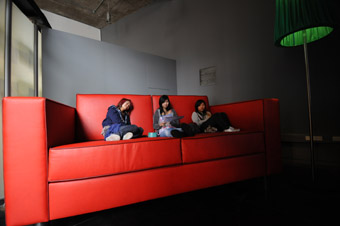
The Room (1994/2007) exhibited in Gravity Be My Friend (2007-2008), Pipilotti Rist. Viewers of Rist’s video works sit on outsized lounges: “When we watch TV the reality around us shrinks or disappears.” (Catalogue)
THE CULTURAL MAGNET WAS IN FULL FORCE DURING LIVERPOOL’S YEAR OF CULTURE 2008. WITH AN IMPRESSIVE PROGRAM OF EXHIBITIONS, PERFORMANCE, DANCE, CONFERENCES AND ASSORTED EVENTS THE LURE TO LIVERPOOL WAS FELT FAR AND WIDE. ONE OF THE EPICENTRES OF THIS CULTURAL LOVE-IN WAS FACT (FOUNDATION FOR ART AND CREATIVE TECHNOLOGY), THE MOVING IMAGE AND NEW MEDIA CENTRE ESTABLISHED IN 1988 AND CURRENTLY UNDER THE ENLIGHTENED DIRECTORSHIP OF MIKE STUBBS.
Many in the Australian cultural sector would know Mike Stubbs from his time at Melbourne’s ACMI (Australian Centre for the Moving Image). As Head of Exhibitions, Stubbs skilfully developed a range of programs that brought together sonic arts, moving image and new media. Now at FACT and working with a savvy team he is developing FACT as a focus for interdisciplinary practices in the UK.
The FACT building itself is surprisingly discrete and tucked away. Situated in the historic Ropewalks area of Liverpool and nestled in amongst warehouses and disused shops, the glass façade offers a stark contrast to the dark hues of Liverpool’s cobbled streets. In many ways the building, opened in 2003 and designed by architects Austin-Smith:Lord, is the direct opposite of the architectural signature style of most contemporary museums and galleries. Rather than screaming, “look at me I’m an icon of art and design”, FACT’s impact is integrated into the scale and history of its surroundings. It is this embedded approach into the fabric of the city that makes it an inviting and popular place for both locals and visitors.
With a café, cinemas, bookshop, black box performance space and galleries, FACT is always busy. There’s a sense that anyone can drop in at any time, have a coffee, read a book, check their email and see a film or exhibition. This welcoming approach in itself provides a gentle introduction for the general public to emerging forms of practice. New media and interactive artworks are often maligned, especially in the media for being user-unfriendly or inaccessible. FACT in many ways works to dispel this myth by directly engaging a wide public with the broad depth of contemporary art practices. The foyer entrance area is constantly in use as an exhibition space, providing an effective lure to explore the gallery, other spaces and ideas generated through FACT’s integrated programming strategies.
Having established itself as a centre for a range of audiences, the populist nature of the Liverpool Capital of Culture additionally provided FACT with a platform to raise its profile and to introduce a range of new programming and curatorial directions. A new director in any arts organisation will work with the team to shake things up, consolidate and develop an artistic vision for the future. With Mike Stubbs taking up his appointment in May 2007, the 2008 Capital of Culture provided an opportunity to introduce a series of annual themes that would engage with and create debate around wider cultural, political and social issues.
The first of these thematic directions, running throughout 2008 was Human Futures. The aim of this year-long program was to create an opportunity for prolonged and sustained debate about complex issues facing the future of humanity. In a series of exhibitions, performances, film programs and debates, questions were raised about how we deal with change, the impact of technology, the ethical and moral issues of scientific research, the limits of the body. The program brought together a broad range of international artists, thinkers, writers and critics to directly engage the public in often difficult and challenging debates. In the publication accompanying the program, Stubbs and Laura Sillars (Head of Program) wrote, “Through actively encouraging experimentation, provocation and interference, we acknowledge that it is artists who have repeatedly provided early warnings to the cultural, economic and political ramifications of new technologies through a variety of mediums, tactics and gestures.”
In developing a thematic discourse, FACT provides a platform for a broad spectrum of artists and positions new media and sci/art practice as a compelling genre from which to question the issues and challenges of the 21st century. With commissioning, exhibition and publication artists are provided with opportunities to expand their practice and develop new bodies of work. For Human Futures, the renowned Swiss video artist Pipilotti Rist premiered a new work Gravity, Be My Friend with additional new elements designed especially for FACT. The international group exhibition Sk-Interfaces, curated by Jens Hauser, explored the idea of skin as a technological interface with installations by Orlan, Stelarc, the Arts Catalyst group, Tissue Culture and Art, Zane Berzina and Julia Reodica. In a very memorable and confronting performance on the opening night of the exhibition, Swiss artist Yann Marrusich sat perfectly still in a perspex box, having ingested methylene blue which, over the course of an hour, slowly seeped from the pores of his body. A symposium was also staged in October and BBC Radio 3 and Radio Merseyside’s Festival of Ideas focused on the broader themes of Human Futures with speakers such as novelist Will Self and the KLF’s [Kopyright Liberation Front] Bill Drummond exploring the 21st Century Brain and The Value of Experience.
In 2009, the thematic thread is Unsustainable and is a response to Liverpool’s 2009 Year of the Environment. A major thrust of this overarching theme is to engage the audience and throughout the year the Climate for Change program will involve workshops, residencies, labs and debates. In responding to the city-wide focus on environment, FACT will open its doors to school groups, students and local residents to become actively involved in the generation of an arts and cultural dialogue around questions around leading an ‘unsustainable’ lifestyle.
A highlight for the year is Abandon Normal Devices, a new festival of cinema and digital culture launching in September, which goes beyond Liverpool with events in Manchester and other centres in England’s northwest. As part of AND, Thai filmmaker Apichatpong Weerasethakul will present a new installation Primitive, exploring further his preoccupation with myth, dream and memory, recounting the last 48 hours in the life of Boonmee, a passionate yogi who is able to remember his former lives.
This integration of cinema, digital media, interactivity and audience engagement is at the heart of FACT’s programming directions. It situates the building as a site for exploration and engagement, but also as a base to extend its reach into new arenas. The team at FACT is acutely aware of the rise and impact of the YouTube generation, DIY media and social networking, and in 2008 established FACT TV. This is an online channel dedicated to broader discussions of FACT’s programming, an outlet for showcasing film and video by artists and an opportunity for the local community to feedback and provide comment on events and exhibitions. FACT TV also provides an increased online presence for FACT’s resident community TV station tenantspin.
FACT is an example of an institution acting as an ‘agent of change.’ In its programming and curatorial approaches it aims to provide a platform for artists and audiences to respond to the transforming landscape of our society, environment and culture. As a regional centre it emphasises local involvement with an outwardly national and international focus. It takes seriously the challenge to our cultural institutions to be pro-active and engaged in the urgent debates of our time.
FACT, Foundation for Art & Creative Technology, Liverpool: www.fact.co.uk
RealTime issue #89 Feb-March 2009 pg. 28
© Julianne Pierce; for permission to reproduce apply to realtime@realtimearts.net
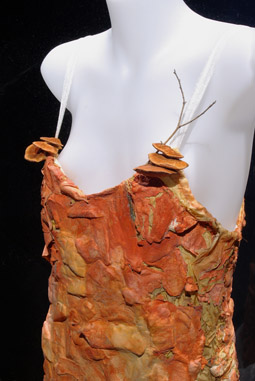
Fibre Reactive (2004-08), Donna Franklin, Coded Cloth
photo Mick Bradley
Fibre Reactive (2004-08), Donna Franklin, Coded Cloth
ROBERT COOK’S MELANCHOLIC MUSING ON THE PASSING OF THE ONCE BRIGHT CYBORG FUTURE (RT61) TRIGGERED MY OWN. AT A CERTAIN MOMENT A CYBORG TRANSFORMATION SEEMED INEVITABLE. SECURE IN OUR SLEEK, IMPENETRABLE SKINS WE WERE TO BE HYBRID, MUTABLE AND INVINCIBLE—HARDWARE TO THE CORE.
Amongst the beautiful but resolutely soft and human objects of Coded Cloth at the Samstag Museum, it’s apparent that we’ve abandoned this dream of glossy exteriors for ones pervious and porous, acknowledging the permeability of skin and cloth. Clothing, always intimately coded with social meaning, continues to offer itself as the interface, the second skin, between body and world. More flexible and adaptable, these skins in Coded Cloth are for weaving code into, transmitting, embedding and wiring.
And so the cyborg has been stripped down through the development of what started variously as installation art, game theory, design, computing, engineering, textile work and science of every description into wearable computing, locative media, bio art, cyborg tech, bio-tech, portable platforms and social networking, dispersed into tags, locators and nodes—pliable, conformable to our bodies and brushing up against our skin.
Coming out of ANAT’s reSkin 2007 wearable computing lab [RT78], Coded Cloth exhibits diverse objects that initially, aside from their material base, seem unconnected. There are few embedded devices here and the connectivity is unwired. The show is, in fact, a sampler of the huge web of intersecting transdisciplinary fields of enquiry around bio art, wearable computing, intelligent textiles and so on and on. What these objects share are operational logics and particular modes of use that extend beyond the interaction of individual and object. The coding here is not necessarily in the weave of the cloth.
Elliat Rich’s Yala Sofa (2008) is made of simple plywood forms. The Yala flowers are invisible until the heat of a seated body makes them bloom—the upholstery is richly printed with thermo-reactive ink. Gathering the Yala, a type of sweet potato, is a communal event for the Pintupi people of the Western Desert that symbolises the connections between people coming together for an action as simple as drinking tea. Even without this knowledge, the flower’s blossoming in the body’s heat suggests a trace of habitation and an intimate event.
Alice Springs-based Rich creates objects and spaces around which events can occur and social practices be sustained. Her Urban Billy (2006) is a self-contained glass billy can that makes a tea event possible anywhere. Rich’s utilitarian objects focus on the spaces and connections created in social moments. In their creation of memory maps and ephemeral traces, her works are themselves a kind of locative media.
Woven of 50% cassette tape, Alyce Santoro’s 2008 Sonic Sails (The Tell-Tail Thankgas) are coded at many levels. The Texas-based artist integrates an almost obsolete technology into the very fabric, doubling the coding with a personally significant sound collage. As the sails lift and shimmer the collage of samples on the tape are played with a tape head decoder producing a densely layered sound tapestry.
In the making of her Sonic Fabric Santoro activates networks keeping skills and tools alive, from the rescue of a specialised loom to cloth production by Tibetan women. Like Rich’s practice, sustainability here goes beyond material choice and connectivity is achieved via eloquent objects.
High Tea with Mrs Woo is a cult Newcastle clothing label with a distinct, almost Edwardian fashion aesthetic. Hidden (2007) is a modified coat dress for the intrepid female, equipped with invisible pocket warmers to enable the wearer to travel light and warm. There’s a touch of steam punk about Hidden, both in the style and in the expressed love of design, innovation and over-engineering. Unlike other wearable computing where integrated devices embed the wearer into the network, Hidden is a very self contained, private kind of wearable connecting only to the body of the wearer. Creating a closed loop, Hidden hints at the hermetic world of the traveller and historical ideas of the properly feminine—stitched down and hidden from view.
Fibre Reactive (2004-08), by Perth-based Donna Franklin, is a simple organza evening dress that provides the base for a tactile skin grown out of the orange bracket fungus. Its unusual elegance overlays a subtle and sophisticated examination of the bio-technological manipulation of living things. Wearing it is a complex act that places the wearer in the position of guardian of this fragile living thing and creates a relationship of equivalence between both lives, questioning, through our relationship with clothing, the commodification of and disposability with which we treat nature.
All of the works in Coded Cloth mine and are part of rich fields of enquiry that are fluid, overlapping and driven by experimentation. Clearly, in the video clip of the ReSkin lab, the participants were having serious fun, yet that sense of productive play hasn’t translated here, due largely to a traditional installation. Located in a dimmed room with spotlit objects on plinths and polite “Please do not sit” signs, Coded Cloth presented as very serious indeed. The show isn’t really about the objects but about their potential in connection with the body. However, interactivity here is limited to just one square each of the Sonic and Yala fabrics. A less reverential presentation might have made for a more engaging experience with what is fascinating work.
Writing about why technology hasn’t democratised the blogosphere, academic Saskia Sassen argues that it’s not the internal logic of the technology that matters but the social logic of the users (Networked Publics Symposium, California, 2006). That social logic changes and subverts the inbuilt logic of the technology. It’s not the wires or the technology but the unwired invisible logic embedded in our brains that counts. Understanding this, the artists of Coded Cloth seamlessly harness and connect internal and external worlds through our second skins.
Coded Cloth, New Media Textiles, curator Melinda Rackham, Anne & Gordon Samstag Museum of Art, University of South Australia, Adelaide, Oct 30-Dec 19, 2008
RealTime issue #89 Feb-March 2009 pg. 29
© Jemima Kemp; for permission to reproduce apply to realtime@realtimearts.net
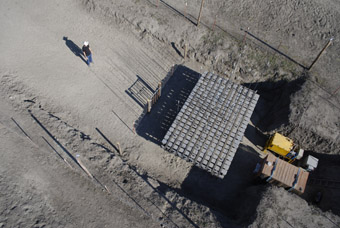
PIEQF, Parkfield Interventional Earthquake Fieldwork taken by Kite Aerial Photography,
photo Scott Haefner, U.S. Geological Survey
PIEQF, Parkfield Interventional Earthquake Fieldwork taken by Kite Aerial Photography,
PARKFIELD IS A STRANGE PLACE TO HOLD A PARTY. THE CENTRAL CALIFORNIAN TOWN, POPULATION 18, HAS ONE RESTAURANT AND ONE SMALL INN, AND GETTING THERE TAKES SOME DOING. IT’S IN ROLLING-HILL RANCH COUNTRY HALFWAY BETWEEN SAN FRANCISCO AND LA, FAR FROM THE SEA.
But what happened here on a warm Sunday morning this past November was definitely a party. Dozens of people—young and old, hipsters and housewives—crowded the rough-hewn tables of the Parkfield Café, loading up on half-pound burgers and big country breakfasts. Others lounged on the oak-shaded lawn just outside, eating picnic lunches, drinking beer and watching someone’s golden retriever splash about in the café’s fountain. Still more milled around in a dusty lot next to the lawn, staring down into a pit that could bury a brontosaurus.
At the bottom of this hole sat an ungainly contraption, a chest-high platform the size and shape of a tennis service box. But any association with tennis was fleeting, because the thing was not genteel. It was all sharp corners and rugged bolts and cables and hoses. Thirty 10-foot-high metal rods rose from its steel-slat surface, scraping the blue Autumn sky. It looked like a giant mechanical spider lying on its back in an open grave.
And everyone was here to see it. The machine was the Parkfield Interventional Earthquake Fieldwork (PIEQF), a melding of science and art. Sydney-based artist DV Rogers set it up in Parkfield in August, after more than a decade of planning, recommissioning, tinkering, and scrounging for funds. This was its last day of operation, and the gathering, at least 75 strong, was a send-off.
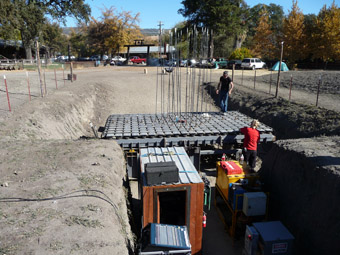
PIEQF, Parkfield Interventional Earthquake Fieldwork, DV Rogers
photo Mike Wall
PIEQF, Parkfield Interventional Earthquake Fieldwork, DV Rogers
The PIEQF is a modified shake table, which engineers use to test how buildings handle earthquake stresses. Rogers linked it up with a network of United States Geological Survey (USGS) seismic sensors across the state. Any time a quake above magnitude 0.1 struck anywhere in California—and this happens about 40 times every day—hydraulic pistons made the PIEQF shudder, rattle and clank. The steel rods bent and swayed like coral polyps in a current. The more intense the quake, the longer the shake.
Rogers put it here, in this tiny town two hours from anywhere, because Parkfield is the earthquake science capital of the world. It sits directly on the San Andreas Fault, a 1300-km-long gash in the ground where the Pacific and North American tectonic plates meet. If California ever cracks off the West Coast and sinks into the Pacific, the San Andreas will likely be to blame. Slips of the fault caused both the 1906 San Francisco earthquake (magnitude 7.8, 3,000 dead) and the 1989 Loma Prieta temblor, centred just north of Monterey Bay (magnitude 6.9, 63 dead).
Parkfield itself gets hit hard and often. Since 1857, seven magnitude 6.0 quakes have hit the area every 20 to 30 years, the last coming in September 2004. Scientists reckoned they could learn a lot about quakes—and maybe even improve their predictions—by studying a place with such regular, repeating ones. So in 1985 the USGS established a massive monitoring presence in Parkfield, and the agency has been here ever since.
The PIEQF—“part machine, part earthwork, part performance”, according to Rogers—was like a seismic antenna, transforming subterranean shock waves into machine-mediated sound and motion. And it was here to give anyone who stopped by, or visited Rogers’ website with its live video feeds (http://pieqf.allshookup.org/), a glimpse of the earth’s churning, straining heart. The PIEQF was very much a site, in the sense articulated by one of Rogers’ biggest inspirations, the American land-art pioneer Robert Smithson. That is, it drew a great deal of its power from being here, in Parkfield, on one of the planet’s widest, longest wounds. All this activity is right under our feet, and we never think about it. Forty quakes a day. Listen to your earth. And watch it move.
The PIEQF made visual the buried dynamism of the landscapes in which we live. It firmed up our sense of place, and our sense of time. For this force, 40 quakes a day, may destroy our buildings, our roads, our bridges, but at heart it is generative. It raises mountains and clears paths for lava to rise from hot, hidden depths. It has shaped the Earth steadily, constantly, over billions of years, and seeing those rods dip and sway reminded us of this fact.
This was a message Rogers wanted the PIEQF to get across. “We engage with geological time in a very shallow way”, he said. “I’m interested in introducing a human timescale to geological time.”
At 12:30, Andy Michael clambered atop the PIEQF, trombone in hand, joining two cellists and a vocalist on the mechanical beast’s back. Michael, a USGS seismologist, initially got Rogers interested in Parkfield a few years ago. And he helped get Rogers the official-sounding (but unpaid) title of USGS artist-in-residence.
The four musicians played two short songs Michael composed: “Earthquake Quartet”, written in 1999, and “Fanfare,” conceived the night before at the party in Parkfield. “Earthquake Quartet” incorporates actual seismograms as percussion, and it is the reason Michael and Rogers first touched base: Rogers heard about the piece and dropped Michael a line.
At the end of “Fanfare”, as the vocals died and the keening of strings leached into the dust, the PIEQF got a solo. For 30 raucous seconds it clattered, clanged, and shuddered, its metal slats rising and falling. But then the pistons stopped pumping, and, after 91 days of continuous operation, 43,000 webcam frames, and more than 4,000 earthquakes, it too was silent.
Now the PIEQF sits in secure storage, waiting for its next curtain. In many ways, Parkfield was just a warm-up. Rogers wants to install it in an urban setting as soon as he can raise the funds. He’s thinking LA, 2010. It’s another earthquake-prone city, and one that desperately needs an appreciation of deep time.
DV Rogers, PIEQF, Parkfield Interventional Earthquake Fieldwork, Parkfield, California, Aug 18-Nov 16, 2008. http://pieqf.allshookup.org
RealTime issue #89 Feb-March 2009 pg. 30
© Michael Wall; for permission to reproduce apply to realtime@realtimearts.net
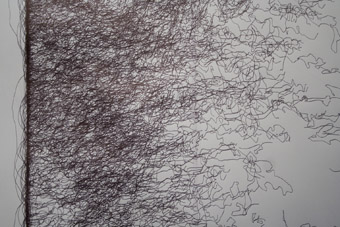
Benjamin Forster, PROCESS=ARTWORK
photo Alexandra Gillespie
Benjamin Forster, PROCESS=ARTWORK
FOR THOSE UNFAMILIAR WITH THE DORKBOT CONCEPT, IT CAN BE THOUGHT OF AS A COLLECTION OF COMMUNITIES AROUND THE WORLD WITH A COMMON INTEREST EXPRESSED THROUGH THE MOTTO “PEOPLE DOING STRANGE THINGS WITH ELECTRICITY.” ESSENTIALLY DORKBOT PROVIDES A LOOSE NETWORK AND STRUCTURE TO FACILITATE ACTIVITIES OF THOSE INTERESTED IN THE FUTURE OF ELECTRONIC ARTS. STARTED IN NEW YORK BY DOUGLAS REPETTO, THE DORKBOT IDEA HAS SPREAD AROUND THE GLOBE. THERE ARE NOW DORKBOT CHAPTERS IN ALMOST ALL AUSTRALIAN CITIES.THE CANBERRA DORKBOT, ESTABLISHED IN EARLY 2008, FINISHED THE YEAR WITH AN EXHIBITION OF WORKS PRESENTED AT THE CANBERRA CONTEMPORARY ART SPACE IN MANUKA IN NOVEMBER.
The immediate impression on entering the exhibition space was of a generous collection of creative practices reaching out into the physical world. The locus of this initial impression was Alexandra Gillespie and Somaya Langley’s collaboration, Collars, with electronics and programming by Ben Lippmeier. This minimal installation, comprising shirt collars on stands with electroluminescent strips of text showing through the material, symbolically questioned power, control and social status. The sound component, based on collected stories from those associated with the shirts, added a further tangible dimension to this installation.
The two other works that functioned in time were by Josh Wodak and Michael Honey. Wodak’s new wave cinema work, Powers That Be, brought together a collage of four voices and associated images into what Wodak described as a “synaesthaic audiovisual relation.” In this instance, one sensory mode triggers or illuminates the other. This synaesthetic experience was interactive in the sense that it is activated by the position of the viewer in the gallery. Honey’s interactive work, Eigenstate, inverted the idea of interaction by generating algorithmic visualisations when the presence of a viewer was not detected by the system. This was a work with explicit reference to scientific concepts, yet the evolution of the imagery had a singularly poetic quality.
In Estuarine Flows, Tracey Meziane Benson presented a series of solar-powered backlit transparencies. These digitally manipulated map images of the boundaries between land and sea reflected the beauty in the structural intricacies of vast environments. The presentation format also seemed calculated to inspire intimacy or personal reflection on the images.
Nathan McGinness’ Leaves was generated through the Processing programming environment. The outcome was visually intriguing and on reflection seemed to question the nature and implications of process in art. It was interesting to consider that although an almost infinite number of outcomes are possible through such a process, the final selection for public presentation is an aesthetic decision made by the artist.
Mitchell Whitelaw’s Limits to Growth reflected a much longer association with generative systems. The elegant prints (about 15) of growth in a model world have a convergent organic and visual information quality. Like the early 1920s works of Mondrian, this collection has the viewer drawn to certain structures without quite knowing why. It would be interesting to correlate a viewer’s focus with the constraints under which the engaging prints were generated. Whitelaw’s second work Watching the Street, was another time-based outcome through the use of slitscan, a time stretching technique using a long series of time-lapse images where narrow slices of each image are extracted and recompiled. The outcome was a visualisation of a scene with curious patterns and an objectivity that we would not appreciate as direct witnesses.
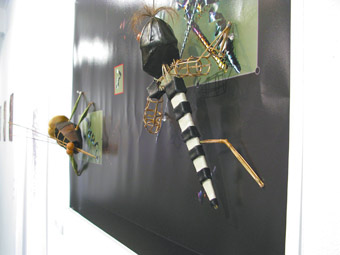
Miles Thorogood, The Developers
photo Mitchell Whitelaw
Miles Thorogood, The Developers
Using recycled materials Miles Thorogood also explored the idea of growth. In The Developers, a three-dimensional construction made from various materials could be seen as an instance from an Artificial Life simulation. Attached to a vertically mounted image were insect-like objects, which seemed to have emerged from a two-dimensional space. One reading of the work is suggestive of our unrelenting expansion and exploitation of the natural environment.
In PROCESS = ARTWORK, Benjamin Forster presented productions from his “drawing machine.” As a triptych of three long “prints”, these reflected an intriguing mechanical insight into interpretation. The work drew on text from Walter Benjamin’s The Work of Art in the Age of Mechanical Reproduction, writings of the Marquis de Sade and images of the grass in Forster’s backyard from the machine itself. The works had a more immediate sense of process when suggesting action and the characteristically nervous scrawl a compelling naiveté. It would have been interesting to see the work generated in real time along with some completed outcomes.
Clem Baker-Finch took a quite different approach in Congregation of the Index with three print works based on the New Testament. Three square prints represented three concentrations of word order: alphabetical, frequency and occurrence were generated. The compelling effect of these lexicons on the viewer was to induce a desire to scan for words and ponder their use and association. This very act prompted curious and often humorous remarks from viewers.
On reflection, the Dorkbot cbr exhibition exemplified the diversity of creativity in electronic arts that is an inherent, long standing and clearly continuing part of the Canberra contemporary art community. To this end, support for the exhibition by David Broker, the director of the Canberra Contemporary Art Space, is to be commended. As with such exhibitions of hybrid practices, diverse formats and sound, the challenge continues for effective presentation with limited time and resources. The complexity and subtlety of each work demanded attention, analysis and reflection and while this could be a challenge for any viewer on a single visit, the overall impression was inspirational.
Dorkbot cbr: Exhibition, People doing strange things with electricity, artists Clem Baker-Finch, Benjamin Forster, Alexandra Gillespie, Michael Honey, Tracey Meziane Benson, Nathan McGinness, Miles Thorogood, Mitchell Whitelaw, Josh Wodak; CCAS (Canberra Contemporary Art Space) Manuka, Nov 7-15, 2008; http://dorkbot.org/dorkbotcbr; International Dorkbot group, http://dorkbot.org
RealTime issue #89 Feb-March 2009 pg. 31
© Alistair Riddell; for permission to reproduce apply to realtime@realtimearts.net
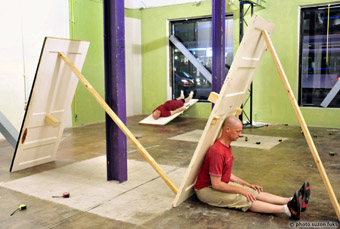
James Cunningham, Jondi Keane, Tuning Fork
photo Suzon Fuks
James Cunningham, Jondi Keane, Tuning Fork
THREE STANDOUT WORKS AT THE JUDITH WRIGHT CENTRE IN BRISBANE LATE LAST YEAR HAPPENED TO RUN CONCURRENTLY. SEEN CLOSE TOGETHER, WHAT STOOD OUT ABOUT THESE PERFORMANCES WAS THAT IN WILDLY DIVERSE WAYS THEY APPEARED MORE OR LESS CONSCIOUSLY TO BE MINING VEINS FROM THE 1960S AND 70S, NOT IN A RETRO SENSE BUT THE BETTER TO LEAP FORWARD. EACH CAN BE SEEN AS CONTINUING INVESTIGATIONS INTO “THE INTER-IMPLICATIONS AND MATERIAL PROCESSES THAT CONNECT ART TO DAILY LIFE” (JAMES CUNNINGHAM, JONDI KEANE) THAT PREOCCUPIED THE EARLIER PERIOD. THIS APPARENT RETURN TO THEORETICAL AND FORMAL CONCERNS OF A SEMINAL EPOCH SEEMS TO ME TO BE OPTIMISTIC RATHER THAN A GESTURE OF HELPLESSNESS IN THESE TIMES, AN ATTEMPT BY THOUGHTFUL ARTISTS, IN TS ELIOT’S PHRASE, AT “PURIFYING THE LANGUAGE OF THE TRIBE.” GOD KNOWS WE NEED IT.
This was most clearly the case in Tuning Fork, created and performed by James Cunningham and Jondi Keane. Theirs was a work that deliberately engaged with the new performance parameters propounded in the 60s by the likes of Kaprow and Cage, lending them an elasticity that authentically stretched to the present. Tuning Fork was a time-based performance which took place in the shopfront at the Judith Wright Centre and was thus visible to passersby. Monitors displayed time-lapse footage of the erection and dismantling of the work.
Discounting good natured exhibitionism and the odd caustic critic (“art wankers!”), this out of sync discrepancy with the live action proved a beguiling hook for many onlookers, while others apparently succumbed to that most peerless of activities: watching others work. Watching the audience inside too, working at being an audience. The performance, however skewed and unrelated to any pragmatic function, nevertheless resembled a construction site. Common construction materials—wooden doors, beams, steel, carbon fibre rods, tape measures, electrical tape—were all utilised to reconfigure and suggest new links between the height, length and breadth of the original site subdivided by I-beams and three large window boxes set into the shopfront. Carbon rods described parabolas within the space, imperceptibly suggesting the metaphysical tension of Cunningham’s lovely, Leunig-like image of a room as a little box (cube) on the curved surface of the round world. Held aloft, they shimmied together, emitting a susurrus from the natural world. At other times, rods were used as chitinous antennae. Steel rods slid along the floor smashed into walls, decrying limits. Cunningham leans backwards supported by the combined tensile strength of rods. At one point, Keane inserts rods through Cunningham’s clothing, transforming him into a weird kind of kinetic sculpture, a grunge creature reminiscent of Kurosawa’s Macbeth in Throne of Blood stuck like a porcupine with arrows. In the end, more rods connected the performers’ heads to the ceiling as they slowly revolved like a model of the Copernican universe.
Tape measures were given an anarchic life of their own in order to function as agents of misrule. Or else to pinpoint minute aspects of the space, as when suspended from a hitherto invisible nail or crevice in the wall. In this way attention often shifted from minutiae to larger dimensions of action in the space, lending the space itself the characteristic of a breathing animal. At other moments the silence and absolute stillness made it seem as if it was the space holding its breath. This tallied with the stated objective of trying to reverse the figure-ground relationship so that the site might come to the fore and take on new meaning. Moreover, the performers’ proposition that “a tuning, attuning, or retuning of the base-line of perception and action is the next productive (versus reactive) step” was more than ratified by moments I relate to the Buddhist idea of tathata, suchness, the recognition of the irreducible, indescribable nature of an object, a sound, a person. From this perspective, the work might be seen as incorporating a powerful environmental politics.
There was an obvious dialectic between the approaches of the two performers. Coming from a dance background, Cunningham seemed more focused on objects as extensions of the body, or touching other objects to elicit the life of the object itself. At the same time his movements were more abstract, more concerned with exploring the space as a performer. By contrast, Keane was task-orientated. As he says, he operates within a field of consciousness that is related to professional sports, performing actions with an awareness of how they are both backgrounded and foregrounded. While the architectonic result was a well mapped out composition, the process was not directed towards the creation of a work of art. Rather it was a case of enacting embodied moments that join the common world. As Keane expresses it, “we’re not doing art and we’re not doing non-art. We’re doing stuff together.” Sculptural and other elements in the course of the performance remained separate—constituting a performance of resistance where the dialectical process proceeds and contradictions are synthesised, only to break out again into contradictions. Tuning Fork was a valid demonstration of the concretisation of meaning and material processes as an essential element of the dialectical process itself. A source of quiet marvels. The good stuff.
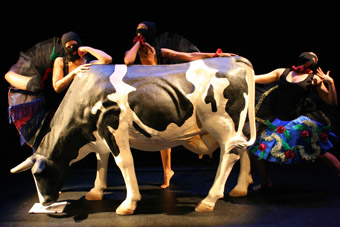
Phluxus , The Opposite of Prompt, Dance Collective
photo Marisa Cuzzolaro
Phluxus , The Opposite of Prompt, Dance Collective
The Opposite of Prompt, a collaboration between the independent artists of Phluxus Dance Collective and dancer-actor Brian Lucas, happily took on the self-critical and Brechtian strain of the 70s along with madcap elements of Dada. It delightfully deconstructs and demystifies, playing a tricksy match of handball with the audience, positing “the inescapable solid reality of performance versus the wildly imaginative and unpredictable thing that is reality.” A life-sized model of a black and white cow plays a prominent role in this regard (“Stop looking at the cow!”). Originally it was meant to be a real cow, but I can see the problems…Life, after all, is artifice, and Art? Well, Art has abandoned itself. Or at least abandoned us. Art occurred offstage, behind drawn curtains; we were only witnesses to the exits and entrances. To the hysteria. To the needs. We ourselves enter and exit OP side. Stuck in life. As Lucas says, “I’m in my apartment, in a wheelchair. I’m crippled, and I see a lot of suspicious things happening. But I connect the dots, I work out what’s happening. Or perhaps not.”
Certainly the Luciferian Lucas has the ability to pull the carpet from under our feet, revealing the abyss. He told the story of a woman who had a sick friend whom she helped to suicide to avoid needless suffering. She was convicted and sent to prison. But the woman was terminally ill and, terrified of dying alone in prison, in turn killed herself. The story is repeated several times during the performance, accompanied by a sequence of dance gestures. Finally it is the gestures themselves that tell the tale, in a characteristic Lucas move. It was pure pleasure to be reminded that Lucas is such a superb dancer, particularly in the beautifully clean, incredibly controlled, hence expressive and humorous duet performed with an equally polished Chaffia Brooks—all within the constraints of aircraft seats.
The Opposite of Prompt was a participatory sport. And there was so much more. It seduced the audience without resiling from the questions it blithely threw up in the air. Largely this was attributable to the quality of inclusiveness Phluxus extended, translating into a uniquely grounded collective style—seriously funky.
Jacqui Carroll’s To Have Done With The Judgement Of God for the Bell Tower 11 Series 2008 espoused the roots of Artaud’s Theatre of Cruelty first introduced to the Anglo-Saxon world by Peter Brook in the 1960s. Based on a 1947 radio performance by the man himself, this work-in-progress goes somewhere else in terms of Ozfrank’s previous work. Carroll’s investigation into the male psyche was shocking, scatalogical, darkly liturgical. I loved it.
Tuning Fork, created and performed by James Cunningham and Jondi Keane; Shopfront, Judith Wright Centre, Brisbane, Nov 19-23 & 26-29; Opposite Of Prompt, artists Phluxus Dance Collective (Nerida Matthaei, Chafia Brooks, Skye Sewell) and Brian Lucas, lighting design Keith Clark, soundscape construction Brian Lucas, costume design Rosa Hirakata, set construction Corrin Matthews, Shane Rynehart; Judith Wright Centre, Brisbane, November 26-29; Ozfrank, To Have Done With The Judgement Of God, creator, Jacqui Carroll; Theatre Rehearsal Room, Judith Wright Centre, Brisbane, November 27, 2008
RealTime issue #89 Feb-March 2009 pg. 32
© Doug Leonard; for permission to reproduce apply to realtime@realtimearts.net
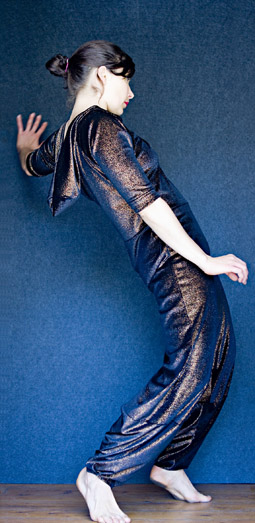
Deanne Butterworth, Vianne
photo Rohan Young
Deanne Butterworth, Vianne
“THE EMERGENCE OF THE ‘FRAME’ IS THE CONDITION OF ALL THE ARTS AND IS THE PARTICULAR CONTRIBUTION OF ARCHITECTURE TO THE TAMING OF THE VIRTUAL.” ELIZABETH GROSZ
In Chaos, Territory, Art (New York: Columbia University Press, 2008), Elizabeth Grosz writes of the frame as a basic element of the artwork. The frame provides an edge. It separates so that we can experience that which it frames. Shelley Lasica’s Vianne institutes many kinds of framing. Physically it is set inside a large, downstairs city theatre space, flanked by laneways on two sides. We can see out onto the laneway. Its fading, crepuscular light establishes the interiority of the room. During the course of the performance, a large light illuminates the lane. Later, another arises inside, shifting the origin of light—fashioning a series of emerging and dying suns. What we see, we see in virtue of these tangible sources. Their emergence and diminution draws attention to the relation between each light source and its zone of illumination. Looking beyond the room (into the laneway) circumscribes the room. It is not the world, rather it is a world within the world.
And within that world is constructed an even smaller world. This small world is a cube made of soft plastic (by Anne-Marie May). Hoisted into position by the dancers, it frames an inner space, another space of action. Some of the dancers traverse that space, others stay inside it for a while. This small world collapses, breathes out, flattens. Spatial boundaries are thus fluid. Like the lighting (Ben Cobham), the physical objects and their manner of framing are subject to change. A liquid-like sculpture is suspended from the ceiling towards the back of the room, flowing into the floor. Later, a related soft, plastic, linear thread is suspended between two dancers. In each case, we are invited to watch the action within, across and according to these shifting frames.
The room itself calls for choices on the part of the audience. Since the action moves across and between large steel poles that support the roof, we have to decide who and what to watch. The action does not entirely dictate these choices, for there is more going on than we can see. Our focus variously engages the shifting points of action, lighting and construction. That movement between structural, shifting elemental qualities, including the roving perceptual field of the audience itself, constitutes an ongoing framing and reframing process. This is permeated by the shifting rhythmic qualities of the music (Milo Kossowski and Morgan McWaters). The music moves imperceptibly between a range of tones and qualities: ambient, insistent, thumping, stellar, epic, abstract. It is evocative but not dominating.
Five dancers march into the space, all dressed in sparkling jumpsuits. One (Deanne Butterworth) stands out, rendered different by the colour of her costume, orange. There is a sociality to this nexus of human interactions, though their meaning is not obvious. Over the course of time, a narrative of sorts unfolds, suggestive of some kind of drama, though remote at the same time, as if its canvas has been painted over, sanded back and bleached (but not emptied) of emotion. Movement phrases are individually executed, alongside the formation of duos and trios. The partnering evokes a range of feelings: tender, aggressive, intimate, depending on who we watch and how they work together. However interpreted, we see dancers move together, push against each other, give weight, circle each other, execute phrase materials, and return to repeat the exercise. A mini-world is created, with boundaries that some respect, and others transgress. Sometimes everyone comes together in a row, shifting weight back and forth, a Greek chorus compared with so much atomic and molecular (inter)action.
If Butterworth is Vianne, she is not the central figure of this work. She orbits and enters the action as a human amongst others. There is no hero here, rather a complex mingling of physical subjectivities in a range of shifting formations. There is a play between the ways the bodies are shaped by their context and the agency of those bodies. The audience is also held accountable for its engagement with the work. The dancers are crisp and clear, responsible and reliable. If I could add my own preference, it would be to make of their own bodies another interiority, to take more time to feel that which occurs within in the context of their moving. The collaborative texture of Vianne suggests that no one person holds the key to its interpretation.There is no bird’s eye view, just the feeling that there is more to be revealed of this intricate composition.
Vianne, choreographer, director Shelley Lasica, dancers, Deanne Butterworth, Timothy Harvey, Jo Lloyd, Bonnie Paskas, Lee Serle, music Milo Kossowski, Morgan McWaters (PEACE OUT!), design Anne-Marie May, costumes Shelley Lasica, Kara Baker (PROJECT), lighting, design consultants Bluebottle/Ben Cobham; fortyfivedownstairs, Melbourne. Dec 3–14, 2008
RealTime issue #89 Feb-March 2009 pg. 33
© Philipa Rothfield; for permission to reproduce apply to realtime@realtimearts.net
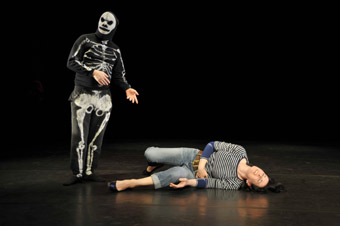
Robin Arthur, Claire Marshall, Spectacular, Forced Entertainment
photo Hugo Glendinning
Robin Arthur, Claire Marshall, Spectacular, Forced Entertainment
A MAN (ROBIN ARTHUR), IN A CRUDELY PAINTED SKELETON SUIT WHICH LOOKS A LITTLE TOO SMALL FOR HIM, WALKS OUT ONTO A BARE STAGE, GLANCES AROUND HIM, RUBS HIS CHIN. HE’S PERPLEXED. IT’S EVERY ACTOR’S NIGHTMARE: THE SET ISN’T WHERE IT SHOULD BE, NONE OF THE OTHER PERFORMERS ARE THERE, THE WARM-UP GUY HASN’T TURNED UP…NORMALLY, HE INFORMS US NERVOUSLY, NORMALLY THERE ARE POTTED PLANTS…IN THE ABSENCE OF THESE NORMS, HE RUMINATES, “AM I REALLY THE RIGHT PERSON FOR THIS POSITION?” HE FRETS ABOUT THE RIDICULOUSNESS OF HIS APPEARANCE (“THIS ISN’T HALLOWEEN”); HE SIGHS, “IT’S A STRANGE WAY TO EARN YOUR LIVING.”
Eventually a woman (Claire Marshall) appears, dressed in jeans and a T-shirt, and announces into the microphone that she has come to do her death scene. This is a parody of all death scenes—something like a cross between a fatal poisoning in a Victorian melodrama, a soldier on the battlefield or a re-enactment of the infamous Alien stomach explosion. Her violent dying takes her across the width of the stage; it moves but is not moving. Arthur starts to critique her technique, offer suggestions: the sobbing is good, it’s subtle; but what does a dying person need with a microphone stand? And so Spectacular continues exactly along these parallel lines of enquiry for an hour and 15 minutes.
Throughout, Arthur tells us how we would have been reacting if we were watching the other show, the show that should have been. This absence is something of which we become increasingly aware. There’s the absence of the rest of the collective, the absence of any development. Conceptually, this could be interesting. Instead of passive spectators, avidly consuming spectacle, we are required to become co-creators, using Arthur’s descriptions of the mythical lost performance (one in which he makes his entrance on a staircase, in which there is a band, and girls who dance in figures-of-eight, and flickers of ticker tape) to create our own private shows. (Mine is sheer vaudeville; Spectacular Spectacular as the Moulin Rouge song goes.) This ploy is not unlike that of a Croatian arts critic who used to write reviews of performances without seeing them. Unaware a concert was cancelled at the last minute, he wrote his review as usual and was rumbled. His response to complaints? He’d seen the work in his head so, as far as he was concerned, it happened. It’s not new to Forced Entertainment’s practice either; it has often relied on our participation. (If you were bored after a couple of hours of their show 12am: Awake and Looking Down it meant you weren’t working your imagination hard enough.) Actually, in many ways Spectacular is more accessible than previous Forced Entertainment shows. We are watching an actor coming to terms with the loss of his play and this self-reflexivity is familiar territory for theatre audiences (Pirandello explored this terrain in the 1920s).
The difficulty I have with it in practice is that the absent show in Spectacular is also the ghost of shows past. Spectacle is something Forced Entertainment used to do so well: television screens, paper crowns, animal masks, cardboard signs, neon text, bad wigs, velvet capes, John Avery’s music, a whole starry universe, physical exertion, text like poetry that overlaps and contradicts and refuses to cohere…I’ve followed their work since 1990 but there is Robin Arthur, patting his belly, telling us his age (45), reminding us the collective have moved on. There has been a stripping down of their aesthetic, a desire to push audiences further. During their 25 years, preoccupations have changed. Forced Entertainment member Cathy Naden once said the Gulf War occurring during the making of Marina and Lee “crept into the text and little parts of the show” but was never explicitly referenced; here the Iraq War is. Why do we want to see death in the theatre when we are surrounded by it, Arthur asks? Yet death has always been a preoccupation (shootings, hostages held at gunpoint in apocalyptic newsrooms), so the question is perhaps self-directed.
The performers are still incredible. Claire Marshall has the kind of presence that means she could just sit there and you would want to look at her. (In fact, she did just sit there in Hidden J, in1994, with a sign around her neck saying “Liar.”) Robin Arthur’s actor in the skeleton suit is a tour de force. Except this time it isn’t enough. We are supposed to be watching two deaths: Marshall’s physical one, Arthur’s metaphorical one (‘he died a death on stage’, we say of an unfunny stand-up comedian) except that neither one dies. Marshall may only have a few lines but she has a guttural repertoire of grunts, groans, screams and heavy breathing and, like the bogeyman in a slasher horror, she too just refuses to die. This is the paradox: in a show about absence or space, there is no space. (Arthur even says so: “There’s no space here.” Barely a hiatus in his monologue. It’s as if he’s scared of the silence.) Despite the humour, it’s relentless. Not even painful. Just boring.
Lights go on and off, on and off, Arthur says. A reference to Michael Creed’s infamous Turner Prize installation? I begin to feel excited by spotlights wavering on empty spots (again like actors with no roles), or alternating between pink and yellow. Is this the point? That if you remove everything, we will invest whatever you give us back with more significance and delight? I can’t help feeling David Weber-Krebs’ This Performance set up expectations and frustrated them in a more elegant, minimal way (see Virginia Baxter’s review).
I don’t doubt the boredom is intentional. “It’s a little bit disappointing”, Arthur says. It takes guts to drag your audience with you, to challenge their desire to be stimulated, to almost goad them into walking out and maybe it’s something Forced Entertainment can afford to try. (Is this the first time the collective lives up to its name?) The company has, deservedly, a loyal following. And when the mid-life crisis passes, we’ll all still be here, looking forward to something spectacular.
Forced Entertainment, Spectacular, director Tim Etchells, text Tim Etchells, Robin Arthur, the company; performers Robin Arthur, Claire Marshall, design Richard Lowdon, lighting design Nigel Edwards, Riverside Studios, London, Nov 6-15, 2008
RealTime issue #89 Feb-March 2009 pg. 34
© Marie-Anne Mancio; for permission to reproduce apply to realtime@realtimearts.net
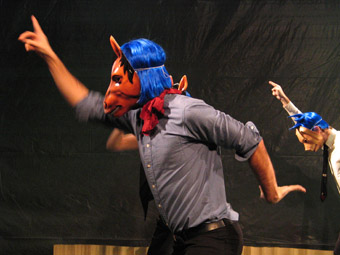
The Bluebird, Witness Relocation
photo Jonathan Slaff
The Bluebird, Witness Relocation
DAN SAFER, ARTISTIC DIRECTOR OF NEW YORK BASED PERFORMANCE COMPANY WITNESS RELOCATION (FOUNDED IN 2000) APPROACHES PERFORMANCE MAKING AS AN ATTACK—MORE AKIN TO A BOXING MATCH OR A SPORTING EVENT. THE WORK AND HE ARE “PLAYING AGAINST EACH OTHER, COLLIDING WITH EACH OTHER, FACING EACH OTHER IN THE EYE.” IT IS THE STRUGGLE THAT IS IMPORTANT—A SERIES OF PROBLEMS TO BE SOLVED. AS A RESULT, MOST OF HIS SHOWS HAVE THE WORD ‘VERSUS’ IN THE TITLE: DANCING VS THE RAT EXPERIMENT OR DANCING VS BLOOD ON THE CAT’S NECK (NOTE THE ANIMAL THEME).
While in New York, thanks to the Victoria University Solo Residency Program, I‘m lucky enough to be invited into rehearsals of Witness Relocation’s most recent work, The Bluebird, a play by Mikuni Yanaihara of the acclaimed Japanese dance company Nibrol. The work premiered in January 2009 as part of the Spotlight Japan Festival of new Japanese work. The Bluebird is Yanaihara’s first play and the first time in years that Safer has worked on a script rather than a devised work. It’s partly inspired by a 1980 Japanese anime series, is set (possibly) in a psychiatric institution, and revolves around “scientific conundrums, the rescue of endangered species and the search for one’s personal blue bird.”
Before entering the studio for my first day of rehearsals (they have already been working for one week), I meet Safer at a nearby coffee shop. He is a wonderful mass of contradictions. His tight black jeans, chains and tattoos belie a fiercely intelligent and passionate graduate of New York University’s Tisch School—where he is now also a sessional teacher. Over a typical New York ‘bowl’ of coffee, we talk ideas and theatrical obsessions. We concur on our love of Tim Etchells, DV8, Wiliam Forsythe, and David Lynch. He is a big fan of nightclub cabaret where he used to perform as a go-go dancer. He also appeared in shows with Antony (of Antony and the Johnsons) and his group Blacklips. Safer’s work is very influenced by punk/drag/cabaret/night club genres.
His mission for Witness Relocation is to “combine dance and theatre with the energy of a rock show—to explode contemporary culture into intensely physical, outrageous, poetic, and sometimes brutal performance.” He tells me that all his work is about violence and the end of the world. I ask him how he came up with the company’s name. The answer: when someone asked him where he recruited people willing to do ‘such things’ on stage he jokingly replied that they were part of the government witness relocation program—and it struck him that this was the perfect name for his new company.
Before entering the studio, Safer warns me he thinks that most of the work he does can be on the edge of being incredibly awful. Inside, the 10 performers are warming up—preparing for battle stations. The spirit of the rehearsals is playful, yet incredibly focused. They start with a barrage of dirty jokes. The rivalry has begun as they verbally spar with each other.
They are called to arms—soldiers on the front line of contemporary performance—and begin with a ‘dance’ choreographed out of their initial response to the script. It is fast paced, humorous and refreshingly original—the search for the ‘bluebird’ of the title. Safer asks his performers to give him a shell of a choreography that he can then “fuck” with. He doesn’t go for perfection. Although the choreography is strict, he is more interested in the diversity of the individual characteristics of the performers—their personality quirks, performance styles and body types. And these particular performers are variously small, thick set, young and old, traditional dancers and straight actors.
Safer’s directing style is wild and discordant yet still exacting and precise. His motto is “faster, louder, funnier” and the word “uncomfortable” is often heard in rehearsal. He gauges the workability of a piece by his own ‘boredom’ tolerance. He says: “If I get bored, I change things. If I am bored then the audience is bored.” And change happens swiftly as a result. He pushes his performers to the extremes, challenging limits and playing with what he can get away with. In one Witness Relocation show, Vicious Dogs on Premises, he randomly changes, nightly, the order of scenes as well as the performers’ roles.
And the performers never flinch. There is an unmitigated ‘yes’ attitude in the rehearsal as the performers up the ante by challenging and daring each other. The ultimate winning moment in my weeks with them was a spontaneous feigned act of cunnilingus—creating a pause of disbelief, then fits of laughter.
Rehearsals continue with regular script editing (at least one third of the text is cut), music (which plays a central role) and vocal and physical play. Much like a film director, Safer works on random parts of the script, eventually weaving them together. He creates ‘movie swipe’ style transitions—four performers crossing the space, perhaps looking for the lost bluebird species—to magically reveal the next scene. Shells of scenes are built with gestural choreography and heightened language. The tragic last scene, where the inmates all realise the futility of their existence, emerges as Safer clashes epic Michael Nyman music with the text—forcing the performers to rise to the challenge.
The deadline looms. How does it all fit together? I leave Witness Relocation on the last day before the New Year break and before the first performance. Back home I wonder how I can continue this relationship with a company whose extreme performance style resonates within my own core. The season starts and they play to full houses. I ask Safer about the response to this wild piece. He tells me that someone said they thought it was so funny but then suddenly they realised how sad it was. He‘s happy with that, and with another response (and his favourite): “That was amazing and a total mind fuck”.
www.witnessrelocation.org
RealTime issue #89 Feb-March 2009 pg. 26
© Deborah Lieser-Moore; for permission to reproduce apply to realtime@realtimearts.net
IN BACK OF BURKE, SALLY LEWRY SPINS US A YARN, A TRUE STORY, OF HER FATHER AND HIS ANTICS, TOLD WITH HUMOUR UNDERLINED WITH UNEASINESS. LEWRY IS ALMOST NEVER HERSELF: SHE IS FLAG-FOLDING EXPERT, FATHER, LOCAL JUDGE, BUT MOST OFTEN SHE IS A SHEEP. IN WOOLLY HAT AND FIRST PERSON SHE TELLS OF THE UNTIMELY DEMISE OF A NUMBER OF SHEEP EMPLOYED AS PART OF HER FATHER’S ECCENTRIC VERSION OF BACKYARD BLITZ. IT SEEMS IT WAS A ROUGH LIFE FOR THESE SHEEP IN BLACKTOWN, AS WE MAY ASSUME IT WAS FOR THE ARTSY-FARTSY DAUGHTER (THE BLACK SHEEP), NOT TO MENTION THE MOTHER, SHIRL, WHO IS ONLY MENTIONED IN PASSING BUT WHOSE IMAGE IS LEFT FOR US TO CONTEMPLATE AT THE END.
Back of Burke has some good writing, and Lewry is a truly engaging and edgy storyteller. An overhead projector is a neat device for DIY imagery particularly well used when she ‘illustrates’ stories. My niggling issue with the piece is about the flag-folding sections that bookend the show. Though these allow for the manipulation of the ‘flag’ as projection screen, it feels like a near-miss metaphor. Flying your flag, your past, your allegiances, or “putting them in the bottom drawer”, kind of works, but the flag is also a strong symbol of nationalism and militarism, a far cry from Lewry’s portrait of her fiercely individualistic father. These overtones muddied the metaphor and as the idea is only alluded to at beginning and end, with no presence in the central body of the work, it felt like an attempt to wrap up the work too tightly—to fold it too neatly perhaps. Metaphoric debates aside, Lewry is a skilled writer and performer and I look forward to more work from her.
The Paper Woman is mostly a physical performance, a form in which XX has been developing her own vocabulary: angular and suspended yet undercut with moments of frantic frustration, sometimes abject and always curious. The Paper Woman’s world consists of a bed, some suitcases, falling grapefruit, an industrial fan, various sound transmitting devices and a shopping trolley. X squat walks, crawls and gallops around this world interacting with the objects and the architecture of the space creating curious images that don’t strike immediate resonances: she holds a grapefruit under her chin, she carries a mattress up the staircase, she dribbles milk in front of the fan. These images are not from our world, but the Paper Woman’s and they all make complete sense to her. The Paper Woman is perhaps the closest to a performance of dream logic I have seen. Actions are started and stopped with equal abruptness, but undertaken with complete absorption. Within this logic the Paper Woman’s world is strangely complete yet devastatingly fragile—balancing awkwardly like X on her tippy-toes. I don’t really know where I am in this and as a viewer perhaps it is best not to impose waking rules but rather see where X takes you. What I do know is that only XX can make this world, and that renders it something quite special.
Two New Solos: Back of Burke, Sally Lewry, mentor Deborah Pollard; The Paper Woman, XX, mentor Regina Heilmann; PACT presents… initiative, Sydney, Jan 23-Feb 1
RealTime issue #89 Feb-March 2009 pg. 35
© Gail Priest; for permission to reproduce apply to realtime@realtimearts.net
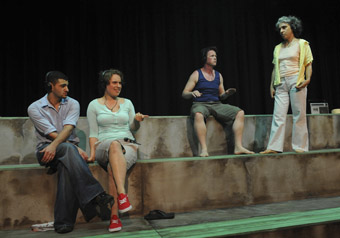
Mohammed Ahmad, Janie Gibson, Roderic Byrnes, Katia Molino, Stories of Love & Hate, Urban Theatre Projects
photo Heidrun Löhr
Mohammed Ahmad, Janie Gibson, Roderic Byrnes, Katia Molino, Stories of Love & Hate, Urban Theatre Projects
IT IS A DUBIOUS GENRE TO HAVE WITHIN THE NATIONAL REPERTOIRE BUT THERE ARE NOW SEVERAL PLAYS WRITTEN IN RESPONSE THE CRONULLA RIOTS IN 2005. THESE INCLUDE SUZIE MILLER’S ALL THE BLOOD AND ALL THE WATER, NOELLE JANACZEWSKA’S AND ATYP’S THIS TERRITORY, LAURA SCRIVANO’S THE CRONULLA PROJECT, AND BIGHART’S JUNK THEORY. AMONG THE MOST RECENT AND MOST ACCOMPLISHED OF THESE IS URBAN THEATRE PROJECTS’ STORIES OF LOVE & HATE.
Rather than confronting the Cronulla riots directly, director Roslyn Oades comes at the issue from an angle, stating in her program note that the play “is not a work about the riots, but rather a work about the ordinary people who were there.” As with her previous effort, Fast Cars & Tractor Engines (RT 70, p41), Oades has interviewed dozens of people in order create an audio-script, which is then played through headphones to actors, who repeat the lines as they hear them.
The first voice we hear is Oades’, piped in over the loudspeaker. She is in the process of setting up an interview with a young man and asking him for a definition of love. He offers one before endearingly asking “Is that alright? Do you agree?” We also meet a middle-aged couple, whose love is such that he still buys her flowers: “the other day,” he says; “the other month”, she says simultaneously. For others, love is less about a person and more about an activity such as surfing—“It’s like being in the fallopian tube again, I reckon”, “It’s a whole-body out-of-body experience”—or driving. One of the young men finds the sound of the bass literally heart-stopping—“It’s true!” he exclaims, “You can die from bass!” From here we segue into Love Song Dedications and as the strains of Kenny G’s saxophone waft through the space, Richard Mercer takes a call. These love song dedications scenes recur throughout the production to lessening effect—they seem a touch contrived and too easy to parody. Nevertheless, they provide sound artist Bob Scott with the opportunity to air a few old favourites including “Sexual Healing”, “Under the Bridge”, “O What a Beautiful Morning!” and “I Wouldn’t Trade You For the World.”
Having circled around the topic of love, the play slowly spirals inwards towards issues of hate and eventually to the events themselves. Intriguingly, divisions emerge within as well as between communities. One character is careful to point out that Punchbowl is no Mount Druitt and three young Lebanese men jokingly refer to their “ghetto” and debate whether or not they are Lebanese, wogs, Middle Eastern Australians or Middle Eastern wogs. Likewise, surfies are dismissive of those who have Southern Cross tattoos that mean nothing whereas they have scars that tell “ridiculous stories.” When the discussion finally moves to the day of the riot, the surfers insist that there were hardly any locals at the scene, that it was mainly “roo shooters and Romper Stompers.” Whoever was there was intent on violence, as a policeman and photographer reveal. A flower-giving husband is revealed as the baton-wielding policeman who saved two men who were being beaten on the train. So shocked is the photographer by the ferocity of these attacks, he says simply, “I put my camera down. I put my camera down.”
Playing against type, gender, and ethnicity, the actors do not always manage to bridge the gap between performer and character. However this does not make the work any less interesting for the spectator. On the contrary, it is fascinating to listen to Roderic Byrnes imitate the intonations of a proud Lebanese father, to hear Mohammed Ahmad giggling as a schoolgirl, to see Katia Molino’s uncanny incarnation of a conceited Cronulla schoolgirl, and to watch Janie Gibson adopting the language and posture of a young Lebanese man.
In the final scene, we hear the recording of an old lady as well as Molino’s repetition of it. Inevitably they are not the same and this serves not only as a metatheatrical reminder about the nature of repetition and mediation, but also makes visible the invisible labour of listening. Listening is a strain, it demands intense concentration, and despite our best efforts we sometimes mis-hear and repeat something else as in Chinese Whispers. The mention of this game hints at the hidden connections between multiculturalism and verbatim theatre. So much of the rhetoric surrounding both is about enabling subaltern or minority subjects to speak to the mainstream. But through its distinctive performance mode Stories of Love & Hate succeeds in shifting the emphasis from speaking to listening. In doing so the work shifts the language of multiculturalism itself, returning responsibility to mainstream subjects and asking ‘How do you listen?’ To whom and in what context? And when was the last time you really listened?’
The arduous listening of Oades and her cast contrasts sharply with the profound absence of listening that lies at the heart of the Cronulla riots. In repeating these stories of love and hate with such sensitivity and artistry, the performance provides us with an opportunity to re-hear our fellow citizens and to rehearse new modes of local, cultural, and national belonging.
Urban Theatre Projects, Stories of Love & Hate, direction & original concept Roslyn Oades, performer Mohammed Ahmad, Roderic Byrnes, Janie Gibson, Katia Molino, designer Clare Britton, sound artist Bob Scott, lighting designer Neil Simpson; Hazelhurst Regional Art Gallery, Gymea, November 19-22; Olympic Parade Theatre, Bankstown, November 26-29, 2008
RealTime issue #89 Feb-March 2009 pg. 36
© Caroline Wake; for permission to reproduce apply to realtime@realtimearts.net
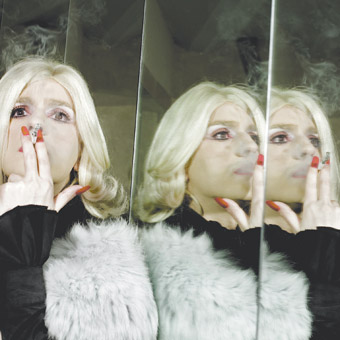
Regina Fez, Regina vs Contemporary Art
photo Rafael Gavalle
Regina Fez, Regina vs Contemporary Art
THE POLITICS OF THEATRE ARE RARELY MOMENTOUS, YET THEY ARE ALWAYS OF THE MOMENT. REGINA VS CONTEMPORARY ART IS A TRANSPLANTED PERFORMANCE, FROM ANOTHER TIME AND PLACE. FIRST PERFORMED IN PORTUGAL IN 2007, THE PIECE IS STYLED AS A PRESS CONFERENCE OR DEBATE, AN ENTERTAINMENT OF TALKING HEADS. BUT IT IS ALSO A BODILY ENCOUNTER, A PHYSICAL CONFRONTATION OF IDEAS, SIZE AND SEXUAL POWER.
Paulo Castro, as “master provocateur Doctor Ribeiro” in hipster jeans and shoulder-length hair, is compact and dynamic. Towering over him is Regina Fez; an immensely tall yet shy, retiring drag queen, she wears a figure-hugging black satin dress, her blond locks coyly covering her face. We applaud their entrance. Castro dances a little for us. Leafing through a newspaper, he presents the news of the day—or yesterday. “It’s Sarah vs Condi”, shrieks a headline. But now it’s late November, post-election. A new politics awaits.
Castro is a theatre director and performer from Portugal, now based in Adelaide (RT88, p37). Regina Fez, from Spain, presents a mysterious figure, hailing from some European border zone between the high seriousness of performance art and the avant garde of underworld porn. In her signature piece—offered to us upstage on hazy video—she vomits goldfish in a car park. As they flip-flop on the concrete, I care about their fate—more, perhaps, than I should.
The subjects of Regina vs Contemporary Art are sex, art, war, activism and terrorism. These are subjects of great moment and passion. But here in Adelaide’s tiny Bakehouse Theatre, at the end of the month-long celebrations of Feast Festival, their passion has all but dissipated, their moment seems displaced.
The tone is confrontational, unreasonable and excessive. The audience is edgy and uncertain, reluctant to respond. There are open-ended offerings in this work, and something quite freewheeling about its form. Castro strips off his shirt and dances with self-erotic pleasure. Regina pulls a tub of Yoplait from her handbag and eats it with a spoon. Invitations are extended to partake.
There are some fellow travellers in the audience—directors, performers and other artists. One reads a passage from Pinter’s War, while another wins a kiss with Regina. A third offers, upon request, his “most bombastic” sentence: “My cock is a weapon of mass destruction.” But I don’t believe his ego. I prefer the soft-edged irony of Regina’s “Lick my Gaza Strip.”
In one fond moment towards the end, Castro and Regina dance in a ballroom embrace, having wrapped themselves in such sentence-signs which they gently shed as they rotate. The sweetness of the moment is sharpened by a pervasive current of sexual aggression. At other times, they argue and they fight. They take their violence offstage and bring it back again. But Regina seems to lack the energy or inclination to offer much in the way of fighting back.
This jangling, nervous elegy to the politics of elsewhere recalled for me the past rhetoric of futurist performance, its audience anxieties elusively translating the dislocation of European desires.
Regina vs Contemporary Art by Paulo Castro with texts by Pinter, Houellebecq, Pasolini with Regina Fez and Paulo Castro, presented by Feast Festival & Castro Stone Productions, Bakehouse Theatre, Adelaide, Nov 25-29, 2008
RealTime issue #89 Feb-March 2009 pg. 36
© Jonathan Bollen; for permission to reproduce apply to realtime@realtimearts.net
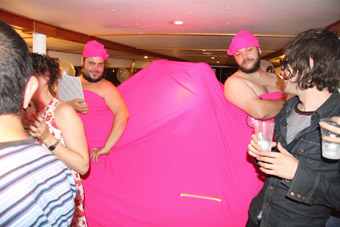
Julian Crotti, Chris Tamm Hard, Its Passing By Me (VIP ROOM), Willoh S. Weiland, Hard Party
photo Kathryn Barron
Julian Crotti, Chris Tamm Hard, Its Passing By Me (VIP ROOM), Willoh S. Weiland, Hard Party
ON JANUARY 15, A LARGE GROUP OF PEOPLE IN HIGH WAISTED JEANS, CHROMATIC TIGHTS AND EXCESSIVE EYE MAKE-UP GATHERED AT EAST CIRCULAR QUAY TO BOARD A BOAT. HYBRID PRACTITIONERS IN AN INTERDISCIPLINARY CONTEXT, EVERYONE RESEMBLED ONE ANOTHER SUFFICIENTLY SO THAT THE PASSENGERS COULD IDENTIFY EACH OTHER AMONGST THE PASSING TOURISTS ON THE CORSO WITHOUT EFFORT OR DOUBT. THEY MILLED AROUND SMOKING HAND-ROLLED CIGARETTES AND EXCHANGING FESTIVE GRIMACES, WAITING FOR THEIR SHIP TO COME IN.
The group in question was waiting for the Hard Party boat to dock. An exhibition on a boat and a “Harbour Cruise Party”, Hard Party was a three hour long irony-laced critique of how youth culture has become dominated by binge drinking, celebutards and meaningless glamour (note how important the placement of the inverted commas were to the meaning of that sentence, and how much it would have changed if they’d been placed around “boat” or “exhibition”).
The audience was free to roam the boat, mingle, dance to party anthems and fool around with a video juke box (a sort of video art parody of the endless video clips played in conventional night clubs). Post subverted wet t-shirt contests by holding a wet t-shirt contest, which I saw from behind, and involved a lot of endurance pogoing to orders given by the inimitable Zoe Coombs-Marr until the performers coughed blood all over their breasts. Brown Council stuck their heads in buckets of water every time the song “Take My Breath Away” played, in a sort of auto-erotic asphyxiation game, and looked correspondingly moist and refreshed. DAMP, a Melbourne based collective, wore rubber noses and talked amongst themselves. Every now and then, revellers received an anonymous SMS, like this one:
“Babe where are you? The DJ suck.. I just dropped my phone in the toilet!: Meet me in the sweat corner next to bar! Cum on!” 21:36
I don’t really know what a hybrid practitioner in an interdisciplinary context is any more than the next boatswain, but do you know what cognitive dissonance is? Cognitive dissonance is a psychological term that describes the state of mild discomfort caused by holding two contradictory ideas in one’s mind at the same time. It dates back to a classic 1959 experiment by psychologists Festinger and Carlsmith, in which three groups of voluntary test subjects were asked to perform an unutterably boring and tedious task, turning wooden pegs for an hour, and then requested to persuade a third party that what they had done was fascinating. The first group was paid nothing, the second group a dollar, and the third group twenty dollars. When asked to describe how they actually assessed the experiment, the second group was most likely to rate it positively. They’d been bribed, but with an amount so paltry that they’d been forced to internalise the lie they’d told, as they couldn’t reconcile their dishonesty with such small gain.
Full disclosure: I wrote a short essay for the Hard Party catalogue. That was my dollar. However I’d be lying if I pretended it was clear to me where the ‘irony’ stopped and the party started. That was clearly intended, but the problem that the event faced is that it couldn’t really succeed as a party without failing as a critique, not without some horrifying ship-of-fools climax in which the boat crashed into the pier. All the same, the crowd didn’t turn into the egregious drunken rabble the organisers might have feared or hoped for. That was chiefly due to the micro-economics of the situation. Most artsy types turn up to these sorts of events with less than $20 in cash (excluding tickets). Drinks were around $7 each, you couldn’t bring your own alcohol, and there was no ATM on the boat. Even the impeccably besuited Gilbert and George (Lucas Ihlein performing as George the Shit, and Mickie Quick playing Gilbert the Cunt, or vice versa), who were doing a reprise of the 1972 12-minute video “Gordon’s makes us Drunk” (for three hours), were only two sheets to the wind, as the ship’s purser had confiscated their 1 litre bottle of gin in the first half hour.
“I just saw somethin really full on I feel a bit sick, can we go now?” 22:28
Doubtless the best work of the night was Willoh S Weiland’s. Having cottoned on to the importance of exclusivity in maintaining glamour, she established a VIP room under extraordinary spatial constraints. The VIP tent consisted of a Leigh Bowery style confabulation of metres and metres of soft pink fabric held in shape by two huge burly gay genies. One of them was “security”, the other was “door bitch.” If one was lucky enough to get past “security” and could sweet talk “door bitch”, one was allowed to climb under the genie’s skirts into a synthetic womb, where the diminutive Weiland was eager to “do lines”, which consisted of repeating an arbitrary sentence, such as “there’s treasure in that sunken chest of yours”, over and over until it was perfect.
“i feel hot and heavy and everything. and weird. Do you know those kids who never made it through the party? xxxx” 23:22
Nothing much else happened. One of the members of DAMP, when I asked how they thought the night went, said that it was impossible to tell if it was good or bad because “Sydney is such a category error. Everything here is so wrong, there’s no point judging it.” Considering how lazy and boring their performance was, that just seemed like terrible manners. At least one drunken outlier who was actually wearing a cocktail dress had the audacity to confiscate Gilbert and George’s megaphone and boom at them, “You don’t even have any more gin. You guys are lame.” The ship came into dock. No one fell overboard, and the remnants of the exhibition drifted down to Jackson’s on George, a notoriously awful pub, for more ironic drinking. And that was it.
Hard Party, Artist interpretation of a party cruise, curator Lara Thoms, performers Brown Council, Post, Willoh S Weiland, DAMP, Teik Kim Pok, Tully Arnot, Hana Shimada, DJ V NRG, Lara Thoms, video jukebox Katarzyna Kozyra, Tara Marynowsky, artistas amistosos de neukölln, Corey Coda, Mathew Hopkins, Sally Rees, Rachel Scott, Emile Zile, TR Carter, Sue Dodd; Sydney Harbour, Jan 15
RealTime issue #89 Feb-March 2009 pg. 38
© Adam Jasper; for permission to reproduce apply to realtime@realtimearts.net
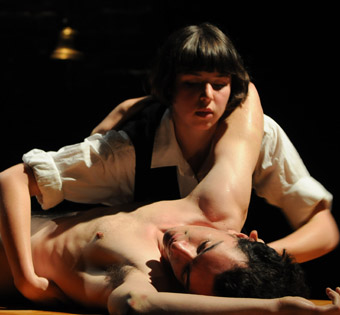
Sasha Cohen and Faustina Delany, The Three Minute Bacchae and other Extreme Acts
photo Heidrun Löhr
Sasha Cohen and Faustina Delany, The Three Minute Bacchae and other Extreme Acts
Each year, PACT Youth Theatre’s Impact Ensemble program provides eight months of regular weekly training and skills development sessions for young theatre makers. In the last three months the focus is on the development of a new work. Under the direction of Regina Heilmann, the 14 members of the 2008 ensemble created The Three Minute Bacchae and Other Extreme Acts. Drawing on motifs from Euripides’ tragedy The Bacchae, the performance is a poignant exploration of the nature of extreme acts and their impact on the everyday.
While we’re in the foyer, a young woman armed with a stopwatch delivers a three-minute synopsis of Euripides’ gruesome revenge story revolving around Dionysus, God of wine and inspirer of ritual madness and ecstasy. He cruelly punishes his cousin, King Pentheus, and his mother for not worshipping him. It’s an impressive feat of telling given the sprawling narrative and interminable lineup of characters. Once inside the theatre, the spirit of Dionysus is invoked by serving the audience wine. The performers engage in a series of everyday rituals of varying pace and duration—getting dressed, preparing a meal, chatting on the phone, brushing teeth, smoking a cigarette. These diligently executed actions seem controlled and considered but there is a sense of underlying threat, barely contained. There is a glimpse of it early on when a male performer drinking a longneck VB is suddenly grabbed and hosed down with water.
Firmly anchored in the here and now, a lot of the actions in the first half of the piece revolve around a ‘to do’ list written up on the wall, like a menu, with each task struck off once completed. Most of them have as their target a young man lying naked on a large wooden table, as if in a morgue. Yet references to The Bacchae are soon incorporated and proceedings take on a more pointedly theatrical tone. Short passages from the play are read and the line “I had a dream last night, mother; I dreamt I was decapitated” is transmuted into a song delivered by four chorus girls. It also becomes clear that the man on the table is Pentheus, victim of Dionysus’ revenge. Eventually the performers transform into a heaving mass of rolling bodies, gradually closing in on Pentheus, trapping him under the table. Fast, rhythmic hand drumming on the table is a prelude to the group turning into a violent mob. Pentheus is flung from side to side, and eventually lifted up and dropped to the floor. After a powerful, gospel-like chorale consisting principally of the line, “Oh savage truth, my son is dead”, Pentheus rises and, with a knowing look at the audience, lies back on the table as before.
Supported by a cleverly arranged soundtrack by James Brown and Emma Ramsay and sumptuous lighting by Frank Mainoo, The Three Minute Bacchae and Other Extreme Acts is a skilfully constructed, thought-provoking piece of contemporary performance. Heilmann’s direction is assured and sensitive, the ensemble perform with commitment and maturity.
The Three Minute Bacchae an other Extreme Acts, director Regina Heilmann, performers imPACT Ensemble 2008, sound design James Brown, Emma Ramsay, lighting design Frank Mainoo, dramaturgy Bryoni Trezise, scenic artist Robyn Higgins; PACT Theatre, Nov 19-Dec 7
RealTime issue #89 Feb-March 2009 pg. 38
© Martin del Amo; for permission to reproduce apply to realtime@realtimearts.net
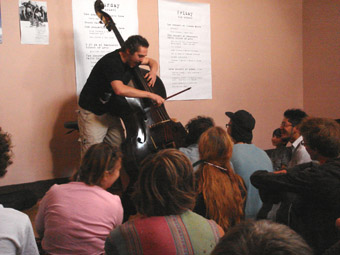
Mike Majkowski, the NOW now
photo Vivian Spadaro
Mike Majkowski, the NOW now
IN HOLLIS TAYLOR’S “THE MUSIC OF NATURE AND THE NATURE OF MUSIC”, A SATURDAY AFTERNOON LECTURE AT THE 2009 NOW NOW FESTIVAL, WE ARE INTRODUCED TO ZOÖMUSICOLOGY. USING EXAMPLES SUCH AS THE THEME AND VARIATION OF THE LYREBIRD, THE CUT AND PASTE OF THE PIED BUTCHER BIRD, OR THE SHIFTING PHRASING OF DINKY THE DINGO, TAYLOR QUESTIONS WHETHER ANIMALS ARE MAKING AESTHETIC CHOICES WHEN THEY SING. EDUCATIONAL AND ENTERTAINING, THE TALK FORMED THE PERFECT PREFACE TO THE NEXT 24 HOURS OF CURIOUS PERFORMANCES BY THAT STRANGE ANIMAL, THE IMPROVISING MUSICIAN.
The Saturday evening concert at Wentworth Falls School of Arts commenced with festival founders Clare Cooper and Clayton Thomas, on a brief return visit from Berlin, playing with Robin Fox and Martin Ng. Thomas leaps straight in, using his repetitive bowing technique to create a drone of harmonics, nicely matched by tumbling, crumbling static from Fox on laptop, while Ng manipulates his turntable producing pops, cracks and quick vinyl swipes. Cooper on guzheng provides a subtle, yet suturing layer, the timbre of her instrument intermingling with the bass but also mimicking electronic textures. The piece winds itself into a climax pushed on by high-pitched feedback coming from Ng holding his headphones to the stylus; and then it’s over. Thomas seems surprised…perhaps the improvisation might have gone somewhere else, but as it was, it was tidy and concise.
The next set featured Joe Derrick and Simon Ferenci on trumpets—a challenging combination for players and listeners. The musicians explore the possibilities of the instrument while trying to avoid playing too many notes: sustained breathy half rasps, the sound of clacking valves, various mutes and materials over the bell to vibrate and mutate, watery spittle sounds, scraping the brass. While both players are very thorough, the set never moves beyond a series of elements.
The extreme vocals grouping lived up to its title. Kusum Normoyle, Aaron Clarke, Rivka Schembri and Bonnie Hart all have their moments of screaming, the female banshee wails nicely tempered by the death metal bawls of Clarke. Normoyle alternates between screams and purrs, Schembri rocks on the floor out of sightline so it’s hard to attribute noises to her, but I suspect she is adding the more textural, animal sounds. Hart has a set of guitar effects pedals to augment her throaty utterances with feedback. The piece is interesting as a series of overlapping proclamations, but have they been trapped by being labelled as extreme? As with the trumpeters, I had a sense these artists in combination with other instruments might have produced more complex explorations.
Helmet Head is the audiovisual pairing of Anthony Magen and Rod Cooper. Cooper stands mid-stage wearing a white welding mask with a metallic frame attached—like a set of antlers—supporting a screen. Magen, in front of audience, uses an Elmo (a souped-up overhead projector) to create visuals displayed over Cooper’s head. The sound is played from tape, chopped up by manual fastforwards and reverses, with crunchy noises of curious origin. Magen places objects he has found around the area onto the Elmo—bubble wrap, a cauliflower, toys with lights—the extreme close-up and lighting shifts rendering all things alien. For many in the audience the directness of live visuals along with Cooper’s battle against gravity was enough, however I found the performance rushed and lacking trust in the materials—sonic and visual resonances were hinted at, but not quite achieved…though I’d like to see Helmet Head again.
Sandwiched between two hyperactive visual acts was the contemplative trio of Magda Mayas, Monika Brooks and Laura Altman. It’s very, very quiet, the overlapping of soughing and sighing from Brooks’ accordion and Altman’s clarinet creating a sustaining environment for the rattles and moans coaxed from the piano by Mayas, who without ego leads this concentrated exploration. This trio exemplifies what I find most interesting about improvised music: each musician equally in the moment, equally open to discovery, listening at the very deepest level and choosing their techniques in relation to each other, to create an absorbing, cohesive whole.
Originally from Brisbane, BOTBORG has been touring across Europe for a few years so it was great to finally see them in New South Wales. However the BORG has undergone a kind of mitosis, with one half—Scott Sinclair—remaining in Linz, while Joe Musgrove plays around Australia. Their early explorations were mesmerising as their cannibalistic process of audio feeding video feeding audio and round again created an aggressive cyberpsychedelia. The process has now been refined, Musgrove presenting a slick sculpting of synaethesic images and sounds: ever shifting horizontals and verticals eating each other to become voluptuous swirling patterns. The projections were on a side wall, both speakers on our left, and eventually the intensity of the process confounded the projector (or someone was sitting on the lead), but what we shared proved that BOTBORG have developed an enthralling audiovisual experience.
Then there was the late night gig at the artist run space Akemi a bit further into the mountains, where we all squashed into a big living room to watch an informative film about the Scratch Orchestra and experienced the wild country music of Eugene Chadbourne—quirky songs, weird instruments and playful extended improvisations by his supporting team of Monica Brooks, Clayton Thomas, Reuben Derrick and Neill Duncan (whose skiffle work on the washboard was amazing).
Sunday afternoon and no NOW now is complete without a performance by the Splinter Orchestra. With at least 20 players, individual elements rise and submerge again into the morass which is not so much murky as like a thick undergrowth of overlapping drones textured with scraping, grinding and jittering. There are no noticeable transitions yet somehow things change; the intensity waxes and wanes as subgroups slide in and out of consensus. There is an almost ending that a few extend into a coda illustrating that The Splinter Orchestra is a complex entity—it pursues a hive mind while allowing for individual provocation.
The Loop Orchestra (John Blades, Richard Fielding, Manny Gasparinatos, Hamish Mackenzie, Juke Wyatt) also played a rare gig. Using tape and video loops sampled from Blades’ electric wheelchair, the piece, titled Wheel to Wheel, is challenging in its relentless repetition, yet like good minimalism rewards the listener with subtle shifts that constantly recreate rhythmic structure.
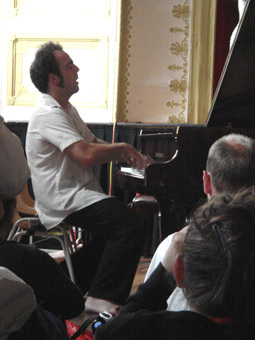
Anthony Pateras, the NOW now
photo Vivian Spadaro
Anthony Pateras, the NOW now
However the real highlights of the Sunday afternoon, and perhaps the festival, came from the solo performances of Anthony Pateras and Mike Majkoswki. Pateras is always good, but in this performance he was extraordinary. Closing his eyes, he adjusts the seat and jumps in, playing LOTS of notes. Emphatic and fearless, he starts at such a level of intensity we wonder where he can go from here. His fingers fly, he syncopates with his fist—energy not aggression—plays cascades of notes with his forearms that envelop the room until it is saturated with bouncing frequencies. Pateras knows his instrument and his own abilities and can shift pace, volume and tone, without losing any vibrancy or tension. It was literally awesome. He had to take two bows—unheard of in experimental music gigs!
When I first saw Mike Majkoswki play double bass in the early NOW now festivals I thought he was a shy young thing, however I couldn’t have been more mistaken. Majkowski is perhaps one of the most performative improvisers I’ve seen. A true showman, he sings along to the notes he is eeking out, whips the air with his bow, stamps his feet, dangerously thwacks the cap of a guy in the front row. It’s an angular approach of sudden shifts, sharp shocks and elegant sustains, constantly working the gesture. A bold, playful yet utterly serious exploration, Majkowski brought the concerts at the Wentworth Falls School of Arts to a perfect close.
The move to the Blue Mountains, initiated last year, suits the NOW now, giving it a slightly more casual and open atmosphere without any loss of rigour, and allowing for a greater engagement with environment and site, with activities like the early morning performances in Kings Cave and the interactive kites of Jon Rose. There is a truly festive feeling and audience numbers illustrated that there is also considerable local curiosity. Watching artists like Mike Majkowski develop through this scene indicate that the NOW now festival is providing a vital environment for these improvising creatures to grow and run free.
The NOW now festival, curators Jim Denley, Alex Masso, Mike Majkowski, Monica Brooks, Peter Farrar; Wentworth Falls School of Arts & Akemi, Jan 16-18
RealTime issue #89 Feb-March 2009 pg. 39
© Gail Priest; for permission to reproduce apply to realtime@realtimearts.net
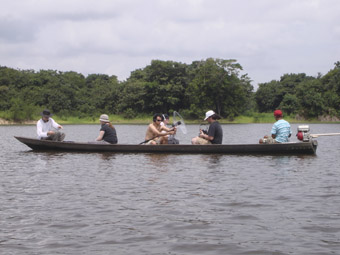
Mamori Art Lab
photo Lawrence English
Mamori Art Lab
THROUGHOUT WERNER HERZOG’S FITZCARRALDO AND AGUIRRE WRATH OF GOD, THE JUNGLE PLAYS A CENTRAL ROLE AS A PROTAGONIST OF THE HIGHEST ORDER. SHOT IN THE FURTHEST REACHES OF THE PERUVIAN AMAZON, EACH OF THE FILMS PLACES THE JUNGLE, BOTH ITS PHYSICAL AND SONIC CHARACTER, AS A FORCE TO BE RECKONED WITH, A POWERFUL AND OFTEN IMPENETRABLE WORLD THAT HIDES MORE THAN IT REVEALS.
As Herzog comments in the documentary Burden Of Dreams, the jungle is an all-encompassing world of the “prehistorical. It’s the only land where creation is unfinished yet…[a place that maintains] a harmony of collective murder. We have to become humble in front of this overwhelming misery and overwhelming fornication.” While typically Herzogian in its colour, this quotation does point to the drama that the Amazon jungle tends to draw out of people who encounter it.
Travel a good few days down from the headwaters of the Peruvian Amazon and you arrive at Manaus the capital of the Brazilian state of Amazonia where the confluence of Rio Negro and the Rio Solimoes takes place. It’s here field recordists, composers and sound artists from across the world gather for Mamori Art Lab.
Mamori Art Lab is a residency program overseen by Jordi Ilorella and Asier Gogortza, Spanish photographers whose preoccupations include the ways in which environments influence and ultimately shape art. Each year the pair collaborate with Spanish sound artist Francisco Lopez to produce two 14-day workshops that focus on the practice of field recording, concrete sound and other questions pertaining to the creation and exhibition of contemporary audio arts.
Field recording is a complex area of investigation that positions itself in histories of location recording, documentary filmmaking, bioacoustics and, as David Toop summarised it in Uovo Journal (Issue 14, 2007), “Bird watching and similar ocular pursuits, exotic sonic backgrounds, post Cageian environments.” The variations of the art form have expanded in recent years thanks to portable recording devices, leading to a mounting exploitation of natural sounds in a range of music and art practices. The intensifying mist clouding the art of field recording provokes questions as to why exactly this practice is undertaken—something strongly investigated by Francisco Lopez during the workshop.
The Art Lab’s physical presence is a collection of three small buildings on Mamori Lake, roughly four hours south-west of Manaus. The residency encourages discussion surrounding the creative use of found sound, provides opportunities for field recording excursions and participants are also encouraged to present works composed from recordings collected. It offers a chance for participants to engage deeply in one (albeit diverse) environment and explore a range of technical and theoretical ideas drawn from field recording practice.
For Melbourne based sound artist Camilla Hannan, among the residency group in 2009, “it was fantastic to be focused on the sonic environment for an extended period of time. Even when I wasn’t actually recording I was thinking about the sonic landscape, listening for different sounds, thinking about compositional structure and about how sound resides in space. Mamori offered a unique environment of sounds ranging from the cacophony of a thousand frogs to the delicacy of syncopated insects. At times, the ‘natural’ became truly bizarre.”
If one theme did permeate much of the residency it was the relationship between the natural and the synthetic—framed through Lopez’s insights into absolute concrete sound and the transformation of reality. Nights, dense with the high pitched clicks, whistles and sizzles of insects, bats, mammals and birds sounded like some highly orchestrated electro-acoustic composition. In fact if one aspect of Mamori’s sound world was to leave a lasting impression it was the sheer ‘weight’ of sound present—each square metre of jungle and swamp was loaded with countless sound emitters—making the location of individual elements quite difficult if not impossible.
Departing from the Mamori camp part-way through the residency for a three-day boat trip to the Lago Yuma, all participants were offered a chance to explore a range of new environments, including locations at which hydrophonic (and atmospheric) recordings of the Boto Rosa (the pink Amazonian dolphin mythologised as the shape shifter Encantado) could be made.
It’s difficult to convey the feeling of being in such articulate mammalian company, to hear these creatures communicating underwater and then gasping for breath as they emerge from the depths mere metres away from the small boats housing the participants. The intensity of engagement was unrelenting and brought into sharp focus a range of issues pertaining to the act of field recording and indeed listening. “Every minute (I was) hearing dolphins breathing loudly all around us,” recalls German artist Marc Behrens of the time on Yuma, “the sounds from the jungle further away and muted, the water surface completely still, no wind at all.”
As it came time for the final presentations to be made, each of the works told a story of impressions (and perhaps levels of connection) varying from participant to participant. For example, Behrens explored a concrete compositional approach using transformed sound against a backdrop of untreated field recordings. Cedric Maridet from Hong Kong took a more diarised approach, shifting between environments and illustrating the sheer diversity of sound collected. In contrast, Irish electronic composer Hillary Mullaney’s composition was a high-pitched oppressive drone that seemed to typify the harsher aspects of the environment—a work perhaps fuelled as much by her habitus as the jungle itself.
Leaving Mamori for Manaus at the conclusion of the residency was a surreal experience. Bodies were sore (following a harrowing soccer game with the locals; of course we lost, 10-4) and minds tired yet elated. It’s a difficult emotional jumble to summarise, one that reflected the rare chance for isolation from the modern world, as much as the sense of disconnection from any notion of ‘globalisation’—life had been extremely local and focused in a way that’s increasingly difficult to encounter.
Whether because of exhaustion, malaria medications and extreme environmental conditions, or simply the totality of experience itself, Mamori Art Lab provided a truly distinctive opportunity for collective understanding of explorations into sound art, field recording and the orbiting relationship of art and environment. The further the boat travelled from Mamori and the closer ‘civilisation’ became, the greater the yearning to return to that unique space and also the greater the dream-like quality of the entire residency.
Mamori Art Lab, November-December 2008, www.malab.net
RealTime issue #89 Feb-March 2009 pg. 40
© Lawrence English; for permission to reproduce apply to realtime@realtimearts.net
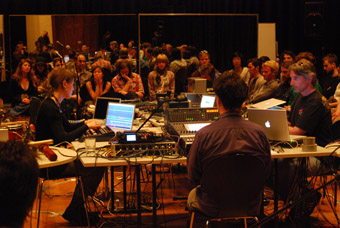
Tessa Elieff, Philip Samartzis, Interplay
photo Lenny
Tessa Elieff, Philip Samartzis, Interplay
INTERPLAY: LIVE SURROUND SOUND PERFORMANCES VIA COLLABORATION BETWEEN ACCLAIMED AND EMERGING ARTISTS WAS ORGANISED BY QUE NGUYEN OF THE ROYAL MELBOURNE INSTITUTE OF TECHNOLOGY STUDENT COLLECTIVE, WITHIN EARSHOT. THE EVENT CONSISTED OF FIVE PERFORMANCES FROM MEMBERS OF THE COLLECTIVE PAIRED WITH MORE ESTABLISHED MUSICIANS. THE STUDENTS WERE INVITED TO CHOOSE THEIR COLLABORATORS, GENERALLY RESULTING IN PAIRINGS WITH ARTISTS WITH WHOM THEIR OWN PRACTICE SHARED A GREAT DEAL.
Due to financial and time constraints (it was that time of year in universities after all) each pairing had limited opportunities to work together. Nevertheless the students and their counterparts undertook an informal mentorship process in preparing for the performances.
Cross-generational collaboration in Australia has been rare among musicians and sound artists. It is also reasonably uncommon to see more established artists in this area work consistently with younger artists. Interplay was an exciting and necessary step in attempting to further develop opportunities for young artists to work with, learn from and perhaps even influence their more established contemporaries.
Natasha Anderson and Que Nguyen opened the night. At the outset Nguyen had an interesting microphone setup with four positioned in a rectangle, each at a distance of a metre and a half. This allowed her to walk between them to effect panning of her vocals across the four speakers, while also processing her own voice with various effects from the now ubiquitous and quickly discernible Ableton Live software on her laptop. While visually fascinating this rendered the panning effect somewhat one dimensional and cumbersome, preventing Nguyen from being able to address all four speakers at once. Anderson meanwhile built on the signature staccato bursts of noise and low tones she coaxes from her contrabass recorder and laptop using a great deal of playback material, which she explained is sourced from the various theatre projects she has worked on in the last few years, lending the set a more dramatic turn than I had expected. Towards the end Nguyen took all four mics in hand and Anderson built an uncustomary crescendo which saw the sounds produced by the two begin to congeal and push toward a satisfying conclusion.
Philip Samartzis and Tessa Elieff performed the second set of the evening, both working with playback of various field recordings as well as various tones and, in the case of Samartzis, output from his EMS Synthi AKS Synthesizer, which the pair used to slowly fill the audible spectrum, starting with recordings of irregular rhythms which were gradually underpinned by bass notes and finally high frequency modulations. It was difficult to tell which sounds were coming from which performer, the palette of each overlapping to such a degree and providing an interesting ambiguity to their displaced concrete sounds. The various elements gradually extricated themselves and as the piece came to rest Samartzis looked up at Elieff with nothing but the recorded beep of a digital clock repeating alone until she hit stop, revealing their individual roles at the last possible moment.
The most successful set of the night was undoubtedly that of Darrin Verhagen and Martin Kay. It felt like a natural collaboration between two performers with a deep rapport and understanding of one another’s work. Strangely the set sounded much like the solo performances I have heard from Verhagen in recent times, gradually building to a violent crescendo from ambient beginnings. But it was in fact largely driven by Kay on laptop with the usually Pro Tools-bound Verhagen playing shakuhachi live with various processes and feedback setups, recalling his previous, more performative work such as Shinjuku Thief.
Robbie Avenaim and Nick van Cuylenburg were first up after the obligatory mid-evening breather and set out with an awkward beginning in which Avenaim waited to let van Cuylenburg set the tone for the set, producing grand granular sweeps from his computer. Eventually the two came together as the set began to build. Avenaim had positioned drums with his motorised drumsticks at either end of the room, seating himself opposite van Cuylenburg with more drums and devices. As the set developed van Cuylenburg produced a broadening range of percussive sounds which underscored the cacophony that developed as Avenaim activated all his various devices.
Closing the evening were Robin Fox and Vijay Thillaimuthu, performing on Max/MSP, oscilloscope and controllers and mixer, pedals and TV respectively with their individual setups linked into a recursive feedback network. Powerful and visceral, fully utilising the spatial potential of the surround setup at their disposal, the set started strongly but perhaps struggled to hold attention for its length. I was fascinated to see Fox’s processing of his collaborator’s output fold back on itself. The set forcefully demonstrated the possibilities for musicians of different generations to push one another in different directions.
It was clear throughout the evening that the younger artists did look to their more experienced collaborators for guidance and that deliberately transparent structures based around a central crescendo of some sort were the order of the night. This is to be expected with most first time collaborations when artists are sizing one another up and attempting to find common terrain. Overall the standard was very high and interestingly the most successful performances were the ones where the collaborations felt natural and the students pushed their mentors into new territories.
Interplay demonstrated the value of cross-generational projects in Australian experimental music and sound arts. It was clear that the opportunity to work with established musicians was invaluable to the students involved. Artists of different generations would clearly benefit from the opportunity to work with one another more regularly and hopefully more projects like this one will offer further opportunities in the future.
Interplay: Live Surround Sound Performances Via Collaboration Between Acclaimed and Emerging Sound Artists, Within Earshot Collective and Guests, supported by RMIT Union Arts, Horticultural Hall, Melbourne, Nov 9, 2008
RealTime issue #89 Feb-March 2009 pg. 41
© Ben Byrne; for permission to reproduce apply to realtime@realtimearts.net
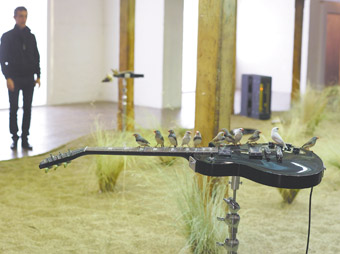
Céleste Boursier-Mougenot, From Here to Ear (2009), mixed media, Long Gallery, Hobart,
photo Peter Whyte, with thanks to Galerie Xippas, Paris
Céleste Boursier-Mougenot, From Here to Ear (2009), mixed media, Long Gallery, Hobart,
MONA FOMA ARRIVED QUICKLY IN HOBART, GESTATING AND HATCHING IN A VERY SHORT PERIOD. THERE WAS AN ODD MARKETING CAMPAIGN AND THEN IT WAS UPON US, ON THE STREET AND EVEN IN THE LETTERS COLUMN OF THE MERCURY, AS PEOPLE COMPLAINED AND PONTIFICATED ABOUT FUNDING AND TIMING. THE DAMN THING WAS EVERYWHERE.
MONA FOMA was something different. The convoluted acronym translates as: Museum of Old and New Art Festival of Music and Art. MONA is not yet open but when its mastermind David Walsh went public with the idea last year, the arts landscape in Tasmania changed dramatically—word spread of a collection of apparently incredible stuff in a unique museum that would be free for all to see.
Violent Femmes member Brian Ritchie emerged as festival curator, backed by the Salamanca Arts Centre. Suddenly an event was looming. The whole thing fell from the sky and Hobart was dazed and confused, which appeared to be the idea.
The festival opened with a huge free night-time show in Salamanca Place. Performances on a stage in a blocked off street, opera sketches by IHOS, aggressive, violent contemporary dance by Balletlab and a whole lot of art to see drew in a huge crowd. People voted with their feet, and given that it was all free (well, except for Nick Cave) that was easy to do.
The festival was fun and exciting and more than that, it felt like something we really need in Hobart—a big, bright, sprawling festival that isn’t about The Wilderness or Local Produce and doesn’t primarily feature nice music to have a pinot to. Instead we got art that wowed, charmed and seduced and the city loved it.
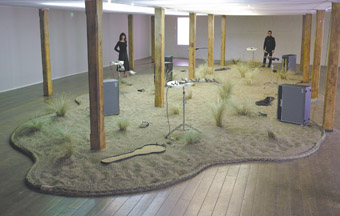
Céleste Boursier-Mougenot, From Here to Ear (2009), mixed media, Long Gallery, Hobart
photo Peter Whyte, with thanks to Galerie Xippas, Paris
Céleste Boursier-Mougenot, From Here to Ear (2009), mixed media, Long Gallery, Hobart
It was the content that did it. Hype and controversy made people curious but this would have backfired had the work not been so engaging, and exhibited so differently. The Roaming District Church, a mobile work by Jensen Tjhung, appeared and disappeared around the city. Its weatherboard exterior, polished interior and the calming psychedelic loops that oozed from the speakers evoked memory and a sense of time somehow; but if there’s something that music is truly about, then it probably is time—each beat and bar measures time passing. This thought became something of a theme for all the work for me. The little church was very evocative.
Time, again, was investigated by Manon De Boer’s short film Two Times 4’33”. Yes, it was the John Cage work and, yes, it’s about the other sounds that take place when a piano is not being played, and indeed the impossibility of silence. And we knew that, but the film took the ideas somewhere else by letting us watch the bars of no playing being read, and then for the second run through, a pan of the intent audience swiftly brought the experience back to oneself, sitting in a specially constructed screening room at the Tasmanian Museum and Art Gallery that had instructions for entry: not when the red light is on, thank you. Time and sound were pulled apart in very strict fashion.
The Long Gallery at the Salamanca Arts Centre was transformed entirely by the insertion of walls, headphones and a special room. The headphones contained a selection from the exciting 21:100:100 Sound Art exhibition from Gertrude Contemporary Art Spaces in Melbourne last year—by all accounts a truly thrilling exhibition, firmly stating the important place sound art has in Australia and the world (RT 88, p43). It’s such a wonderful installation—half the fun is watching people stoop and perch to listen, becoming monks for a moment.
In the Sidespace, just off the Long Gallery, Raef Sawford combined tiny screens on black plinths, an electronic rendition of Greensleeves and a fluttering projection around the darkened room into a work that wore time on its sleeve, entitled In Search of Lost Time. This work seemed to want to be larger and more all encompassing than allowed to be by the space, but the spread of darkness and its punctuation by differing use of light was neatly done.
Scot Cotterell’s work over in Kelly’s Garden, was a stark contrast, largely because it was rather funny. He combined black plastic, mirror balls, sludge metal sounds oozing from a 2001 style edifice and a joyously tasteless garden fountain spluttering Coca-Cola. The fountain was a lurid pink and the installation a monument to the awful glory of consumer crap everywhere.
Back in the Long Gallery there was a room within a room. Here was the centerpiece of MONA FOMA—From Here to Ear by Céleste Boursier-Mougenot. It featured 35 live zebra finches hopping about on cleverly tuned Les Paul guitars placed horizontally on stands for easy perching, scattered in an environment of sand and wild grasses. The guitars had amplification and even a little distortion, and as one moved about the room and the birds reacted, sound emerged. It was hypnotic and seductive to a high degree—this was the work Hobart really did fall in love with. People returned again and again to experience the fragile, beautiful creatures, colourful and fleeting like the perfect dream of a rock star. It was gorgeous.
The work that held me most, though, was outside: Cameron Robbins’ Marine Test Rig perched on the edge of the harbour. A little wooden cabinet containing pipes that stretched down into the river, it made sound as the motion of the water pushed air up into the cleverly constructed pipes. It hooted and blew with the imprecise rhythms of the sea, and it crept up on me-—what it was, how it worked and what it said about nature and time. The small music-making hut was all by itself, the sea playing it whether anyone was there or not. The motion of air and water came together and as my hair ruffled, I heard music that really was time and tide.
MONA FOMA Festival of Music and Art, curator Brian Ritchie, Museum of Old and New Art in conjunction with All Tomorrow’s Parties, Salamanca Arts Centre, Tasmanian Museum & Art Gallery, Hobart, Jan 9-12
RealTime issue #89 Feb-March 2009 pg. 42
© Andrew Harper; for permission to reproduce apply to realtime@realtimearts.net
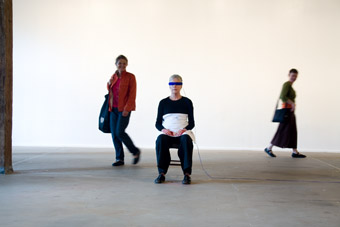
Joan Grounds, Artspace 24/25
photo courtesy Artspace
Joan Grounds, Artspace 24/25
ARTSPACE CELEBRATED ITS FIRST 25 YEARS WITH 24/25, A MARATHON WEEKEND-LONG PARTY OF INSTALLATION AND PERFORMANCES. OVER THE SATURDAY AND SUNDAY 24 ARTISTS WERE SHOWCASED IN A NON-STOP PROGRAM RUNNING CONCURRENTLY IN THE TWO MAIN GALLERIES. ARTISTS WERE GIVEN ONE HOUR EACH TO INSTALL, EXHIBIT/PERFORM AND TAKE DOWN. JOAN GROUNDS, WADE MARYNOWSKY, EUGENIA RASKOPOULOS, MARK TITMARSH, THE KINGPINS, KATTHY CAVALIERE, JULIAN DASPHER, JULIE RRAP, DENIS BEAUBOIS, LIZ DAY, MIKALA DWYER, MATTHYS GERBER, RICHARD DUNN, JIM ALLEN, BROOK ANDREW, DEEJ FABYC, GEORGE TILLIANAKIS, MARK BROWN, JILL SCOTT, NUHA SAAD, MIKE PARR, R E A AND DEREK KRECKLER PRESENTED A TRULY DIVERSE RANGE OF PRACTICES.
In the heady mix of full-hour performances, quieter installations and videos, the audience mingled or browsed the considerable Artspace collection of catalogue essays and press reviews which had been bound for the occasion. The mighty tome of essays from Nick Tsoutas’ long tenure as director was an impressive material remainder in itself, a reminder of the sheer number of artists and volume of work that has been produced or installed inside Artspace’s walls.
Representative of a quarter century of non-commercial art practice, the celebration more than aptly demonstrated Artspace’s committment to its mission to show conceptual/political work with little or no material remainder (nothing for sale). Twenty-five years on, Artspace, now directed by Blair French, is as vibrant as ever, a testament to the success of its mission and the collective worth of the work—ongoing and evolutionary in its exploration of issues, strategies, unlikely mediums and technologies. Initiatives such as Artspace have altered the perception of what constitutes art. Without it and other alternative venues, like Performance Space, would the Art Gallery of New South Wales have had its Level 2 program? Or MCA its strong local contingent? And would younger artist-run spaces like First Draft, itself now qualifying as a long-term establishment, have been viewed as necessary platforms for a tier of younger emergent artists?
Under Tsoutas’ direction, Artspace established a strong international agenda, with an important residency program, and a strong association with the Biennale of Sydney (housed upstairs in The Gunnery). Artspace nurtured and developed a style of practice which gave Australian artists the opportunity to rub shoulders with their international peers—and not just every two years at the Biennale. Tsoutas would seek out the weird and the wonderful, for example the handmade sci-fi of Finland’s Veli Grano, work you wouldn’t see elsewhere. His support for the gay community extended from Pope Alice to the music video generation of George Tillianakis and The Kingpins; and, equally important, through the catalogue essays he developed art writers and theoretical practice in an ongoing series of seminars and conferences.
Whatever your thoughts on the severe Marxist-revolutionary photocopy-styling of those Tsoutas-commissioned catalogues, the point was that he got them out quickly and economically with each and every show, and fostered serious artist-writer dialogues as assiduously as he collected reviews from the mainstream press. In those catalogue essays artists puts their work in dialogue with serious contemporary theory at an order of working through that was beyond mere review. The essays were a kind of conceptual testing ground for artists. Now, bound together, the essays are an invaluable research resource fittingly displayed in the foyer, central to the celebration.
Given the sheer volume of artists and projects, director Blair French is to be congratulated on succeeding in the difficult task of selecting a mix of established and younger artists to encompass both the gallery’s history and contemporary perspectives.
With a practice going back more than 30 years, Joan Grounds is a seminal figure in performance-installation in Australia. In her Sunday morning slot she was both performer and object in her own installation as she sat quietly, blindfolded by the skein of blue wool which wrapped her head, before trailing outside the gallery, along the footpath, and up a lampost where it secured a small, leafy branch. This tranquil, reflective work summed up a century of installation practice going all the way back to when Duchamp blocked access to a 19th century gallery by filling up the interstices between the paintings with a cat’s cradle of wool. The Duchamp mantra of “nothing to see” was echoed in Grounds’ blindfold: installation art is less about seeing per se and more to do with a conceptual understanding.
As such the historical dimension of this performance affirmed Artspace’s mission. Grounds’ exchange beween inside and outside, culture and nature, affirmed the history of happenings, the use of everyday materials (not the rarefied paint of high-born, sublimated ‘high art’), and the actions of artists whose site was very often the street (Gutai in white labcoats washing Tokyo’s pavements in the 1950s). In contemporary terms, Grounds’ performance ‘action’, though paradoxically calm, bound her to a tree and tall timbers, highlighting the sacrifice of nature to the city, and our blindness to its current state in the ongoing global warming and energy crisis.
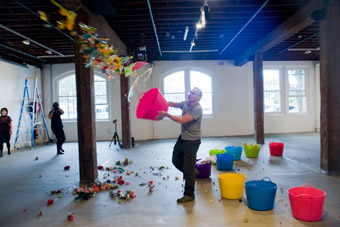
Mark Titmarsh, Artspace 24/2
photo courtesy Artspace
Mark Titmarsh, Artspace 24/2
Mark Titmarsh’s expanded painting likewise positioned Artspace in art history, playfully usurping the 1950s action painting of Jackson-the dripper-Pollock. With a diverse practice as both artist and writer (he co-edited the postmodern journal On the Beach in the 1980s), Titmarsh has a long history with Artspace and was an early experimenter in internet subjectivity (Space Invaders, 1992). Returning now to live action and to paint—not traditional painting, but painting in its expanded form as the lamella-thin surface of things—Titmarsh performed as a chucker of colour, flinging paint and all manner of bright and shiny baubles and multi-hued flat cards around the gallery. Colour dispersed in flight. Notably he later chaired the Artspace forum on expanded painting.
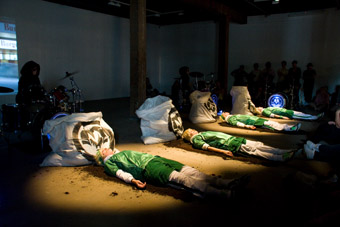
The Kingpins, Artspace 24/25
photo courtesy Artspace
The Kingpins, Artspace 24/25
Liz Day’s remarkably rapid installation of a square of riotous weeds in full bloom was contextualised by video documentation of her garden project inside a women’s prison. Her aberrant plants, like aberrant people, conjured the tensions between institutionalisation and freedom, bureaucracy and social formation of the self. Day, known for her slow practice of growing and exhibiting grasses and root systems within a conceptual frame of histories of power and colonisation (whitey’s patch of lawn eradicating Indigenous custodianship of the land), resorted to a shorthand of quite fantastical store-bought weeds to fit the one-hour timeframe.
For many established artists, the tight one hour of Artspace 24/25 was but time enough for a showbag sample of usual practice. Julie Rrap made time the focus when she set the heat to melt a line of ice stilettos (and in so doing recalled the iconic role of the shoe in her work on the female body and its fetishisation). Eugenia Raskopoulos’ dark and haunting video provoked the viewer to puzzle out what they were seeing (in synecdochal relation to her large scale 2007 Artspace installation where, inside a Mies van de Rohe styled glass box, she staged her smoke and red flares rebuke to Rumsfeld’s media lock-down on Gulf War Two).
Further samplings included Katthy Cavaliere’s discarded rag doll performance and Mikala Dwyer’s installation of an uncharacteristically non-floppy, rigid monotoned structure. Wade Marynowsky’s Dalek-inspired floor robots caught the mad flavour of his Artspace-installed masterwork, Autonomous Improv (which, in a nod to Bruce Nauman, combined video snippets of performance and sound artists with footage of the strangeness of clowns). The Kingpins donned their green tracksuits and inhabited their trademark boy rappers—live. Denis Beaubois showed a video of a soothsayer he had hired prior to the event to predict Artspace’s future and what would happen on the day.
Given the daunting, even impossible task of a full Artspace retrospective (simply too many good artists), Artspace 24/25 cannily consolidated its historical mission with a party offering a satisfying sampler of favourites.
Artspace 24/25, Sydney, Nov 1-2
RealTime issue #89 Feb-March 2009 pg. 43-44
© Ann Finnegan; for permission to reproduce apply to realtime@realtimearts.net
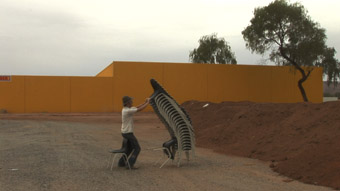
Alex Kershaw, One of Several Centres
VIDEO ART WAS ORIGINALLY CHAMPIONED FOR ITS DEMOCRATIC IMMEDIACY, WHICH ARTISTS JUXTAPOSED AGAINST THE COLD FORMALISM OF HIGH MODERNISM. EVEN TODAY, DIGITAL VIDEO TENDS TO BE MORE ABOUT CONTENT THAN FORM. LIKE AMATEUR NEWS FOOTAGE, THE IMPUTED REALISM AND BANAL YET OFTEN FORCEFUL MATERIALITY OF VIDEO CONTINUES TO UNDERPIN MUCH OF ITS POWER, EVEN AS DIGITALISATION ENABLES EVER GREATER DEGREES OF MEDIATION. THIS PLAYING OFF OF ‘REAL LIFE’ VERSUS ‘MEDIATED ARTIFICE’ ANIMATES ALEX KERSHAW’S INSTALLATION, ONE OF SEVERAL CENTRES, RECENTLY EXHIBITED AT THE FREMANTLE ARTS CENTRE, WHILE NOTEBOOK AT PICA BY THE UK’S JOHN WOOD AND PAUL HARRISON LIES FIRMLY IN THE REALM OF FABRICATED FORM.
Kershaw’s work, underpinned by vacant tones and marginally noisy field recordings mixed by Gail Priest, is a response to Australia’s mythic red centre. Filmed in and around Alice Springs, Kershaw presents a surprisingly urban vision. Indeed, as the title implies, there is a strange sense of decentredness to the installation. Kershaw’s sites seem eternally at the periphery, forgotten spaces nestled about a pleasingly rusted, semi-industrial circuit. We see, from inside, a local and her dog repeatedly circumnavigating an empty water tank; an all but deserted street roundabout being laid with rolls of grass; a Maori busker singled out against a concrete wall; an empty carpark behind a yellow warehouse (shades of Melbourne’s once neglected ‘Yellow Peril’ sculpture, Vault) wherein a young man, recalling Buster Keaton, noisily stacks cheap plastic chairs to a dangerous height; and even a darkened playground, illuminated by torchlight, as one man moves about its geodesic climbing frames. Like the field of yellow backing the carpark, the playground carries suggestions of Modernist failure, given that geodesic domes were proposed as utopian architectural forms.
At times, Kershaw’s vision recalls for me Agnès Varda’s Mur/Murs (Walls/Murmurs; 1980), notably where we see a figure carefully measuring a public mural. Both Varda and Kershaw worked with photography before shifting to moving images, and they share a liking for the locked-off, wide-frame shot, replayed with minimal sound, to effect both a re-enchantment of urban space as well as a wistful melancholy. These are fragile relationships between figure and surroundings, which might not survive beyond filming. The ordinary urbanity of these Alice Springs locals in their own environment gives the work the feeling of a poetic documentary, with extended viewing revealing a gentle artifice of framing, rhythm and space. Projection on two screens enhances this, giving a languid, minimalist flow to the work.
For all the subtle, slow moving delights of One Of Several Centres, Kershaw is not Varda, and his scenarios do not all match. The self-conscious, actorly performance of the chair-stacker and the rare use of a cut to an upper body close-up make this sequence jar with the others, which (as with the wanderer in the graffitied water tank) otherwise coil and stream more easily in their relaxed minimalism of editing, framing and performance. This is nevertheless a highly affective work for those with the patience to await its charms.
More striking is the installation by Wood and Harrison. The old joke about contemporary art—and in particular early video art documenting artists performing mundane tasks—was that it could be made by anyone. This is manifestly not the case with Notebook, whose visual precision (ironically) allies it with Modernism, Malevich, de Stijl, Bauhaus artists and their peers. Notebook consists of 101 shorts, each filmed in the artists’ crisp, white studio with featureless grey walls and evenly distributed light (largely from above). Most involve a perfectly rectangular, gleamingly blank table, and each starts with an initial pause or lull in which one has just enough time to evaluate the set-up. Then an event is triggered, in most cases with the artists (and even their hands) out of shot. Actions happen sometimes with a snap, but more frequently via a temporal arc in which the occurrence eases into realisation before a sharp conclusion. The camera then allows one to reflect on the consequences, before fading to black, and the next one-to-two minute event is played.
Humour—of the austerely blank type—hovers over these performances, spoofing in part the ideals of Modernist aesthetics. Painters such as Kandinsky and the French Cubist Gleizes often described their work as formalist experiments, as parascientific tests of what would happen if one related colour to shape according to a particular rule, or if one altered perceptual frames following precise principles. Wood and Harrison likewise relate a series of aesthetic and physical propositions. What happens if one drops a grid of uniform green apples, hung by fishing line, suddenly over the space defined by the tabletop? One is offered a rubber band affixed to the diagonal points edging the table and length of the band constrained about its rectangular margins, before it is released to define a dark line across the surface. This experiment becomes an aesthetic gesture akin to Mondrian’s lines and brushstrokes.
Drawing on both the history of performance art, and criticism about Pollock and Field Painting (their vast canvases as standing in for the artist’s body), the oeuvre of Wood and Harrison is animated by tensions around bodily absence and presence. This is highlighted by those rare pieces in which the artists themselves appear. I particularly enjoyed the sight of one, dressed in anonymous black, lying unemotional under the tabletop, before a shower of plaster from above scattered across its surface and onto the floor about him. Where the artists do not appear, objects and spaces are redolent of their displaced physicality.
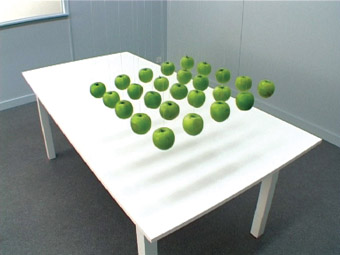
John Wood & Paul Harrison, Notebook
Notebook succeeds by its varied appeal. One can think deeply about its formalism, and its clear austerity gives it a look little video art attains. Or one can laugh at its comic physics lessons. Perhaps most importantly, this is not—to quote Adrian Martin—another “little black box [TV] inside the big white box” of the gallery, which insists one view it in the same way as one watches cinema or television. The visitor can enjoy the full duration of the 101 variations, or dip in and out, watch five minutes, leave, and return for another 30 seconds, and still appreciate this artwork—a welcome relief from the bloated durations artists such as Matthew Barney arrogantly demand. If only all video art was so crafted, yet unassuming.
For excerpts from Notebook and an interview with Harrison & Wood, see www.tate.org.uk/go/tateshots_issue12_harrisonwood.mp4 (This link will download the file, rather than taking you to a website.)
Alex Kershaw, One of Several Centres, 2-screen HD digital video & surround sound, concept, camera operation, editing Kershaw, sound designer Gail Priest; Fremantle Arts Centre, Nov 29, 2008–Jan 25, 2009; John Wood & Paul Harrison, Notebook, digital video; Perth Institute of Contemporary Art (PICA), Dec 3, 2008 –Feb 1, 2009
RealTime issue #89 Feb-March 2009 pg. 46
© Jonathan Marshall; for permission to reproduce apply to realtime@realtimearts.net
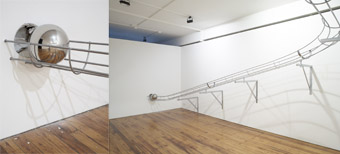
Busting Out, Kel Glaister
photos Christian Capurro, courtesy of Conical
Busting Out, Kel Glaister
AT MELBOURNE’S CONICAL INC., KEL GLAISTER INVITES US INTO A DE-CONSTRUCTION SITE THAT IS CLEAN AND BARE BUT FOR THE SLICK METAL RUNNER THAT CARRIES A GIANT BALL-BEARING TO ITS RESTING PLACE, EMBEDDED IN THE GALLERY WALL; WHILE ARLO MOUNTFORD OFFERS A COMFY SEAT AND FLUFFY WHITE ‘BEARSKINS’ AS THE SETTING FOR HIS QUIRKY FILM THAT FOLLOWS A RANDOM IDEA TO ITS LOGICAL CONCLUSION.
At face value, Mountford’s scenario is whimsical: a deer—well, a guy in an antler hat and ‘deer’ pants—wanders around the Victorian alps with a cuddly polar bear, discussing the making of art, until the two meet a real ‘Wanderer’, straight from C D Friedrich. They have a picnic in the snow, then wander some more. The work is the product of a filmed-but-forgotten late night conversation, which we see at the start of the piece: a drunken Mountford, inspired by a damaged neon sign that reads “—NDINAVIA”, paints a rambling verbal picture of a deer in a wintry forest, tossing snow with its antlers to the sounds of a massed chorus.
Mountford’s post-dubbed dialogue is a sardonic reflection on why an artwork is created and the inevitable compromises of its making. Artistic references abound—most markedly to Fischli and Weiss’s rat and bear films—as do self-referential loops of critique-within-critique. The cartoon-like bear seems to play the devil’s advocate, countering lofty statements with comments like “So you didn’t get funded.” (The deer replies, “Piss off.”) Mountford creates a clever, critical conversation about the artist’s pursuit of an idea: the culmination of this discussion is the ‘deer’ on his knees, ecstatically tossing snow, arching and turning in slow motion to a choir that sings ‘NDINAVIA’ over and over.
Return to Form: NDINAVIA seems to take the animated characters of Mountford’s previous works and bring them to life in the ‘real world.’ The mauve-tinted, snowy landscape is lush and alluring; and for all their absurdity, the hapless deer and cuddly bear padding through the wilderness are strangely appealing. As the rhetoric expounded by one so often falls comically flat against the banal response of the other, the theoretical weight that might otherwise alienate is lifted to another realm, one of sheer irony and playfulness.
The perfectly-drawn Wanderer in his cameo role gets the last laugh, in a sense, for the film’s sensual climax is a kind of sublime homage to all things Romantic; a triumph of ‘artistic vision’ that renders theory irrelevant. Beauty, in the end, reigns supreme and the artist stays true to his idea—even when the idea is an unremembered, drunken rant. Mountford’s film is completely engaging for its sheer oddness, and at the same time cleverly pulls off something both conceptually rich and visually seductive.
For Busting Out, a melting block of ice at the exhibition opening served to set Glaister’s ball rolling. Her elegant metal runner delivers it to its final destination, half-in, half-out of the gallery space it relies on for its existence. The work seems a streamlined version of the ideas that drove Glaister’s Immovable Object (2007, RT 80, p53). This time she uses polished steel rather than cinderblock, much as one might take up a well-tempered sword rather than a blunt club. The shiny, still sphere reflects the viewer, the room, the edges of the broken wall and the metal run itself. The space is empty and silent, but full of the imagined trace of the movement; the never-to-be-repeated gesture, the path of the ball through the gallery.
Far from Mountford’s directly tongue-in-cheek tone, Glaister’s installation appears to take itself seriously despite its claim to be “a bratty attempt to make itself defunct.” It is a deliberately futile effort: the wall itself is reinforced with steel plate so the ball can never in fact ‘bust out.’ The physical work is as sleek and sophisticated as the idea it articulates. The resulting hole is not random but perfectly round, an ‘embossing’ as much as a break—though this changed later in the exhibition’s run, when some gallery visitors mistakenly took the piece to be ‘interactive.’
Glaister’s piece is smoothly constrained, cool-headed, while Mountford’s film ultimately gives unashamed voice to the notion of beauty. But Glaister’s work has a seductive beauty nonetheless—where will her increasingly refined efforts lead in the future? Mountford seems indeed to be wandering in new territory, and it will be interesting to see what medium will be employed next in his exploration of the history of art and ideas.
Arlo Mountford, Return to Form: NDINAVIA; Kel Glaister, Busting Out, Conical Inc, Melbourne, Nov 8–29, 2008
RealTime issue #89 Feb-March 2009 pg.
© Urszula Dawkins; for permission to reproduce apply to realtime@realtimearts.net







































































































































































